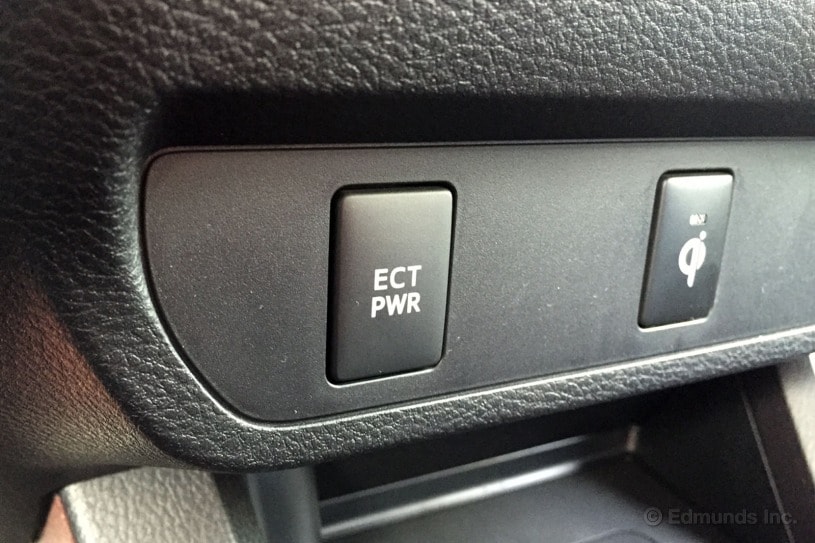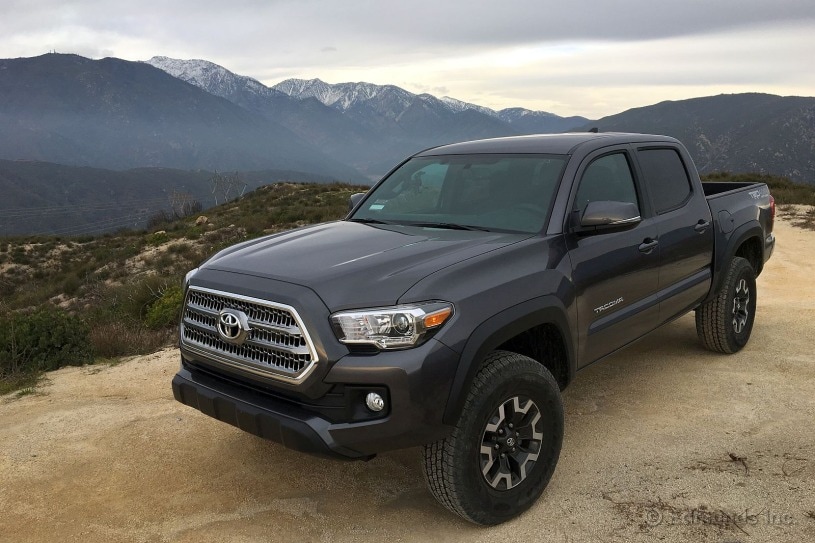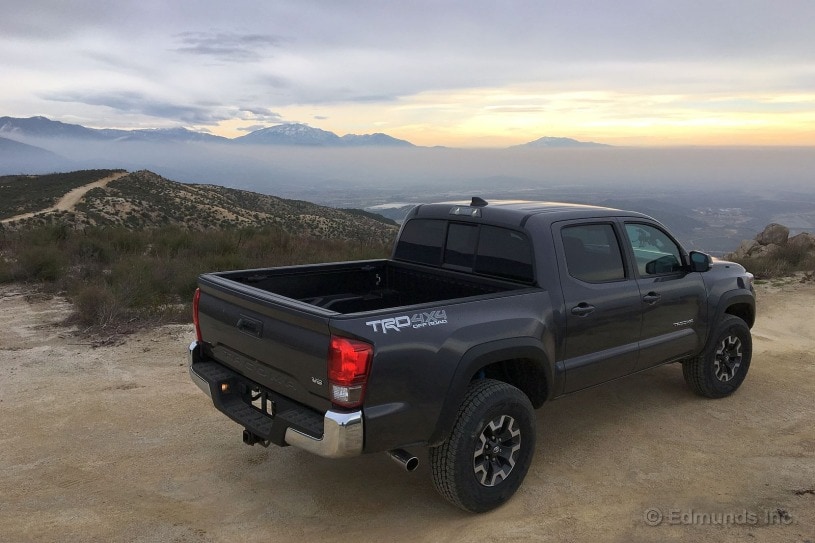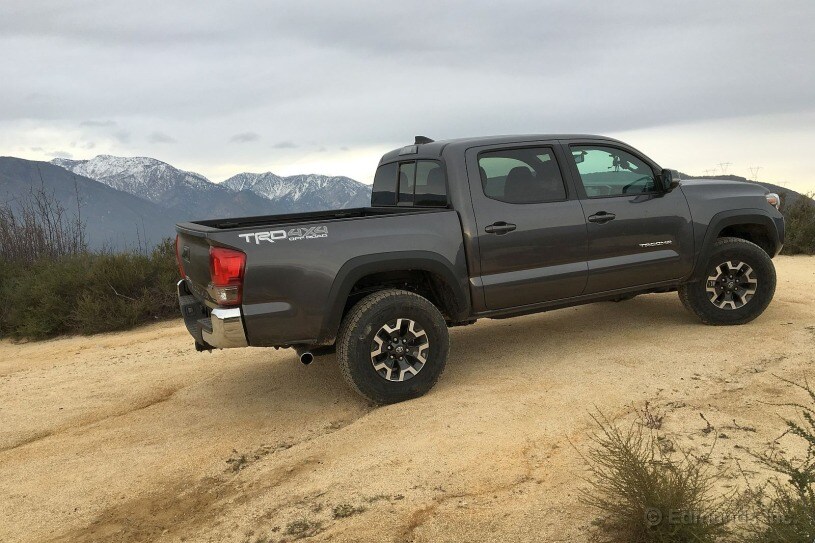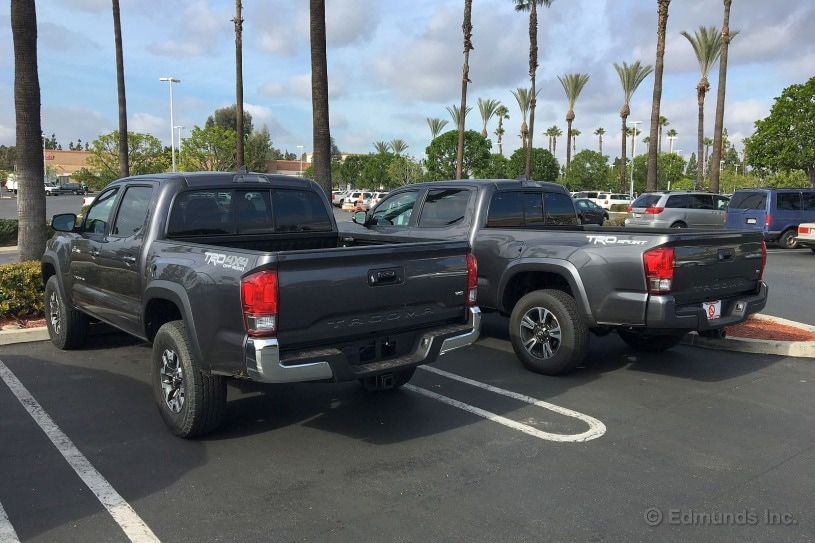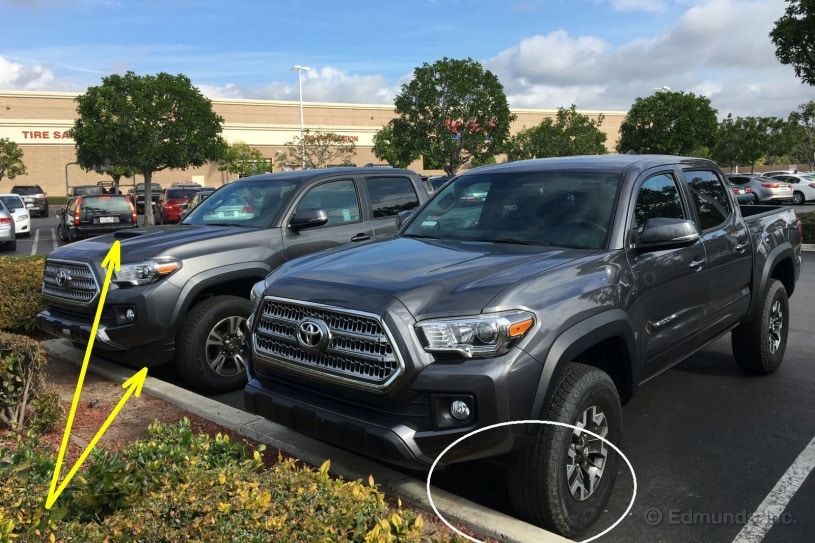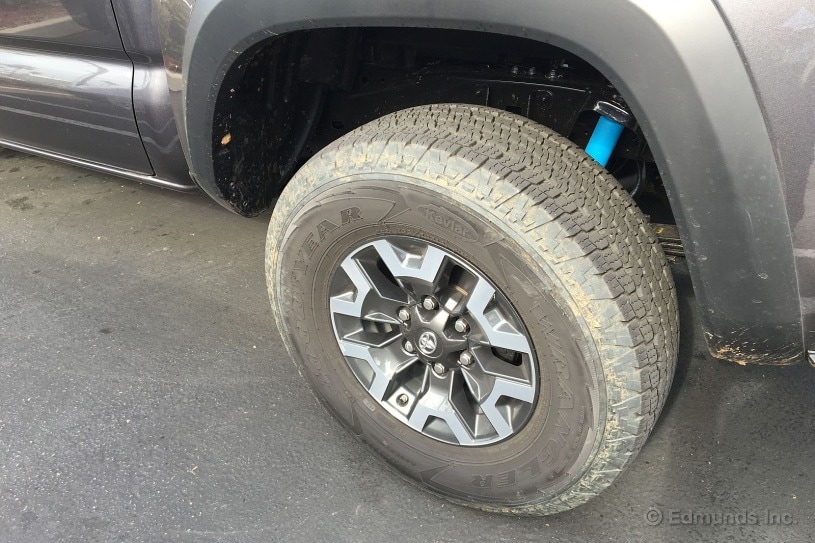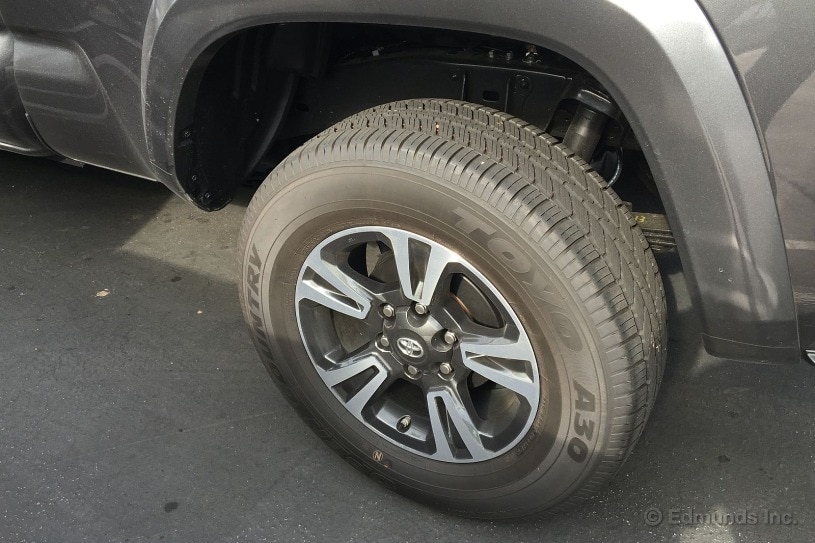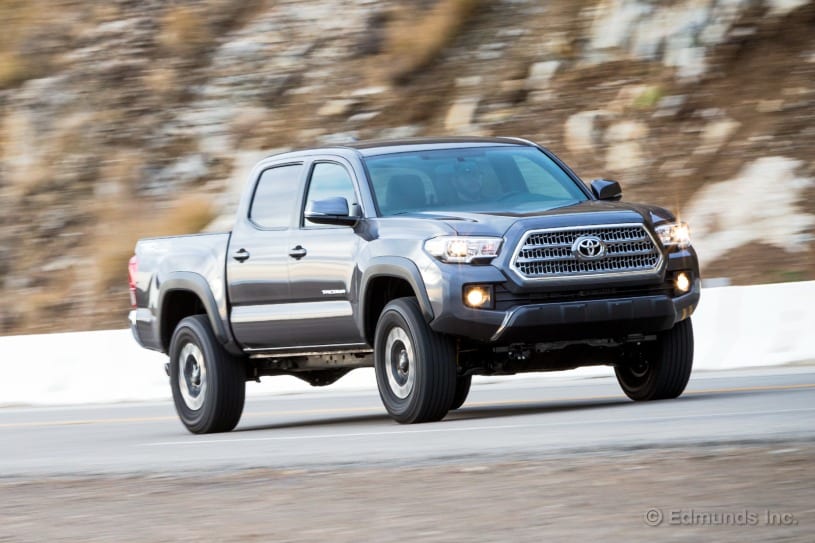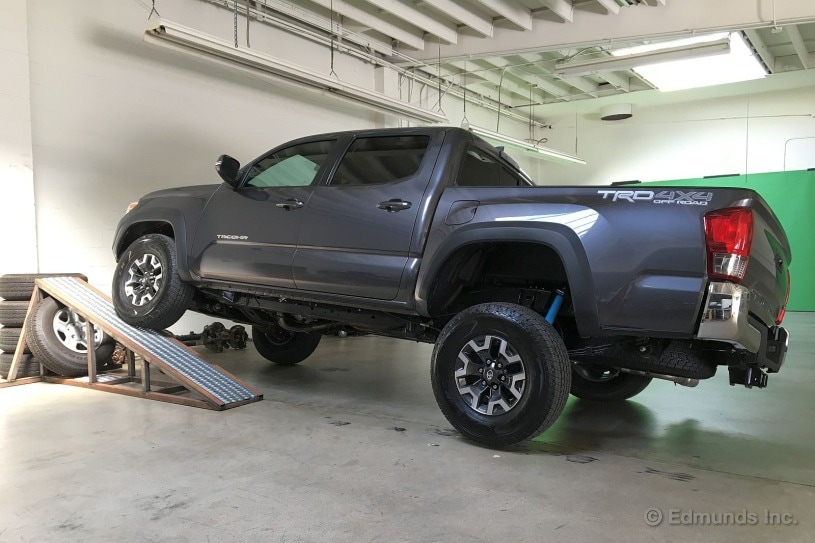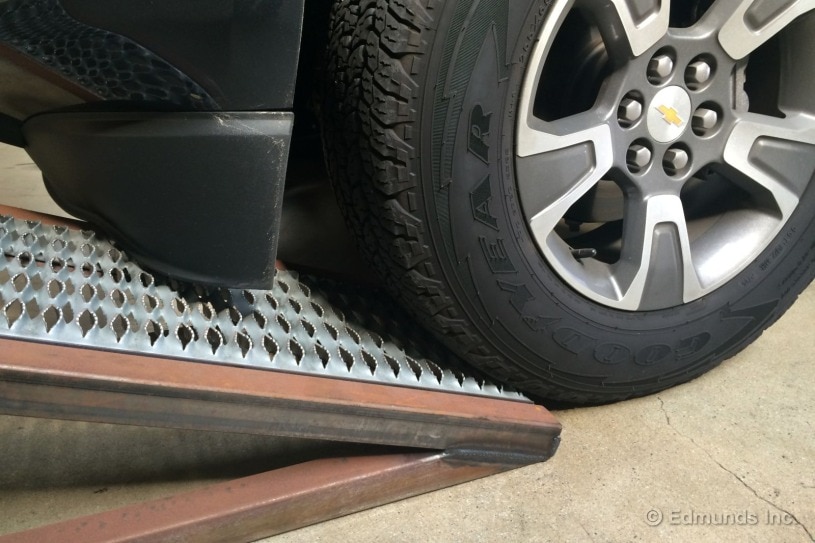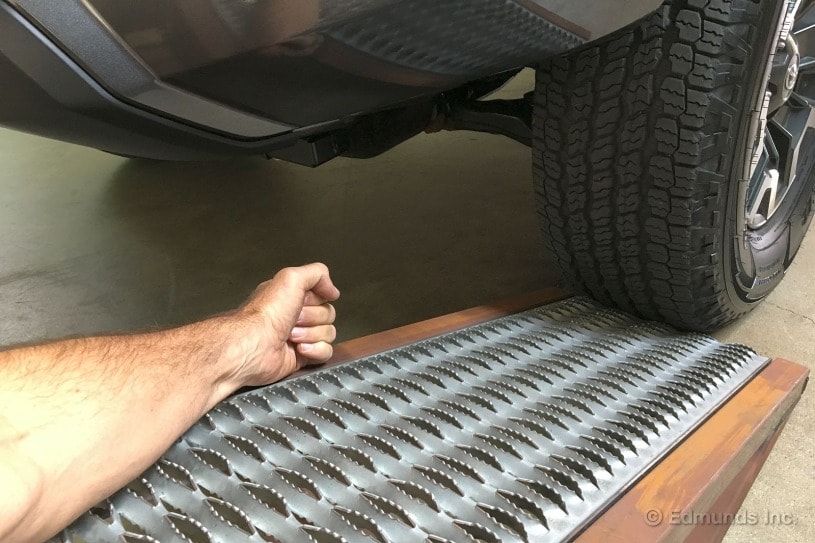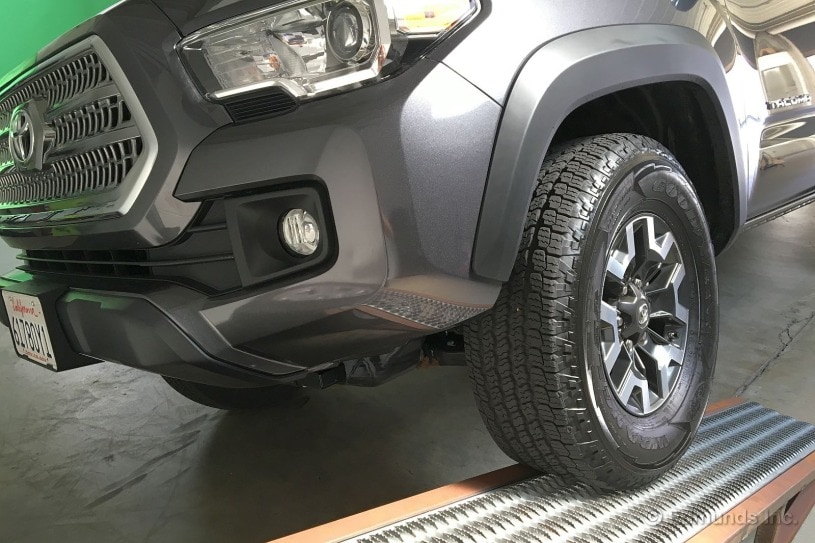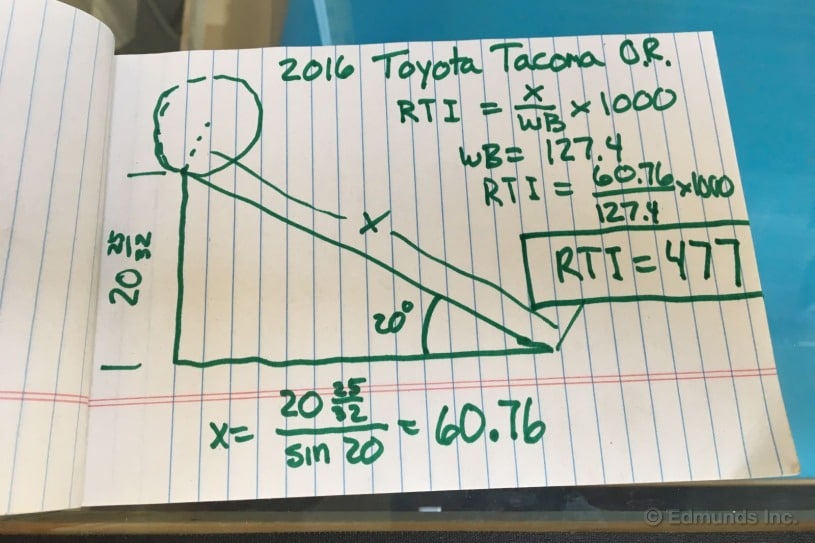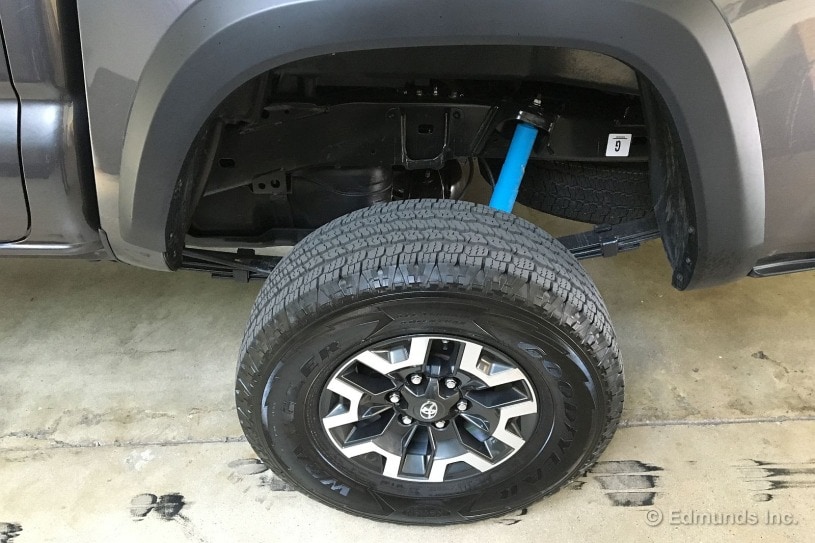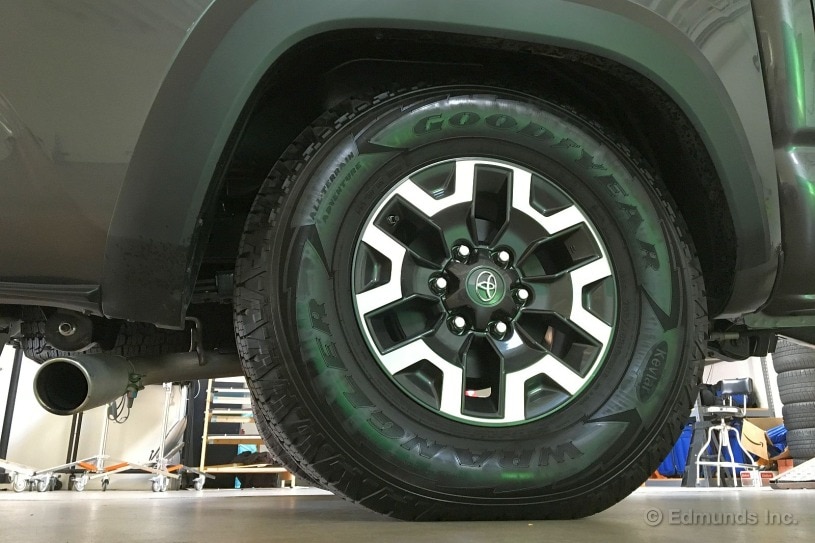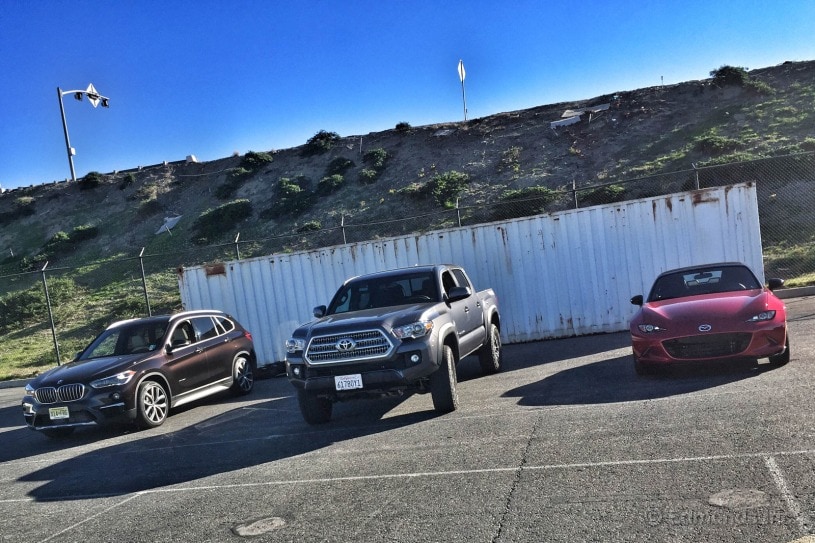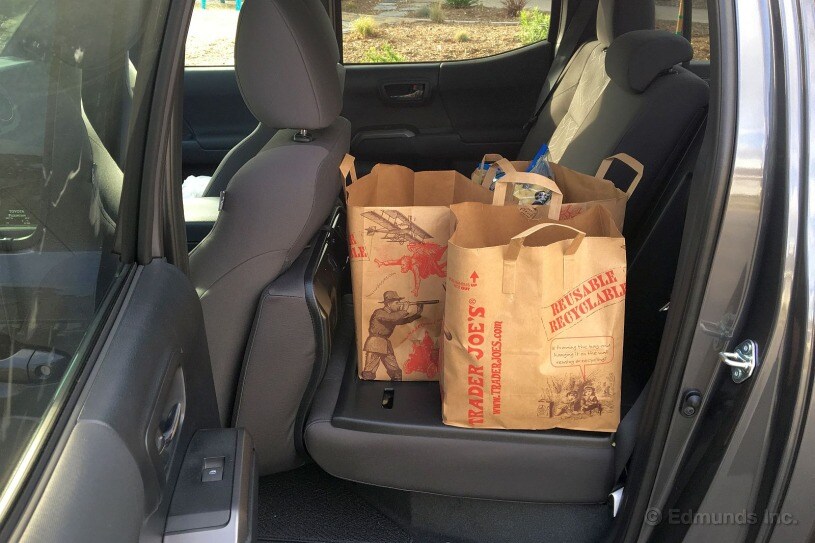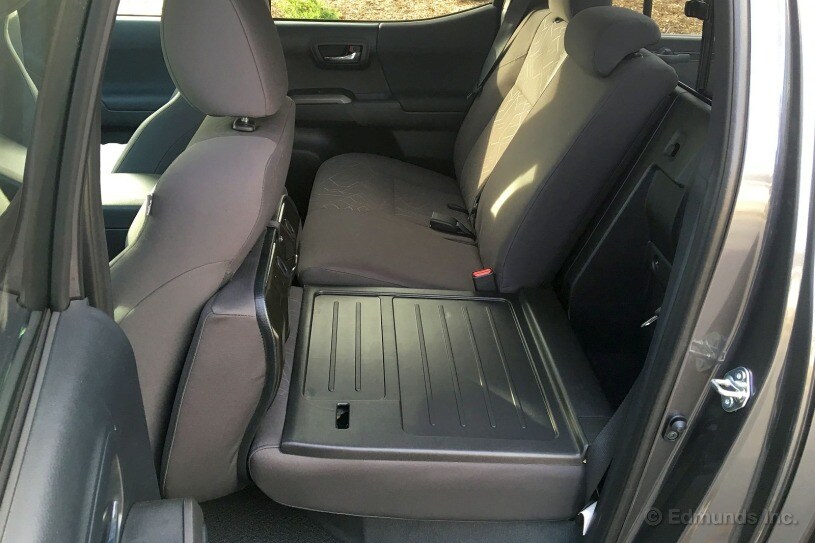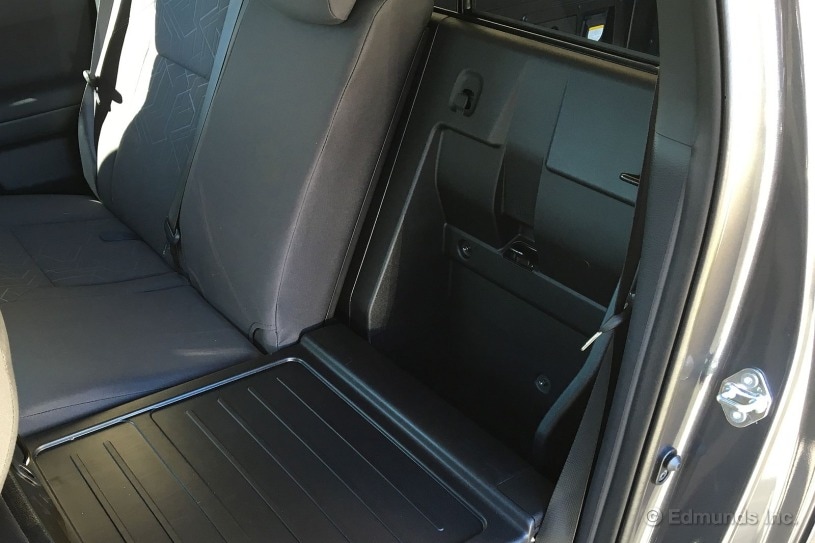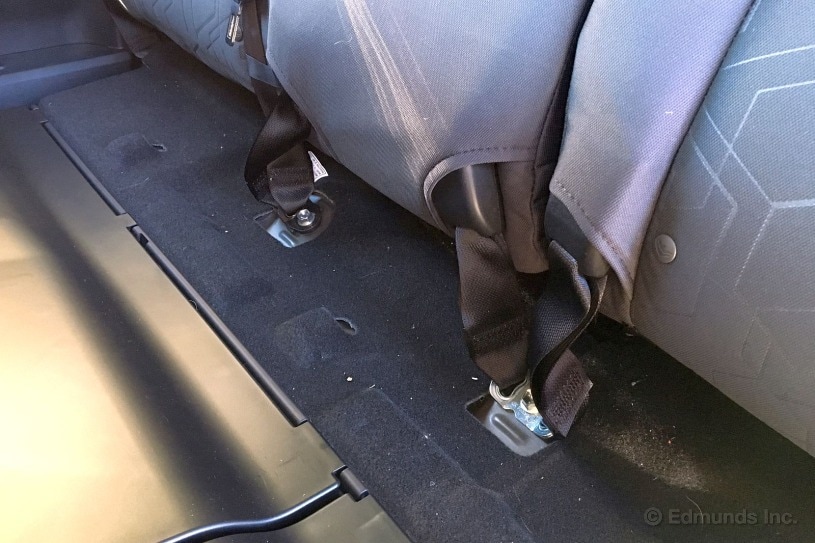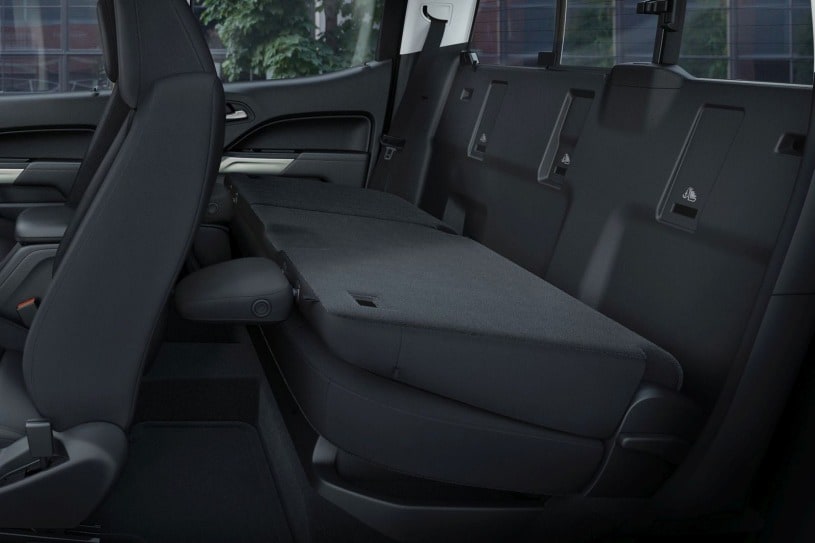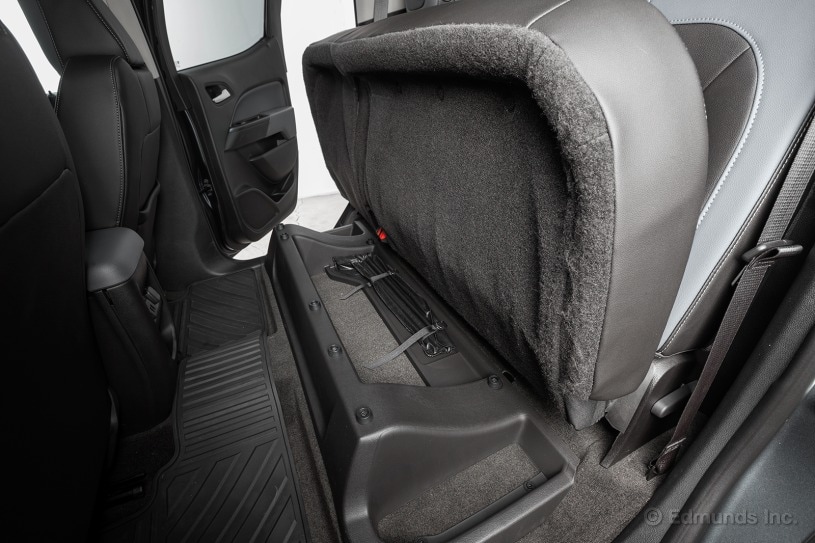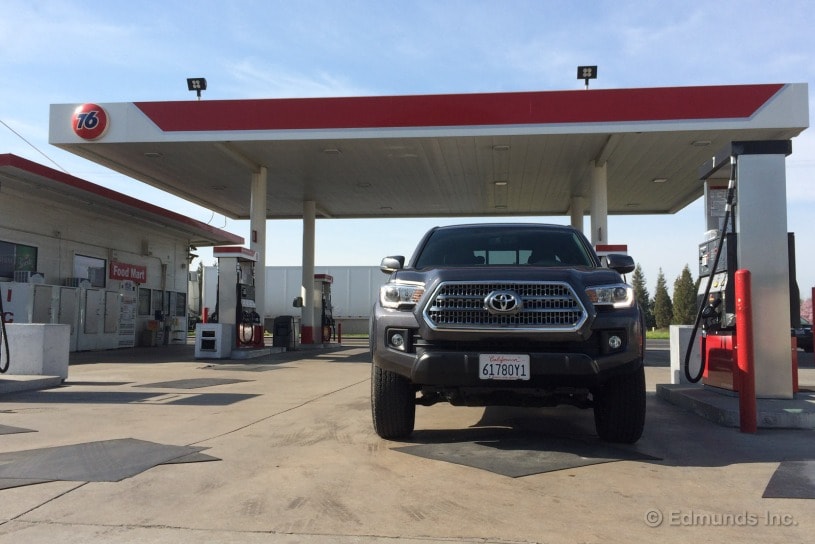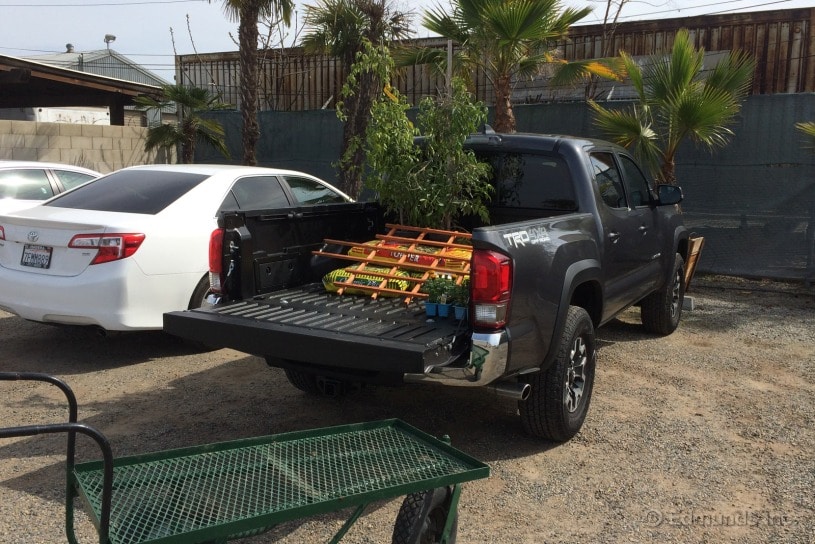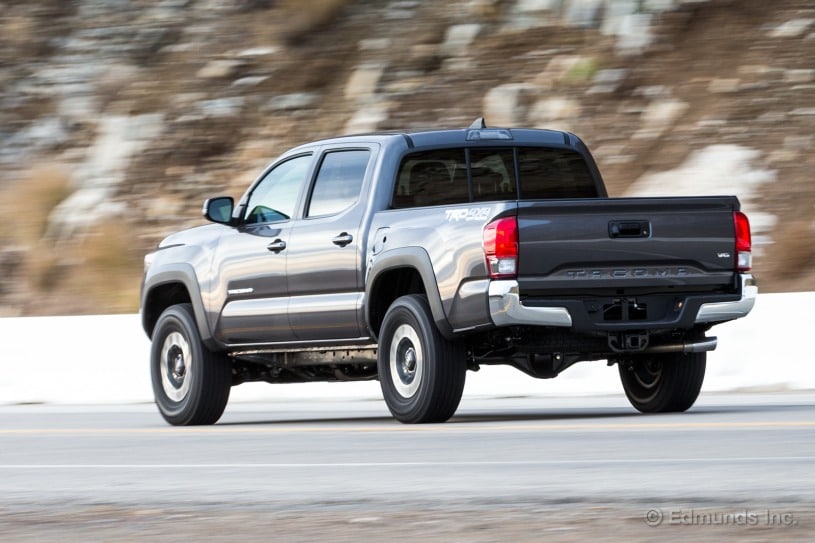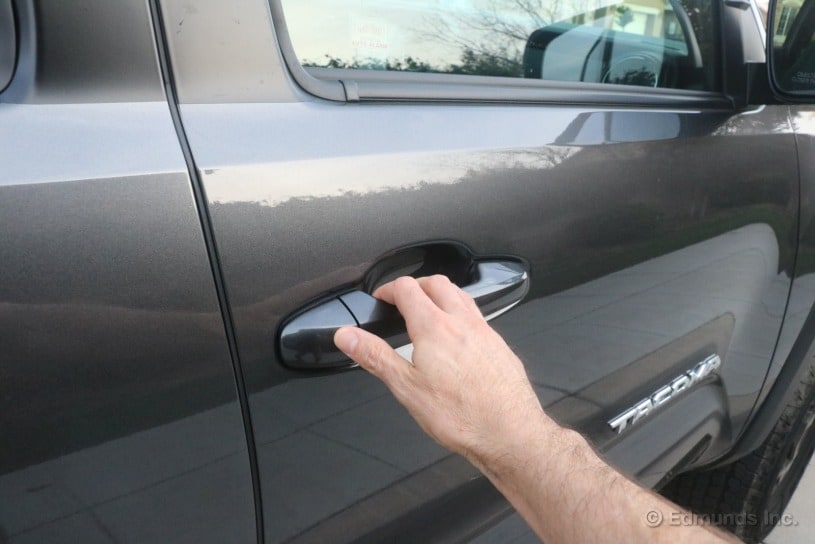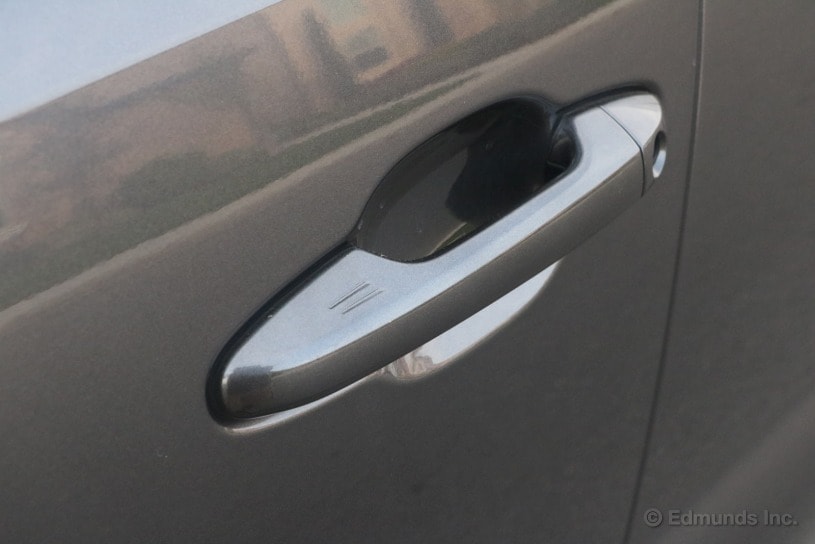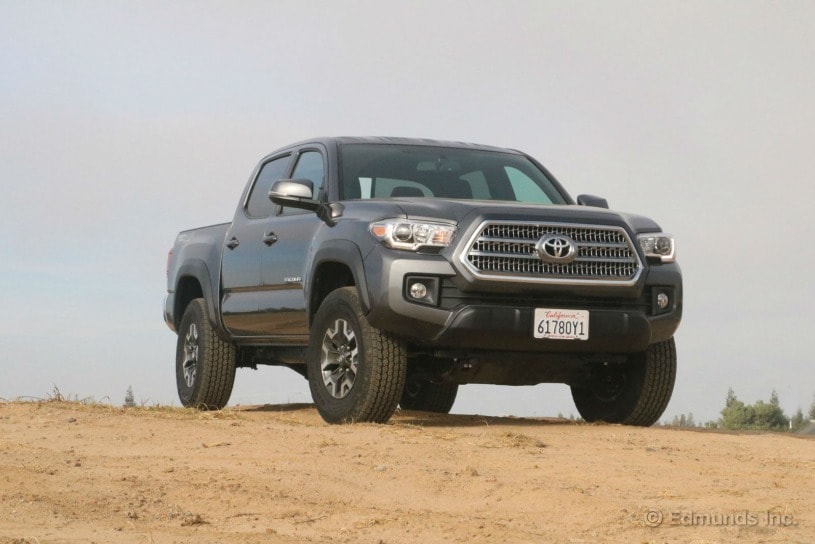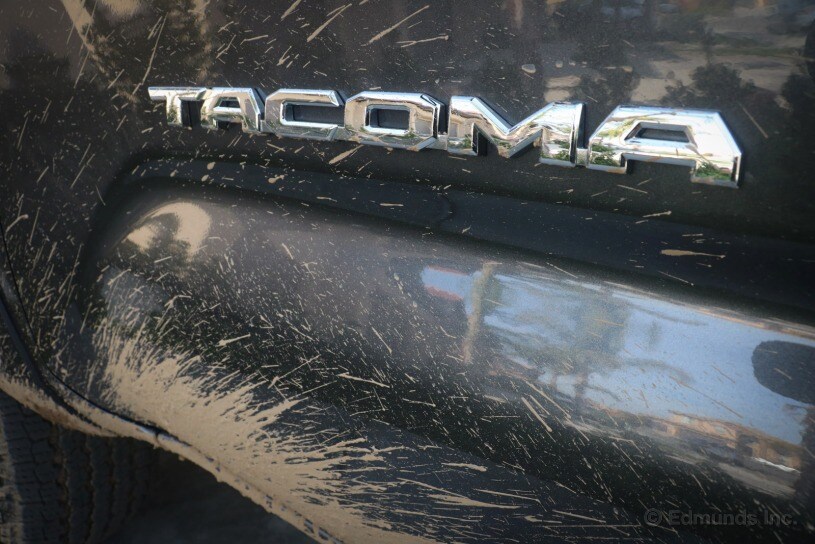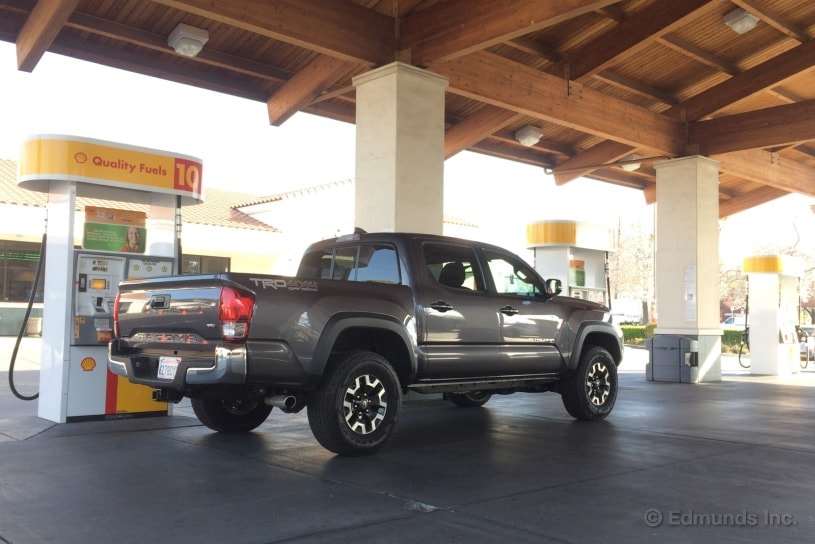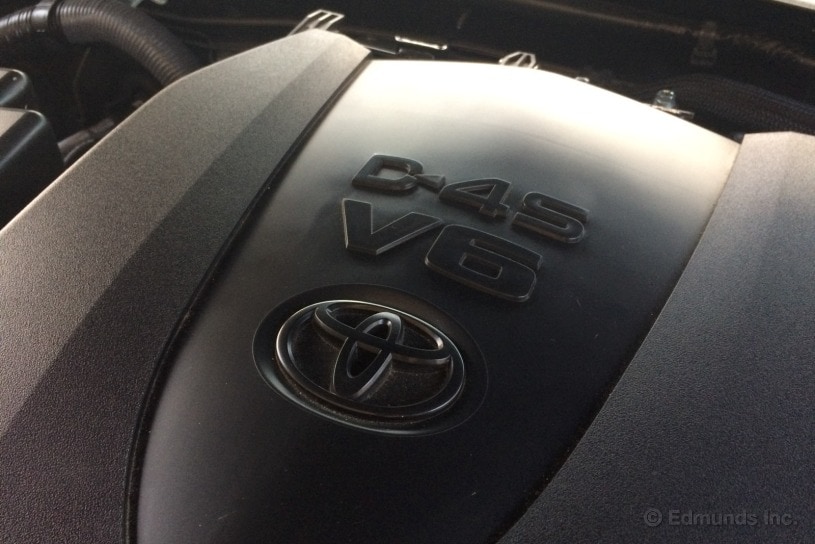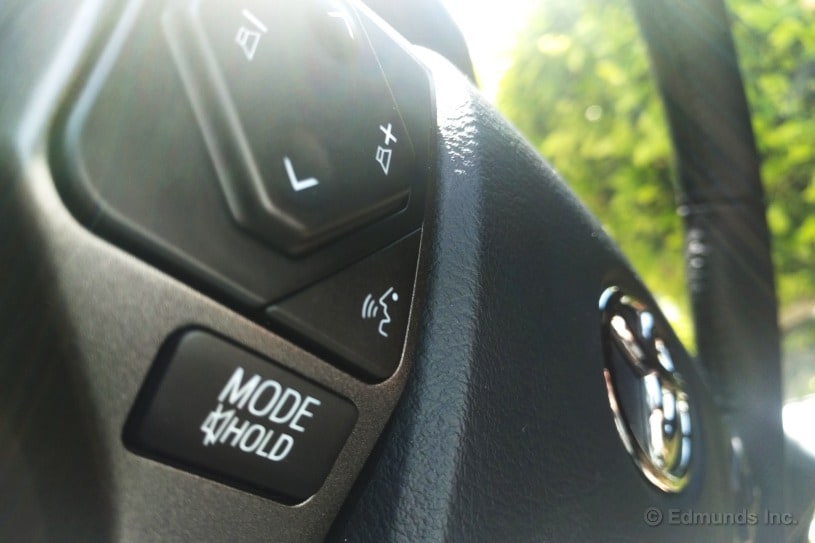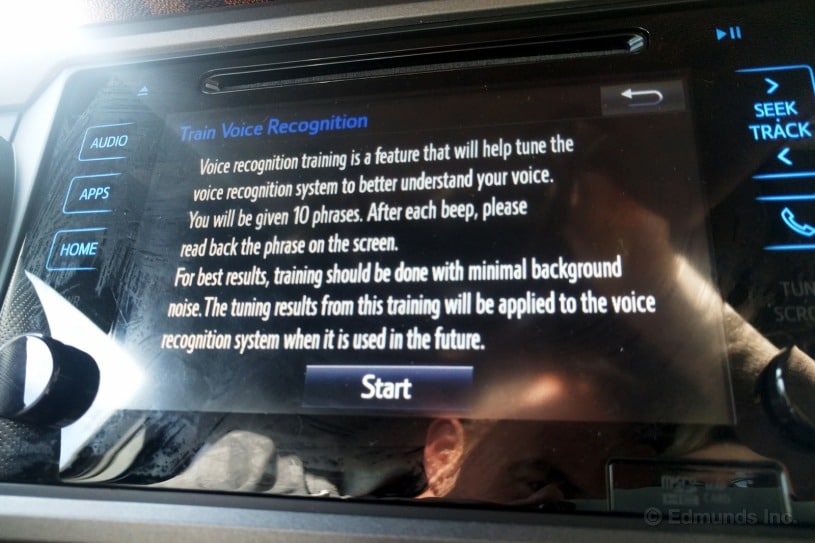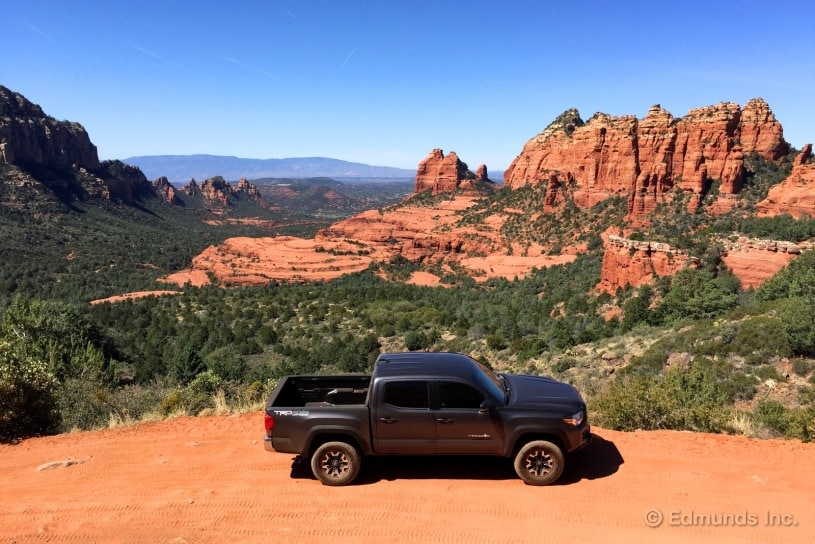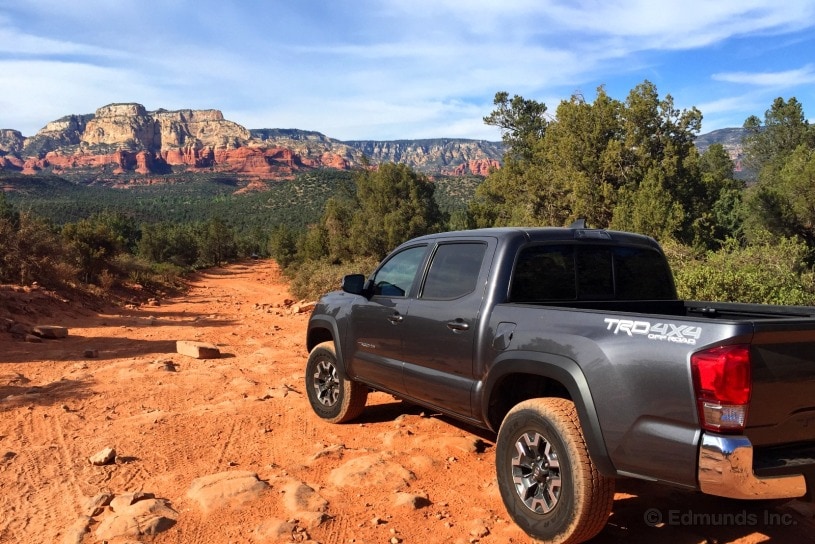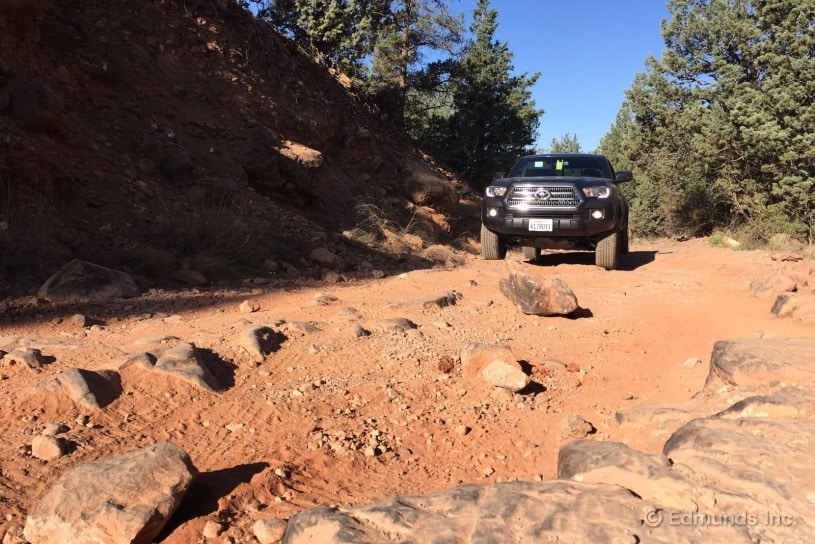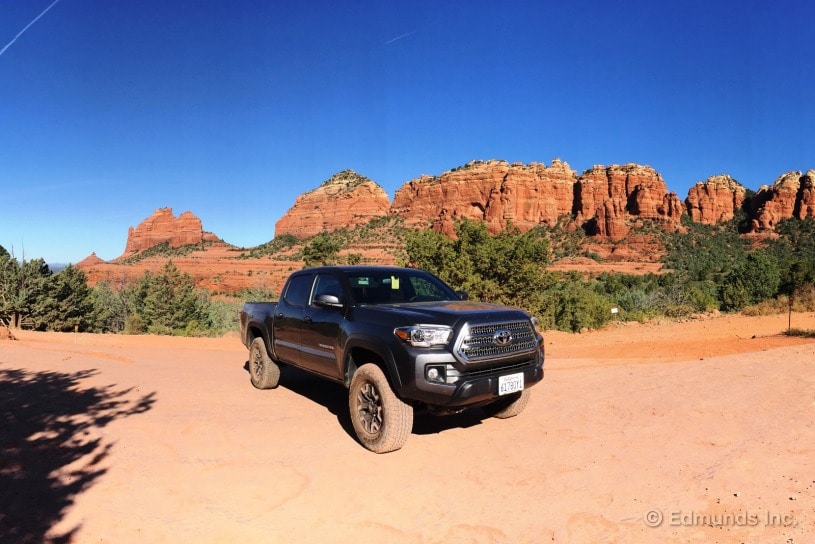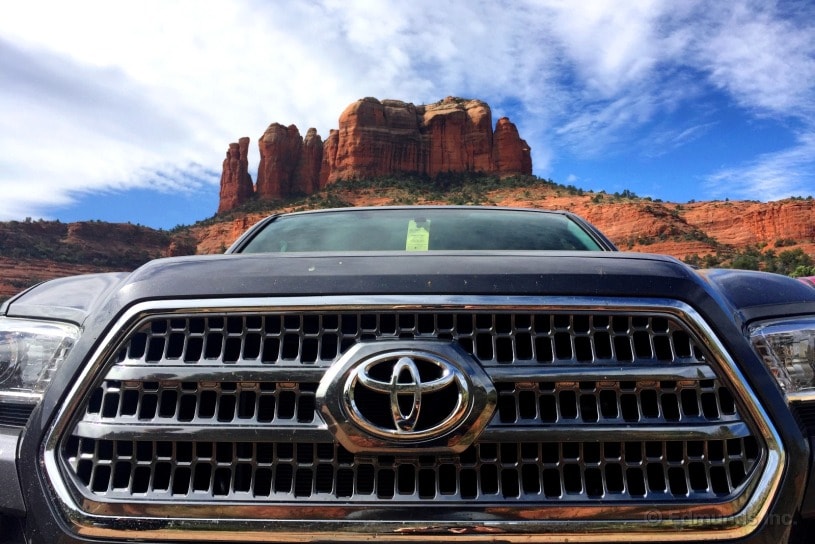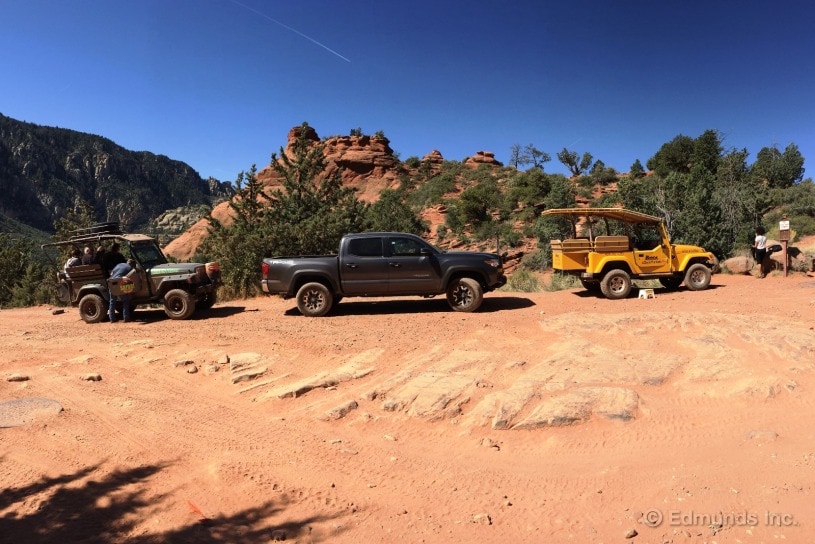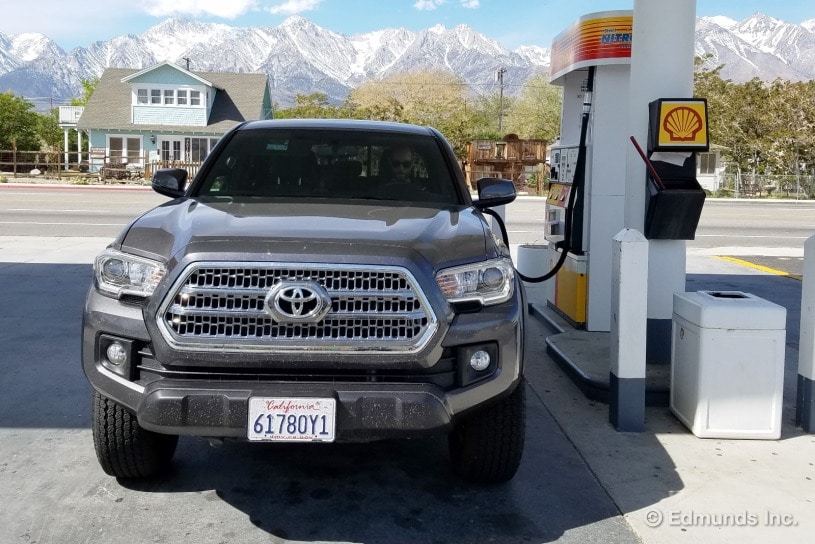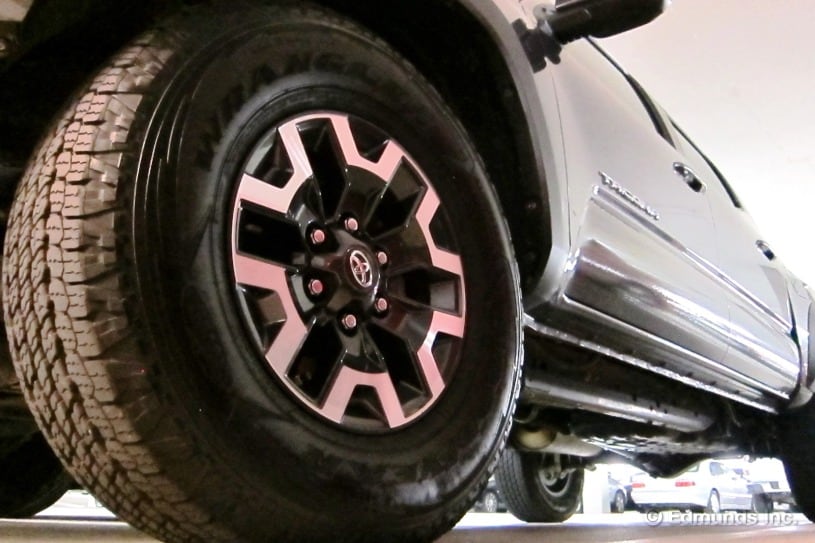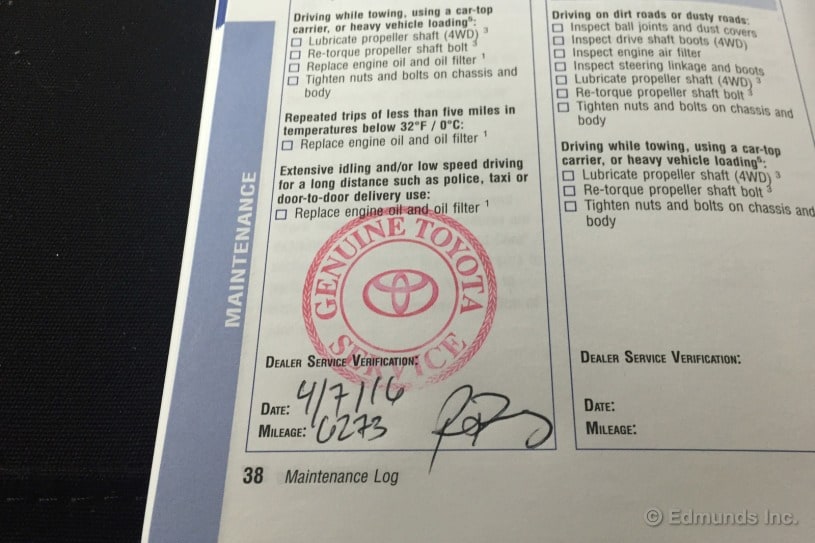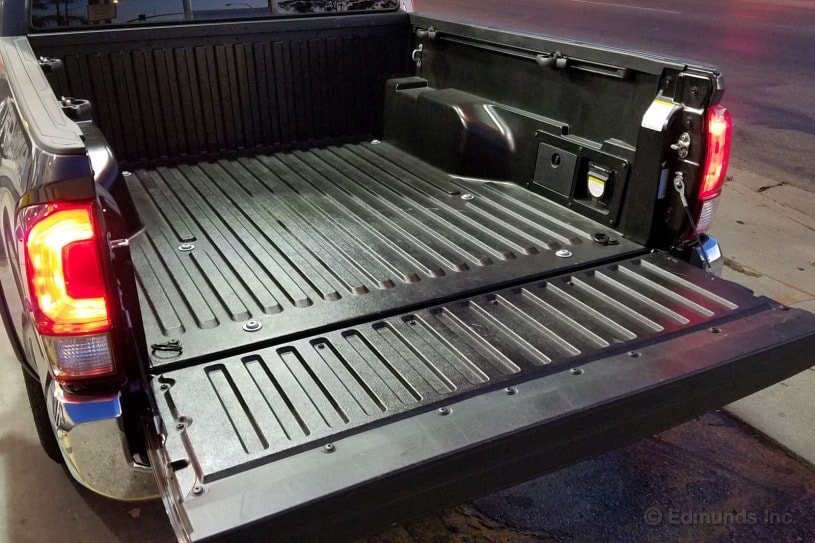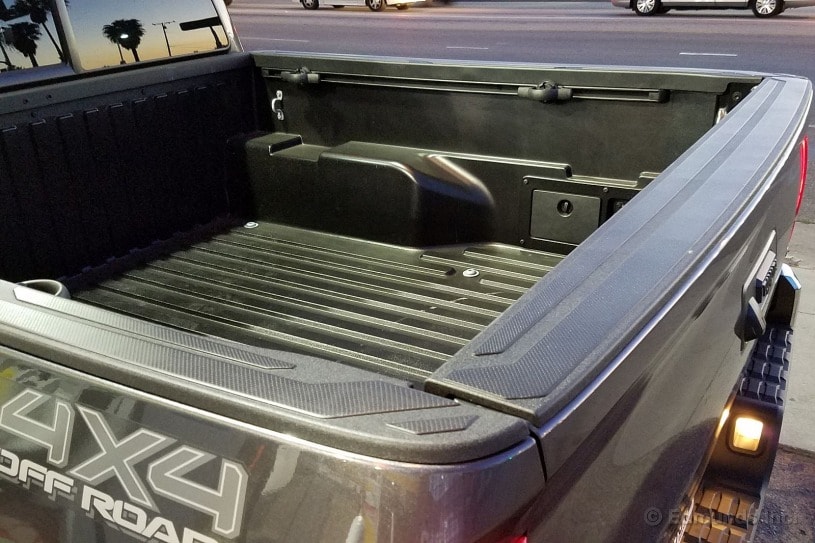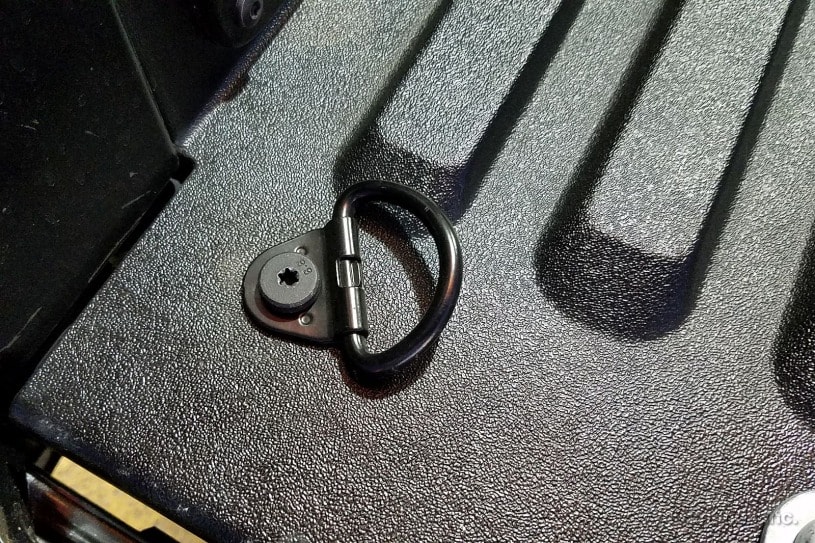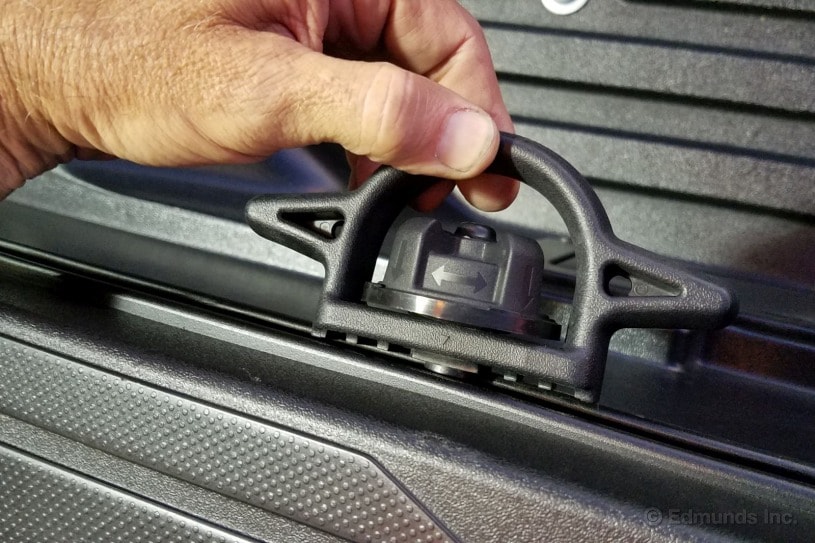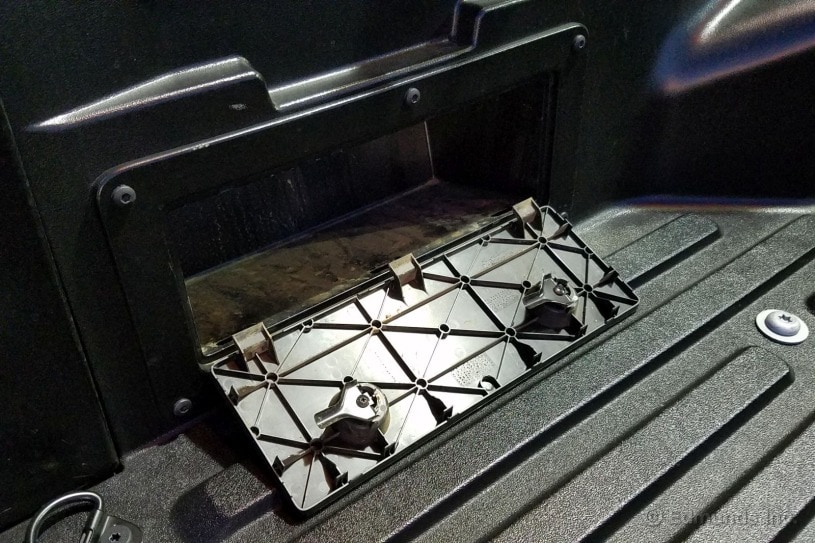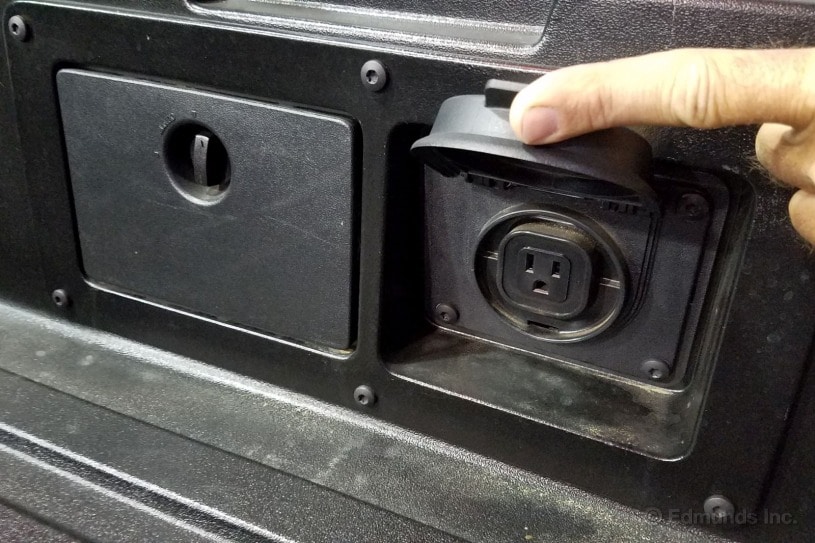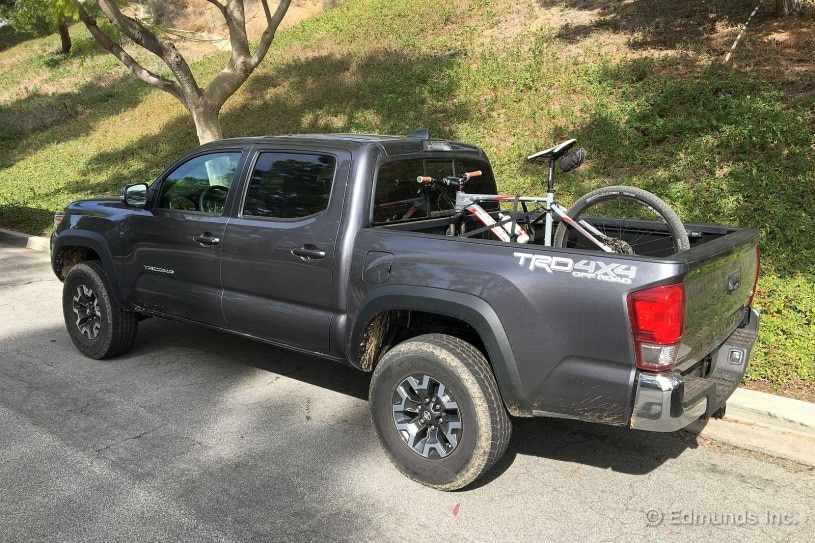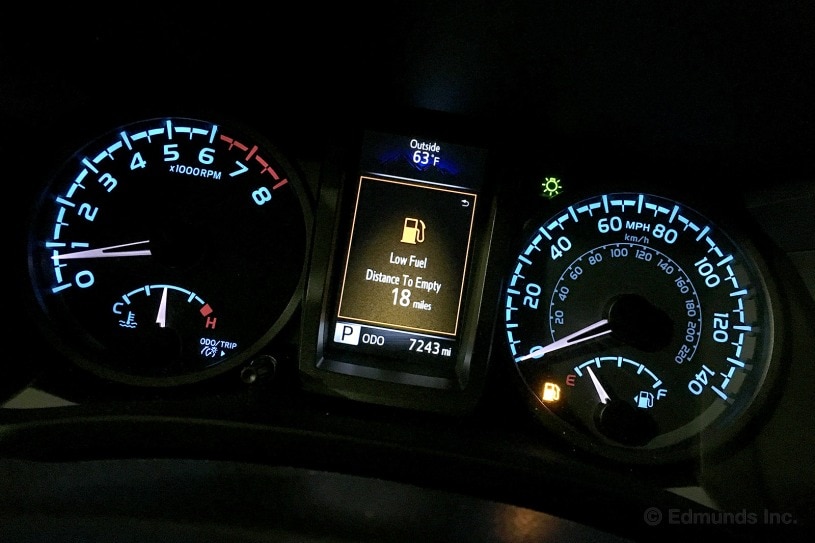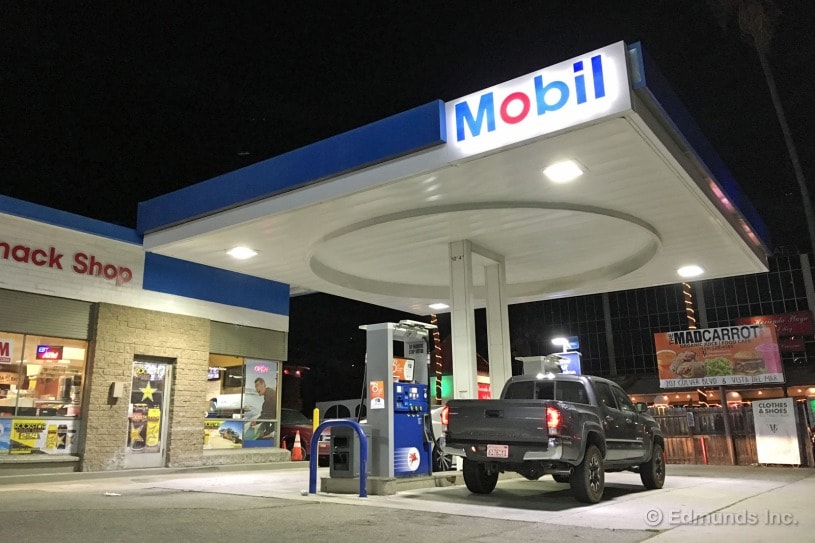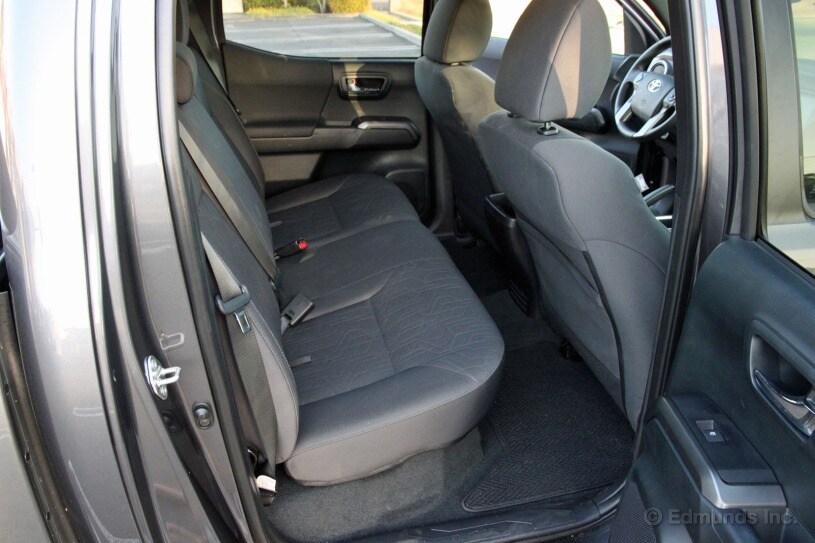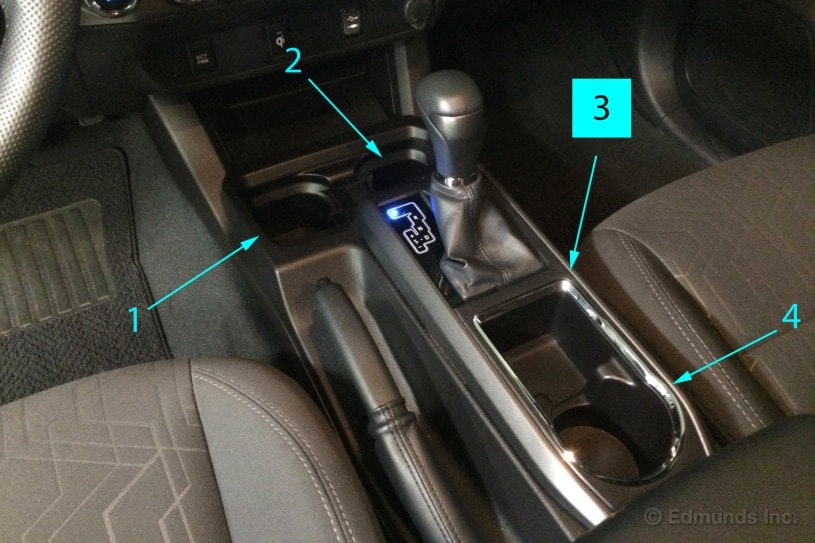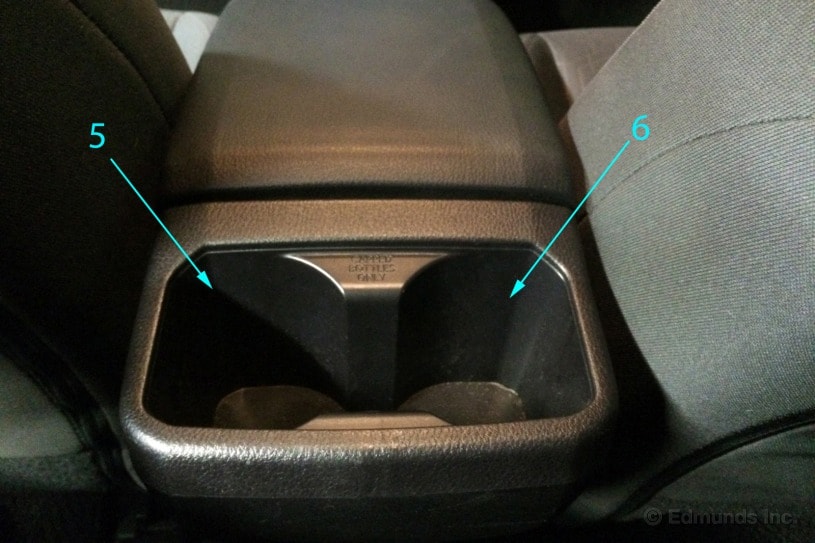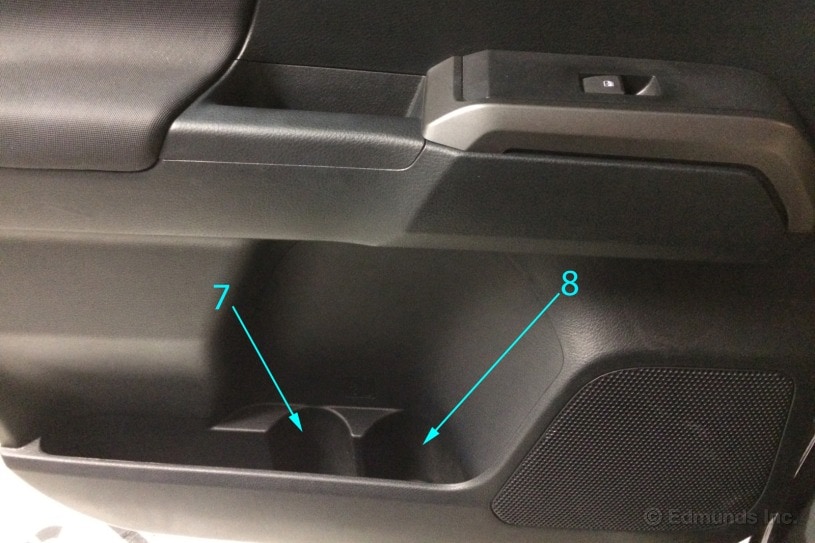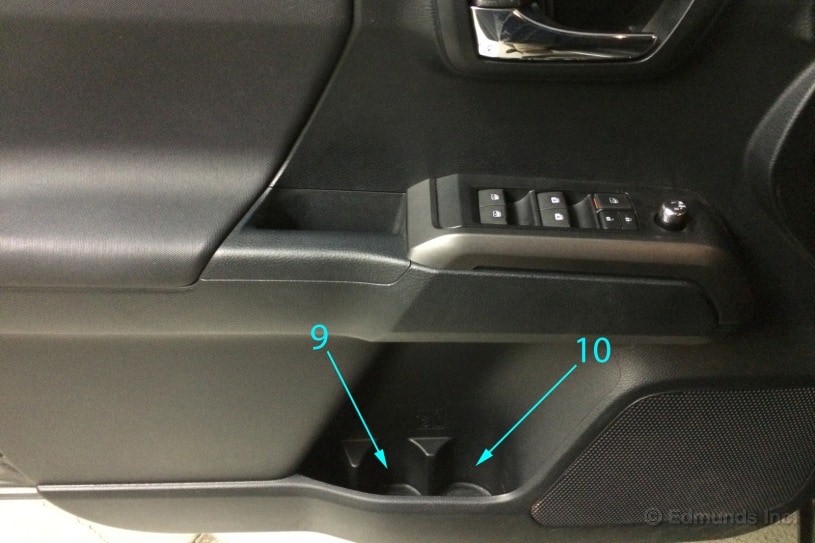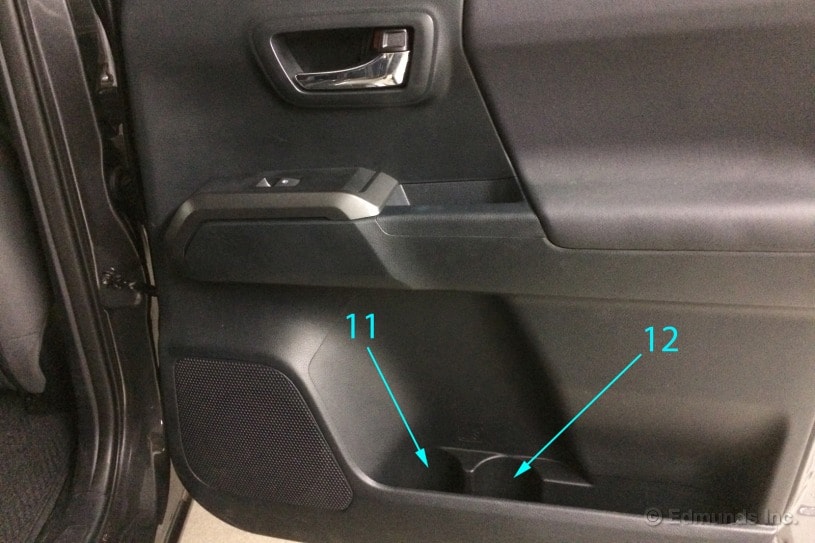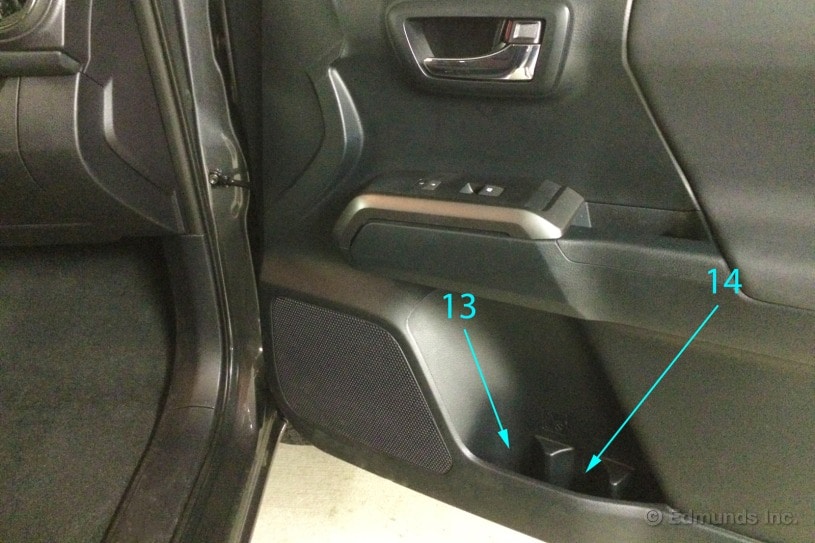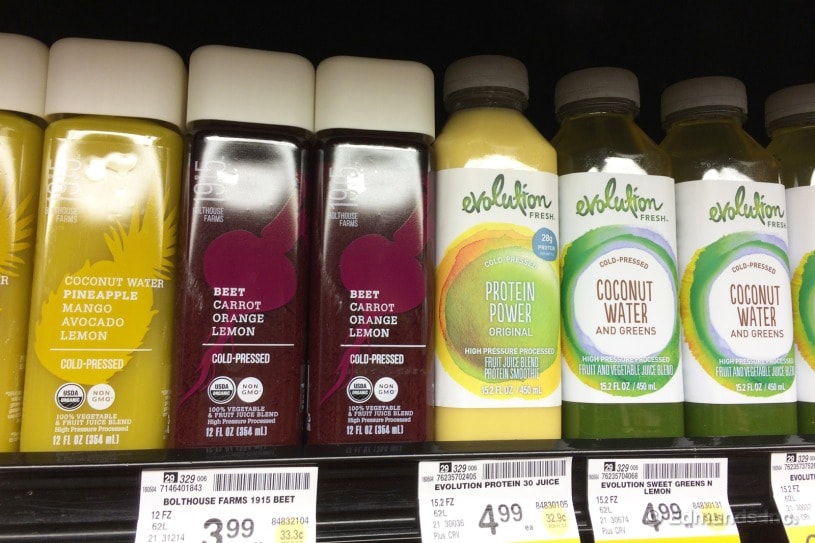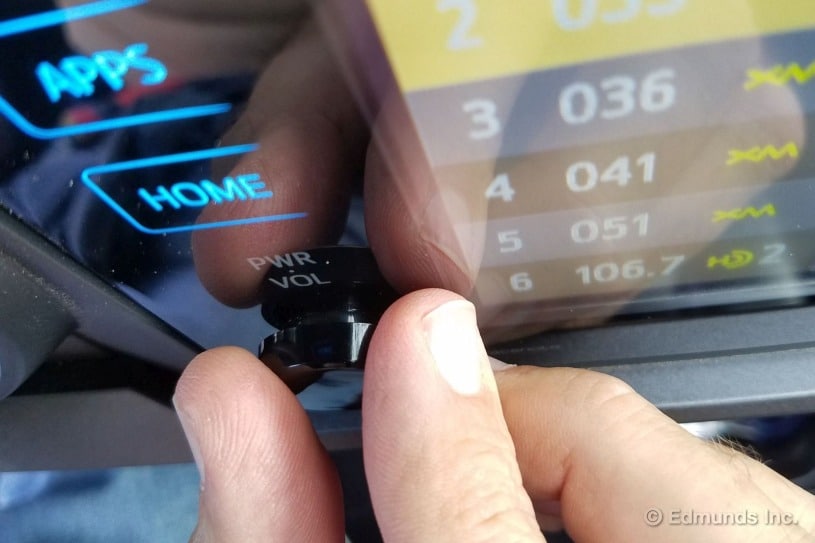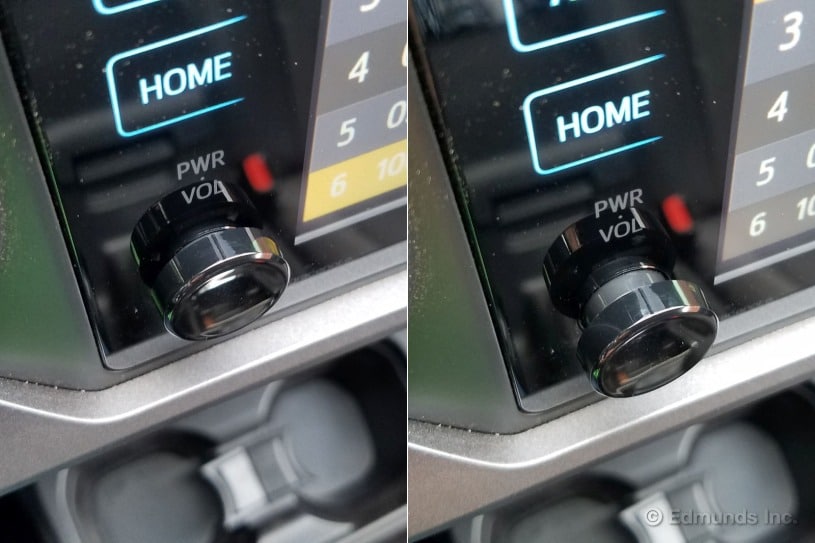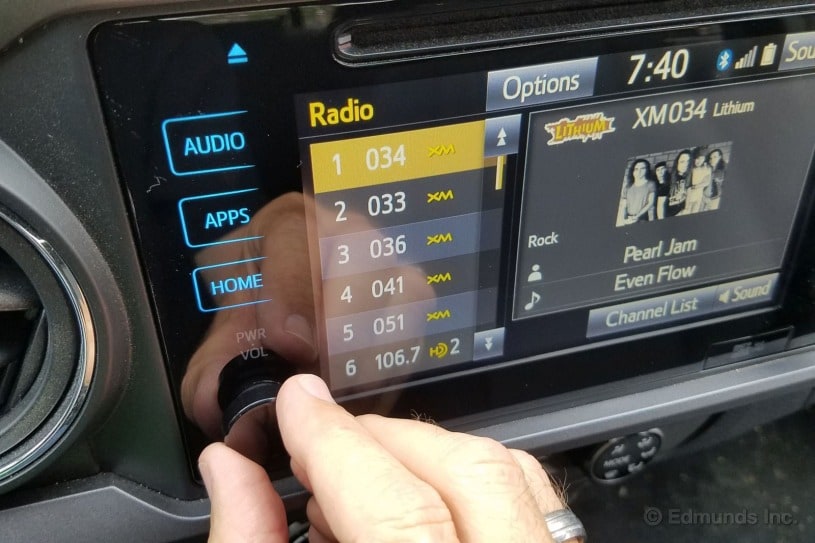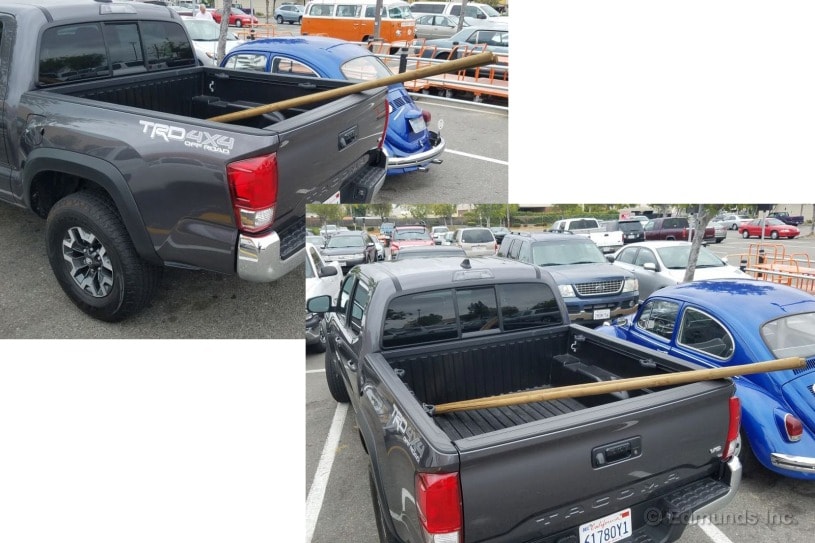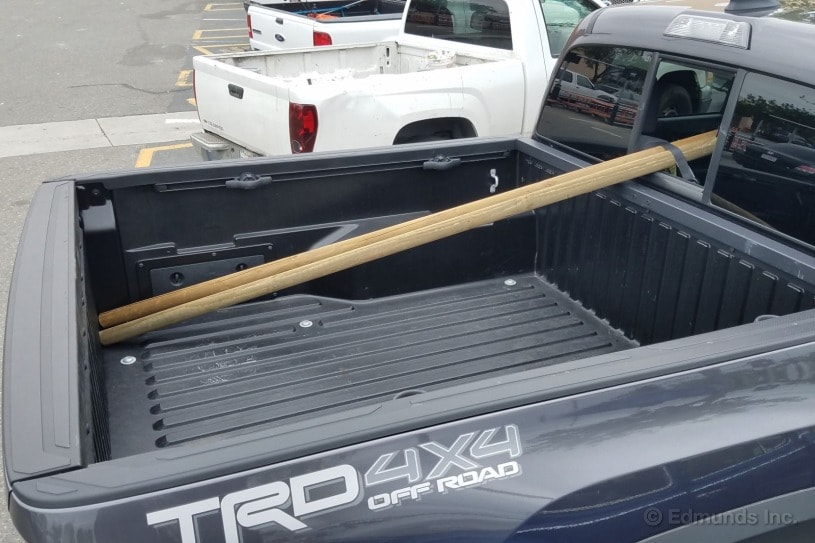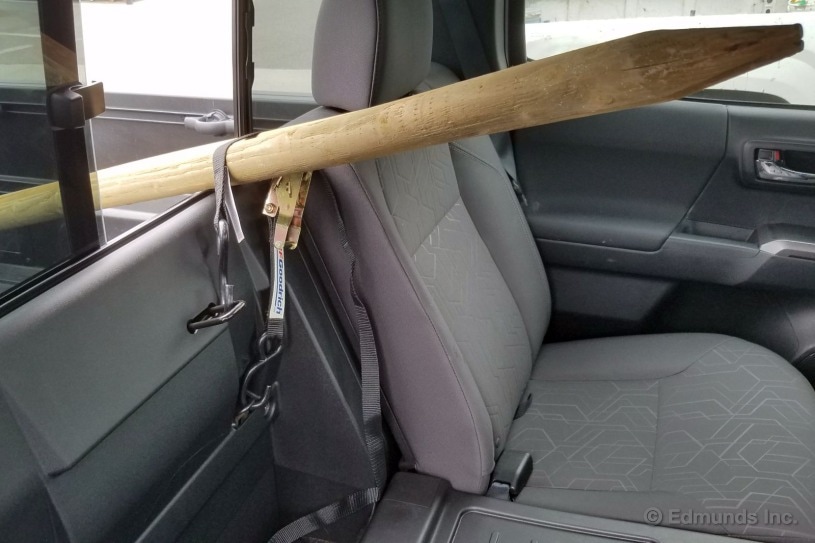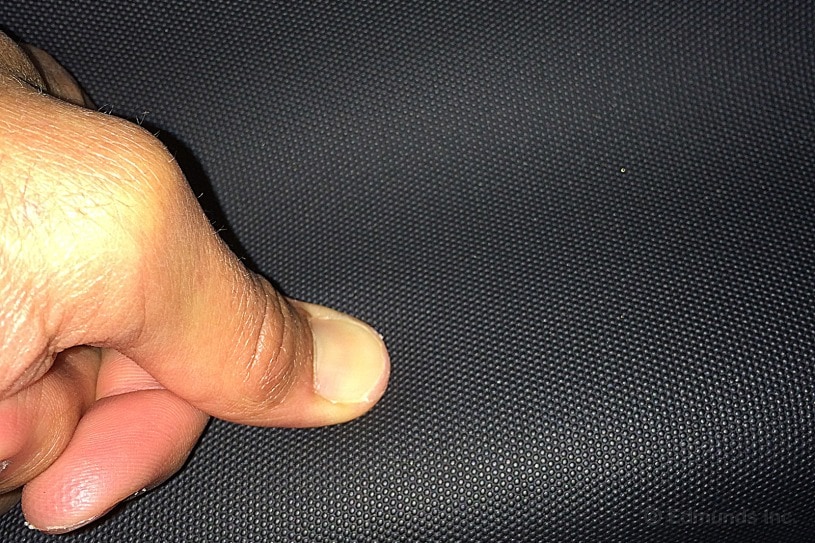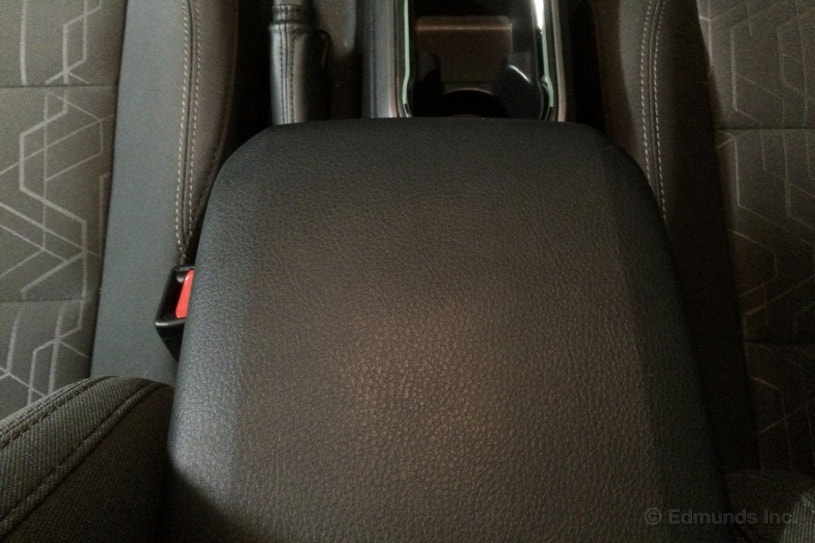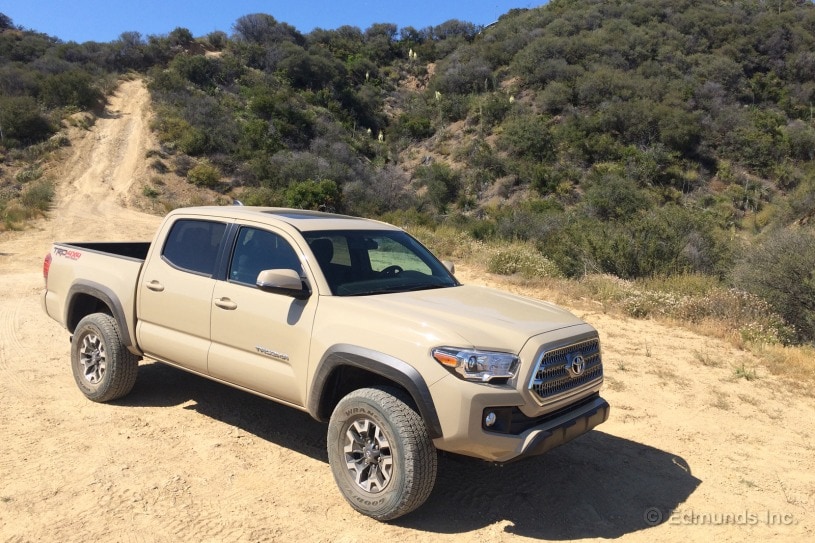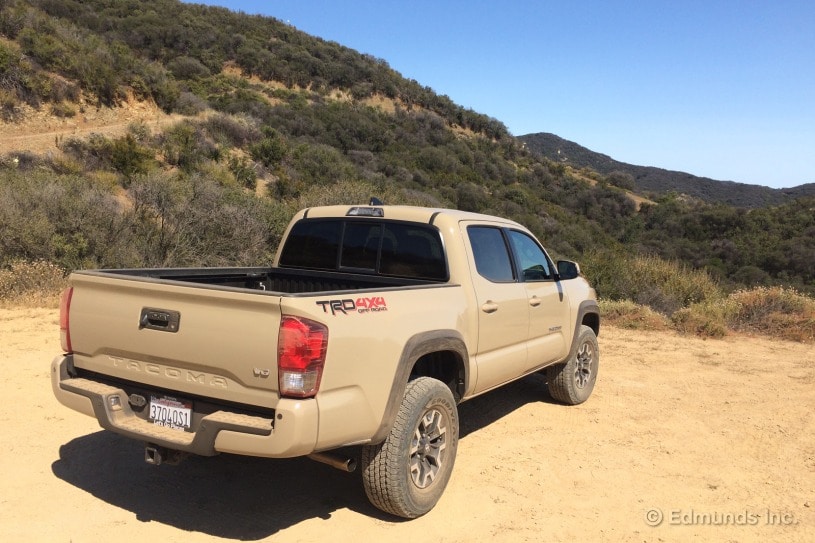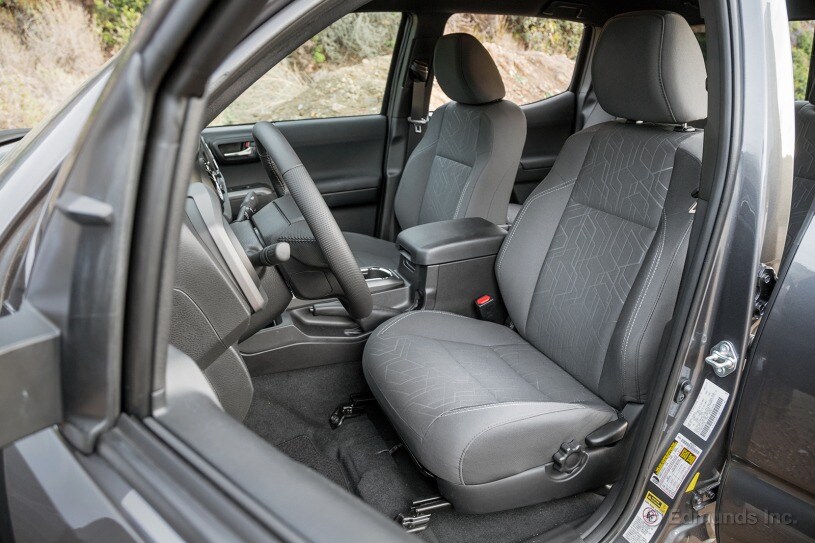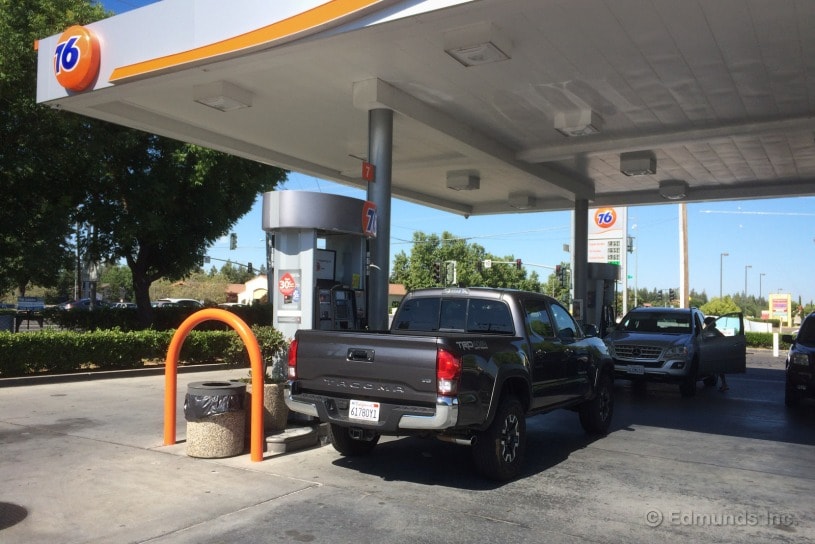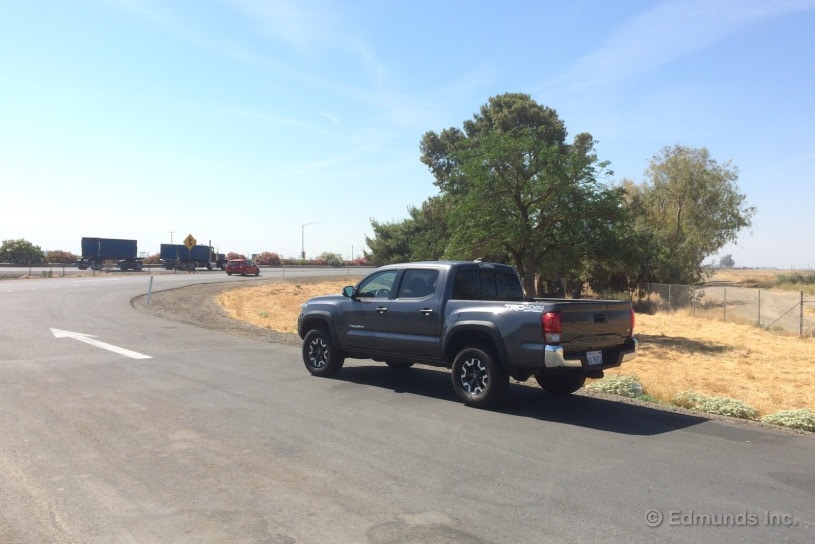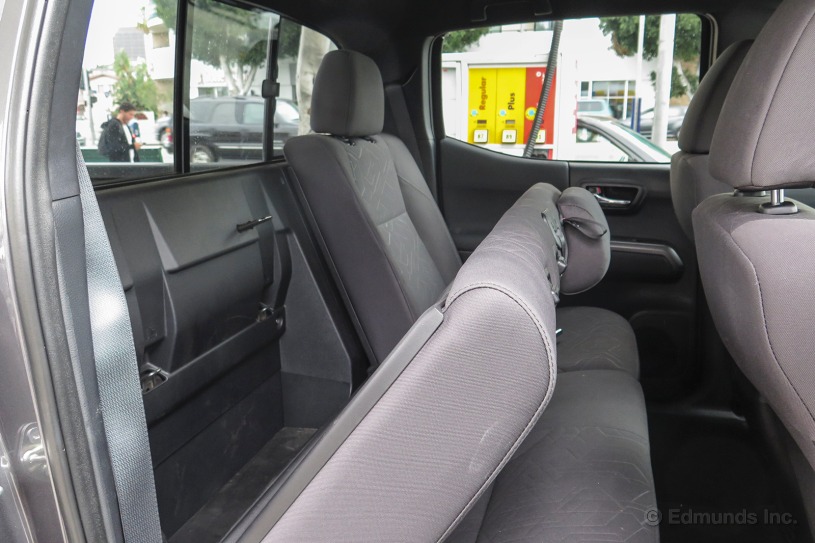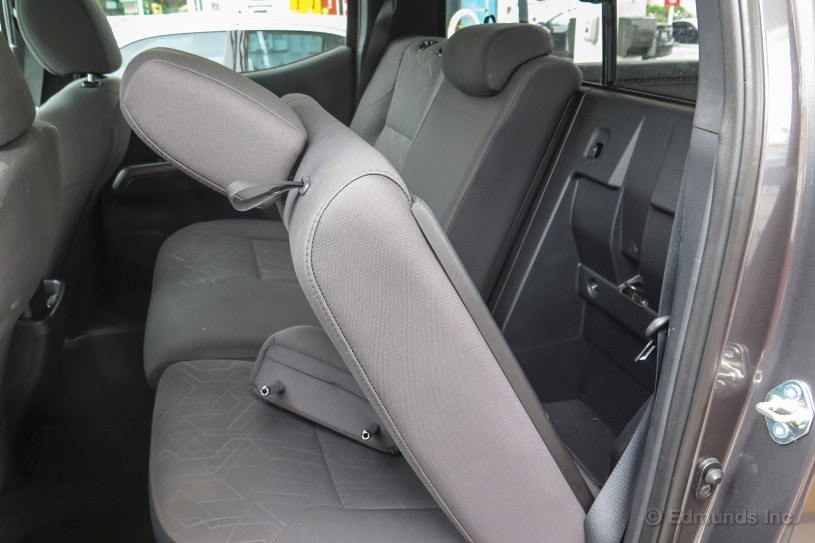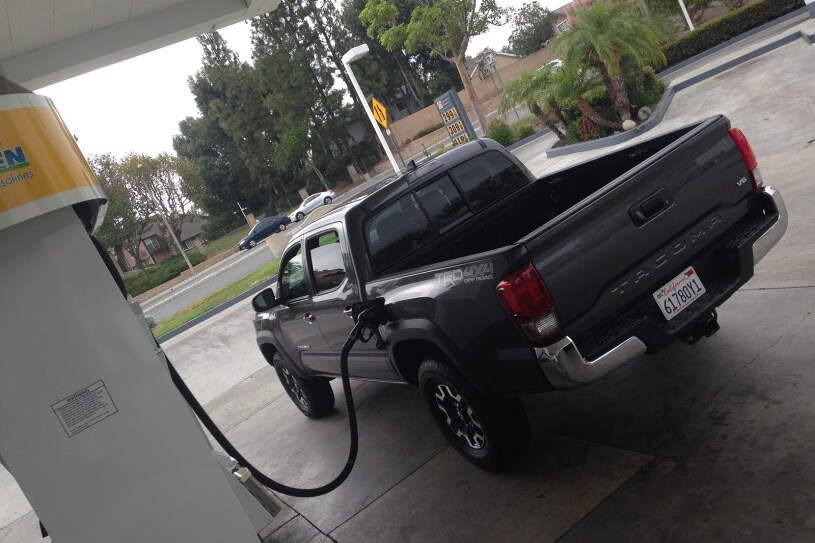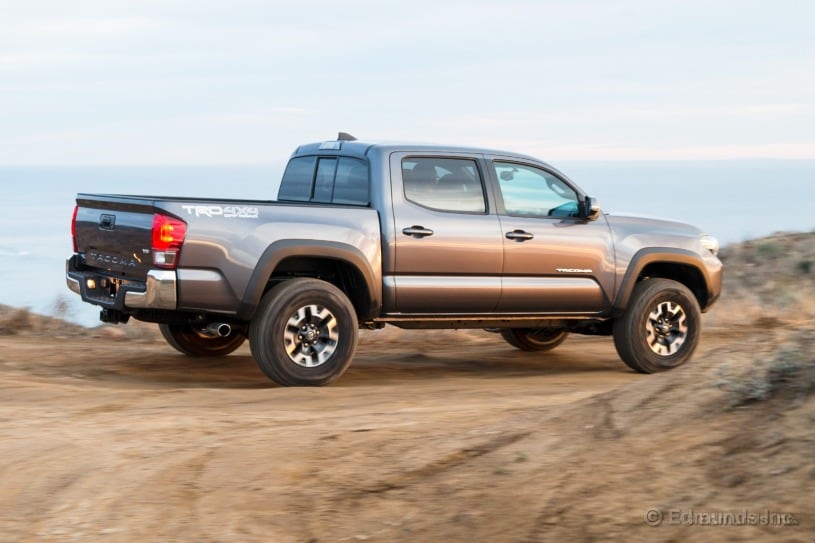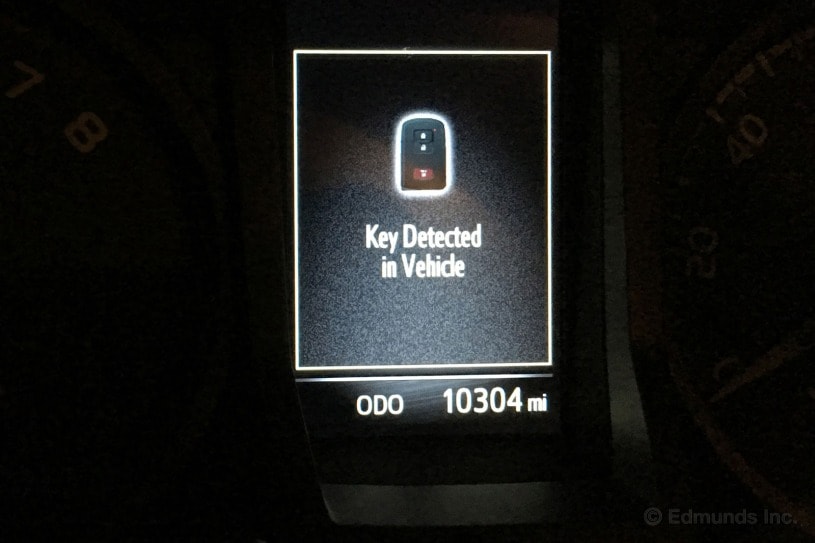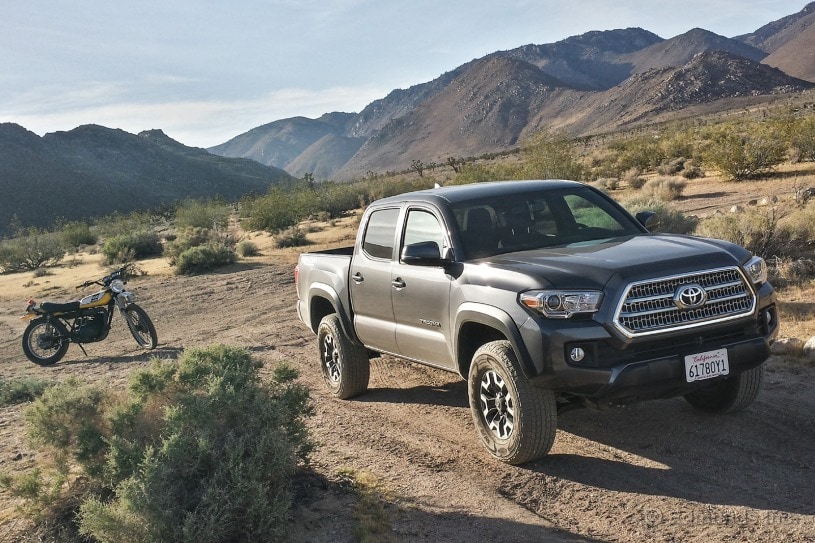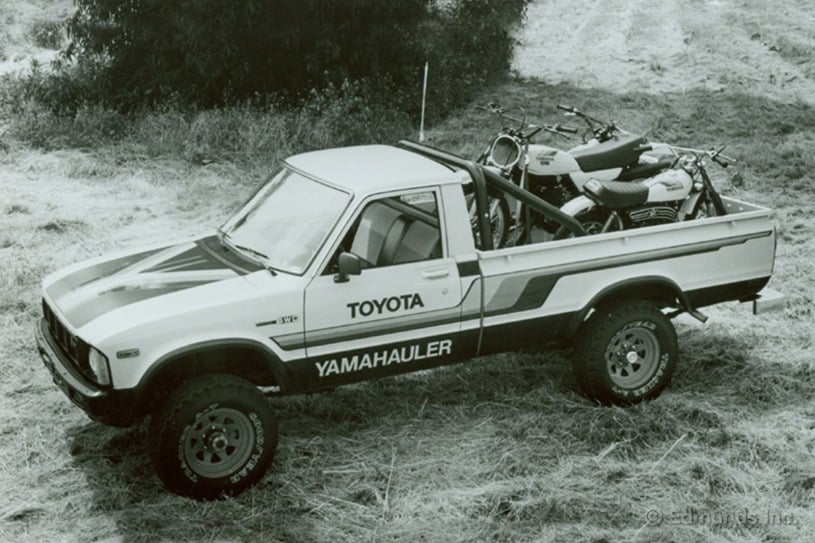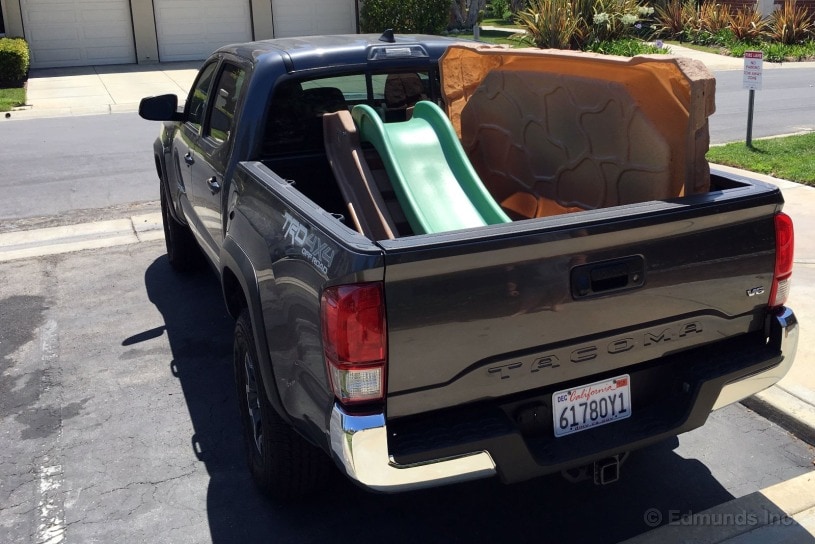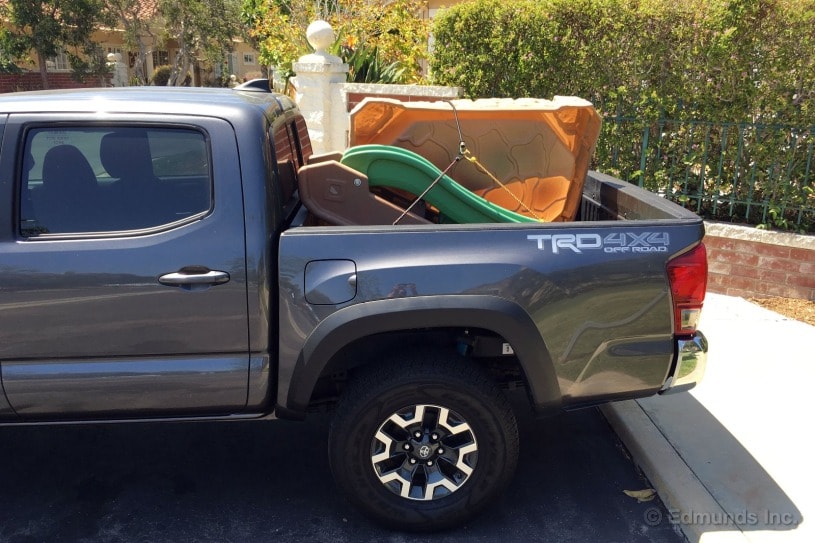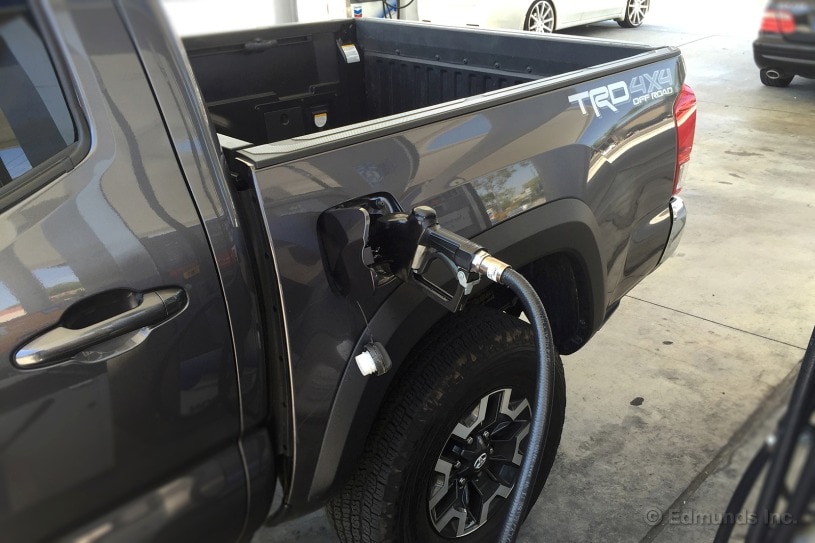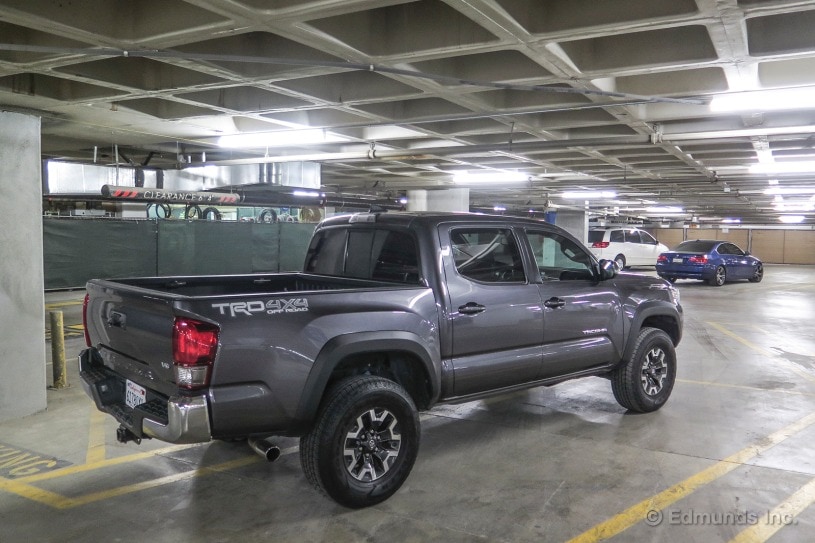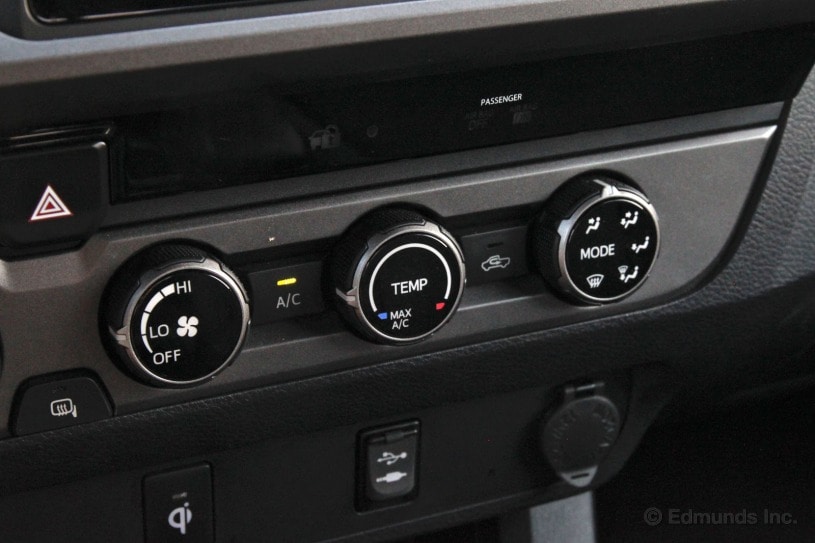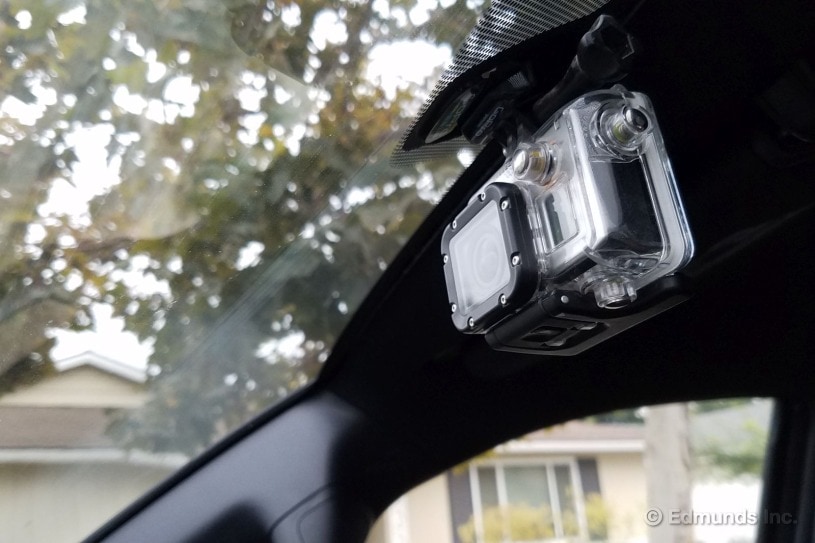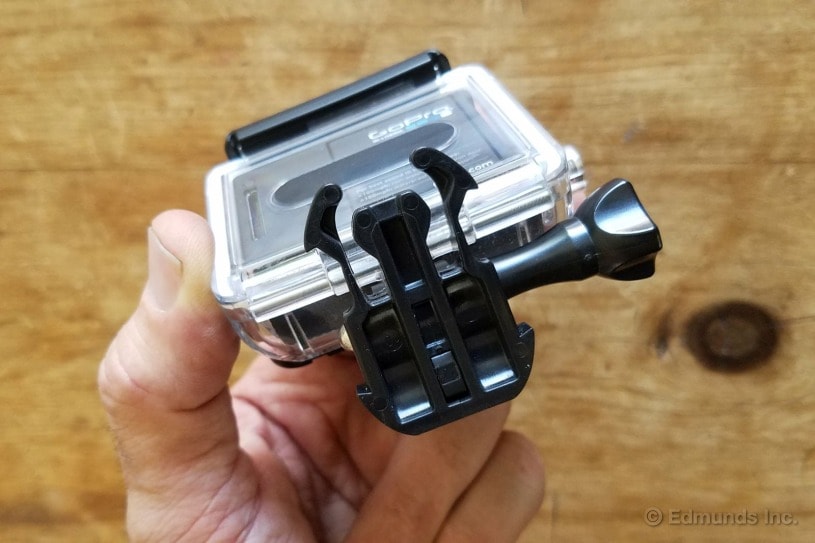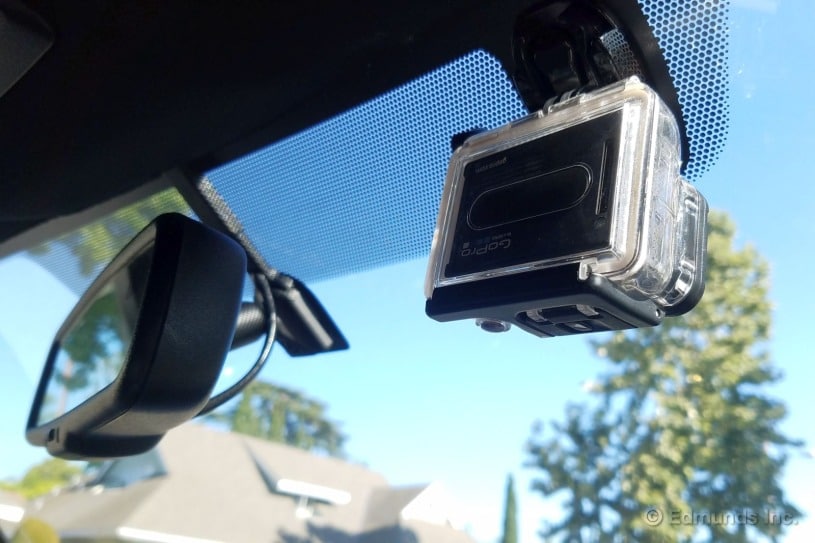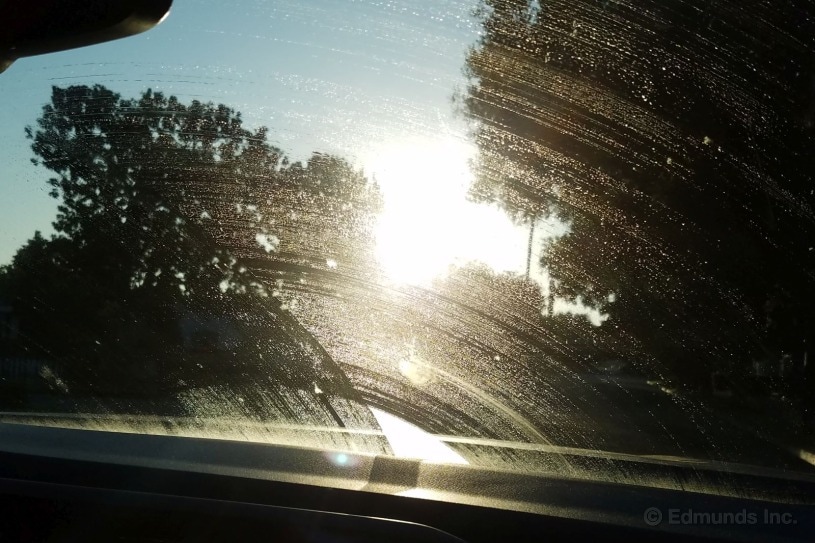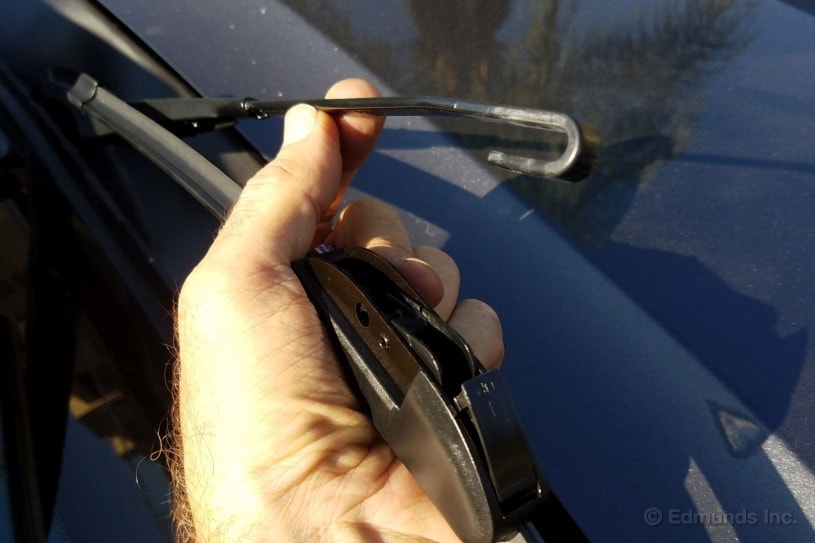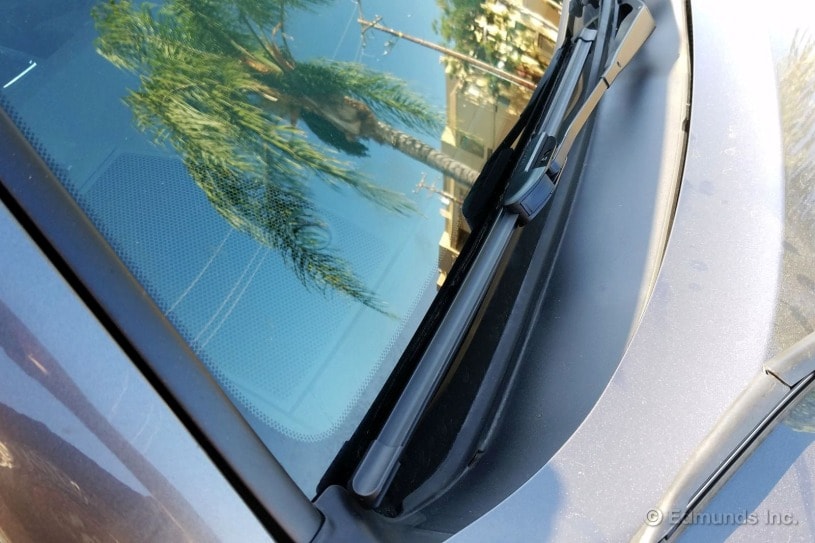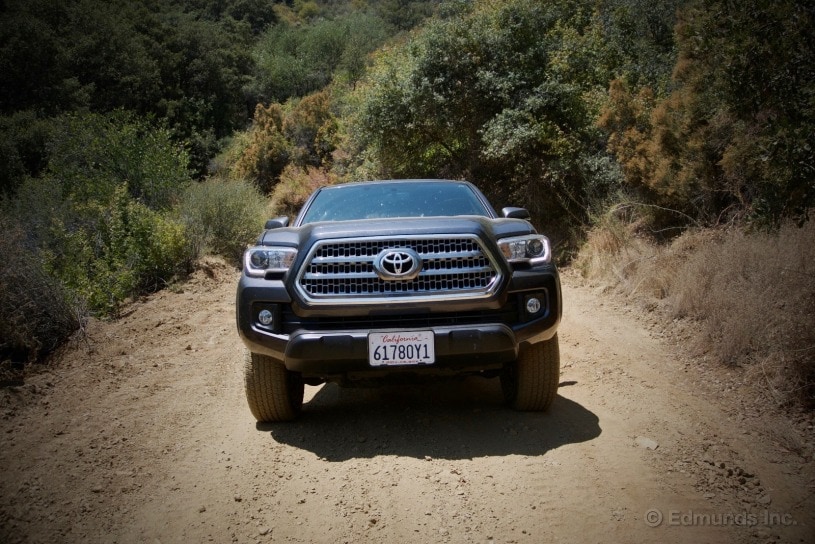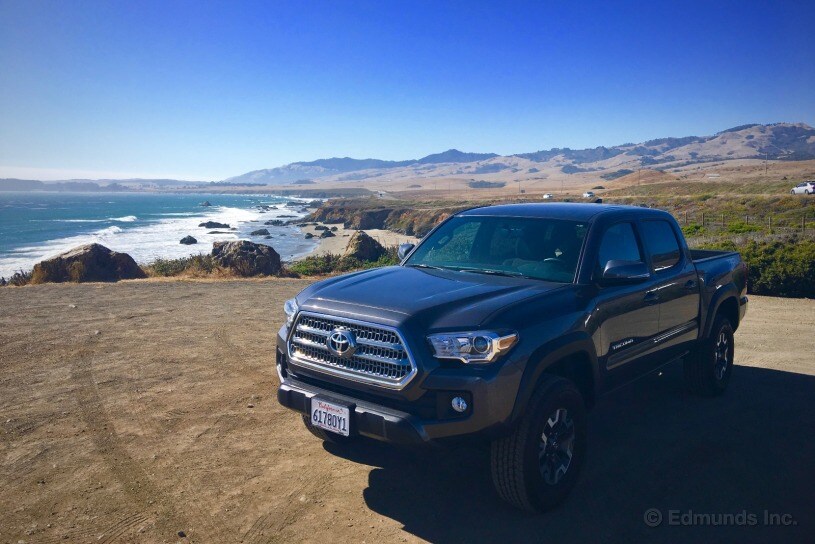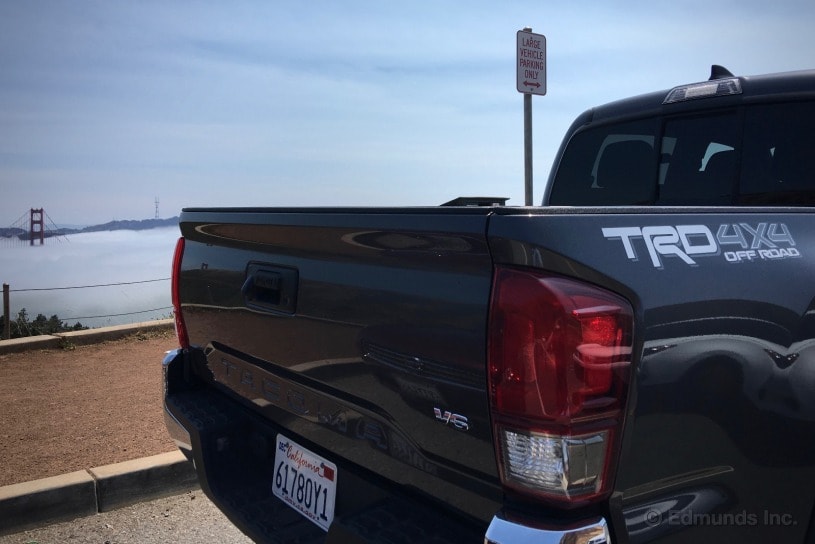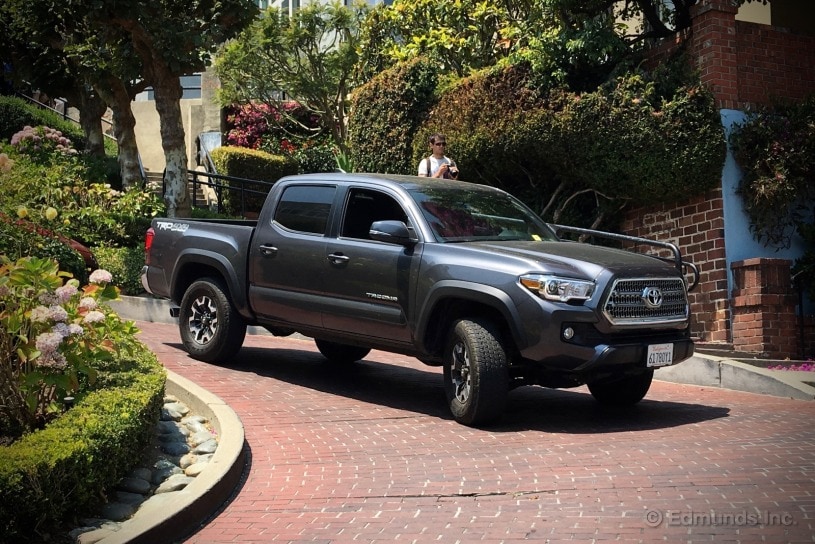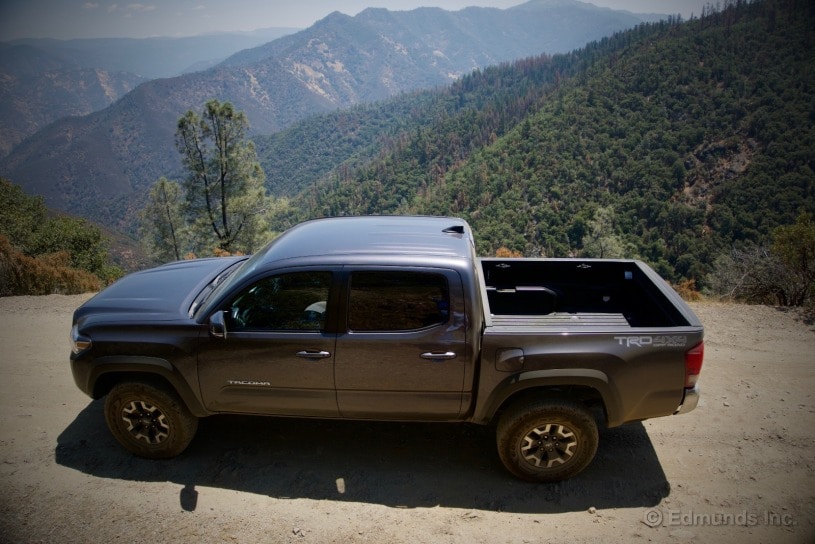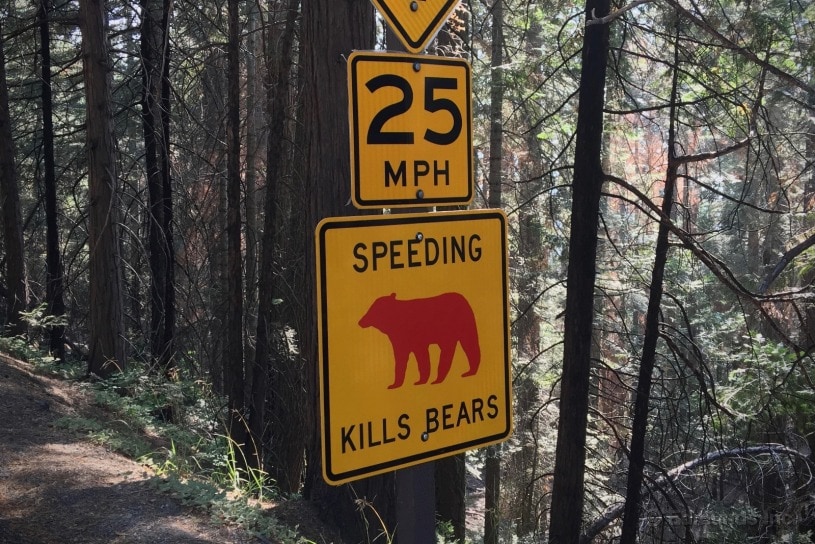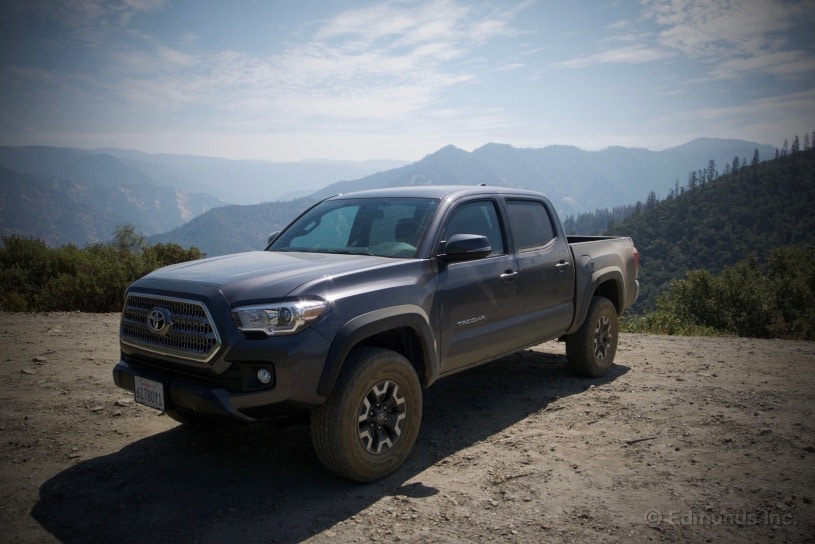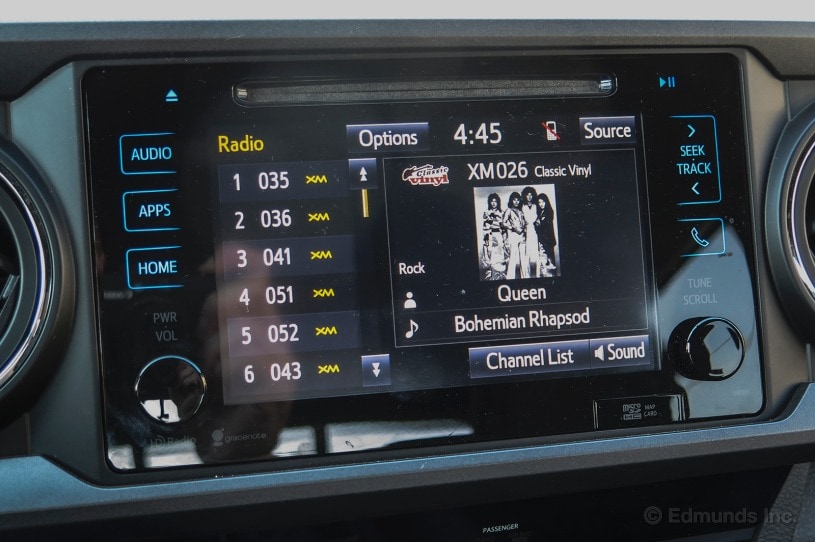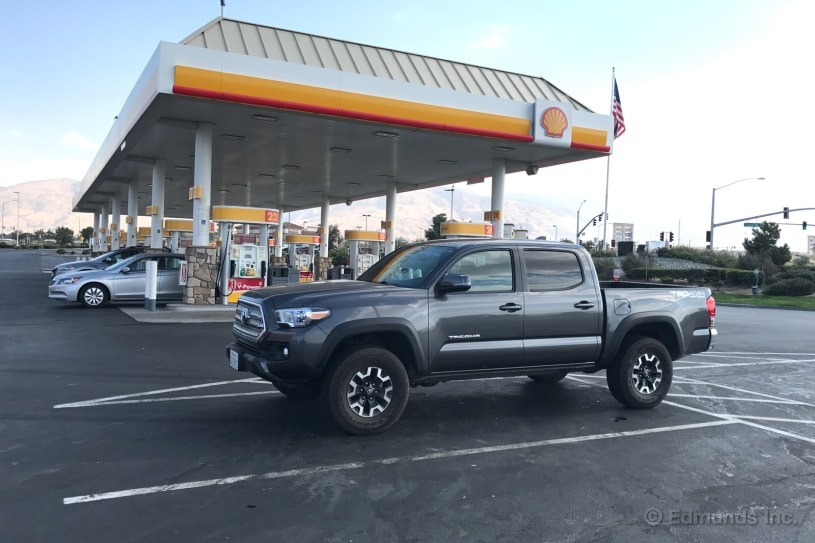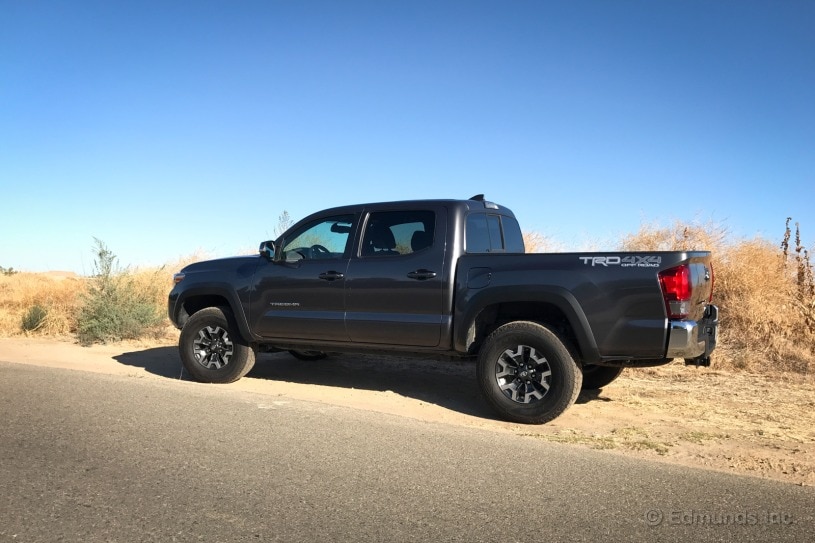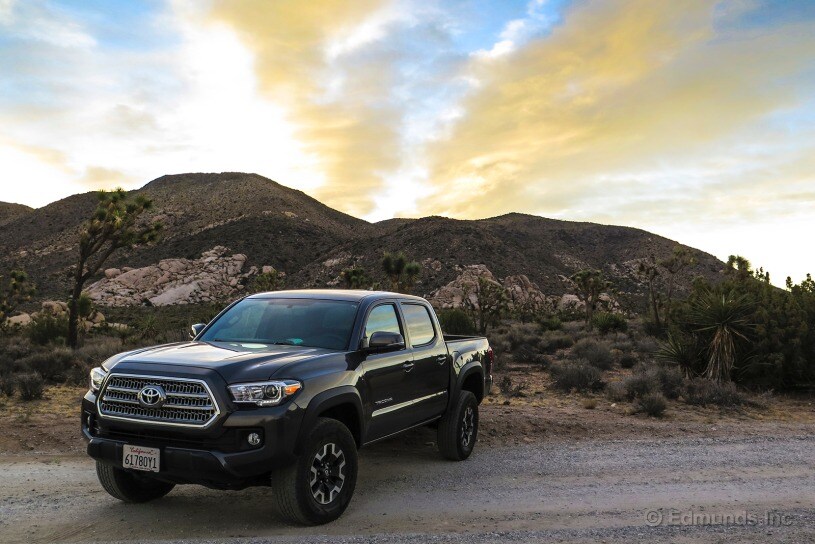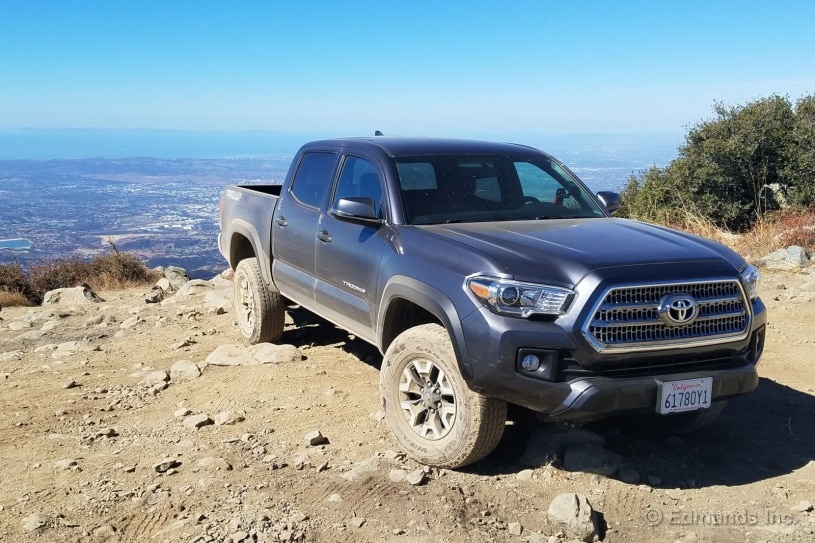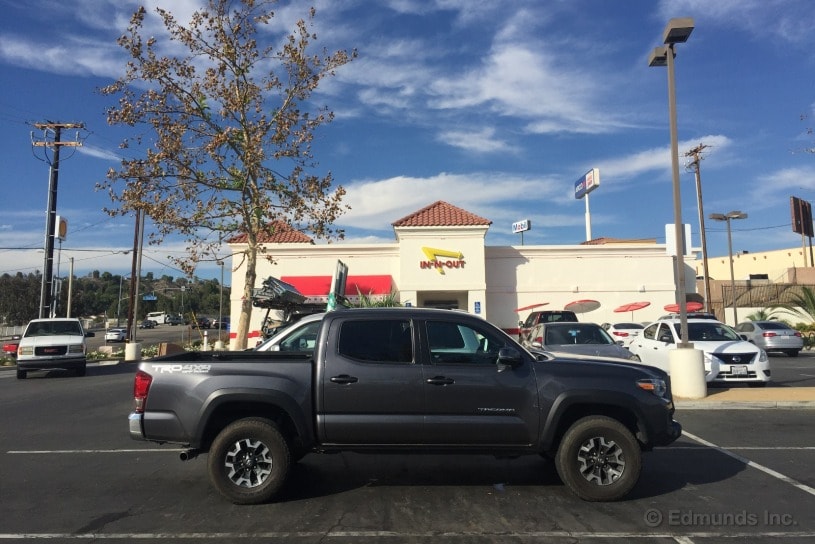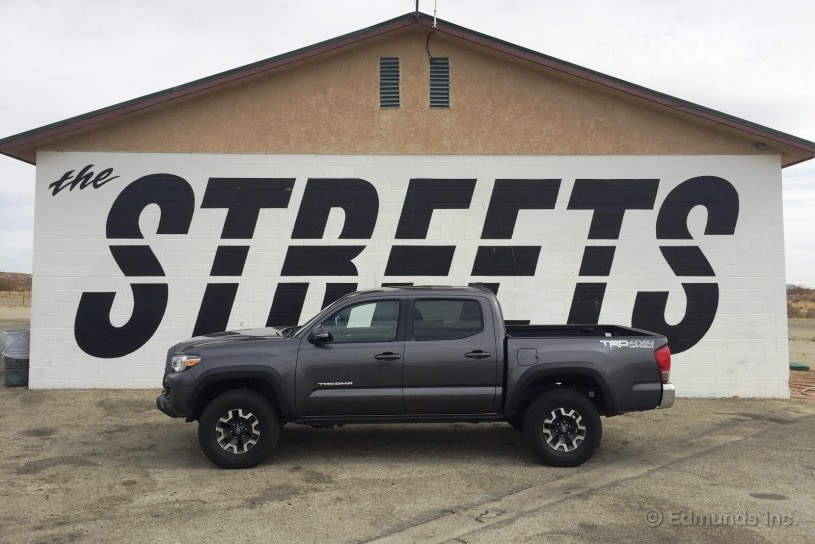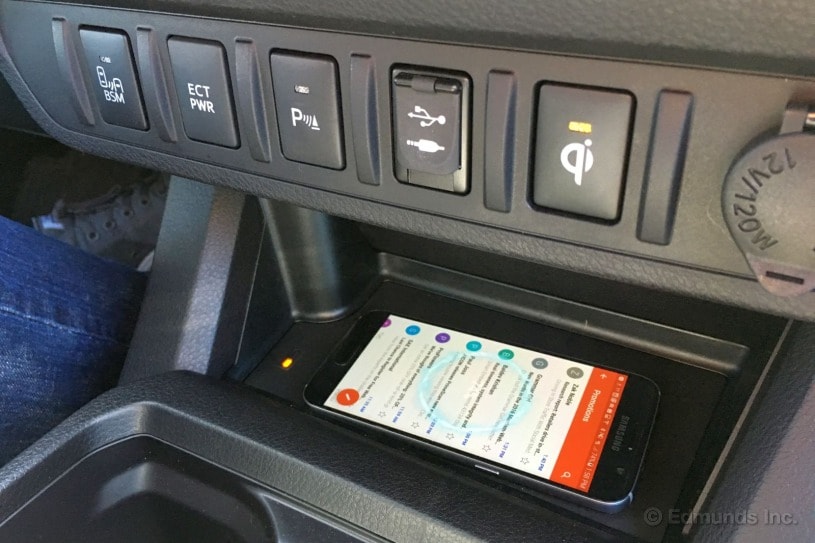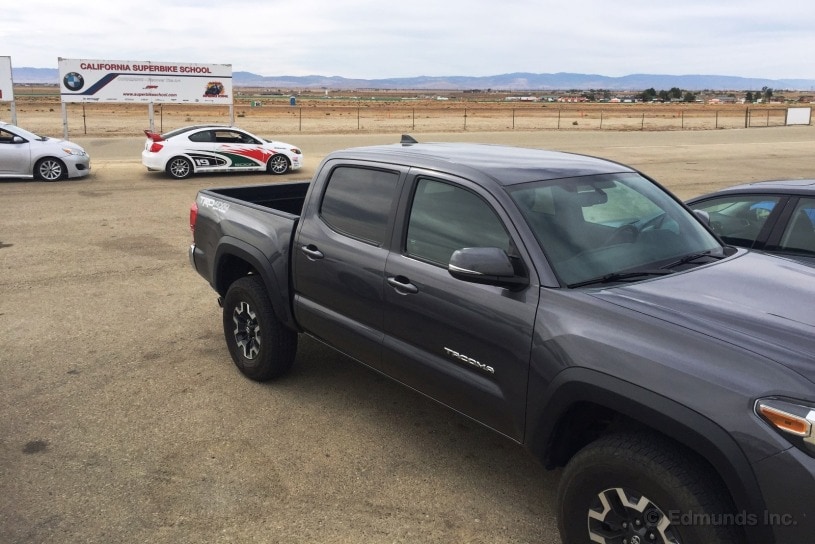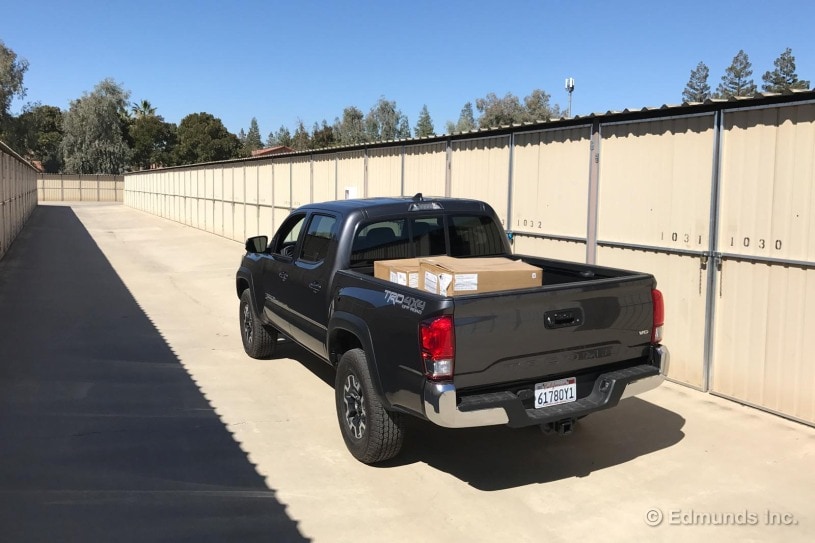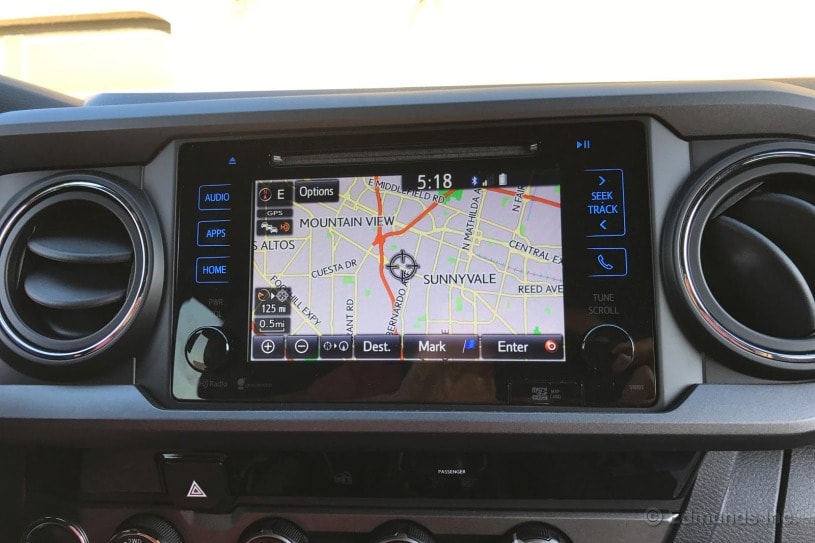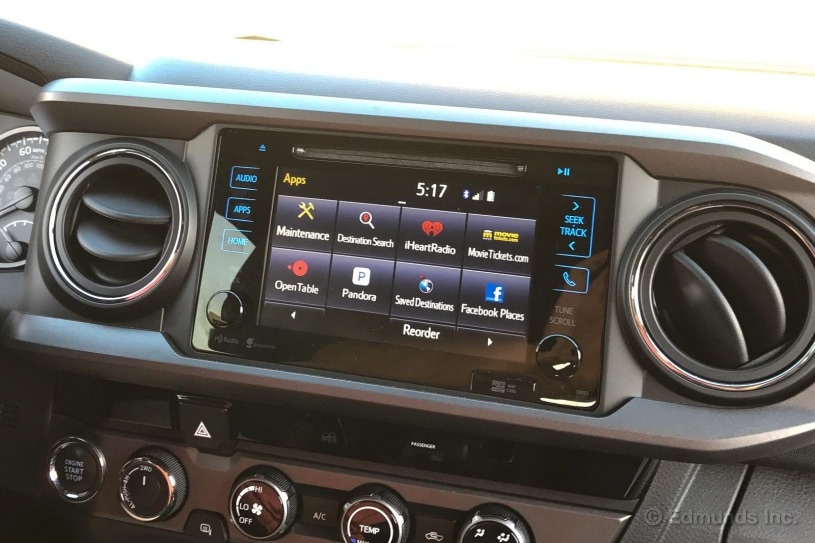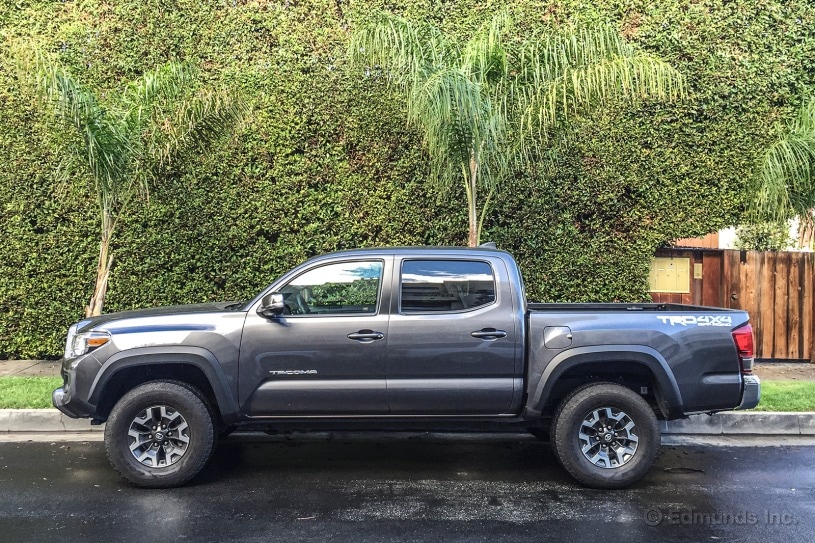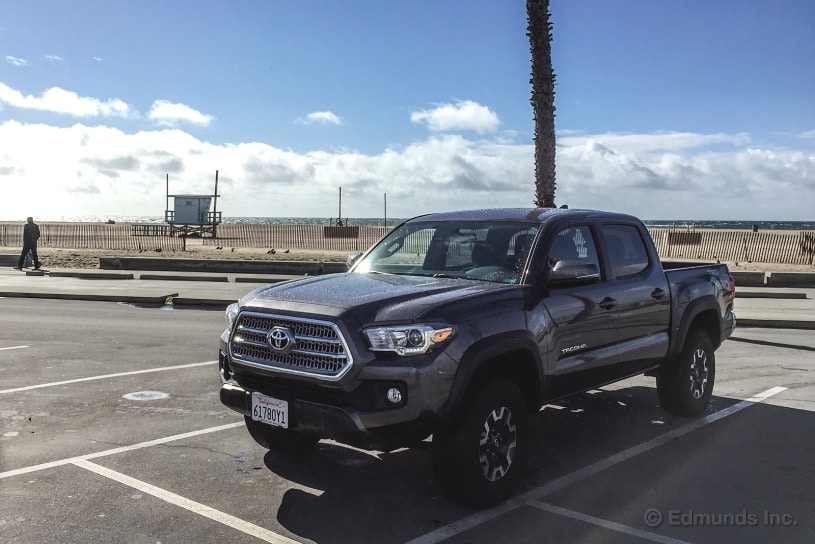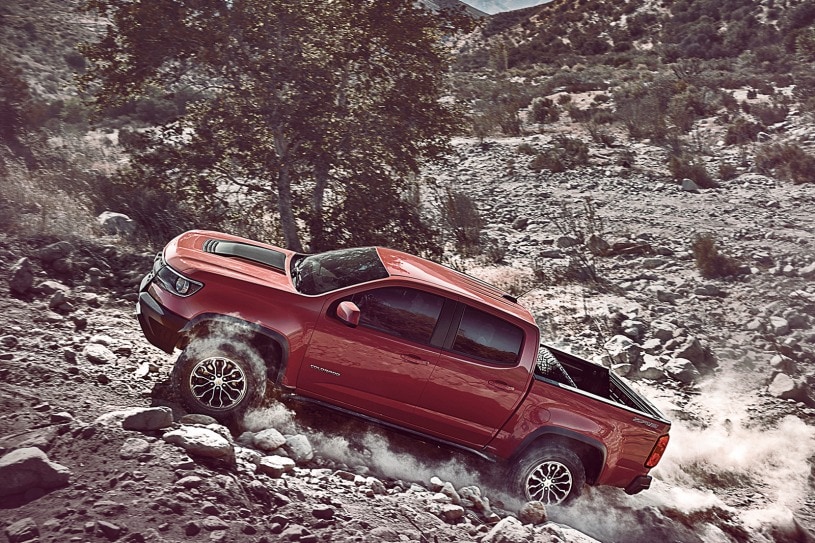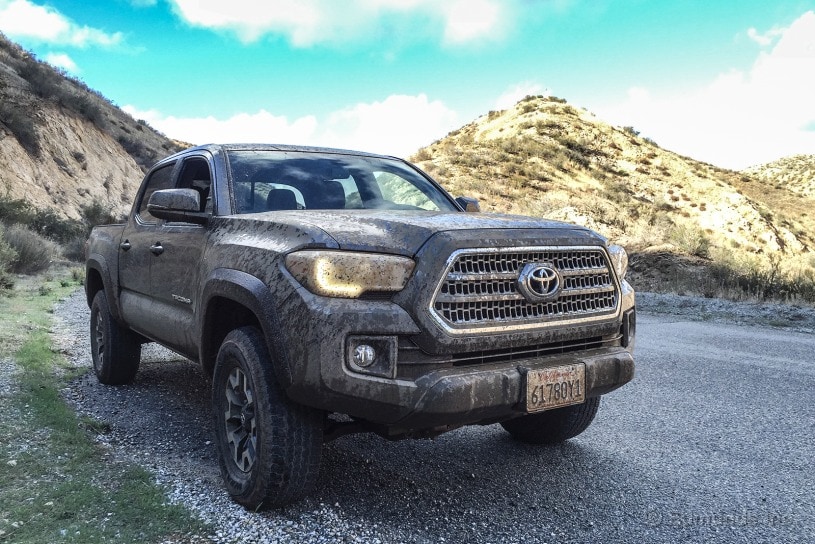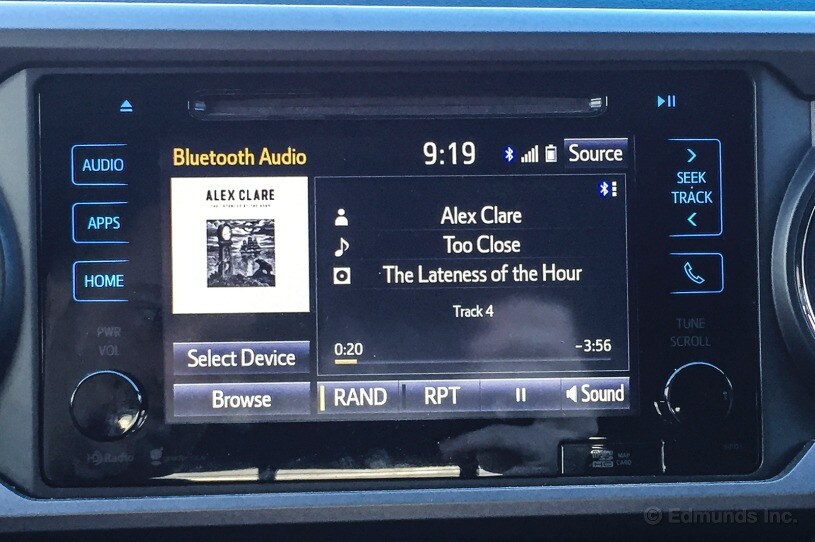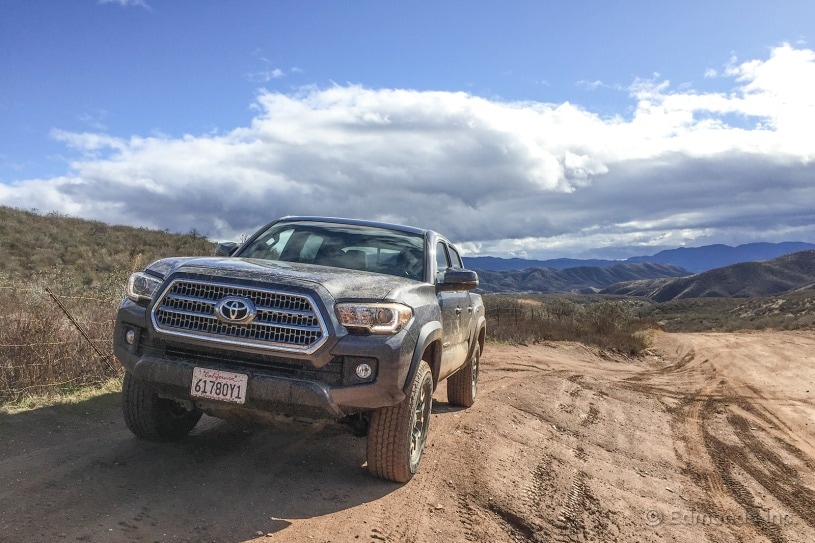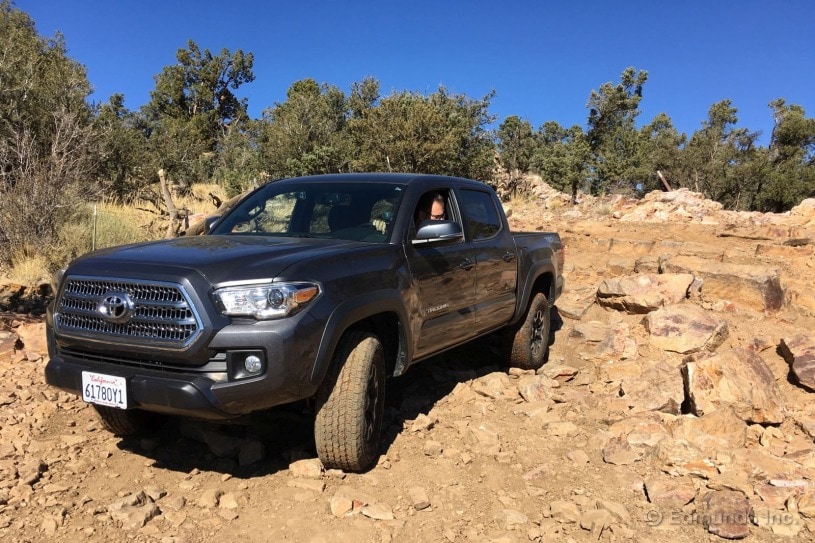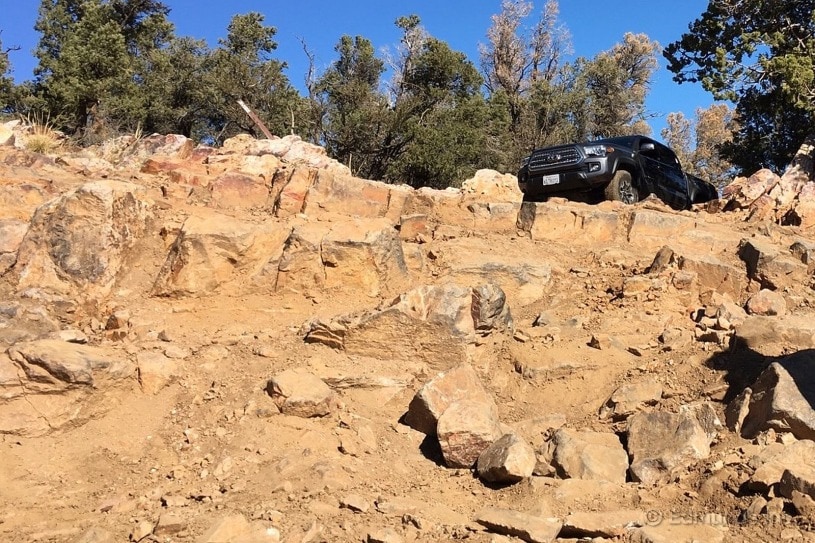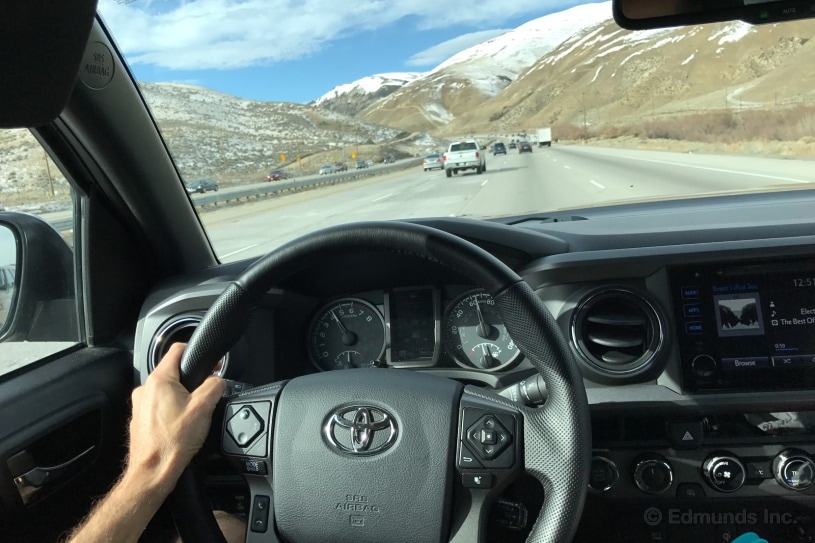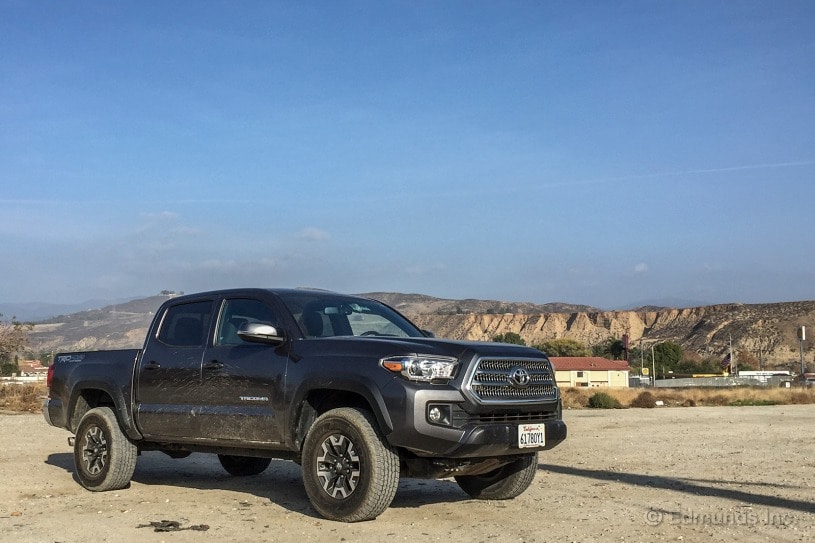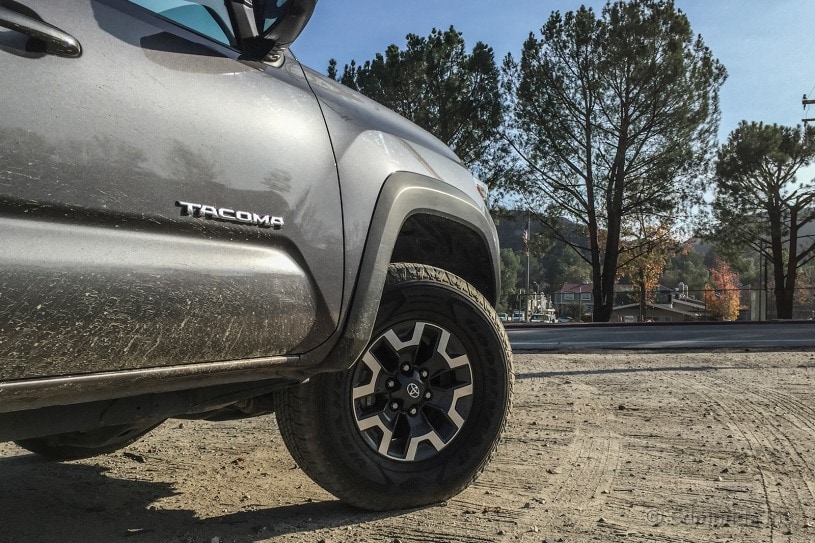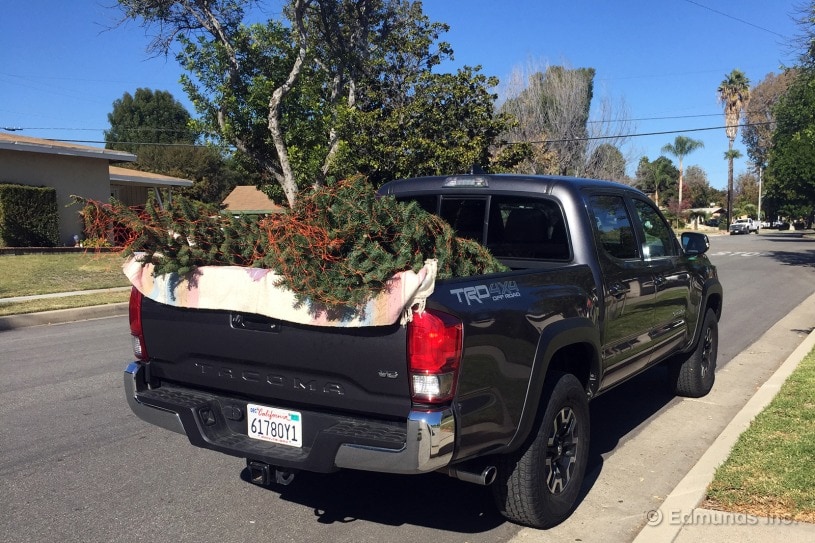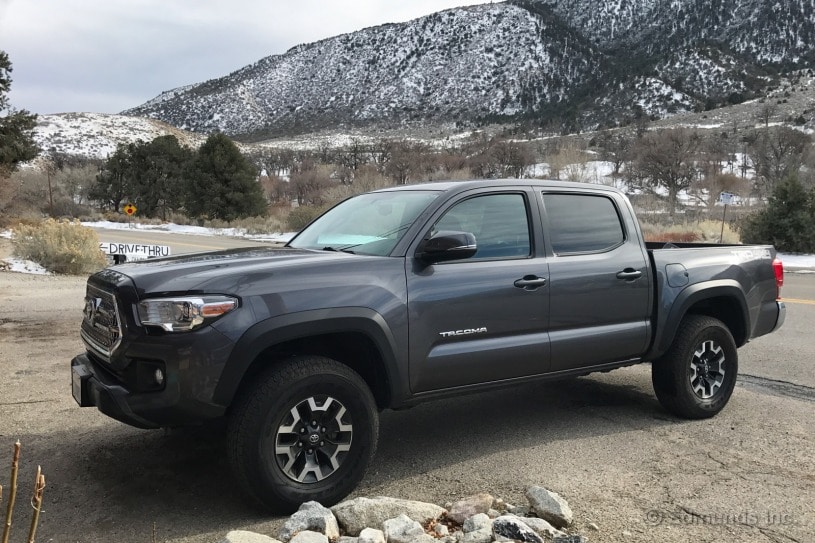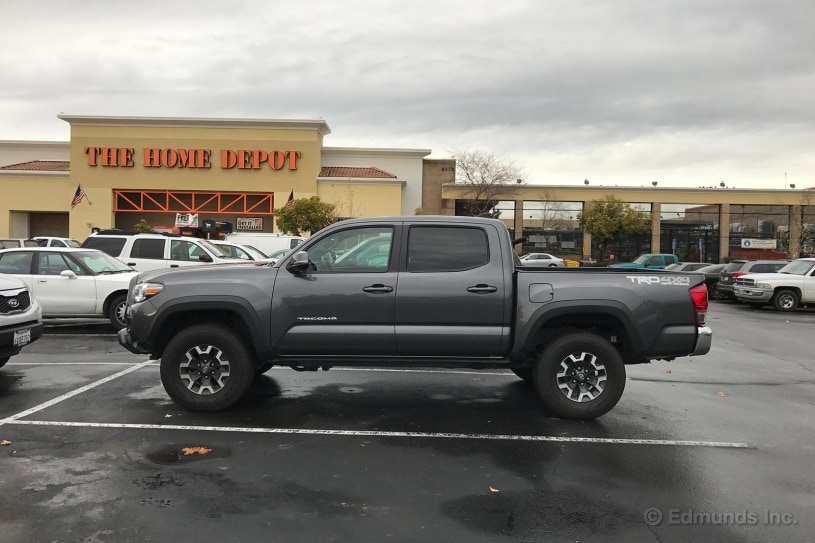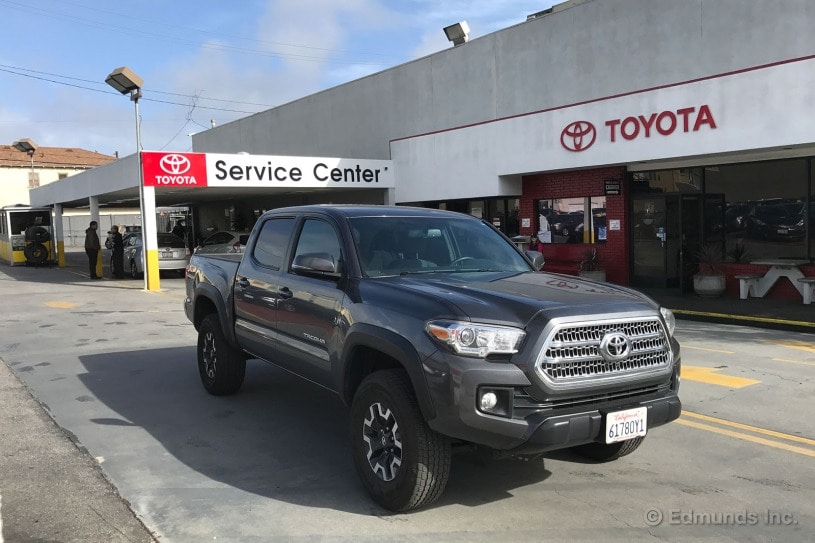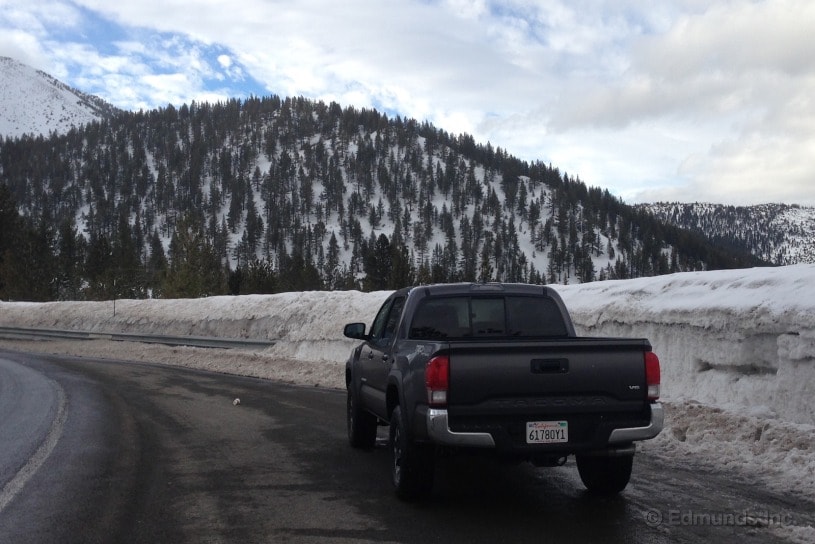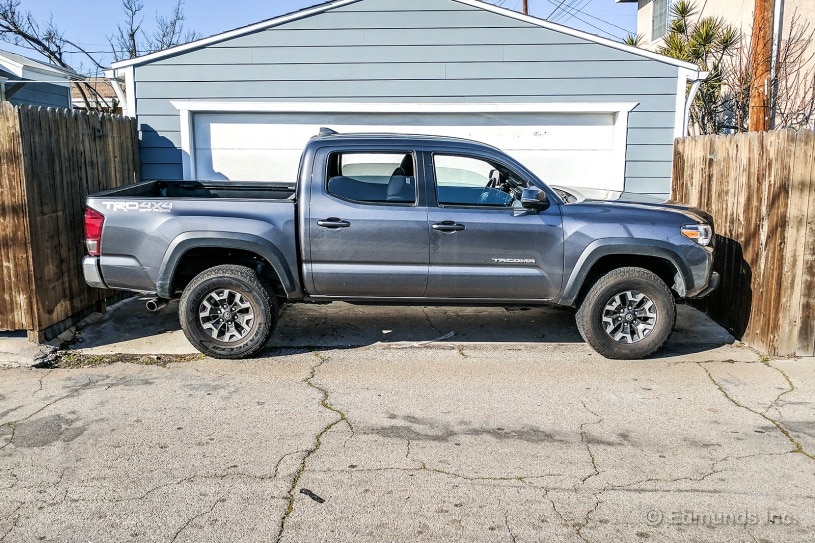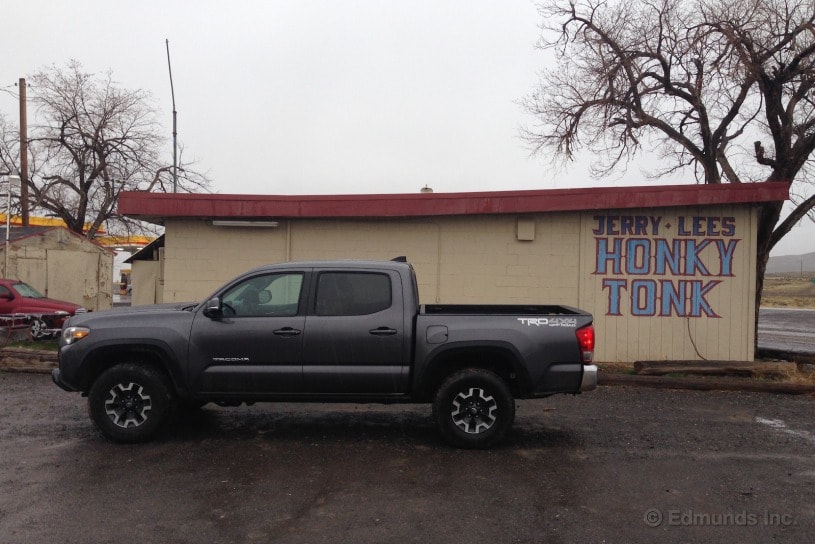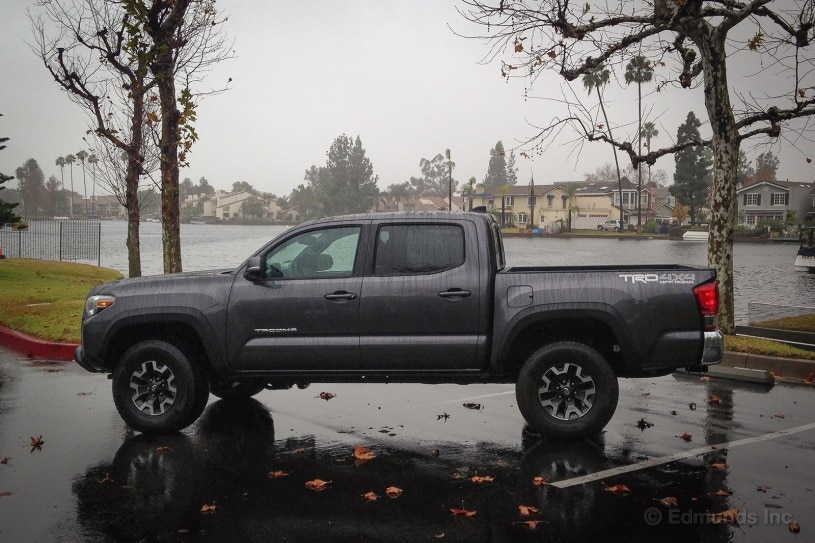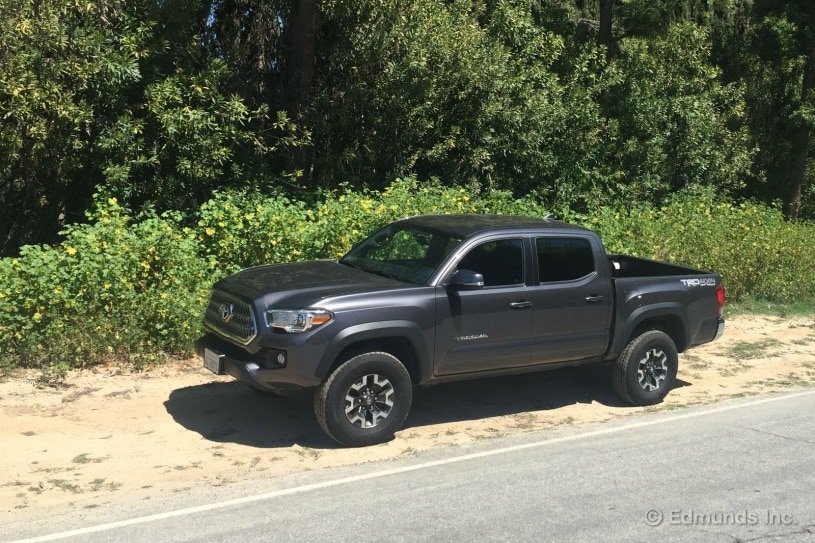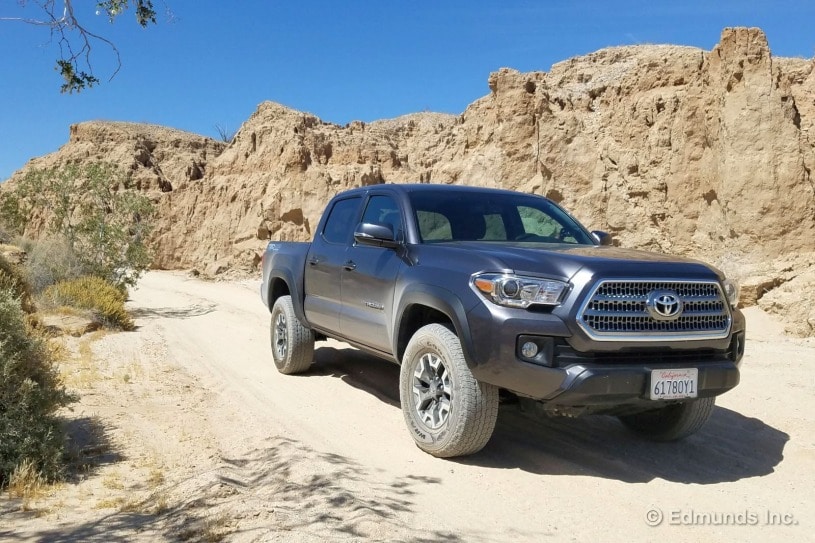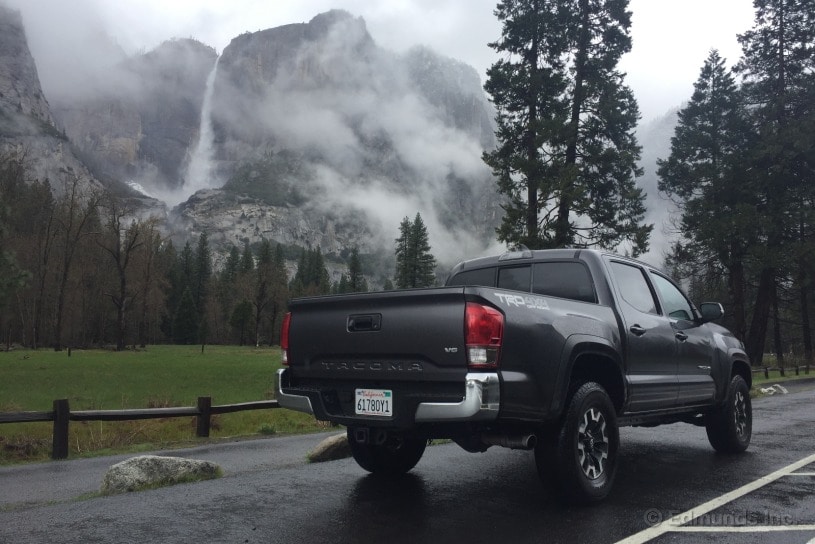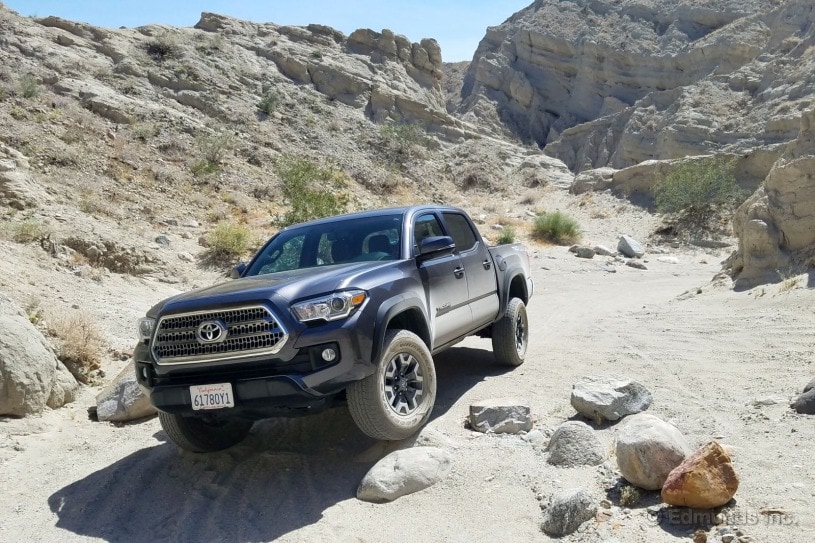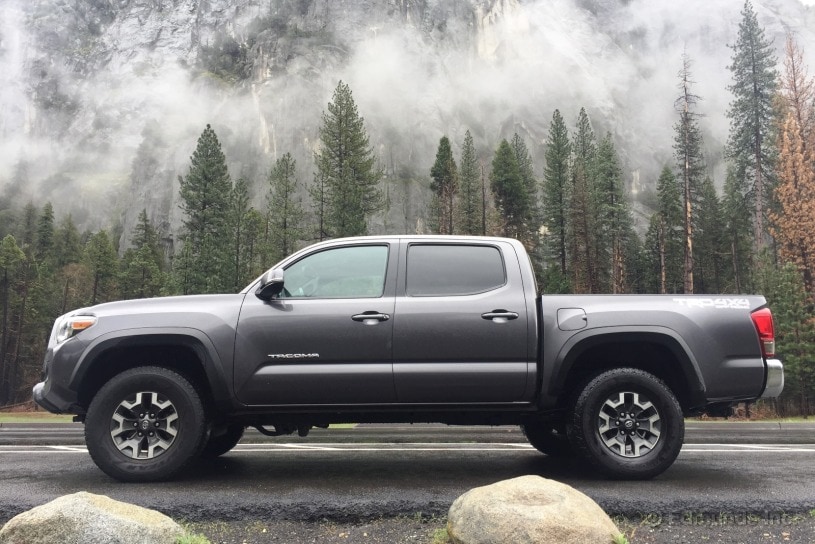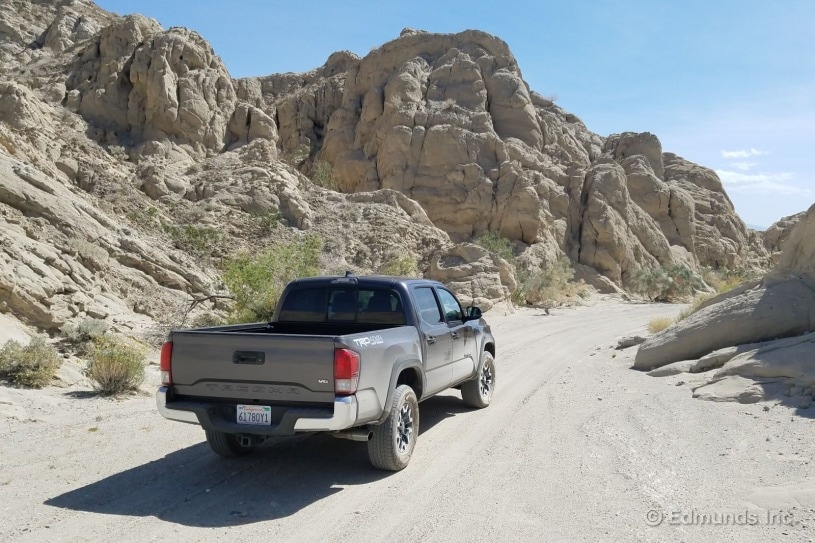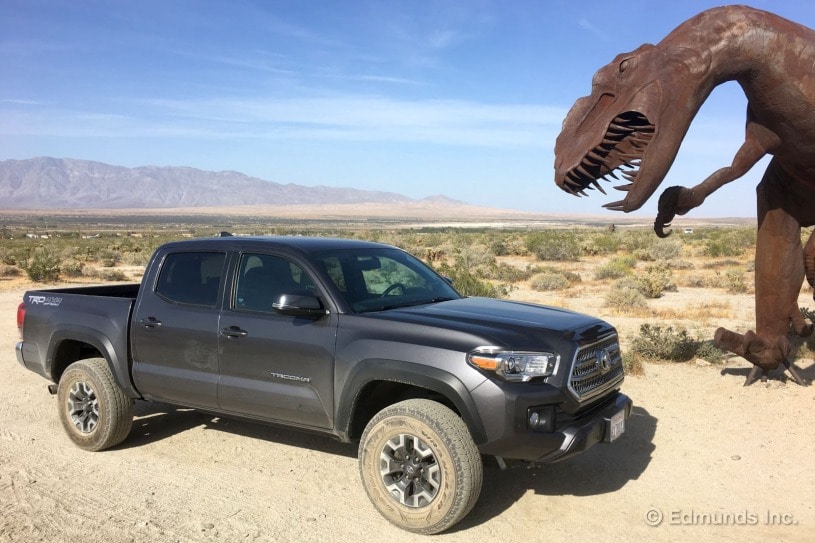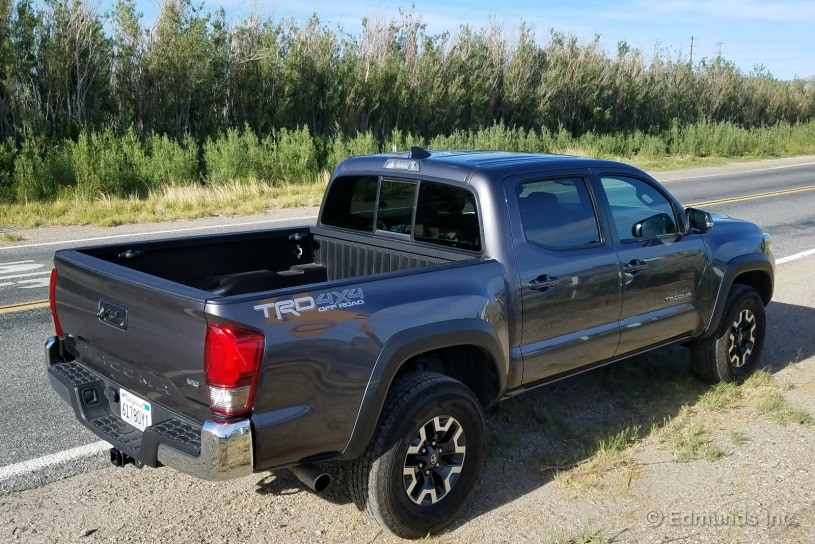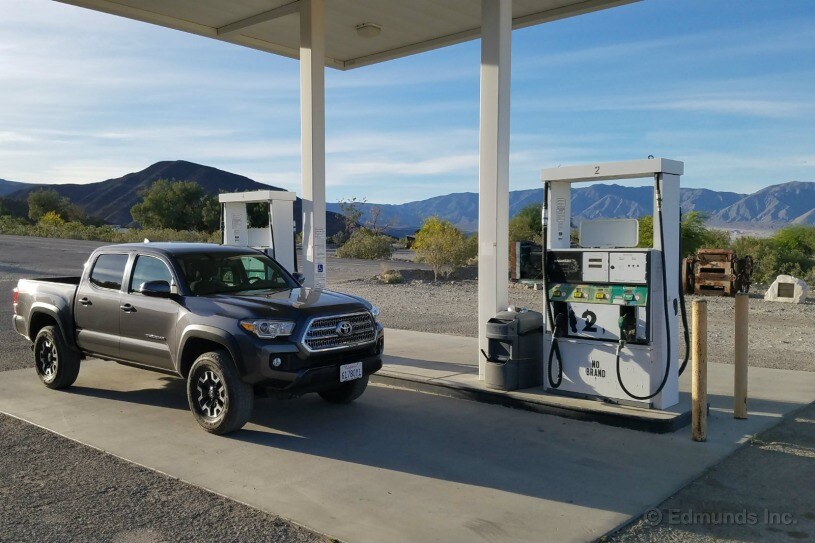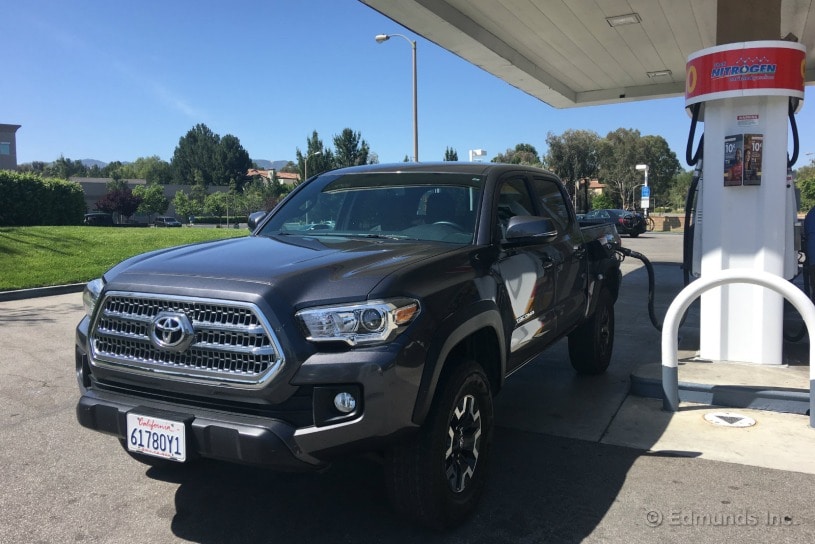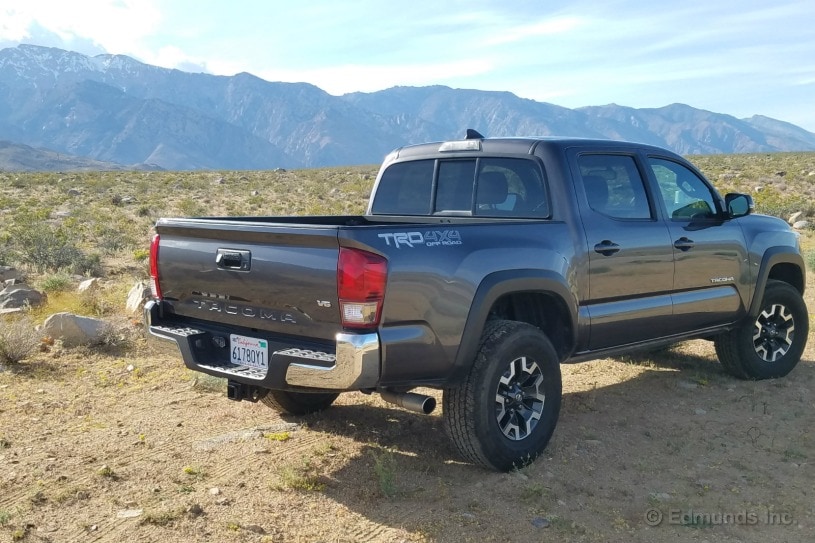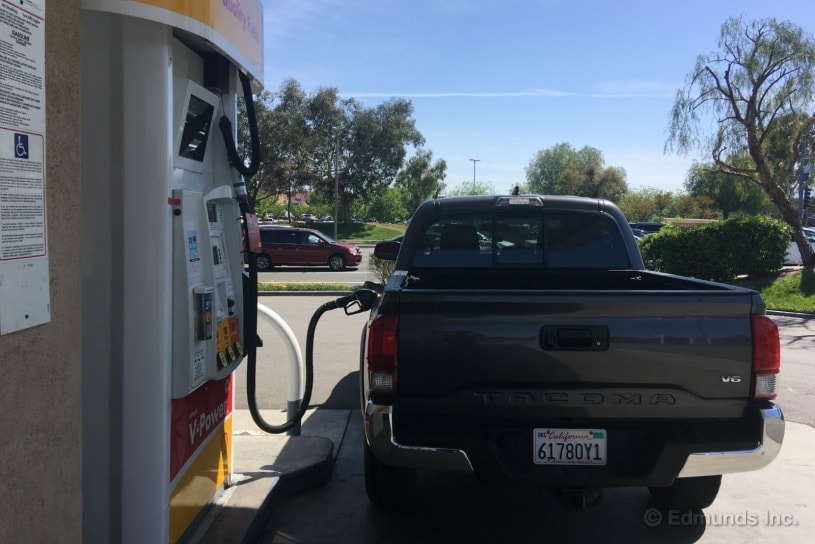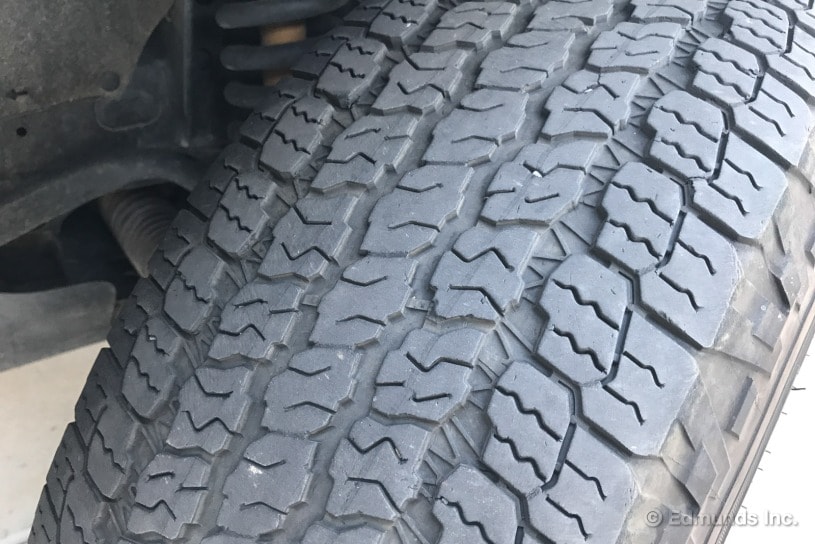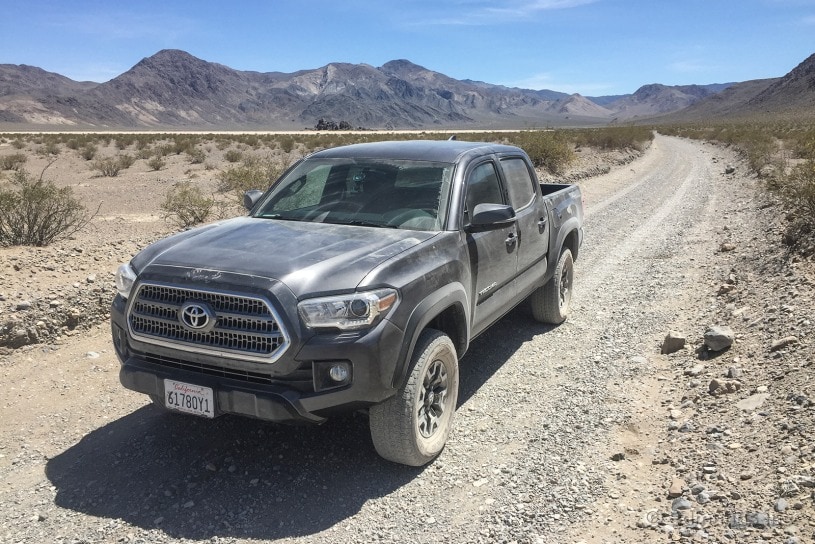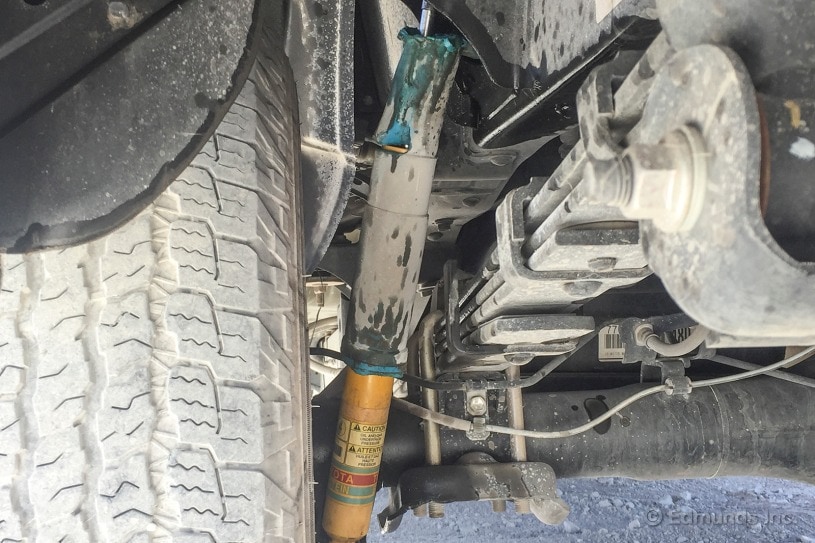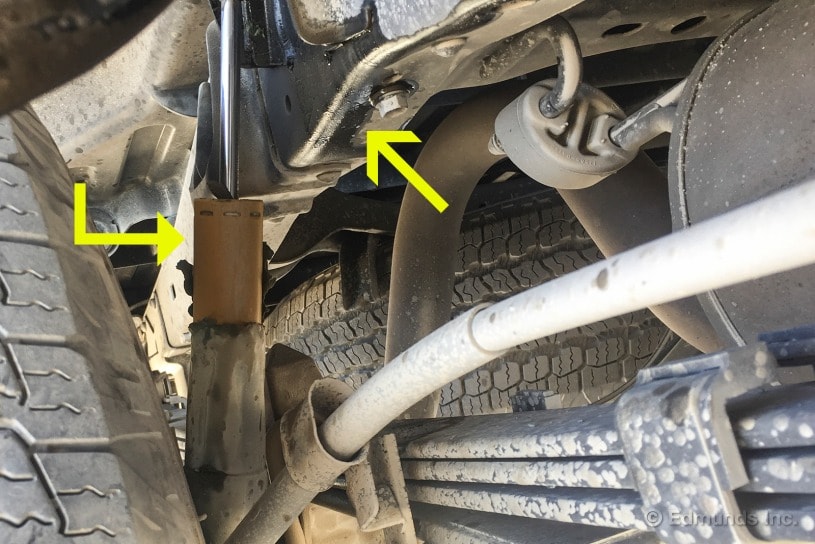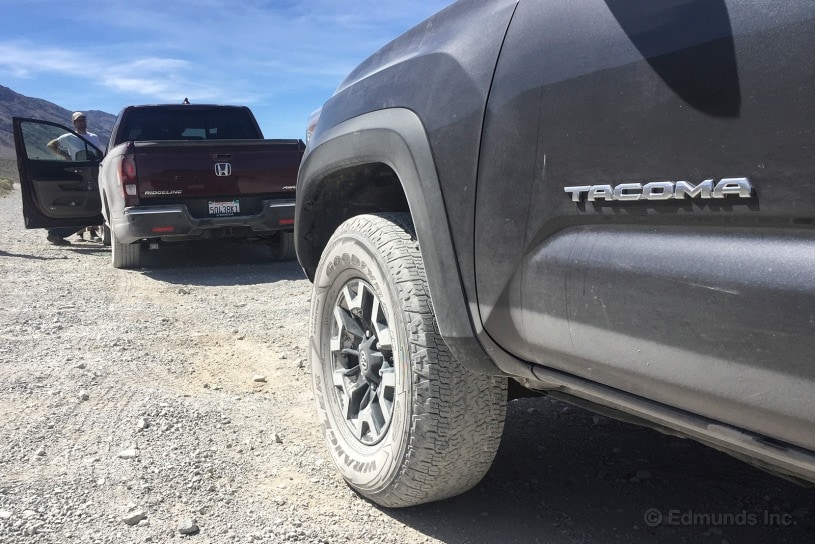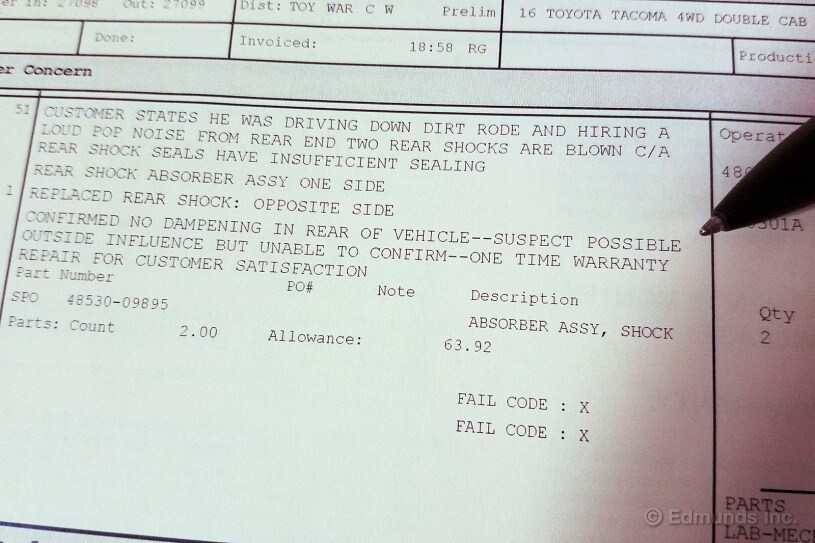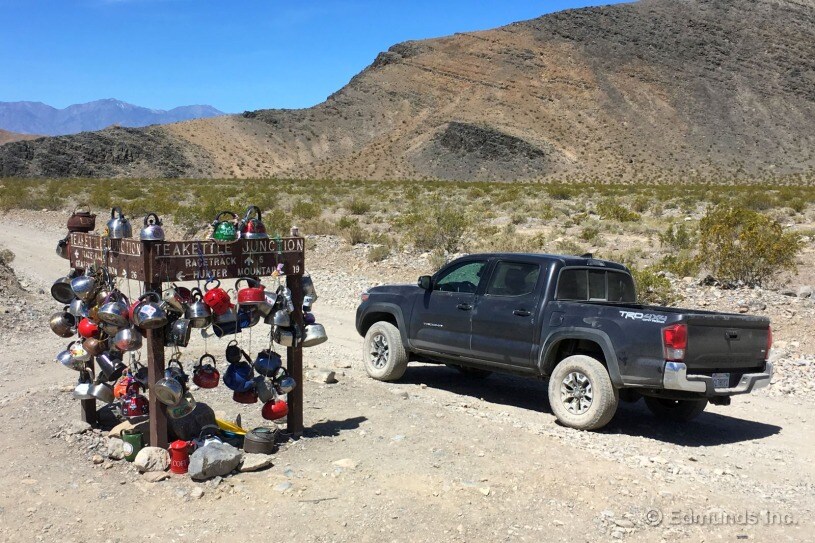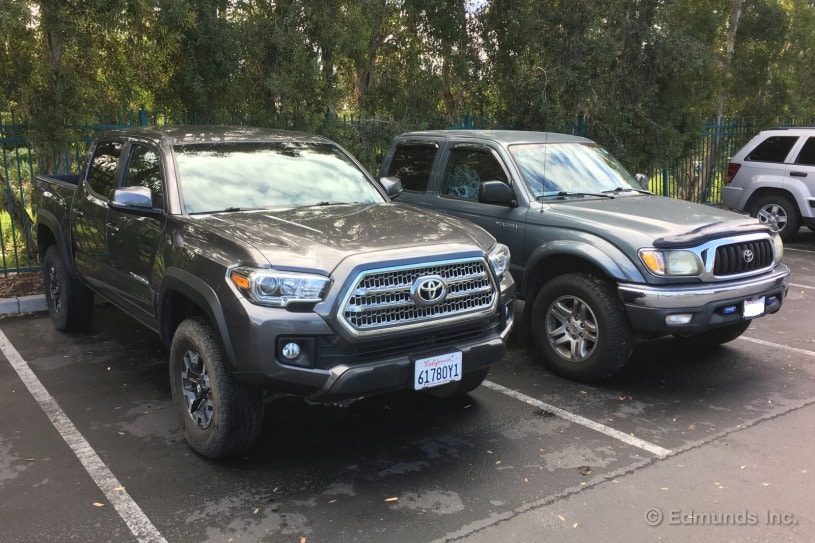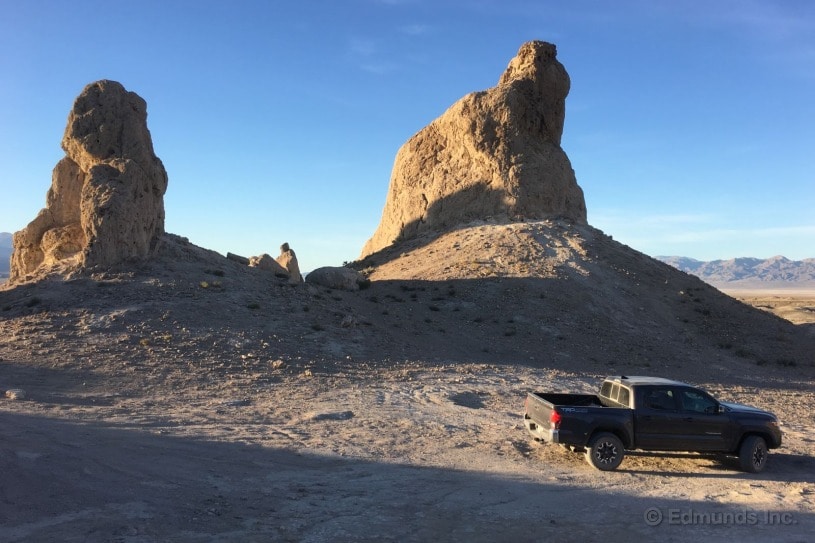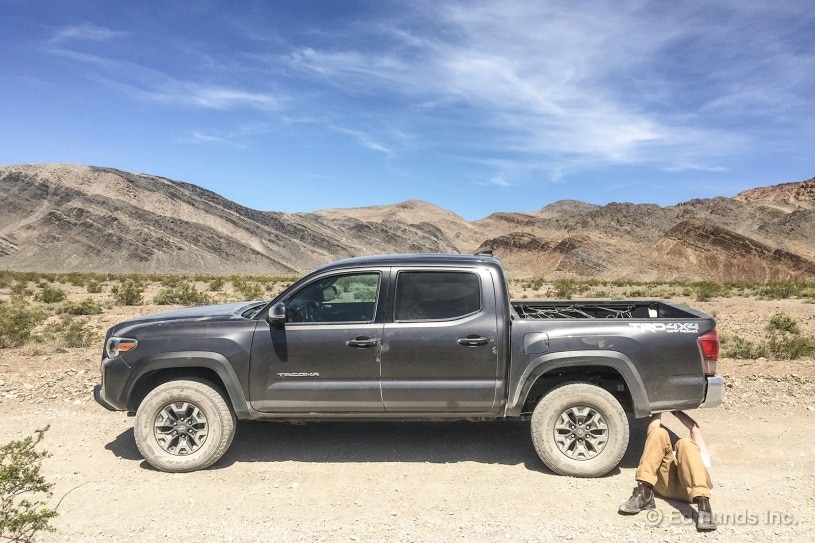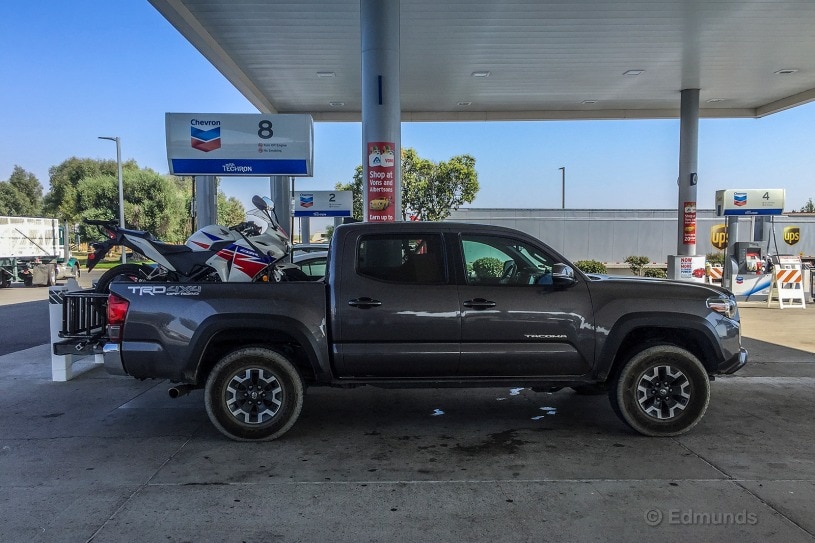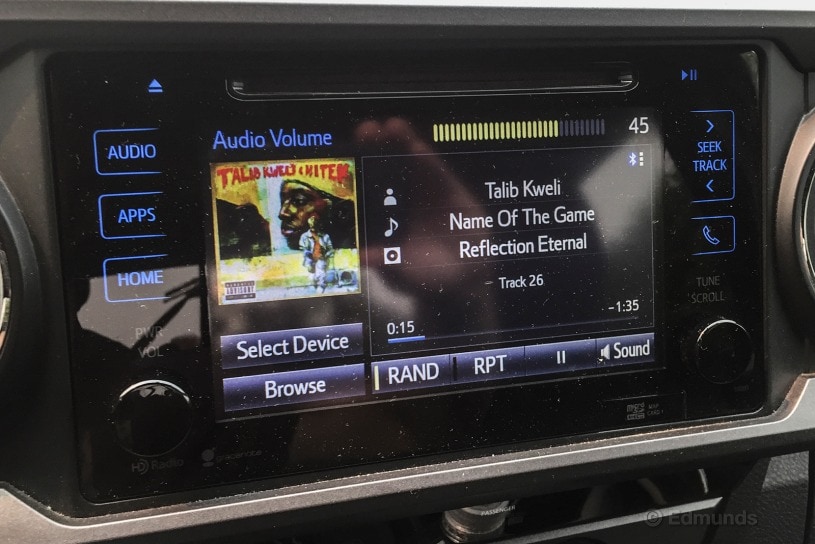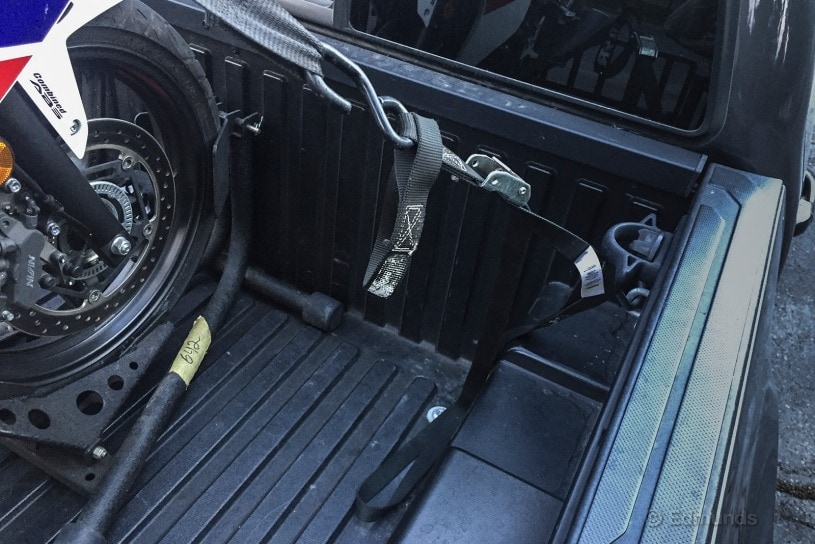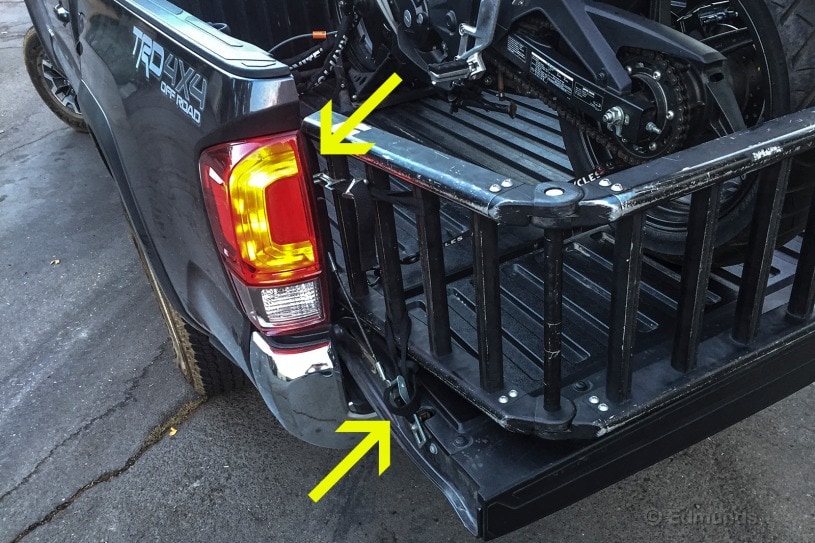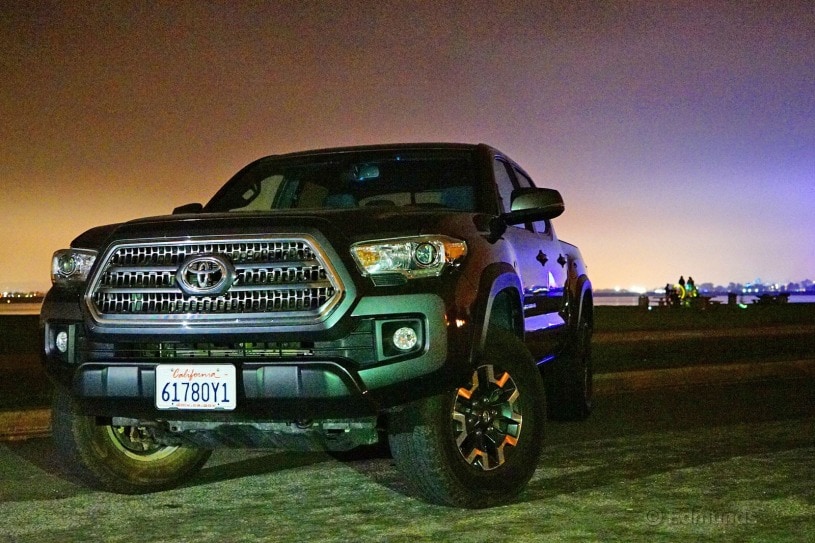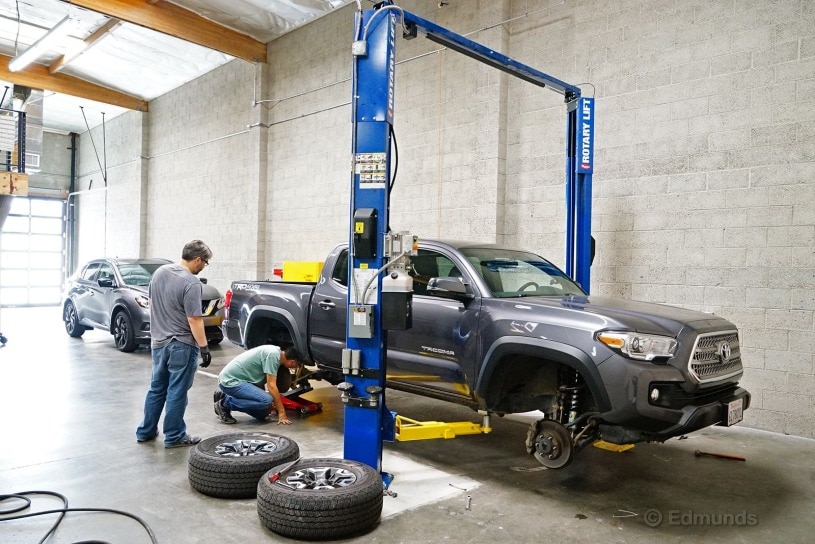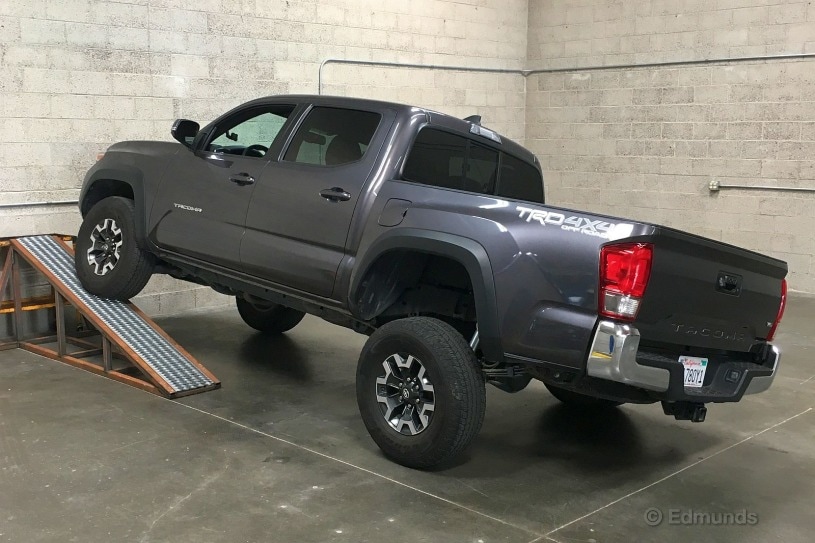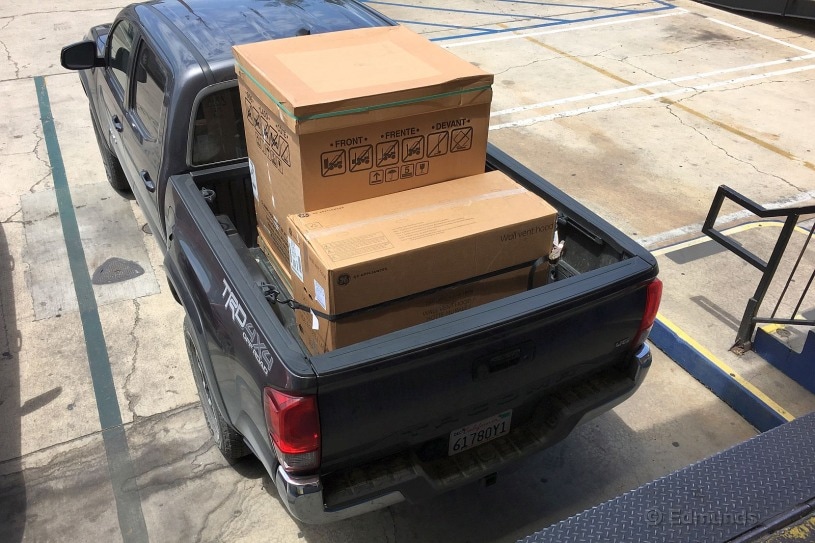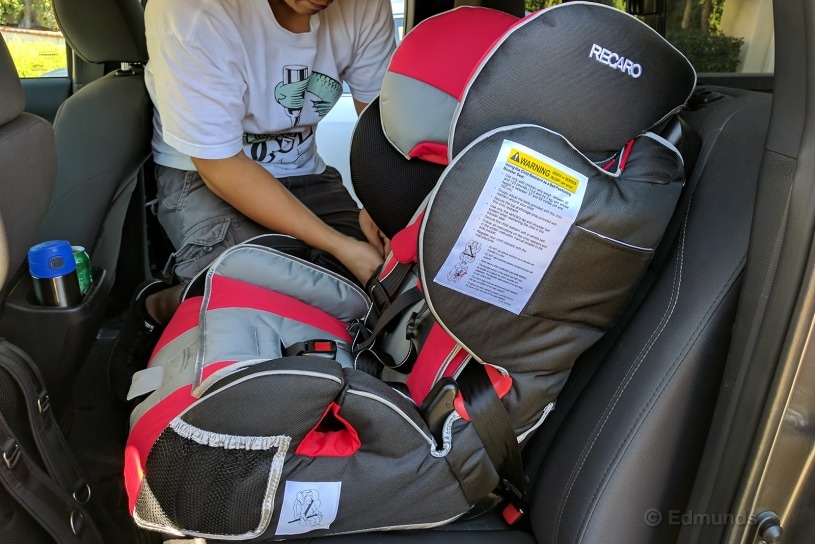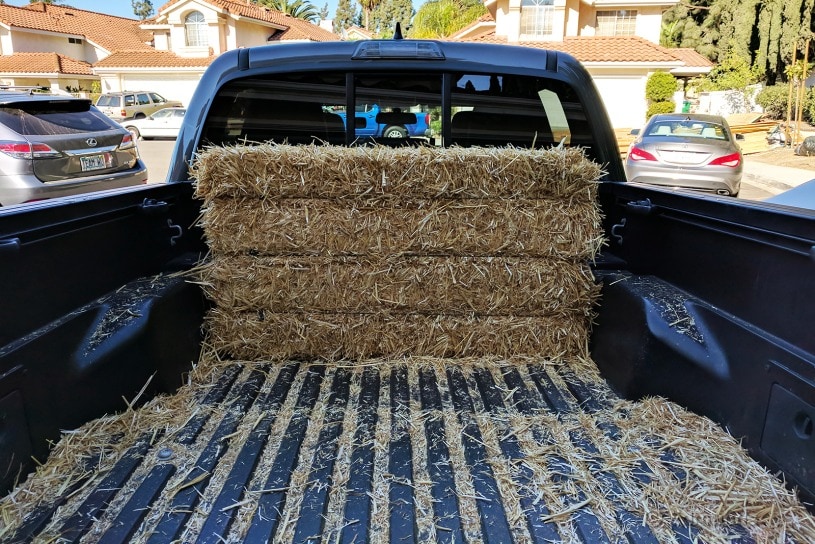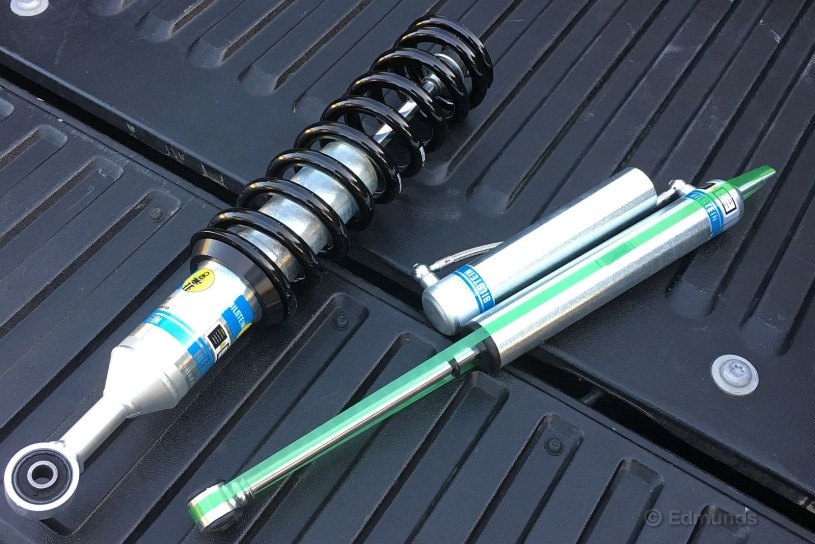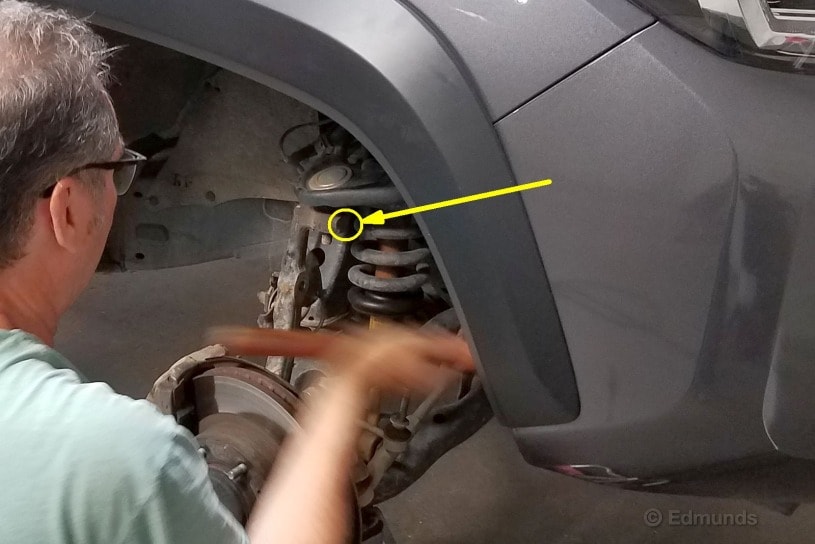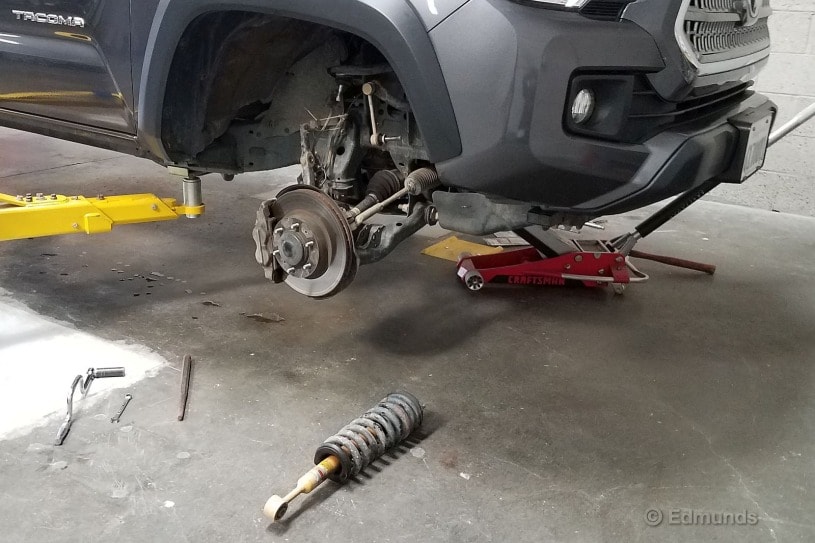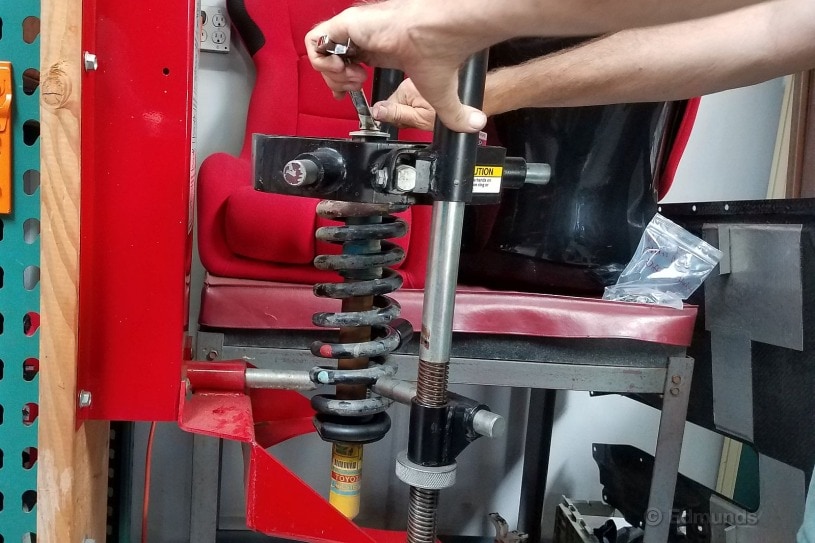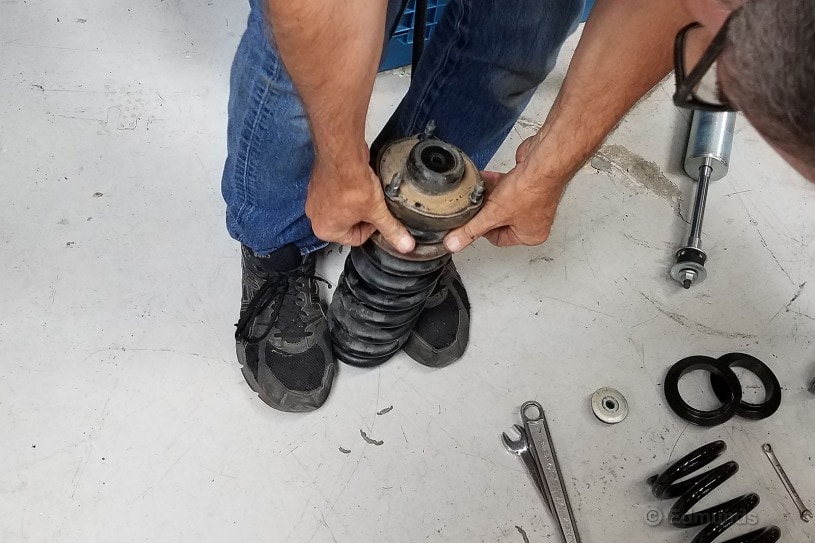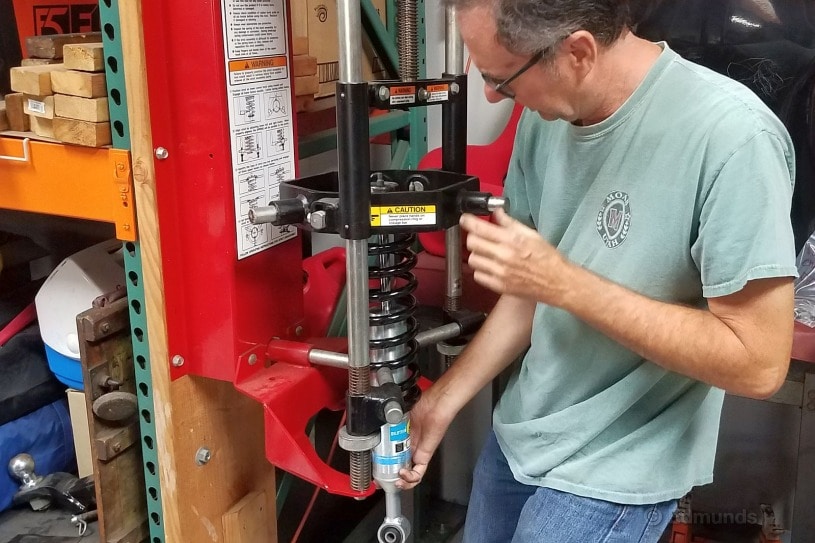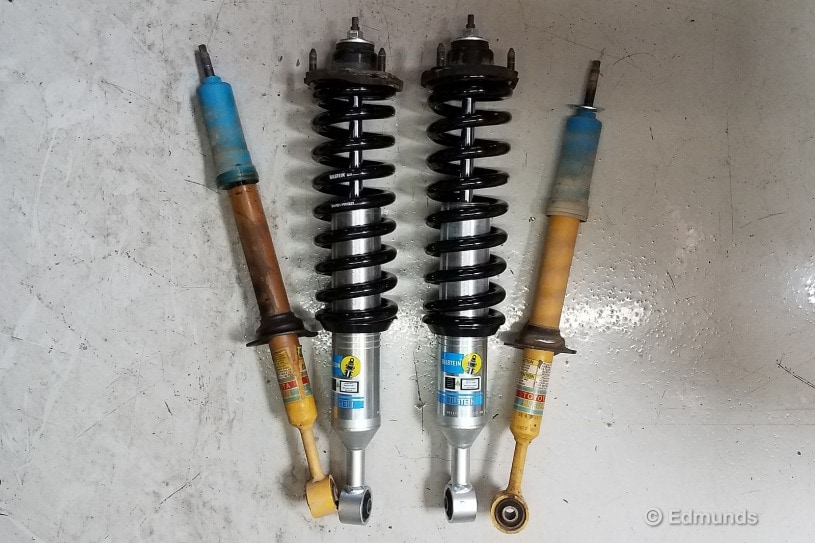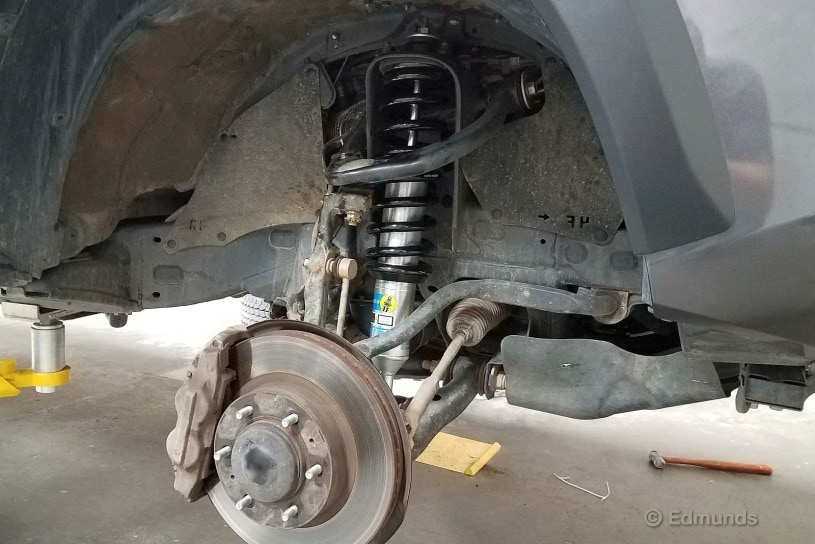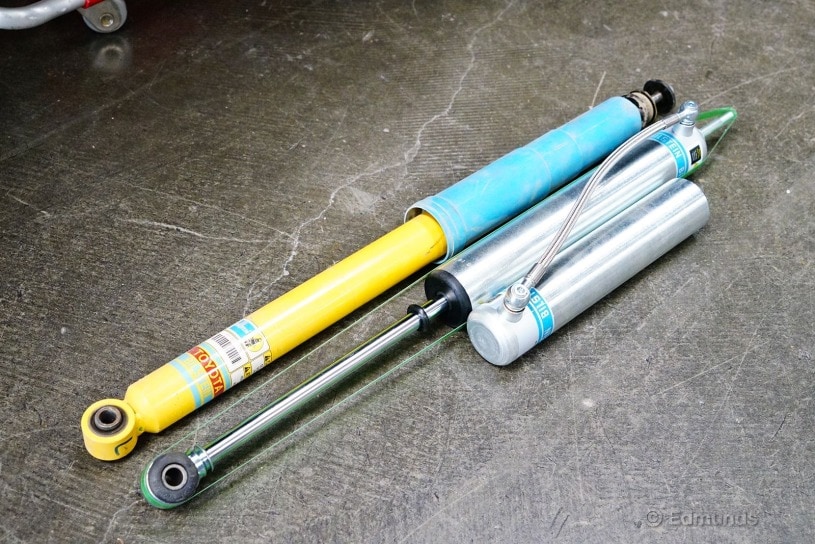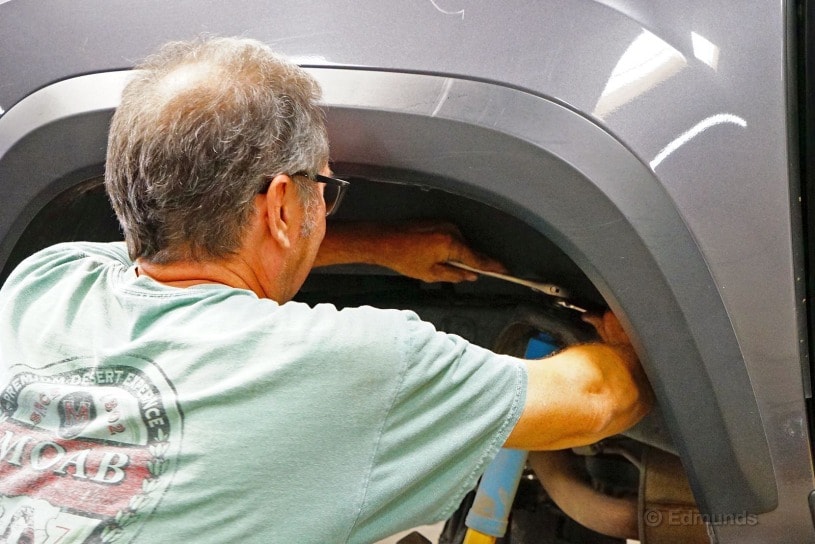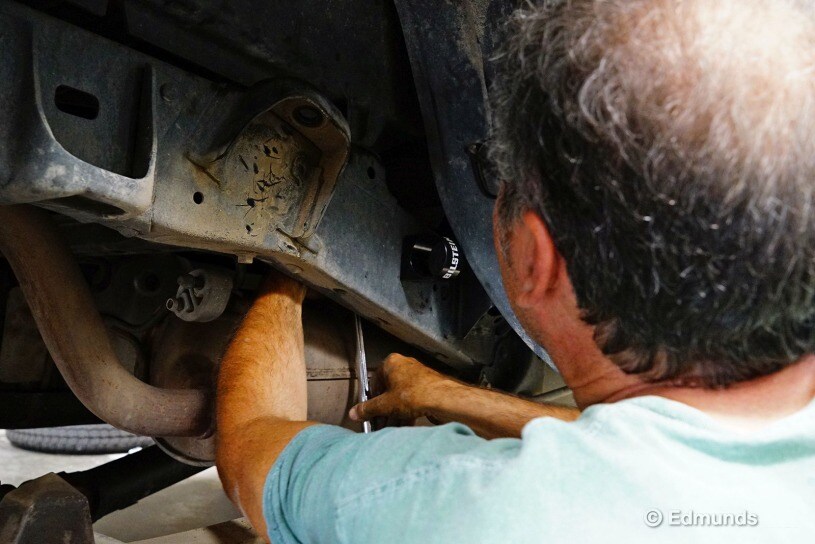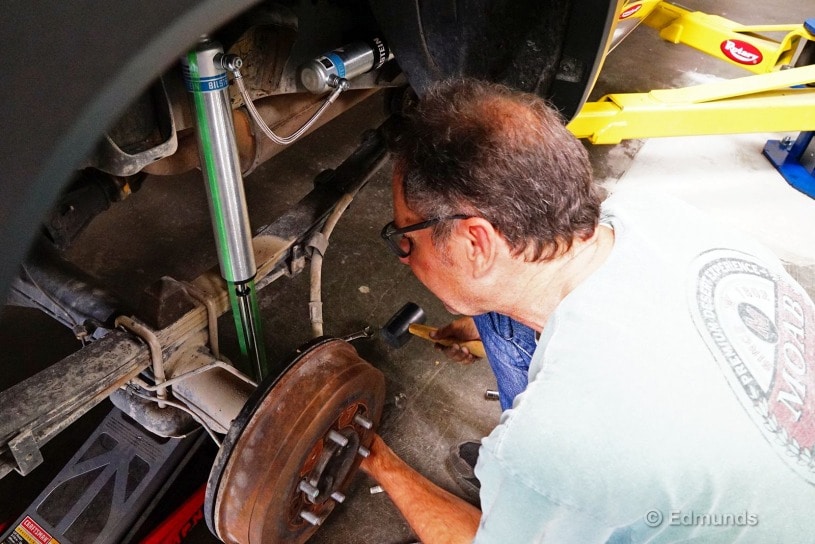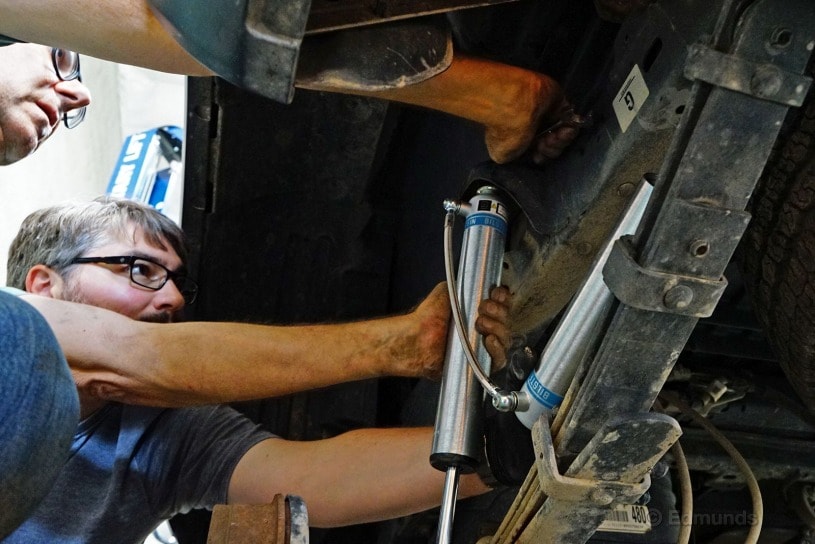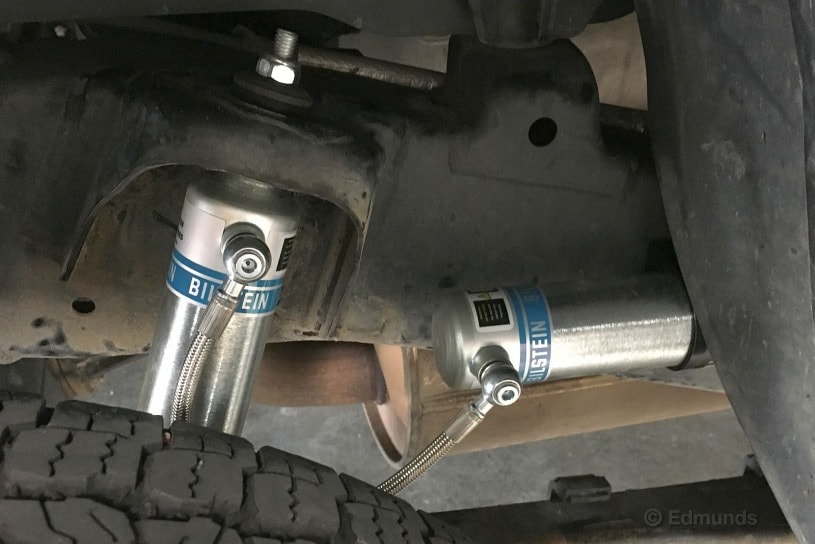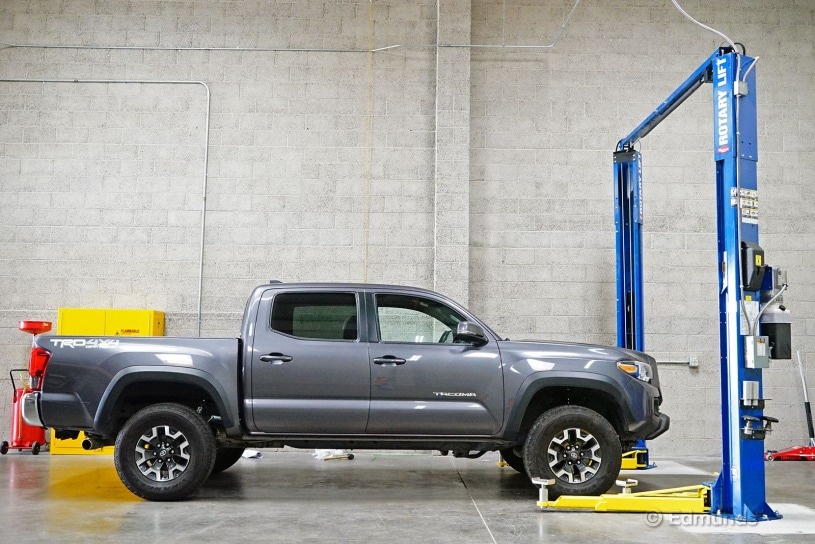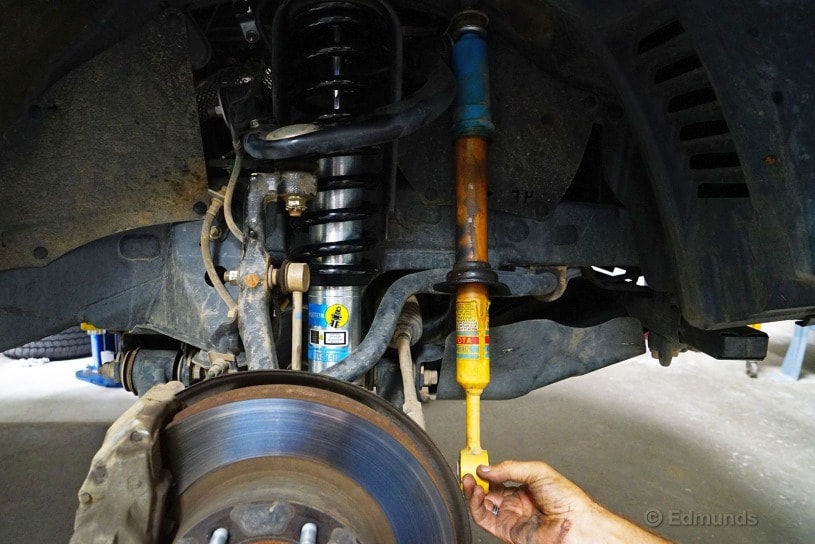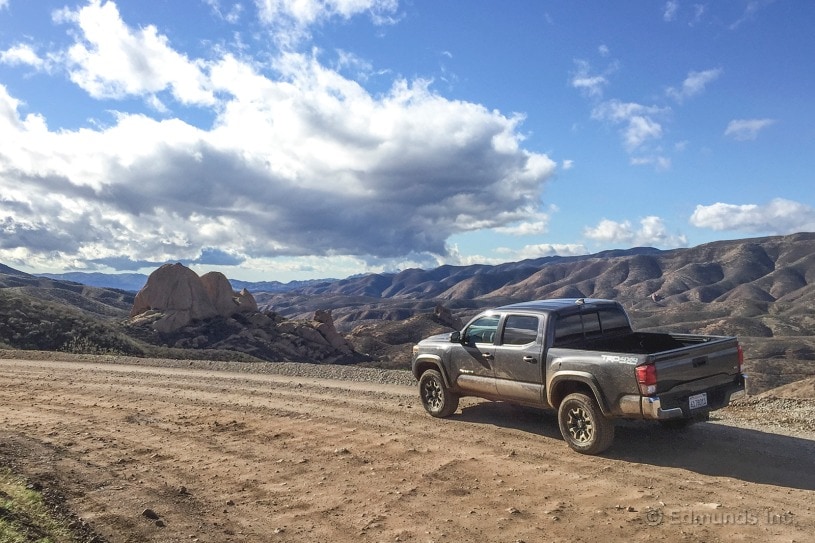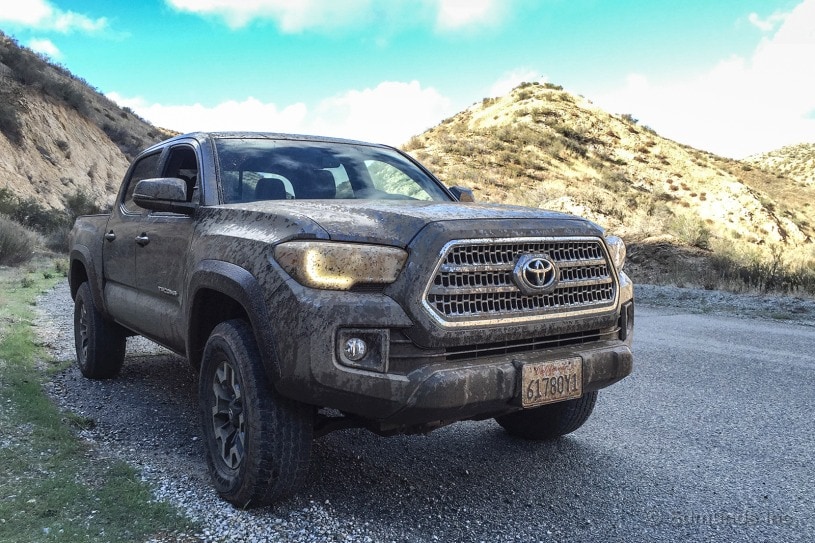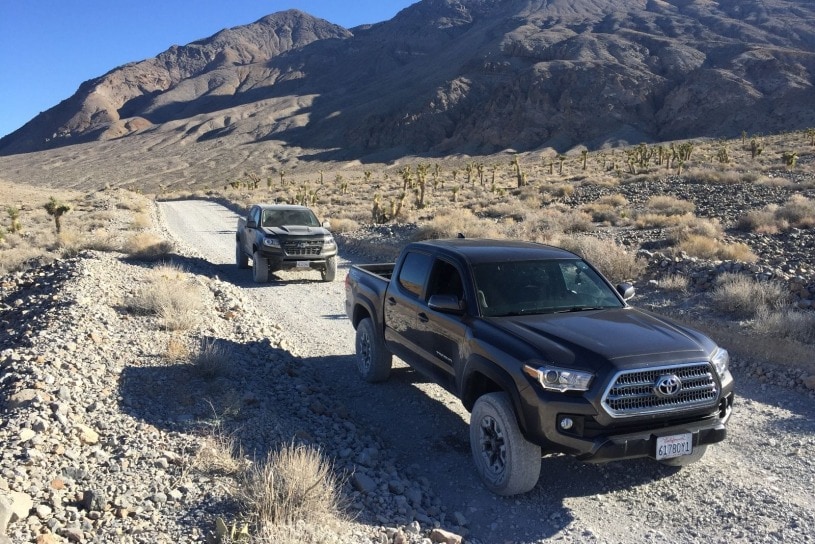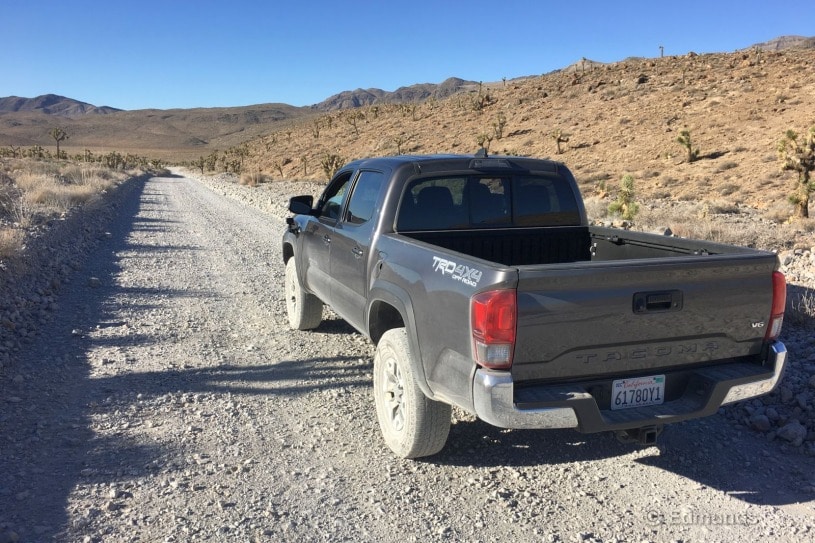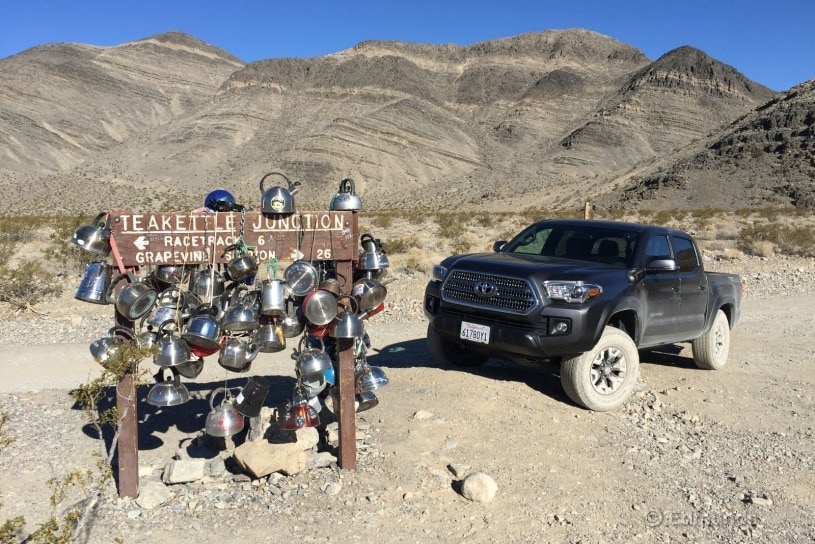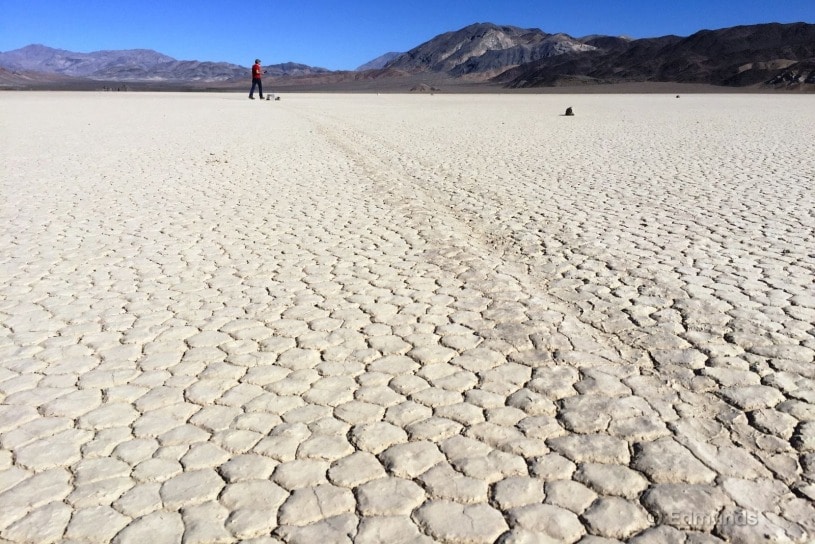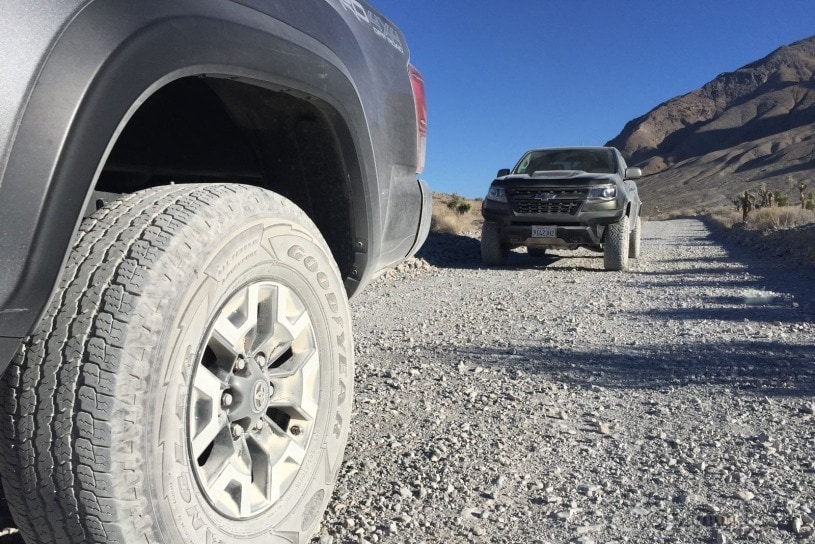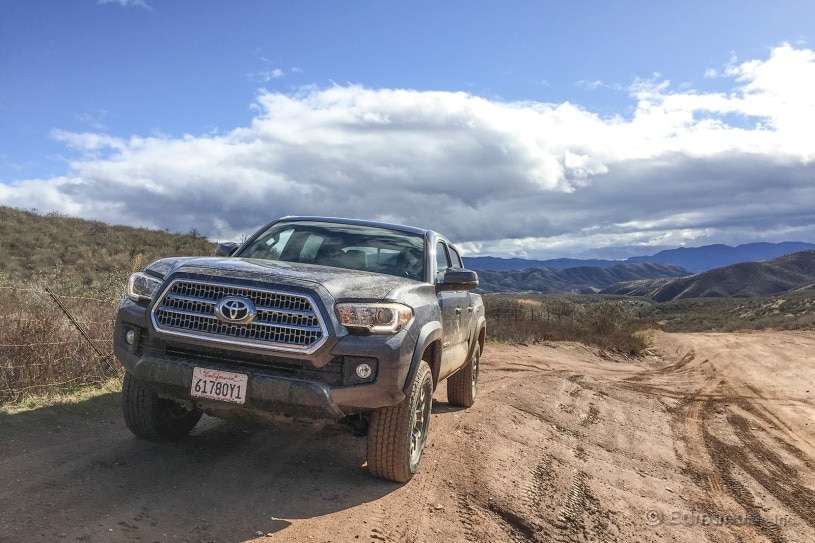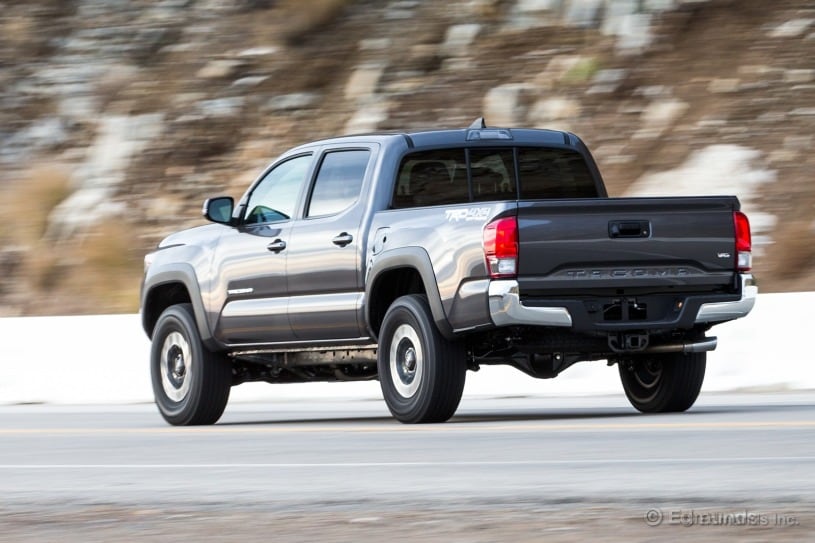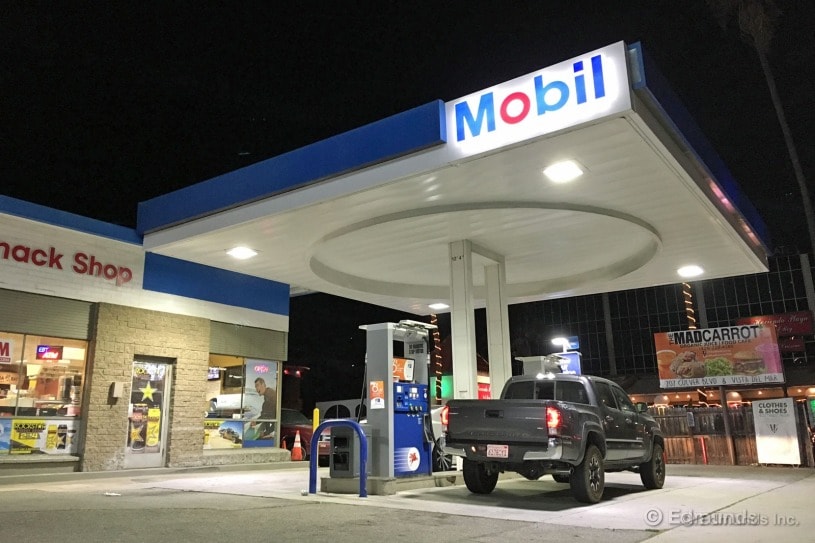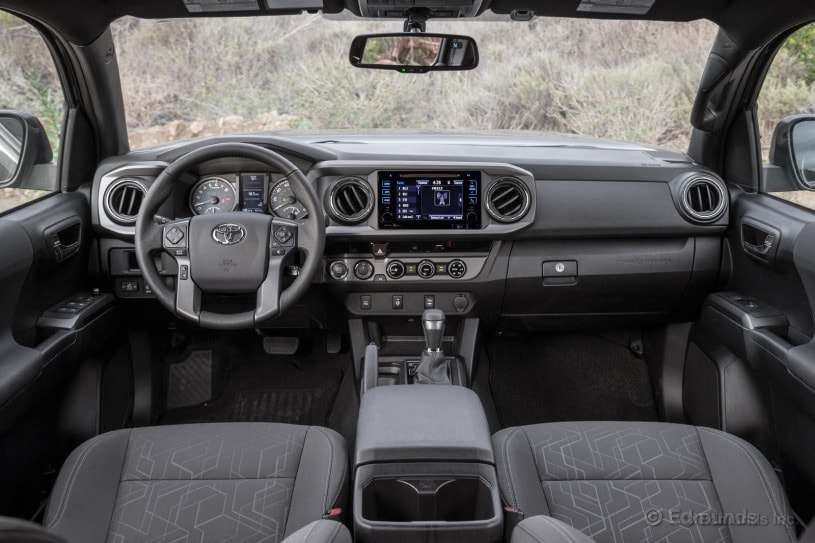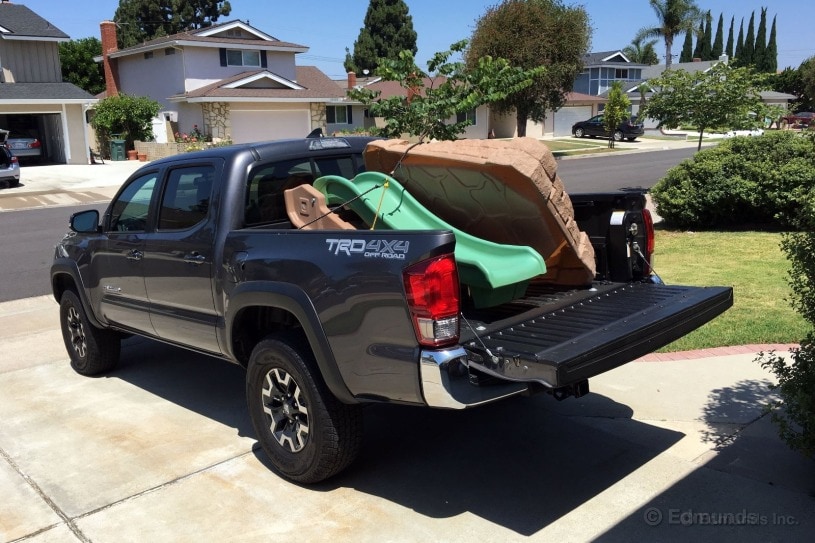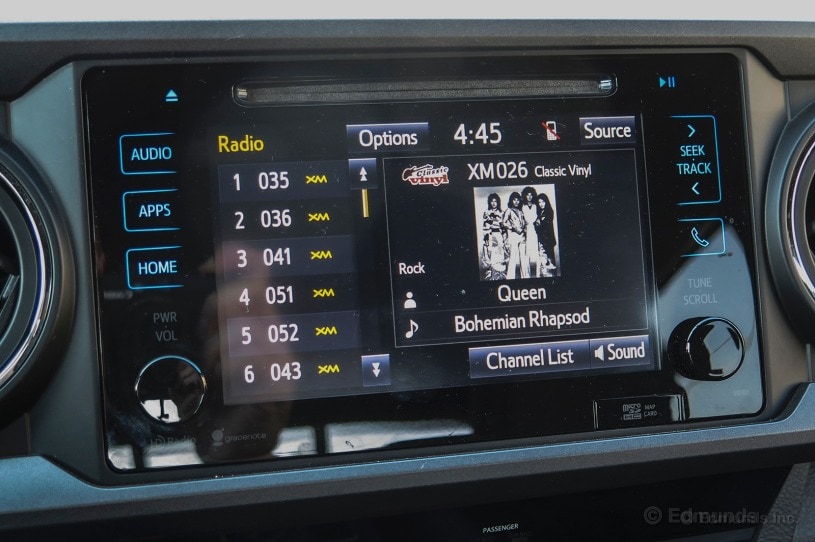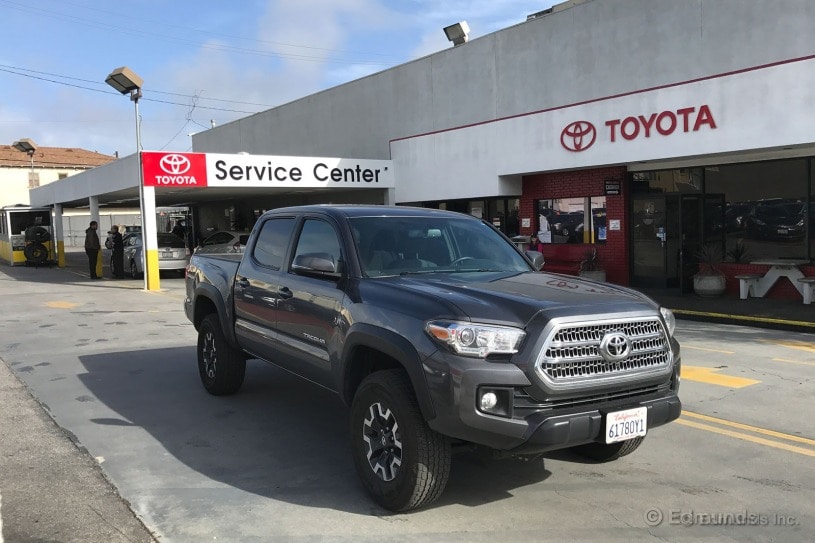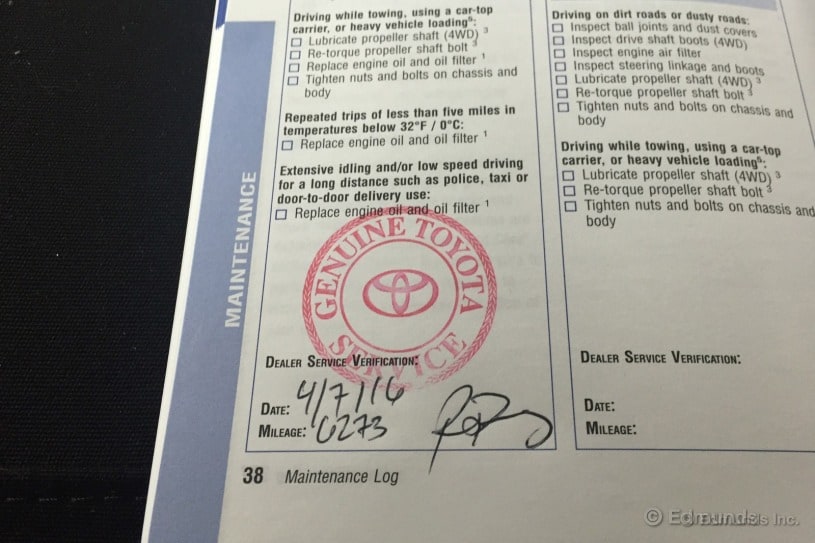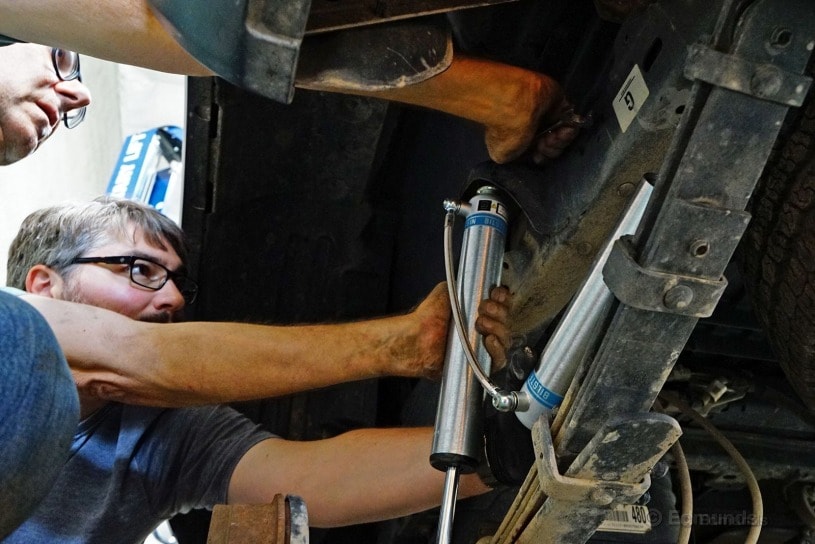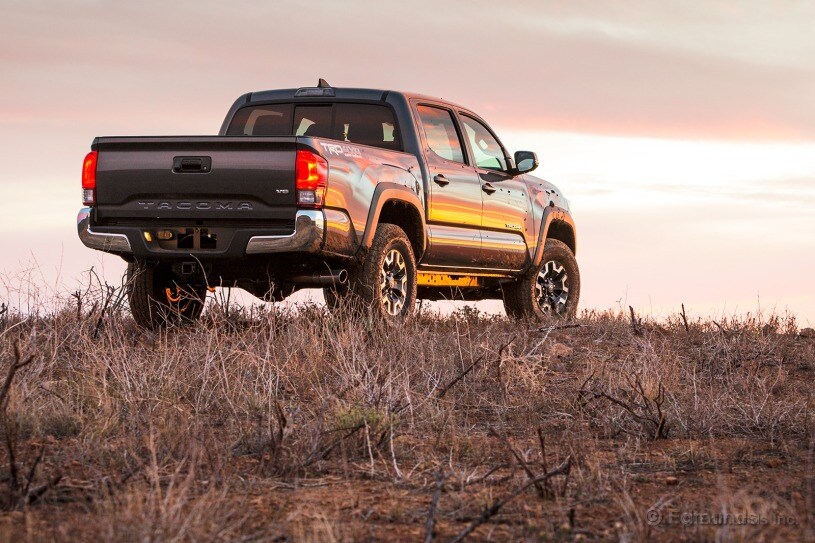2016 Toyota Tacoma: What's It Like to Live With?
Read the latest updates in our long-term road test of the 2016 Toyota Tacoma as our editors live with this truck for a year.
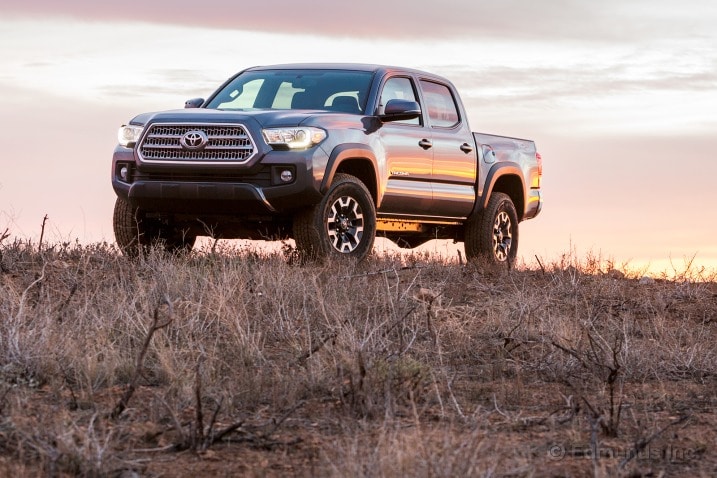
What do you want to know about?
- Introduction
- The Relic That Makes a Difference
- Baptism by Fire Road
- TRD Off-Road vs. TRD Sport
- First Thoughts (Video)
- First Impressions — Better Ride, Touchy Brakes
- Off-Road Clearance and Suspension Flexibility
- Performance Tested
- Seat Folding Maximizes Cargo Capacity
- Fuel Economy Update For January - Initial Observations
- Enjoying the Convenience of a Midsize Short Bed
- Steady On the Brakes
- Keyless Access Only Works On One Door
- Best Off-Road Pick For a Daily Driver?
- Fuel Economy Update for February - Holding at 18 MPG
- V6/Automatic Transmission Combo Doesn't Impress Much
- Clunky Voice Control for Those Without Apple Phones
- Sedona Road Trip Impressions
- March Sees Best- and Worst-Ever Tank Fuel Economy
- Brake Modulation Lacks Finesse
- A Fine First Service
- 8 Great Bed Features
- Of Course the Bike Fits
- Stop For Gas Stupid!
- Fuel Economy Update for April
- Rear Seats are Tight
- The More You Drive It the More You'll Like It
- Wants You To Stay Hydrated
- A Better Radio Knob Suggestion
- One Way To Haul 8-foot Items
- A Devil in a Detail
- A Little Novice Off-Roading
- Less Than Ideal Seating Position
- Fuel Economy Update for May - Show Me the MPG
- More Comfortable on the Highway Than the Old Tacoma, But Still Not Great
- Rear Seat Storage
- Fuel Economy Update for June - Better Range
- Starts Without the Key
- Desert Sessions
- Hauling the Plastic
- July Fuel Economy Update - Despite Road Trips, MPG Stays the Same
- Midsize Truck, Big City
- Refreshingly Simple Climate Controls
- Oh Yeah, It Has a Factory Go-Pro Camera Mount
- Time for New Wiper Blades
- A Transatlantic Perspective
- Good Stereo, Not Great
- September MPG Update - Undramatically Unchanged
- Three Reasons to Buy
- Monthly Update for October 2016
- Easy Loading
- Touchscreen is OK, but Smartphone Integration Lags
- Monthly Update for November 2016
- Rock On
- Monthly Update for December 2016
- Monthly Update for January 2017
- Monthly Update for February 2017
- Monthly Update for March 2017
- Monthly Update for April 2017
- Monthly Update for May 2017
- Monthly Update for June 2017
- Suspension Breakdown in Death Valley
- Making Sense of Our Death Valley Results
- Monthly Update for July 2017
- Monthly Update for August 2017
- Monthly Update for September 2017
- Monthly Update for October 2017
- Bilstein Shock Absorber Upgrade
- Monthly Update for November 2017
- Racetrack Road Revisited
- Wrap-Up
Introduction
What Did We Get?
The Toyota Tacoma has history. It's a workhorse with a reputation for reliability and durability that's known the world over. And it earned that reputation with the easygoing nature offered only in a smaller pickup. As midsize trucks go, it is the standard-bearer.
That reputation is one reason why the redesigned 2016 Toyota Tacoma isn't drastically different from the previous model. There's a new V6 and an improved six-speed automatic. The interior is updated to modern standards that were desperately lacking in the 11-year-old outgoing version. Dimensionally, however, the new truck is almost identical to the one it replaces. Its track width, wheelbase and suspension remain the same as before. It's still very much the same midsize truck it's always been.
That's a good thing in many ways, as we have always liked the Tacoma's rugged nature and considerable capabilities. Our initial drive of the redesigned model suggested that it was a slightly more high-tech version of the truck we already knew. We decided to find out if that was enough of a leap to keep it at the head of the class, so we bought a crew cab V6 of our own.
What Options Does It Have?
There are five trim levels available: SR, SR5, TRD Sport, TRD Off-Road and Limited.
All Tacomas come with a bedliner from the factory. Other standard features across the board include air-conditioning, power accessories, Bluetooth phone and audio connectivity, a rearview camera and a USB port and auxiliary audio jack. Sixteen-inch wheels are nothing new, but are included as standard equipment on every Tacoma except the TRD Sport (17s) and the top-trim Limited, which gets 18s.
We opted for the TRD Off-Road model, as we liked its combination of features and suspension tuning. It includes Bilstein shocks, a lockable rear differential and a crawl control system that allows varying speeds between 1 and 5 mph (only available with automatic transmission versions). It also includes keyless entry, a first for the class.
The 3.5-liter V6 in our truck is good for 278 horsepower and is paired to a six-speed automatic transmission. Its two-speed transfer case is electronically switched.
Additional options include the $650 V6 Tow package, which adds an engine oil cooler, power steering cooler, heavy-duty alternator and a four- and seven-pin electrical connector for a trailer. We also got a $90 exhaust tip and carpeted floor mats for $209, which brought the MSRP to $35,579. We purchased the truck from Carson Toyota, which knocked $500 from the sticker price for a total of $35,079.
Why Did We Buy It?
For the last decade or so, the midsize truck segment was stagnant. The long-running Ford Ranger was killed off, while GM's trucks came and went. The Toyota Tacoma and Nissan's Frontier stuck around, but with little competition they didn't change much.
In 2014, GM got back into the game and rejuvenated the segment. Sales of the Colorado and Canyon have exceeded expectations without stealing sales from their larger siblings. We recently wrapped up a year with Chevy's Colorado in which it proved to be a solid machine. Clearly, there was some unmet demand out there.
This new Tacoma arrived with a familiar look and feel. We couldn't help but wonder if Toyota was underestimating its new rivals. But after some initial seat time and closer inspection of its features and specs, it was clear that this Tacoma wasn't just a quickly arranged refresh. This is a truck designed to appeal to the kinds of truck buyers that have made the Tacoma the class leader, while offering enough new features to keep it fresh.
Now it's time to see if Toyota's latest take on the midsize truck measures up to GM's effort. As similar as the Colorado and Tacoma are in many respects, they have very different characters. We grew to like the Colorado for a variety of reasons, and over the next 12 months and 20,000 miles we'll learn every quirk of the Tacoma, both good and bad.
Follow along on our Long-Term Road Test page to see if the new Tacoma is still the standard when it comes to midsize trucks.
Edmunds purchased this vehicle for the purpose of evaluation.
I've seen the ECT Power switch in Toyota trucks since I was in junior high. I've driven plenty of trucks with the switch. And before this Tacoma, that switch has never made any discernable difference. Now that's changed.
The switch resides on the center stack of our 2016 Toyota Tacoma. I had driven the truck for a day or so before I even noticed it. Then I drove up the longest hill in my neighborhood. We live in the foothills of Orange County's Santa Ana mountains and the houses are built into some real inclines. The one in question rises 450 vertical feet in just over a mile.
Just enough, it turns out, to throw the Tacoma into shift-fits. Be careful how you say that.
The hill is the perfect pitch to create an endless search for the right gear. Try to maintain the speed limit (45 mph) and the Tacoma downshifts. Then speed climbs rapidly and lifting off the throttle is required to maintain the speed limit. As soon as the throttle is closed — even slightly — the transmission upshifts again, the truck begins to lose speed, and the process repeats.
This, friends, is textbook gear hunting. And it's infuriating.
Activating "Power Mode" via the ECT switch essentially solves the problem. Shift points and throttle calibration tweaks let it hold the higher gear up the hill, which is a relief.
It's fairly clear that the Tacoma's stock transmission calibration is a product of a hair-splitting search for fuel economy. It's almost always a gear too high in city driving. Pushing the ECT Power button solves the problem. But should I need to activate an alternate calibration just to drive through my neighborhood?
That didn't take long. I headed for the local mountains the very first weekend I got my mitts on the keys to our brand new 2016 Toyota Tacoma. And it was good.
No, it was excellent.
I'm talking about the TRD Off-Road suspension, which impressed me more than it had during my drive at last summer's launch event near Seattle. Here on my rougher local terrain, it was even better than expected at smoothing out awkward bumps and the sort of rough cross-grain erosion grooves you get on forest service fire roads that haven't seen a grader for a few seasons.
Off-road suspension does not automatically mean stiff suspension. It couldn't be if it were to suck up under-maintained dirt roads like these without rattling the cage containing me and my buddy, Mike.
Due credit goes to the tall and enveloping sidewalls of the Kevlar-reinforced 265/70R16 (a.k.a. 31-inch) Goodyear tires and the 16-inch wheels on which they're mounted, a breath of fresh air in this day and age of "over-dubbing." Do the math and you'll see that these wheels have a full 7.5 inches of rubber protecting them from the rocks and ditches below.
This wouldn't amount to much if the Bilstein monotube shocks weren't tuned to match. A monotube design is preferable out here because such shocks shed heat faster than it can be generated by internal damping valves hammering across washboard and other broken surfaces. But even this does not guarantee success on a wide range of paved and unpaved roads unless the suspension tuning engineers calibrate the damping just right.
They nailed it here. These shocks suck up impacts without jostling the cabin or its occupants. The truck moves as the general shape of the road changes, but the suspension and tires filter out all of the messy and uncomfortable details. Heck, there wasn't even a single squeak or rattle all day.
This truck is tight.
It all translates fairly well onto paved roads, too. The baseline spring tuning stops short of being overly stiff, the tall sidewalls that work well in the rocks do a good job with potholes, and the Bilsteins have the finesse to smooth out the small stuff.
Yes, there is a bit of head toss and some wiggle now and then, but it's all very agreeable, especially considering how capable this truck is on the way to the campsite or mountain bike trailhead.
My head moved as if on a swivel as I wheeled our 2016 Toyota Tacoma into the parking lot of my local Costco and scanned for the nearest open spot. As luck would have it, the first and best one I saw was alongside my truck's doppelganger.
Crew cab? Check. Magnetic Gray Metallic paint? Uh-huh. 3.5-liter V6? Present. Optional 2-inch receiver hitch? Ditto. Brand-spanking new with temporary tags and no license plate? Yes, even that, too.
TRD Off-Road? Hang on a second. That one's a TRD Sport.
Together they represent at least 40 percent of Tacoma sales. The two are identically-equipped as far as interior trimmings go. And they cost exactly the same when the cab, engine, transmission and drive-type selections match. The differences boil down to things we can see here in the parking lot — mostly.
The rear bumper end caps jump out immediately. They're chrome on our TRD Off-Road and painted body-color on the Sport. The fender flare difference is subtle, owing to the particular color of these trucks. They again match the body color on the Sport, but a TRD Off-Road wears textured and unpainted black ones that are more resistant to stone chips and better at concealing the "desert stripe" you get from driving on narrow brush-covered trails.
Up front, the headlights and grille are identical. But the TRD Sport has two things our TRD Off-Road does not have: a hood scoop and an air dam. The hood scoop is pure visual decoration that doesn't connect to anything. The air dam, present on all Tacomas except the TRD Off-Road, is there to bolster the Tacoma's official EPA fuel economy rating.
It's not fitted to the TRD Off-Road because of its negative effects on the approach angle, which on paper is 29 degrees for the TRD Sport and 32 degrees on our TRD Off-Road. Those numbers are measured at the truck's centerline, but the practical difference is far more dramatic (and arguably more meaningful) out where the TRD Off-Road's front tires are exposed to any rocky terrain you may attempt to surmount.
Speaking of tires, the wheel and tire package is perhaps the most impactful functional difference you'd notice at first glance. Both share the same 31-inch rolling diameter, but that's where the similarities end.
The TRD Off-Road rides on 16-inch wheels surrounded by P265/70R16 Goodyear All-Terrain Adventure tires with Kevlar-reinforced sidewalls and an all-terrain tread pattern. In contrast, the TRD Sport wears 17-inch wheels shod with P265/65R17 Toyo Open Country tires with a more pavement-oriented crossover SUV-style tread pattern.
Behind each we can see the dust covers of the shock absorbers peeking out. That splash of blue indicates that our TRD Off-Road is riding on Bilstein monotube dampers. Meanwhile, then plain black dust boots of the TRD Sport indicate it has conventional twin-tube shocks with a more pavement-biased tune.
The stuff we can't see here in the parking lot is not insignificant, and all of it is exclusive to the TRD Off-Road. It has an extra skid plate. It comes with a lockable rear differential, an enhanced stability control system with multiple terrain settings, and a new crawl control system. Switches for these are found inside the cabin in the overhead console area. In the TRD Sport, that space is a sunglasses storage bin.
Trim differences aside, what it comes down to is that the TRD Off-Road comes with a suite of functional off-road equipment while the TRD Sport has a non-functional hood scoop and a more pavement-oriented suspension and tire tune.
For the same money.
I got my first taste of our long-term 2016 Toyota Tacoma, so I set up my iPhone holder and pressed record. Vlog time!
Although there have been various versions of the 2016 Toyota Tacoma in the office over the last few months, I never managed to get behind the wheel. This weekend, I got my first chance to get acquainted with our new long-term Tacoma. Here's what I found:
The biggest takeaway from my commute home and various weekend errands? This Tacoma rides significantly better than before. I'm not convinced it's necessarily better than our Chevy Colorado, but this Tacoma is noticeably less jittery over freeway expansion joints compared to the previous model. It feels closer to a full-size truck in this regard, which is no small feat.
As much as I like the ride quality, I'm less impressed by the brakes. They stop well and all, but the pedal is too touchy for my tastes. They make it hard to stop smoothly in stop-and-go traffic. Hopefully this fades a bit as they break in.
At this early juncture, I'm on the fence about the engine and transmission. Although there's plenty of power once the engine is spinning, I wouldn't mind having a little more meat on the low end. I didn't have a chance to play with the transmission much so I'll reserve judgement for now. At this point it feels much like the Toyota automatics on prior Tacomas.
Overall, I like the refinements made to this truck. I found the previous model more agreeable than most, so I wasn't surprised with the mild redesign. We'll see how long that sentiment lasts.
Off-Road Clearance and Suspension Flexibility
The thing about off-road potential is that you can often simply look at a vehicle, or study certain fundamental specifications, and size it up pretty accurately. Ground clearance is a good one, along with the clearance angle triplets: Approach, departure and breakover. Tire size and the general knobbiness of the tread pattern are plain to see, of course. Gearing is invisible to the casual observer, but you can readily look it up.
One of the things you cannot see or easily look up is Ramp Travel Index, a measure of the maximum articulation of a given suspension. We had the same problem, so we built a 20-degree test ramp of our own. It was only a matter of time before we pointed our 2016 Toyota Tacoma up the ramp.
We did the same with our 2015 Chevrolet Colorado soon after we bought it last year - or tried to. But the Colorado scored a zero because its comically low and unexpectedly rigid chin spoiler frustrated our attempts to even drive up the 20-degree RTI ramp in the first place.
The story is quite different when it comes to the new Tacoma.
What's that? You didn't catch the ill-fated Colorado RTI test when it appeared? The above photograph tells you everything you need to know.
Short of cutting it off with shears, the job of removing the spoiler was going to take hours because of the way the way the attachment had been designed. We ultimately decided against it after we discovered a passage in the owner's manual that warned against sustained operation with the spoiler absent, citing "improper airflow to the engine."
The whole situation left a bitter aftertaste. Off-road use was way down the list of priorities when the Colorado was designed, it seemed.
The front-end design of the Tacoma, on the other hand, is the result of a much higher expectation that owners will wander off-highway in rugged terrain. The 2016 Tacoma TRD Off-Road has a full eight or 10 inches of clearance above the point where its front tire makes first contact with the ramp - or if you're outdoors, that rock you need to butt up against and creep over.
I can't remember another vehicle this side of a Jeep Wrangler that exhibited this much clear space at this point on the ramp.
The SR5, TRD Sport and Limited versions of the Tacoma wear an air dam, but it's cut much higher than the Colorado and wraps up in the critical area ahead of the front tires. Those versions of the Tacoma would still have plenty of clearance here - more clearance, it appears, than a Colorado would have even if we'd bothered to invest the time to remove its low-hanging spoiler.
How did the numbers work out for the Tacoma TRD Off-Road? It ultimately hiked its left front tire 20.8 inches above ground, which translates into a 20-degree ramp-climb distance of 60.8 inches. Divide that figure by our crew cab short-bed truck's 127.4-inch wheelbase and multiply the result by 1,000 and you'll get 477 RTI points.
The result would be the same for an extended cab long-bed Tacoma because it rides on the same wheelbase.
Our full-size 2015 Ford F-150 and 2014 Ram 1500 scored 420 and 423 points, respectively. The off-road-oriented Ram 2500 Power Wagon managed 412 points in normal mode and 518 with its electronically-disconnecting front stabilizer bar unhinged.
The Toyota Tundra TRD Pro, a more serious off-road package built around a suite of factory-tuned aftermarket parts, was good for 484 points.
Back in 2014, a Range Rover Sport scored 487 points, and the Land Rover LR4 came in at 457 points with its terrain dial in Rock mode, which jacks its air suspension to the highest position. A four-door Jeep Wrangler Unlimited scored 518 points, but that leaps to 687 points if it's a Rubicon with its electronically-controlled front stabilizer bar disconnected.
In other words, the Tacoma's suspension is quite flexible, especially among pickup trucks. And in the process of measuring its RTI, we confirmed what you can see by studying it in a parking lot: It offers abundant clearance where it counts.
Like many trucks, our long-term 2016 Toyota Tacoma shouldn't be judged by its on-road performance alone. The Kevlar-sidewall tires, skid plates and beefed-up suspension are no help here, but there is a reason we chose the TRD Off Road over the TRD Sport.
While we've briefly tested the Taco's off-road capabilities, it's time to see how it performs at the track.
Vehicle: 2016 Toyota Tacoma Double Cab TRD Off Road
Odometer: 1,856
Date: 1/29/2016
Driver: Carlos Lago
Price: $35,579
Specifications:
Drive Type: Four-wheel drive
Transmission Type: Six-speed automatic
Engine Type: Naturally-aspirated V6
Displacement (cc/cu-in): 3,456/211
Redline (rpm): 6,100
Horsepower (hp @ rpm): 278@ 6,000
Torque (lb-ft @ rpm): 265 @ 4,600
Brake Type (front): One-piece discs with two piston sliding calipers
Brake Type (rear): Drum
Suspension Type (front): Coil spring double wishbone with stabilizer bar
Suspension Type (rear): Leaf springs with staggered outboard-mounted gas shocks
Tire Size (front): 265/70R16 112T
Tire Size (rear): 265/70R16 112T
Tire Brand: Goodyear
Tire Model: Wrangler A/T Adventure
Tire Type: Standard All Season with Kevlar sidewall
Test Results
Acceleration:
0-30 (sec): 3.3 (w/ TC on 3.5)
0-45 (sec): 5.6 (w/ TC on 5.8)
0-60 (sec): 8.1 (w/TC on 8.4)
0-60 with 1-ft Rollout (sec): 7.8 (w/TC on 8.0)
0-75 (sec): 11.7 (w/TC on 12.1)
1/4-Mile (sec @ mph): 16.03 @ 89.78 (w/TC on 16.23 @ 88.99)
Braking:
30-0 (ft): 31
60-0 (ft): 124
Handling:
Skid Pad Lateral acceleration (g): 0.66 (0.67 w/ESC on)
RPM @ 70: 1,900
Comments
Acceleration: This V6 is strong through the powerband, but the performance feels great from 4,500-6,000 rpm. The transmission is happy to keep engine parked right in that sweet spot during acceleration runs. The engine is loud, which is acceptable for a truck, but at these speeds the sound has more of a whiney, metallic quality that isn't too appealing.
Best acceleration achieved by hitting the ESC button and holding the brake while applying full throttle. The engine speed won't go above 2,000 rpm doing this, but it's enough to cut 0.2-second off 0-60 mph acceleration. Releasing the brake at this speed causes the tires to bark, but that's all the drama this truck makes on acceleration runs. The transmission has a manual mode, but it didn’t help during acceleration runs. It's slow to react to shift requests and the Tacoma cuts engine power if the engine grazes its 6,000 rpm redline. The transmission does not auto-upshift in manual mode.
Braking comments: You have to expect a certain level of dive/pitch when it comes to a panic stop in a truck and the Tacoma is no exception. The first stop took 123 feet and extended to 132 feet after five back-to-back stops. The ABS is quiet but you notice some shuddering. Stops still feel stable and require no steering corrections. The Tacoma didn't generate odor or fade, though the pedal did get firm. I did notice some brake odor during the following acceleration runs, but no major degradation of braking performance.
Handling
Skidpad: The stability control intervenes continually around the skidpad. You can hear and feel the front brakes cycling and grabbing to keep the Tacoma on its path. Pressing the ESC button illuminates the tell-tale "ESC off" light in the dash, but the system continues to intervene regardless, evident by negligible 0.01-average g difference between ESC on and off runs. While the ESC prevails, it isn't harsh or penalizing. It keeps the truck on its intended path with confidence and makes it easy to direct and steer. You're still facing constant push, but that's expected of a truck — Carlos Lago
Seat Folding Maximizes Cargo Capacity
One of the things that irked me about our 2015 Chevrolet Colorado was the simplistic way its 60/40 rear seat folded. The seatback simply folded down on top of the seat bottom, leaving a slanting surface that was a fair ways up from the ground. The seat bottoms flipped up to reveal a hidden bin, but the available space was laughably small.
I had forgotten most of this until I drove our 2016 Toyota Tacoma to a local store to pick up a few groceries. The Tacoma's rear seat folding strategy differs from that of the Colorado, and it's a difference that makes a difference.
The seat bottoms flip up and forward, which allows for a lower hinge point that enables the seat backs to fold down about six inches lower. And they fold flat and level, with a hard surface that makes a stable platform on which to stack your stuff.
I'm taller than 6 feet and when I'm driving, I need to slide the front seat most of the way back. No problem. I didn't have to scoot my seat forward to make room for the flip-and-fold process.
A fairly generous cubby is revealed when the setback is down. A tow hitch could fit in here, maybe a recovery strap or some motorcycle tie-downs.
And, yes, there's a cubby underneath the seat bottoms. It's similar to what you get in the Colorado, only a fair bit wider. And it does not depend on the seat to be its lid; it has one of its own, with a latch.
Folding the seat bottoms up and down could make it easy to lose track of the seat belt buckles, but Toyota has engineered a solution for that. Stuff the buckle-ends into these pockets and they'll be easy to find after you fold the seat bottom back into the sitting position.
Don't remember what the Colorado looked like? I could have sworn I took a picture with the rear seat folded, but a search of my hard drive turned up nothing.
This GM-supplied image will have to do, even though it has been optimized to improve on reality. The door post is magically absent, for one, and the front seat has been slid at least six inches farther forward that it would have been if I'd have set it to accommodate my lanky frame for an apples-to-apples comparison.
None of that matters. Focus instead on the additional height of the folded stack.
This one is indeed a picture of our long-term test truck, taken with the seat bottoms folded up to reveal the bin below.
It should be no surprise that my vote goes to the Tacoma's backseat folding strategy. The resulting flat surface and considerably lower loading height makes it much more functional. And it's hard to argue with two types of hidden bins that add up to more total cubby storage. Midsize trucks don't have as much interior space to work with as full size trucks do. It pays to make every cubic foot count.
Fuel Economy Update For January - Initial Observations
We're a little overdue but here's our first fuel economy report on our 2016 Toyota Tacoma.
For reference, we've got a 4WD TRD Pro with a 3.5-liter V6 engine and automatic transmission. The EPA says to expect 20 mpg in combined driving. Care to guess what we're averaging so far after the first 2,000 miles?
Worst Fill MPG: 16.9
Best Fill MPG: 19.3
Average Lifetime MPG: 17.8 mpg
EPA MPG Rating: 20 Combined (18 City/23 Highway)
Best Range: 349.0 miles
Current Odometer: 2,125
Is 17.8 mpg disappointing? Maybe a little. But there's not much point in being critical since we're just getting started with our Tacoma. We'll have more to report with February's update in a week or two.
Enjoying the Convenience of a Midsize Short Bed
Want versus need. Keep an eye on what's out on the road and it's immediately obvious that full-size trucks rule the sales charts. And considering that for the price of a new 2016 Toyota Tacoma you can often get within budget range of a discounted or rebated new full-size pickup, going for "more" of what you want certainly makes a lot of sense.
At the same time, you can also make an argument for just getting what you need.
Truth be told, I'm a mediocre stand-in for a truck owner. I don't own any recreational toys (boat, motorcycle, race car). I don't have any big dogs to cart around in the bed. I'm also not often hauling around old engines or cords of wood. Then again, a lot of truck owners I know don't do these things, either.
But I do enjoy the convenience that comes with having a midsize truck at my disposal. Over the weekend I headed to my local nursery to pick up a few bags of potting soil and a few new plants for my backyard. Unlike with a sedan or crossover SUV, I didn't have to worry about whether it would all fit or how I'd protect the interior from dirt or scratches. I just threw everything in our Tacoma's bed, closed the tailgate (newly damped for 2016) and drove off.
I also like the smaller size of the Tacoma compared to a full-size truck. It's easier to park and drive around town. It fits in my garage. The Tacoma's interior also feels right-sized; it's roomy enough take my family (wife, two small children) out to dinner or for errands but not so much as to seem like a waste of space. Compared to our long-term Ford F-150, our Tacoma is about 19 inches shorter and about 6 inches narrower.
Maybe a full-size pickup is still what you want and need. But if you're shopping for a new 2016 truck, there's little harm in at least taking a peek at the new Tacoma.
Our long-term 2016 Toyota Tacoma is a midsize truck with serious off-road capability, and I like that. It seems to compromise some city-driving refinement though, and that I cannot abide. Don't get me wrong, the ride quality is okay for daily driving, but there's a big issue when it comes to the brakes.
The problem with the brakes is right at the end of any braking activity. You know those last two feet before you actually come to a complete stop? Or maybe even the last two inches? It happens right there.
Imagine yourself driving a Tacoma. You see a red light up ahead, you slow progressively, then lighten pedal pressure right before coming to a complete stop. You do this so the heads of all your passengers don't go lurching forward like crash test dummies or so the pizza resting on your back seat doesn't fly off the seat and on to the floor.
In the Tacoma, you can't do that. Heads lurch. Pizza is destroyed. Obi Wan Papa John feels a disturbance in the force and sheds a single tear. I digress. Back to the brakes in our Tacoma.
I've driven the Taco truck with two different pairs of shoes and taken off my shoes altogether just to make sure I wasn't putting undue pressure on the brake pedal. Even with Zen-like concentration, I could only get the Tacoma to stop once without at least some version of its little forward lurch.
Maybe it's the longer travel in the off-road suspension or maybe there's a different compound in the TRD Off Road brake pads. Either way, this thing isn't an ideal city truck, at least not in TRD Off Road trim.
Toyota introduced keyless ignition and entry (Toyota's "Smart Key") as a new feature for the 2016 Toyota Tacoma. The good news: it's pretty easy to get on a Tacoma. If you pick the midgrade TRD (Sport or Off-Road) or top level Limited, you get it as standard equipment.
The bad news: "entry" only works on one door.
Yep, only the driver door recognizes having the key fob in your pocket. Touch the driver door handle and the Tacoma automatically unlocks. Press the ribbed bit of plastic on top of the handle and the door relocks. Neato. But if you want to lock/unlock the other doors from the outside, you'll need to do it the old-timey way: fish the fob out of your pocket/handbag/fanny pack and press the button.
If it's just you and your Tacoma all the time, maybe this isn't that big of a deal. But there have been a few instances now where I've approached the front passenger door or rear doors of our four-door Tacoma (letting my kids in, for instance, or having my hands full with grocery bags or items that I want to store inside the cab) and been annoyed that Smart Key only works on the driver door.
I like that Toyota offers this useful feature on the new Tacoma, but it'd be a lot more useful (and appreciated) if the company made it work on both front doors like just about every other vehicle with this feature. The rear doors would be even better since the rear seating area is often used as the truck equivalent of a car's trunk.
Here's the setup: You're going to buy a new vehicle. You want something that can stomp around in the wilderness for recreation (hiking, camping/fishing, off-roading). But this will also be your daily-driver.
Ideally it's also versatile as well as easy and comfortable to drive.
What's the best new vehicle to get? Would it be a 2016 Toyota Tacoma?
Casting myself as a prospective shopper, I made a list of vehicles that I thought would fit my proposed criteria. (I realize there's a separate and quite valid argument for buying a used vehicle, but I wanted to stick to the new stuff since I'm reporting on our long-term Tacoma here).
Dodge Ram 2500 Power Wagon
Ford F-150 Raptor
Jeep Cherokee Trailhawk
Jeep Grand Cherokee
Jeep Wrangler
Land Rover Range Rover
Mercedes-Benz G-Class
Lexus GX 460
Nissan Frontier
Toyota 4Runner
Toyota Land Cruiser
Toyota Tacoma
If you chose any of these 12 vehicles, I think you'd be in great shape. But there are a few ways that I'd have to narrow down the list. First, price. As cool as it would be to own a G500 or Range Rover, I don't quite have the bank account to support one. If I limit the list to vehicles that cost about the average transaction price for a new vehicle (figure low-to-mid $30,000s), that eliminates the Power Wagon, Raptor, Range Rover, G-Class, GX 460 and Land Cruiser. I could get a Grand Cherokee and a 4Runner for the low 30s, but if I ordered them with the necessary off-road trim levels/equipment, they would break the price barrier. Scratch them off the list.
That leaves us with the Cherokee, Wrangler, Frontier and Tacoma.
All of these meet what I set out to find. But I can narrow it down further. The Wrangler eats granite for lunch but it's the least refined new SUV you can buy. It's not enough of a balanced-use vehicle for me, so I'd take it off the list.
Then there's the Nissan Frontier Pro-4X. Compared to the Tacoma, it's hard to say which one is more capable off road. They have similar dimensions, ground clearance, approach/departure/breakover angles and off-road hardware upgrades. I'll call it a tie. But I do like the Tacoma more for a truck I'd own. It's nicer, more comfortable to drive and has more of the latest available tech. It also enjoys a higher resale value and more aftermarket part support.
Cherokee Trailhawk versus Tacoma TRD Off-Road. Which one would you want?
It's a hard choice for me. The Cherokee Trailhawk is a bit more useful and comfortable on the street. It's better in the dirt than you might think. And it's likely less expensive than the Tacoma by a few grand. But the Tacoma counters with pickup truck utility and an ultimate edge in the off-road category.
My pick is the Tacoma. As my coworker Josh Sadlier says, tell me why I'm wrong.
Fuel Economy Update for February - Holding at 18 MPG
A few weeks ago I belatedly reported on our 2016 Toyota Tacoma's fuel economy for its first month of service. Now I'm back with the second month.
Not much changed.
In February we drove about 1,000 miles and averaged 18.0 mpg. That's a slight improvement over January (17.8 mpg) but still below the EPA's combined driving estimate of 20 mpg. Incidentally, we recorded new best (20.3 mpg) and worst (16.8 mpg) lifetime fill-ups this month.
One of the comments from "5vzfe" on that January update was: "Does the EPA treat the TRD Off-Road to its own individual fuel economy test?" I wondered that myself when I wrote the previous update. There have been instances where a particular vehicle trim level earns a slightly lower or higher mpg rating than the rest of the line. But the EPA website and our vehicle's window sticker do not delineate for the TRD Off-Road.
I will note that most of our long-term test vehicles end up with averages somewhere between EPA city and EPA combined. And we've yet to take our Tacoma on any fuel-economy boosting road trips. So there's still plenty of opportunity for an upswing in the months ahead.
Worst Fill MPG: 16.8
Best Fill MPG: 20.3
Average Lifetime MPG: 18.0 mpg
EPA MPG Rating: 20 Combined (18 City/23 Highway)
Best Range: 349.0 miles
Current Odometer: 3,321
V6/Automatic Transmission Combo Doesn't Impress Much
If you're buying a 2016 Toyota Tacoma you can choose either a 2.7-liter four-cylinder engine or a new 3.5-liter V6, which replaces the Tacoma's previous 4.0-liter V6. The V6 is the obvious choice, mostly because if you're going to tow or haul, you'll want the extra grunt.
Having 278 horsepower is nice and all, but so far our Tacoma's V6 hasn't inspired me to do any Toyota "Oh What A Feelin'" leaps.
First of all, acceleration is just average. As we noted in our prior performance test update, we recorded a 0-60 time of 8.1 seconds. Meh. Our departed long-term Chevrolet Colorado with the V6 was quicker (7.5 seconds) and so is our current long-term F-150 with its turbo 2.7-liter V6 (6.4 seconds). Granted, our F-150 is a different class and price of truck, but nonetheless it sets a certain expectation of performance for a new pickup.
So that's the track-test stuff. Then there's the feel of Tacoma's V6 as you're driving along. There's just not a lot of low-end grunt. You've got to rev it up to really get going. Encounter a hill as you're cruising along and the transmission will almost certainly start downshifting to keep your momentum going as you press in on the gas.
In traffic, this hopping around between fifth and sixth gear can become a bit annoying. Using the ECT button helps, but should you really need to push a button every time you go for a drive?
I can also feel engine vibration through the accelerator pedal. What happened to that renowned 3.5-liter Toyota V6 smoothness? Or what about fuel economy, you might ask? We're averaging 18 mpg so far.
Interestingly, for the 2016 Tacoma consumer reviews posted on Edmunds.com thus far, the evaluation category with the lowest overall rating is Performance.
To be fair, our Colorado's V6 didn't blow us away, either. We described it as "Good, but not Great." That's about how I feel about our Tacoma's V6.
Clunky Voice Control for Those Without Apple Phones
Toyota is the last major automaker with no announced plans to support Android Auto or Apple CarPlay. With this in mind, I was curious to see how the infotainment system in our long-term 2016 Toyota Tacoma handled voice commands.
What happens when you press the button? The first thing I saw on the screen was an option to train the system to recognize my voice. Of course I pressed it.
The screen then displayed a list of sample commands and asked me to read them in a quiet environment. I tried this while idling through a carwash, but the system deemed it too noisy and cancelled the procedure.
I tried it again when I parked at home and documented the process. Below are the prompts the system requested, written as they were displayed.
-
Reserve a table at 8 PM for 4 people at Horseback Steak House.
-
Would you like to go to lunch tomorrow for your birthday?
-
Dial 4 2 5 9 6 8 7 9 0 3.
-
Show what songs I have by the artist Josh Washington.
-
Play all my music in the rock genre.
-
Listen to FM 1 oh 7 point 7.
-
Add a new house number to an address.
-
Select this radio station preset.
-
Choose a city center destination as a new stopover on my route.
-
Can you go to the previous item?
How'd everything work afterwards? Well, the system had no problems recognizing my voice. Yet I was disappointed that it couldn't discern conversational voice commands, like some of the examples it presented during the voice training process.
When you want to enter an address in navigation, for example, you have to go through a stepped process. When you press the voice command button, you say, "Navigation." Then the system prompts you for the next command. You say "Enter address." Then the system asks you to confirm, and so on.
On my phone, I say "Give me directions to [address]," or some variation. My phone even understands more nuanced commands, like "What time does the nearest [business name] close?"
Toyota has a solution to this: Siri Eyes Free, which comes standard on all Tacoma models. Once you pair your Apple phone, pressing and holding the voice command button allows you to make those conversational style commands successfully.
This is great, provided you have an Apple phone. Those with Android phones are out of luck.
In fairness, the infotainment screen reacts quickly to touch-based inputs and has some natural language voice command recognition, like "What's the weather like today?" Still, I'm sure many buyers are hoping for full Android Auto or broader Apple CarPlay support.
Sedona, as you are likely aware, is more than just a current member of the Edmunds long-term fleet. It's also a town in Arizona, one that incidentally was named after the wife of its first postmaster, a man called Theodore Carlton Schnebly. My wife and I went there for vacation last week, accompanied by the long-term 2016 Toyota Tacoma. We left town as auspiciously as possible, taking rock-strewn Schnebly Hill Road (pictured above) to Interstate 17, and found ourselves bursting with impressions when all was said and done.
Here are three that stood out (plus bonus off-road video action!).
1. Brent's Right About the Powertrain
It's all been said, pretty much; I'm just adding my voice to the choir. When I get into a truck with an upgraded motor, I expect some palpable low-end grunt, and the Tacoma V6 disappoints. The new 3.5 doesn't come alive until it surges past 4,000 rpm, which is cool in a Camry but basically the opposite of how truck engines (e.g., the Tacoma's previous 4.0-liter V6) typically deliver their power.
Also, the gearing is almost Corvette-tall — I'm talking 2,000 rpm at 80 mph in 6th gear — so if you want acceleration, you'll need to request a momentous downshift. Even keeping up with freeway traffic requires undue driver attention, since there's no roll-on power in 6th whatsoever. I repeatedly dropped 5-10 mph without realizing it because I wrongly assumed that squeezing the gas gently in 6th was going to do something. And whenever you see a long incline ahead, prepare for a drop to 4th; there's no other way to maintain uphill speed.
The behavior I'm describing here would be acceptable in the base four-cylinder Tacoma, but again, shoppers interested in the upgrade engine will likely want more oomph. Frankly, this truck cries out for a modern fuel-efficient turbocharged engine — you know, the ones with a torque plateau from something like 1,800 rpm to 5,000. That's prime truck territory, and except for the upper reaches, the Tacoma's V6 doesn't have it covered.
2. I Love the Ride
It's remarkably smooth and quiet. Highway speeds are nothing for this truck in terms of refinement; you can have a conversation in normal tones and listen to the radio at normal volume. Pretty cool for such a rough-and-tumble machine. And the off-road suspension is supple and not at all bouncy in civilization — it just rolls uneventfully over any surface. Perfect vehicle if you live in a city full of potholes, to say nothing of its off-road capabilities.
3. It Has Off-Road Capabilities
Oh alright, let's say something about those. As noted, we left Sedona via Schnebly Hill Road, an old dirt track that's in downright nasty shape for much of its 12 miles. This video captures a bit of the flavor, though it's far from the worst section:
I'm no off-road enthusiast, but the Tacoma was obviously in its element here. In 4-Lo, the engine's torque deficiency is not apparent, while the beefy shocks just pogo along cheerfully, no matter how treacherous the terrain appears. This is a true dual-use truck that's equally at home on paved and unpaved terrain.
Give it a motor with some gumption and I just might buy one myself.
March Sees Best- and Worst-Ever Tank Fuel Economy
In March, our long-term 2016 Toyota Tacoma hauled some shrubbery, showed a peculiarity of its keyless entry and drew a mixed review of its powertrain.
The handsome gray pickup was also tasked with considerable road time, racking up some 2,455 miles over the month.
In short, it was a month of highs and lows.
March saw the Tacoma's best-ever single tank fuel economy of 20.6 mpg. This was in turn countered by a 16.0 mpg fill that represents its worst-ever single-tank result. The truck rang in at 18.7 mpg for the month.
In the process, the Tacoma bumped up its lifetime average fuel economy to 18.3 mpg. A relatively good result, but still short of its EPA Combined rating of 20 mpg. Toyota doesn't break out the fuel economy of the TRD Off-Road package separately, though, so it's hard to say just how much of our long-termer's mpg shortfall is attributable to its aerodynamically draggier ride height and knobby tires.
I drove our long-term 2016 Toyota Tacoma for the first time over the weekend. Immediately, I felt like a first-time driver again.
The problem is the Tacoma's brake pedal modulation. It isn't natural, and to an outside observer it can make the Tacoma's driver look like a first-timer. Fellow editor Travis observed it, too. Let's break down the Tacoma's brake pedal action to better describe what it feels like.
Step One: There's some initial pedal travel wherein nothing happens (aka idle stroke). This is typical. Maybe the Tacoma's idle stroke is a hair longer than average. Maybe. In any case, this step isn't where the problem is.
Step Two: Shortly after the idle stroke is an abrupt, nonlinear increase in braking force with little associated increase in effort. This is the first problem with its action.
Instinctively, you back off the pedal a hair to offset this more-than-intended increase in retardation.
Step Three: This brings us to the other problem with the Tacoma's brake modulation — its release characteristic is too aggressive. Ease off the brake pedal a bit and you lose a whole lot (more than expected, anyway) of braking force. Instinctively, you reapply the pedal and you're back at step two.
The upshot of all this is that it's not easy to be smooth in the Tacoma during routine stopping maneuvers around town. Its brake modulation is kinda-sorta workable if you're wearing sneakers (which offer more sensitivity) but significantly more difficult in boots. I found myself having to think about my braking action rather than simply intuiting it, and yet still bobbing the truck's nose more than I'd liked.
For those keeping track at home, the Colorado is clearly better than the Tacoma in the brake modulation category.
Our long-term 2016 Toyota Tacoma calls for its first service at 5,000 miles. It's a relatively simple service compared to some other vehicles in our fleet.
The maintenance log lists the following:
- - Check installation of the driver's floor mat
- - Inspect and adjust all fluid levels
- - Inspect wiper blades
- - Rotate tires
- - Visually inspect brake linings/drums and brake pads/discs
All in all, the tire rotation seems to be the most labor intensive service. Additional service is recommended if you drive frequently on dirt roads or dusty roads, tow often, or a few other situations that don't apply to our truck. No oil change is called for in the first service unless the truck idles extensively or is driven at low speeds in freezing weather.
With just the simple service, I hoped we could get the Tacoma in and out of the dealer in a few hours.
I took the Tacoma to Toyota Santa Monica, just a few miles from our office. I managed to get there right as the doors opened, so there was no wait for a service advisor. The line was backed up to the street by the time I finished getting checked in.
I told the advisor I wanted the 5,000-mile service and asked for an estimate. He looked at the line and told me two hours or less. I received a call fewer than 90 minutes later letting me know the truck was ready.
As I was going over the invoice, I noticed that the dealer performed an oil change despite the Tacoma not needing one. This would have bothered me if I was being charged, but the Tacoma is covered by Toyota’s no-cost maintenance. I’m not going to complain about a free oil change.
Total cost - $0
Total days out of service - Zero
The bed of a pickup truck is what makes a pickup truck a pickup truck. On that basis, the 2016 Toyota Tacoma is a pickup truck among pickup trucks, or words to that effect.
There's a lot to like back here, is what I'm saying, and much of it is standard. All of it comes gratis on all Tacomas except for one item that is exclusive to the TRD and above.
Let's take a brief tour of eight things that make a Tacoma's bed pretty great.
All Toyota Tacomas of any stripe get the following:
1) Composite bed — this has been a Tacoma feature for some time, and it works. There's no paint to rub off, no bedliner to buy, no protective textured coating to apply. The load face of the tailgate matches, too. We liked the Line-X spray-in bedliners we added to our Colorado, Ram 1500 and Ford F-150, but products like those still represent an extra expense that Tacoma buyers can avoid.
2) Protective fender and tailgate toppers — the upper edges of a bed are subject to all sorts of dings and dents during the course of loading and hauling, but the Tacoma literally has this covered. Not necessarily unique these days, but part of a complete package.
3) LED bed lighting — you can't see it here, but the center high-mount stop lamp (aka CHMSL or third brake light) at the top of the cab has LED lights built into the same housing. Open a door or flick on a switch in the cab and you've got light.
4) Squared-off fender wells — the fender tops are flat, and they line up with a molded ledge that goes all the way to the back. A pair of 2x6 notches are provided, and all of this makes it possible to fit a stable platform with room for sub-floor storage.
5) Fixed tie-down points — there are four of them, which is fairly standard. The stout front pair are ready to secure heavy items up against the cab while the rear pair are d-rings positioned low down where they're better able to secure the corners of a tarp.
6) Deck rails with four moveable cleats — these give you lots of options to tie down just about anything, anywhere. Use your imagination.
7) In-bed storage bins — these storage bins protrude into the hollow between bed and fender where they won't intrude into the cargo area. They're just about the right size for things like gloves, ratchet straps, bungee cords or some rope. They'll even hold the slide-out hitch ball that fits in your trailer hitch. You'll find one on each side of the bed. They don't lock, but in our experience they're not a likely theft target.
There is but one item that is not standard across the board. It comes standard on TRD and above, but is not available on the SR or SR5:
8) Power outlet — This 120-volt, 400-watt outlet has the capacity necessary to power cordless drill recharging equipment, work lights or a portable camping fridge. The passenger-side storage bin shrinks to make room, but it's a good trade.
Looking at the Chevrolet Colorado and GMC Canyon, neither comes standard with #1, #4, #6, #7 or #8. An extra-cost accessory a tie-down system is available and GM offers an optional spray-in bedliner, but now we're talking real money. As for the rest, it's simply not there.
Our 2016 Toyota Tacoma is a pickup. Of course a mountain bike will fit. Duh. It's more a question of whether or not the tailgate will close without the need to load the bike in diagonally.
Mostly, I needed an excuse to share this picture of my bike's 29er front tire leaning up against the Taco's 31-inch off-road tire. I don't know why it makes me grin, it just does.
For the record, the tailgate will close with an XL 29er mountain bike loaded in straight. You'll need to remove the front wheel, but that's pretty much standard procedure. And the Tacoma's bed looks ripe for a fork clamp mounted along the upper forward lip of the bed. It looks like three of them could readily fit in there with judicious use of the numerous available tie-down options to keep the handlebars and pedals from getting entangled.
I hate to stop for gas. Hate it. Takes time. Costs money. Yada yada. So I avoid it. Wait til the last minute. Or mile. Drives my wife crazy. My kids too.
And that's why I like cars and trucks that don't just suggest you go for some go-go juice but get aggressive about it. I like cars with bongs and beeps. Cars with bright lights and big messages. I like cars that grab me by the throat and scream STOP FOR GAS STUPID!
I like our long-term 2016 Toyota Tacoma.
With 21 miles of range remaining, the Tacoma's instrument cluster began to grab and scream. On came a very bright idiot light, shaped like a gas pump, beside the truck's gas gauge, along with a complete bright orange takeover of its center information screen and an audible bong. After a few more miles the pressure was just too much, I gave in.
At the pump the truck took 18.022 gallons of 87 octane. I had driven 325.5 mile on the previous tank for an average of 18.1 mpg.
Thing is our Tacoma has a 21.1 gallon tank, which means there were still a few gallons left in the tank when the truck began to bark.
I'll remember that next time.
Our 2016 Toyota Tacoma is getting a healthy amount of miles on its odometer, so this month we brought it in for its first scheduled service. It was just a check up for the most part as an oil change wasn't even part of the suggested maintenance.
Apart from that quick trip, our Tacoma hauled a few bikes in its versatile bed and annoyed yet another editor with its touchy brakes. A heavy dose of urban driving also drove its overall fuel economy number down to 18.3 mpg overall. A big chunk of that was due to its worst overall tank yet which came in a 15.7 mpg.
Worst Fill MPG: 15.7
Best Fill MPG: 19.8
Average Lifetime MPG: 18.3
EPA MPG Rating: 20 Combined (18 City/23 Highway)
Best Range: 349.0 miles
Current Odometer: 7,738
When my daughter slid into the back seat of the 2016 Toyota Tacoma the first thing she did is request a Bluetooth connection. Once that was established, she proceeded to complain about the lack of legroom. Is it really that tight in back of the Tacoma?
Turns out, the numbers back up her complaints. Compared to the Chevrolet Colorado, the Tacoma has considerably less legroom. We're talking over 3 inches here, which is quite big in a midsize truck. Even the ancient Nissan Frontier has more legroom than the Tacoma.
In some other dimensions, the Tacoma is more spacious. It has the same amount of headroom as the Colorado and far more shoulder room (58.9 to 56.1). When it comes to hip room, the Tacoma comes out ahead, too.
She also noted that there aren't any vents for the rear passengers. Given the overall size of the cabin, it's not that surprising that Toyota didn't bother with separate registers for the back seats.
Once the front seats were moved forward far enough to give her adequate legroom, there were no further complaints. I'll take that as a sign that the seats themselves are sufficiently comfortable.
Here it is fast and hard. I loved our long-term Chevy Colorado and up to this point I've hated our long-term 2016 Toyota Tacoma. I've hated the Taco's weird arms-out seating position, its touchy brakes and its lazy throttle response.
But here's the thing, I was wrong.
Not about the Colorado, great truck. I was wrong about the Tacoma. Like me, it's an acquired taste.
At first blush the Tacoma can be a bit off putting. It's kinda in your face. Maybe a bit too aggressive. Emotional even. It doesn't seem to want to conform to you or the way other automakers are doing it. It comes off like it thinks it knows better and at first blush you want to kick it to the curb for its arrogance.
But the truck doesn't mean to offend. You just have to give it chance. Listen to it. Yes, it's a bit heavy handed in the way it approaches the conversation, but you're better off listening to what it's saying instead of how it may be said. Otherwise you might misinterpret the message.
I know this because I got to know the Tacoma better over the last few weeks and it's one helluva truck. There's a reason these things are so popular and with time, and miles, the Tacoma and I have bonded. We've gone from haters to BFFs, and it just took a few hundred miles of togetherness.
After a solid few weeks behind the wheel I no longer have issues with the Toyota's seating position or its brakes. And I've found other subsystems to praise, like its six-speed automatic transmission, which really feels good and responds well when you manually manipulate its gated shifter, and its long-travel off-road capable suspension, which soaks up the paved world better than most luxury sedans.
Being wrong and jumping to conclusions are just part of life, but I'm glad I gave the Tacoma another chance. It deserved it.
Whether you're out kicking up sand in the desert, climbing up mountain trails, or swimming through a sea of shopping mall traffic, it's important to be well-hydrated while driving your 2016 Toyota Tacoma. Or at least that's the subliminal message I received poking around the cabin the other day.
Pop quiz: Can you correctly guess the total number of cup holders in the Tacoma's cabin?
Three? Nope.
Five? Uh-uh.
Eight??
If you guessed 14 — 14! — then pat yourself on the back. I'll even award credit to those who guessed 13, because the square-shaped holder just ahead of the center armrest could be up for debate.
For the record, I have used that questionable square space to hold a roundish Starbucks grande cup prior to this writing. And there are such things as square-bottom drinking containers, as pictured below.
Assuming a full five-passenger load, there are a total of 2.8 beverage spots per person, which is 0.8 more than any business-class airplane seat I've experienced.
As a proponent of hydration and someone that almost always carries a bottle of water or two with them, I fully endorse the Tacoma's surfeit of drink storage options.
It isn't perfect, but I generally like the EnTune touchscreen audio system in our 2016 Toyota Tacoma pickup. It's clearly better than the touchscreen systems that the Honda Pilot and Civic use, and one of the main reasons boils down to a feature that the Honda systems lack: physical volume and tune knobs.
But Toyota's knobs are smallish, a bit slippery and — worst of all — they don't project far enough away from the touch-sensitive radio faceplate. In the course of using them your fingers skim the surface of the radio, which often leads to false contact with nearby touch-sensitive areas — especially when a moving car is jostling around. On the volume side, you might accidentally trip the number-six preset. On the tuning side, you'll trigger the fader and balance sub-menu.
This weekend I had an idea that's more of a proof-of-concept design change proposal than a permanent solution. It's a suggestion I'd give to the Toyota radio design team if I ever got five minutes of their time. And there's much to be gained because this is not just a Tacoma issue. Our Prius and Mirai have the same knobs, along with every single current Toyota that's fitted with the EnTune touchscreen audio system.
As you may know, radio knobs usually come off by applying firm and steady pressure, a reversal of how they were installed at the factory to begin with. My plan was simple and probably obvious: pop them free and pull them a bit farther away from the radio faceplate to see it that made any difference.
There was a strong detent to overcome, but after a bit of uncertain wincing I got them moving without breaking anything. As I'd hoped, they're indexed to a stem that extends from the radio and engages the knobs for something like a half-inch. I had room to experiment.
The sweet spot seems to be somewhere between one-eighth and three-sixteenths of an inch (about 4 millimeters) farther out than the standard position. That may not sound like much but it results in a dramatic improvement.
The knobs are much easier to grab onto and use, and I almost no longer care that they're not knurled. Look at the reflection of my fingertips in the before and after pictures and you'll see they're no longer close to brushing up against the glass.
As much as I'd like to, I can't really leave them like this. There's no detent to hold them in this altered position, so an enthusiastic car detailer could knock them free.
What Toyota needs to do is either make the knobs thicker or increase the length of the part that sticks out the back and engages the shaft. Better still, they should do a little of both and add 2 millimeters to each dimension.
A couple of the new trees in my front yard are growing quickly, and I needed to re-stake them. So I pointed our 2016 Toyota Tacoma pickup toward the nearest Home Depot for a pair of tree stakes.
The rack they were stacked on said they were 8 feet long, which I should have expected, but didn't. Our crew cab Tacoma rides on the standard wheelbase, which means it has a 5-foot bed — 60.5 inches, if you want to split hairs. My new stakes were destined to hang out more than 2 feet.
I first loaded them in straight. It could have worked, but I wasn't a fan. Then I put them in diagonally, which was better from a hanging-out-the-back standpoint but introduced a side overhang that had the potential to snag a lane-splitting motorcyclist.
Then I had a third idea, but it wasn't perfect, either. I went with it anyway.
I opened the pass-through window and let them poke into the cab. Stupid, right?
It's not that dumb. I was alone. The center-mounted window would force them to point away from my delicate cranium if I jammed the butt ends into the rear corner of the bed on the driver's side.
But this would only work if they were restrained from moving, and I had a strap for that.
I folded the rear seatback and found a couple of loops — one for the seatback itself, the other for a child restraint. Each would be robust enough so long as I didn't ratchet the strap very tight. I figured the friction between the rough wood and the coarse webbing would do the job if the strap was merely snug.
Besides, this would only have to work for three miles.
The Tacoma's long bed is just over 6 feet long — 73.7 inches, to be exact. But putting that bed behind a crew cab would force me to deal with the reduced maneuverability and diminished off-road clearance of a long-wheelbase truck. No thanks.
There is another way: buy the extended cab and get the utility of the longer bed on the more maneuverable short wheelbase. I could go for that.
When an editor begins rating cars for Edmunds.com, we are trained to take note of the smallest shortcomings, whether that be an errant noise in the cabin, an unsightly panel gap or poorly engineered cup holder. We do this not to be annoying nitpickers, but rather to identify things that could possibly be irritants or cause issues for a long-term car owner down the road.
On a recent mini road trip, I discovered something about our 2016 Toyota Tacoma that would certainly cause me perpetual discomfort if I were the owner. Surprisingly, it's not the Tacoma's brakes.
You may have been wondering what the heck I was trying to capture in the image above — it is macro view of the texture of our Tacoma's door armrest. This is important because it makes up 50 percent of my issue.
The other half of the issue is a complete lack of padding underneath this layer, which sits on top the hard plastic panel of the door. These two factors combine to make for the most uncomfortable armrest I've experienced in a modern vehicle.
(caption: Pressing down hard on the armrest to show how much compliance it has.)
Perhaps it's due to the way I hold the steering wheel during long-distance cruising — I generally have my left hand on the wheel, resting an elbow on the outer armrest — but the hard and bumpy texture is about as comfortable as concrete. If one of the two factors of this evil armrest were changed, it would solve the problem. Take the middle armrest as an example. There is still virtually zero padding, but the texture is smooth and elbow-friendly, rather than pointlessly bumpy.
If you're not the short-sleeve wearing type, have thicker elbow skin or less sensitive nerves, this may be of zero concern to you. But for me this wouldn't fly, especially if I were spending over $35,000 of my own money. Unfortunately there are no interior options for the TRD Off Road trim that would remedy this. I'd have to move up to the Limited trim for a different interior and forego the cool TRD bits.
Despite a decade in the biz, I haven't exactly spent a lot of it off road. Perhaps it's because I don't like driving slowly, perhaps it's because I don't like getting dirty. Either way, getting a chance to take a 2016 Toyota Tacoma off road is a worthwhile experience, as unlike other trucks, its modus operandi seems to be venturing beyond where the pavement runs out. This is especially true of our TRD Off-Road trim level (shared with the test truck I also drove above) that benefits from a variety of features supposedly designed to help out experts and novices alike.
As we reported in our long-termer's introduction, the TRD Off-Road includes Bilstein shocks, a lockable rear differential and Crawl Control, which is essentially a low-speed cruise control that in conjunction with the 4x4 system's low range automatically applies the throttle to get you through low traction situations.
Frankly, though, it would have to be an especially low-traction situation. The trail I was on, with steep inclines covered in dusty dirt and rocks, really didn't require it. I was more than capable of operating the throttle, which regardless of where you're driving, is shockingly responsive for a Toyota product. That goes for the brakes and steering as well — the Tacoma really doesn't feel like it comes from the same company that brings you the Camry, Highlander and even the Tundra.
Hill descent control is also included, but the system seems less sophisticated than those in other vehicles I've experienced. The automatic brake grabbing is so uncouthly loud it sounds like small automatic weapons fire is emanating from somewhere underneath the truck.
In other words, on the trails I ventured — which I would deem to be what a typical owner may come across — these automated technologies weren't really needed. And really, if you don't actually want to drive off road, why even buy a Tacoma TRD Off-Road? (OK, so it does look cool, especially in the dirt-colored one pictured).
On the other hand, our Tacoma also includes Multi-terrain Select, which allows you to select from a variety of surface types that the truck then sets itself to best tackle. 4WD Low must be applied to use it. Since I was on rocks and dirt, I set it to Rocks and Dirt. For novices I think this is a worthwhile technology since one may not know exactly how much to alter their usual throttle inputs from not just road to trail, but different trail surfaces. If nothing else, it grants an added degree of confidence.
Now, I actually got a chance to drive the Tacoma back-to-back with the most off-roady version of a GMC Canyon (with its front aero dam removed). Whereas the GMC was perfectly capable of tackling the same terrain, it felt like a fish out of water. It got the job done, but I can't imagine having much fun while doing it, or even stepping up to something more severe. The Tacoma, on the other hand, seemed to be right at home, with a poise and capability that's readily apparent — even to those who are happier on the well-beaten path.
I'm not all that fond of the driver seating position in our 2016 Toyota Tacoma. Relative to many other vehicles, the Tacoma's seats are mounted closer to the floor. I'm 5-foot 10-inches tall, but my legs are proportionally long. So in order to get enough thigh support and have my feet in the right places for the pedals, I need to slide the driver seat back. But then my arms are extended out more than I prefer to reach the steering wheel.
Our Tacoma isn't super easy to get in or out of, either. The step-up height is elevated (all rear-drive Tacomas have the same stance as the 4WD versions this year) and the steering wheel can get in the way when I'm moving my legs in and out.
The low seat has been a Tacoma trait for a while now, though apparently Toyota's engineers raised the front seat height for this new generation. I've looked over some Edmunds.com 2016 Tacoma consumer reviews. Some people have complained about what I've stated above, but there are just as many reviews with five stars for comfort. Plus, it's probably something you just get used to over time, as the multitudes of happy Tacoma owners would attest to.
I'm not necessarily uncomfortable. The seat itself is fine. But if you're shopping for a midsize pickup and also looking at the Chevrolet Colorado (and GMC Canyon twin), pay attention to driver seat comfort/positioning and the ease of getting in and out. In my experience, the GM trucks are superior trucks in this regard.
Fuel Economy Update for May - Show Me the MPG
May was a fairly quiet month for our 2016 Toyota Tacoma. We added about 1,000 miles, and much of that was amassed during commutes to and from our Santa Monica, California, offices. The good news is that the city-heavy driving didn't impact our lifetime fuel economy much. The bad news is that our truck is still underperforming compared to what the EPA says to expect.
For the month, we averaged 16.8 mpg. That's below what the EPA says to expect for pure city driving (18 mpg). Lifetime, we dropped from 18.3 mpg last month to 18.2 now. Nor have we bested Josh Sadlier's best tank of 20.6 mpg that he observed during his drive to Sedona back in March.
I do like our Tacoma, but the expectation of getting dramatically better fuel economy than a full-size truck probably isn't going to be realized during this test.
Worst Fill MPG: 15.7
Best Fill MPG: 20.6
Average Lifetime MPG: 18.2
EPA MPG Rating: 20 Combined (18 City/23 Highway)
Best Range: 349.0 miles
Current Odometer: 8,823
More Comfortable on the Highway Than the Old Tacoma, But Still Not Great
It's interesting to think about where our 2016 Toyota Tacoma ranks for comfort and quietness while driving on the highway. If you were to compare it to a BMW 340i, you'd probably come away thinking "Jeez, this Tacoma is really bouncy and noisy!" But if you were to compare it to a soft-top Jeep Wrangler, you'd probably think "Hey, this isn't so bad. I could drive to Alaska in this thing!"
You'd also find it more pleasing to drive than the previous-generation Tacoma.
In our reviews and ratings of the previous-gen Tacoma from a few years ago (it technically ran from 2005-'15), we noted drawbacks of excessive wind noise, a loud engine, uncomfortable seating and a rough-riding suspension on some models.
I've driven our Tacoma a couple times now for some extended highway drives of about 250 miles. The good news is that I haven't been uncomfortable. The driver seat is fine, though you could still point to the driving position and hard door armrest as potential drawbacks. Wind, road and engine noise are noticeable, but not dramatically so. And for a pickup with an off-road suspension, our Tacoma TRD Off-Road rides respectably well over bumps and broken pavement.
It's about what you'd expect for a pickup. Still, I can't help but think of other pickups I've driven that seemed like they could keep me comfortable for days on end. Our long-term Ford F-150 and Ram 1500 were like that. They could consistently go 500 miles between fill-ups, too. I recently got our best range in our Tacoma, and that was just 351 miles from a full tank of gas. Oh, and there's the Tacoma's V6 and six-speed transmission combo, too, which I previously noted for its lack of low-end torque and overly shifty behavior when going over hills.
In our Tacoma's defense, it's a little unfair to compare it to those more expensive full-size trucks. Against the ancient Nissan Frontier, no question, the Tacoma's more comfortable for long drives. Compared to the Chevrolet Colorado? For the purpose of highway driving, I prefer the Colorado seats, driving position and V6/transmission. I suspect the ride quality is a little stiffer than the Tacoma's, though.
I do like our Tacoma. But for long-distance comfort, there's still room for improvement.
It isn't large (OK, it's large compared to a Fiat 500 or a first-gen Taco truck, but it's not as big as a Tundra) but our long-term 2016 Toyota Tacoma has a few storage tricks up its sleeve. Specifically, the rear seats have these useful little cubbies behind each seat. Just pull the strap on the seat, the seat leans forward and there are hard, plastic storage areas.
Dan has already talked about how useful the seats are for maximizing cargo capacity when you fold the bottoms up and pull the back of the seat forward, but the way I see it, there are other uses as well. Put your expensive drill or your nice sawzall back there and it'll be away from the eyes of prying five-finger-discount enthusiasts. Plus, you still get to use the rear seats. It might not offer as much space as some of the full size trucks we've tested, but Toyota seems to be making the most of limited real estate.
We added nearly 1,500 miles to our 2016 Toyota Tacoma in June, much of it urban and suburban commuting. We're a little soft in southern California, and no one wants to go out and four-wheel during a spell of heat waves like we had recently (although James got out and chopped it up on the trail in a truck identical to ours), so the Tacoma continues to suffer the indignity of too many pavement miles.
But we managed to set a new range record in June, Brent beating the previous mark by a couple of miles. Best range now sits at 351.0 miles. The Tacoma also returned 19.8 mpg on that particular tank, which is just 0.8 of our current best mpg. Over five fill-ups, we averaged 18.2 mpg for the month.
None of it was enough to move the needle on our lifetime mpg. In fact, we actually lost 0.1 mpg. Nearly 10,000 miles into our test now, it's hard to see how we'll improve on that number.
Worst Fill MPG: 15.7
Best Fill MPG: 20.6
Average Lifetime MPG: 18.1
EPA MPG Rating: 20 Combined (18 City/23 Highway)
Best Range: 351.0 miles
Current Odometer: 9,901
I carpooled home with Dan Frio yesterday. He drove us to his house at which point I left to take our 2016 Toyota Tacoma back to my place. Shortly after we parted ways the fuel light came on, so I found the nearest gas station. I was 10 miles from Casa de Frio.
There was nothing remarkable about the fuel stop, yet. I shut off the truck, filled up, started the truck again and merged onto the freeway. My phone rang, "Hey, it's Dan. Is the truck still running? Don't turn it off. I just found the key in my pocket."
I told him about the gas station. We laughed, mine nervous, and decided to meet at my house for the key hand-off. Safely in my driveway I turned the Tacoma off. And then I turned it on and off again four more times. It worked perfectly.
Outside of the car I slid my thumb across the driver door handle to try activating the keyless door lock. A loud chime alerted me that the key was still detected in the vehicle. I unpacked my gear and took it into the house. When I walked back out to the Tacoma and tried to start it again there was "no key detected."
Just then the hero of this story arrived on my curb. Dan passed me the key out of his car window and order was restored. Well, that was until I again tried to lock the door using the keyless feature. It alerted me that the key was still detected inside the vehicle. Except it was in my pocket.
Let's see what the dealer has to say about it.
When work dictated that I bring our 2016 Toyota Tacoma to the High Desert, north of Mojave, I did not argue. I'd been wanting to sample our Tacoma in a more appropriate environment ever since it showed up in our garage. And because I could, I strapped my 1976 Yamaha DT400 into the bed and took it along for the ride.
By the end of the day, I'd learned that one of these things has good low-end grunt and is light on its feet but generally awful, while the other is a little high-strung and unsurprisingly capable but has terrible brakes.
Place your bets.
The Yamaha? Yeah, it's generally awful. While the motor does offer good low-end power (kind of surprising for a two-stroke), and its light weight and less-than-powerful brakes do it a lot of favors off-road, the vintage no-travel suspension ruins its rideability on anything other than faster, hard-packed trails. But it's from 1976 and not a full dirtbike, so that's its excuse. Also, I suck at riding a bike — that's my excuse.
As for the Toyota, it does everything pretty well off-road except for the one thing it doesn't do well on-road, and that's brake smoothly. Such is the confidence you get from driving the Tacoma, with its exceptionally well-sorted suspension, good steering and manageable size, that you can't help but want to get all Ivan Stewart and hustle this thing along. But the brake pedal just doesn't work the same way as the long-travel throttle. The stroke is short and sharp, so when you try to brush the brakes and scrub off a little speed, it's easy to get more braking power than you asked for. What Jay talked about when driving the Tacoma on the street is only magnified in the dirt, where the brakes continually threaten to give you understeer right when you want it the least.
It's really too bad, because as Josh and Brent both noted, the motor makes most of its power up high, which in this context just encourages you to tach it out and have a little fun — especially since you're at no risk of getting a ticket. But when the going gets rutted and a little sandy, the brake-modulation problem puts a damper on things. I might be able to get used to the pedal on the street, but not out here.
On a historical and less negative note, this isn't the first time a Toyota has hauled around a Yamaha enduro bike. Back in 1979, Toyota offered a Yamahauler as part of a sweepstakes held in conjunction with Yamaha. Imagine how cool it would have been to roll up to Saddleback Park in this thing.
This weekend I used our 2016 Toyota Tacoma to do what trucks do — make it easy to move stuff around. What began as a casual play date between my kids and their friends took a turn for the plastic.
"Look, the kids are having so much fun on that slide."
"They sure are. Do you want it? We have a sandbox we don't use anymore. Want that too?"
Before I knew it, the other dad was helping me load the Tacoma with the newest additions to our land of plastic toys. I couldn't help but notice the extra skip in his step now that he was rid of the clutter. But it made my kids happy, and that goes a long way in my book.
The slide and sandbox fit into the bed of the truck perfectly. I looped a few bungee cords to the Toyota's movable tie-down hooks to limit any shifting. This was a simple move and I had only a couple of miles to drive, so there was no stress. No need for a full-size truck this time.
July Fuel Economy Update - Despite Road Trips, MPG Stays the Same
July was a relatively slow month for our 2016 Toyota Tacoma. Kurt went offroading in the Mojave and European Correspondent Alistair Weaver took a few friends up Pacific Coast Highway (his account of the trip is forthcoming). But the Tacoma spent most its time sitting in our garage or running errands around town, and that didn't help its cause.
We averaged 18.5 mpg over the course of 1,500 miles, which didn't move the overall needle from 18.1 mpg. Check out the rest of the stats below.
Worst Fill MPG: 15.7 mpg
Best Fill MPG: 20.6 mpg
Average Lifetime MPG: 18.1 mpg (5.5 gallons per 100 miles)
EPA MPG Rating: 20 Combined (18 City/23 Highway)
Best Range: 362.7 miles
Current Odometer: 11,759 miles
Over the last few months with our long-term 2016 Toyota Tacoma, I've noticed quite a few reader comments about the price of this truck. In general, the comments have focused on the comparison between midsize trucks like the Tacoma and more capable full-size pickups.
The general sentiment seems to be that with a truck like the Tacoma, you're paying a very similar amount for a truck with less space, less hauling capability, similar fuel economy and a lower tow rating. And sure, in some cases this is true. Equipment levels aren't the same, but for the roughly $35k we spent on our Tacoma, you can get a Silverado, Ram 1500 or Ford F-150. Spend just a little bit more and you'll have a bigger, badder truck that's also nicely equipped. So why go with the midsize Taco?
Because this is a truck you can actually live with in the city.
Full-size trucks don't work well in parking garages, crowded mall parking lots or tight city streets with heavy traffic. In fact, I have to bust out my tape measure on any full-size test truck before I even think about bringing it home. My personal garage has a height restriction and so do most places around Los Angeles.
The parking garage pictured here has a height limit of 6'4". I can safely say that I use a parking garage with a roof this low at least once a week. Depending on wheel/tire size and suspension specs, some fullsize trucks simply won't fit. Trucks like our old long-term F-150 and Ram 1500 would make for a tight squeeze in there, scraping their antennas along the roof at the very least.
But get a Tacoma and you'll rarely come across that problem. Even with our TRD Off-Road Tacoma, things fit just fine. We're living with a truck that's much easier to maneuver, and one I've never worried about crashing into concrete roofs with.
Hey, if you've got the wide-open skies of Texas or the starry endless voids above you in Montana, go for a fullsize truck. But if you want a truck with reasonable capability that you can still live with in a crowded city, midsize is where it's at.
There are plenty of little things I like about our 2016 Toyota Tacoma. Most of them have to do with its simplicity. You get a lot of that in a truck.
One thing I always appreciate is a well laid out climate control system. As you can see, the setup in the Tacoma is dead simple. Perfect for a truck, and perfect for most situations.
Sure, modern automatic climate control systems are great with their ability to keep the entire cabin perfectly chilled on a hot day. But I can get 98% of that functionality with these three knobs and a couple of buttons. Not to mention, I can do it without ever looking down for more than a split second.
On the downside, I wish the knobs felt as industrial as they look. You half expect them to have the heavy ratcheting feel of a quality tool, but in fact they have the lightweight plastic feel that you get in any midsize sedan. So good, but not quite great just yet.
Oh Yeah, It Has a Factory Go-Pro Camera Mount
I know it's there, but I keep forgetting about it. Our 2016 Toyota Tacoma pickup has a factory-installed Go-Pro mount bonded to the top edge of the windshield. It's easy to overlook because this unobtrusive bit of plastic is positioned high up on the glass where it's out of sight, out of mind.
It's just a clip, the receptacle half of a standard Go-Pro mount, the part you would stick to your motorcycle or bicycle helmet. The camera and the mating half of the buckle-style snap are not included, of course, but anyone who owns a Go-Pro has those.
Count me in that group.
The location is a good one. It's high up where it offers the camera a good view over the hood, and it's easy to get to when it's time to start or stop a recording. But the camera itself doesn't block the view because it's to the right of the rearview mirror housing where there's nothing much to see.
My biggest concern has to do with what this does to the replacement cost of the windshield. The anti-glare treatment encompasses the area where the mount resides, and Toyota has actually engineered and tested the adhesive used in the installation to make sure this mount doesn't pop loose with the weight of a camera attached in standardized crash tests.
It's more robust than it would be if you or I stuck one on ourselves, in other words.
I'm sure you can get a replacement windshield without the mount, and I suspect many people looking to save a few bucks will go that route. But what if you want to keep the feature alive and well? I could make some calls and find out, but I'd rather just cross that bridge if and when we come to it.
As for me actually using the mount to record some cool off-road video, that will have to wait. We had houseguests this weekend, so I couldn't go anywhere interesting. I'll try to whip something together next time I go out — if I manage to remember it's up there.
Not that it ever rains here much. But there are those times that you've got a bit too much grime buildup or some morning dew. Our 2016 Toyota Tacoma pickup had a bit of each one recent morning, but all I got was a big smear when I triggered the wiper/washer function. I tried cleaning the blades off, but they were toast.
Toyota uses the fairly common J-hook style of blade mount, so they go on and off rather easily. The driver's side blade is longer than the passenger side one, and the guy behind the counter at Autozone said I needed 22- and 21-inch blades. I took him at his word and bought a pair.
That was a mistake.
I put the driver's side one on first after first holding it up to the old one and confirming the match. Then I unboxed the 21-inch passenger side blade, but when I compared it to the old one I found that the original was shorter, a 20-inch blade.
This was bass-akwards, of course. I should have made the comparison in the store before buying them. But I was in a hurry. And the boxes containing the new wipers I selected were designed in such a way that I couldn't compare old to new without tearing open the fully-fused packaging in the store.
I thought about going in to exchange it. But the impatience that got me into this mess made that seem undesirable, too. And maybe it would fit. I figured I might as well try it first.
It fit, but just barely.
Having worked for Toyota once, I can understand why they'd specify the 20-inch blade. They like decent-sized clearances to avoid tolerance-related problems in production, and the tip of the 21-inch blade was less than a tenth of an inch shy of the windshield molding with the wiper in the park position. But it wasn't actually touching, and the longer blade would in theory wipe a larger area. I could see how an aftermarket wiper supplier might call it differently.
I decided to give it a go, figuring I could always nip a bit of rubber off the end if it starts slapping the molding later on. But next time I think I'm going to buy a 22- and 20-inch blades. Probably. We'll see.
For most Europeans, the idea of travelling over a thousand miles in ten days in a pickup truck would sound like a punishment. Put simply, we just don't get why anyone would want to chug around in a utilitarian tool with leaf springs and an open bed. American culture might have convinced us to spend five dollars on frothy coffee (thanks Starbucks), but we don't do truckin'.
Maybe that's why the Edmunds editors threw me the keys to the 2016 Toyota Tacoma for a sojourn from L.A. to San Francisco and back, via Yosemite National Park. I've been Edmunds' European Correspondent for more than a decade and it was time for a fresh injection of Americana, with a Japanese twist.
In Europe, the idea of the Tacoma as a "midsize" truck would be laughable. To my unaccustomed eyes, it's big and undeniably butch. The exterior's so aggressive that it looks like it's got something to prove. I'd expected more of the same inside, but all you get is a symphony of grey and styling so bland it could have been plucked from a Toyota sedan. It's as if the interior and exterior designers never met.
I was also warned that the driving position is a bit of challenge. To be honest, I don't mind the straight-leg posture, but it's frustrating that the steering wheel barely adjusts for reach. I ended up compromising my seating position just so I could reach the wheel properly. If you're tall like me, you'll also find the seat lacks under-thigh support. It's not what you'd call uncomfortable, but after a long day in the saddle, these details matter.
My trip took me the scenic route up the Pacific Coast Highway, through Malibu, Santa Barbara and Carmel, then on to San Fran. I'd be lying if I said there weren't times when I longed for Edmunds' long-term Miata, but being in a truck did at least alleviate the frustration of following tourists driving convertible Mustangs at 20 mph.
If you're smooth with the controls, you can hustle the Tacoma at a surprising pace. The steering's far more carlike than I expected and the ride quality's also surprisingly good. The engine's a mixed bag, though. Although the output feels sensibly judged for this size of truck, it needs to be worked hard to deliver its best, and it sounds asthmatic. You also need to keep prodding the ECT button to whip the gearbox (another tip greatly received from the Edmunds' editors). I missed the deep bass rumble and joie de vivre of a Detroit V8 — for me, this V6 just seems less American.
Notwithstanding my initial impressions of its size, the Tacoma feels sensible in the city, even on the inevitable Bullitt tour of San Francisco. You're never forced to make compromises for its bulk on the road, yet there's still enough room for four inside.
From San Fran it was on to Yosemite, which in August felt like nature's version of Disney World. It does kill the moment of serenity when you're surrounded by thousands of garishly clad tourists all trying to photograph a peculiarly shaped hill.
To escape the masses, the Tacoma and I ventured off-road. Edmunds' version has all the toys and it felt remarkably adept on the dusty trails that characterise this part of the world. To be honest, the fear of trail rash (scratching the paintwork) was greater than the risk of getting stuck. It just feels impervious.
There is so much to like about the way the Tacoma drives, which makes you wonder why they forgot to finish the brakes. My Edmunds colleagues have already lamented their clumsiness and suffice it to say, I agree. It's a genuine challenge to modulate their performance in such a way that you can stop smoothly. This is a workaday truck that requires the delicacy of touch of a ballerina. Surely Toyota can sort it better.
It's a shame, because in so many other ways I fell for the Tacoma. I still think the aggressive looks are a bit silly and I still don't get why an exposed load bay is an appropriate repository for one's luggage, but as a tool for my trip, it was just about ideal. I'm not about to rush out and buy a pickup in London — where would I park? — but here in California, I can at least fathom the appeal.
Now, may I borrow a Raptor please?
When a song like "Bohemian Rhapsody" comes on the radio during my commute home, I do the only responsible or sensible thing I can think of. I turn the volume up as high as it will go and sing along. In our long-term 2016 Toyota Tacoma that meant I cranked the knob to 62. Seriously, that's the maximum.
Unfortunately, it simply wasn't loud enough.
Our TRD Off-Road Tacoma has the standard six-speaker "Entune Premium Audio" system. Don't get me wrong, the sound quality is good. It's definitely sufficient for some mid-level rocking out. Problematically, though, I could hear the sound of my own voice over Freddie Mercury's, and that was just unacceptable.
If it were my money, I'd opt for the available JBL system that Toyota offers as a part of the Premium and Technology package. The bundle certainly isn't cheap at about $3,500, but it gives you six upgraded speakers plus a subwoofer, and you get a number of other likable features, too, including dual-zone climate control, heated front seats, rear parking sensors, a blind-spot monitor with rear cross-traffic alert and a sunroof.
September MPG Update - Undramatically Unchanged
The last time I spent significant time with our 2016 Toyota Tacoma was back in May of this year. I wrote the fuel update for the month and wrapped it up with: "I do like our Tacoma, but the expectation of getting dramatically better fuel economy than a full-size truck probably isn't going to be realized during this test."
Commenter bohio replied with: "... ya think? How about restating the objective to getting even slightly better fuel economy, because 'dramatically' is — aside from being the wrong choice of words — not easily defined. Would a 2 mpg improvement over the F150 or a Tundra be 'dramatically' better?"
Fair enough. Sure, I'd take 2 mpg better. But as you can likely guess, our Tacoma's fuel economy hasn't budged over the summer.
Currently, the Tacoma's posting a lifetime average of 18.3 mpg. Back in May, it was 18.2. If there's a silver lining, it's that we posted a new fill-up high this month of 21.3 mpg.
Incidentally, the EPA has posted its estimate for the 2017 Ford F-150 with the updated twin-turbo, 375-hp 3.5-liter V6 and 10-speed automatic: 19 mpg combined (17 mpg city/22 mpg highway).
Worst Fill MPG: 15.7
Best Fill MPG: 21.3
Average Lifetime MPG: 18.3
EPA MPG Rating: 20 Combined (18 City/23 Highway)
Best Range: 362.7 miles
Current Odometer: 14,135
We've had our 2016 Toyota Tacoma in our test fleet for about nine months now. That's ample time to figure out a truck's strengths and weaknesses. We've also introduced another pickup to our fleet recently: a 2016 Nissan Titan XD (a.k.a. King Banana).
The combined seat time has given me greater clarity as to why I think a shopper looking at trucks would want a Tacoma.
1) Midsize dimensions. Travis wrote his Midsize Truck, Big City update on this topic, and it received some interesting reader comments. I'd have to agree with him here. You buy a Tacoma for its size, not because you're saving a bit of money compared to a full-size truck. Unlike our crew-cab, long-bed Titan, our Tacoma is (relatively) easy to park in small spaces; has no trouble fitting in underground parking garages; is not an intimidating beast on narrow roads; and doesn't require a grab handle to step into the thing.
2) Off-road capability. Now, I think most of my coworkers here at Edmunds would agree that if all you want is a city-friendly truck as described above, the new Honda Ridgeline is going to be a better choice. It's roomier and a superior on-road truck. But what if you want to head off-pavement? Well, that's where the Tacoma shines. In TRD Off-Road (or new TRD Pro) trim, the Tacoma is one of the best off-roading vehicles you can buy.
3) Retained value. Have you checked prices on used Tacomas? What people ask (and get) is impressive. If you want a truck that's going to be worth an exceptionally high percentage of what you bought it for, you can't beat the Tacoma.
Where Did We Drive It?
Ever been to Joshua Tree National Park? Travis Langness drove our 2016 Toyota Tacoma there this month. It's a relatively short freeway drive with the crowded bustle of the L.A. basin on one end and desert camping and rock climbing on the other. You can get there and back on one tank of gas. The Tacoma works well for this sort of duty, with plenty of bed space for dusty gear and enough underbody clearance to get you most anywhere on the desert's network of washboard roads.
Then I drove it to the top of Saddleback, the name Orange County residents give to the swayback twin peaks of Santiago and Modjeska that loom up from the Cleveland National Forest. One of the most direct access routes had just reopened after being closed for two years to allow vegetation to recover from a fire, so I took full advantage of the fact that I could hit the dirt 10 miles from my doorstep instead of looping 35 miles around to one of the alternate entrances.
In other news, Brent Romans drove the Tacoma south to Santa Monica from his remote office in Fresno, a freeway journey of some 220 miles. Its only other highway trek was a fairly short jaunt up to Willow Springs in the hands of Josh Sadlier for our department's annual driver's training session. This was more of a business trip to a semi-remote location than anything else. Not much different from regular commuting, of which the Tacoma did plenty in the hands of other editors in the course of racking up 1,738 miles this month.
What Kind of Fuel Economy Did It Get?
My mountain-goat antics did these calculations no favors, and Travis' trek to Joshua Tree and back featured some low-speed running in the desert. Brent's return trip to Fresno was as close to an all-highway tank as anyone came, but even his 220-mile freeway run was contained within a 348-mile tank that stirred in some city miles at either end. That said, his tank's average of 20.8 mpg was the second-best we've recorded so far. I can't help thinking it could have been 2 or 3 mpg better had it been a 100 percent highway run.
In the end, this month's six tanks of fuel consisted of a pretty typical (for us) blend of city and highway miles, so we're not surprised that October's monthly average of 18.5 mpg closely mirrors the Tacoma's lifetime average of 18.3 mpg.
Average lifetime mpg: 18.3 mpg
EPA mpg rating: 20 mpg combined (18 city/23 highway)
Best fill mpg: 21.3 mpg
Best range: 362.7 miles
Current odometer: 15,814 miles
Maintenance and Upkeep
None.
Logbook Highlights
Performance
"Powertrain is really lacking in this truck. It needs much more low-rpm torque, and the throttle doesn't do much in the first 60 percent of travel. It's good as a truck (lots of space, suspension travel, etc.), but it really needs some tuning when it comes to drivability." — Travis Langness, Automotive Editor
"Not to pile on about the powertrain — specifically the lack of low-rpm torque — but I spend much of my time in the Tacoma mulling engines that would work better in this truck. My top pick? Mazda's new turbo 2.5-liter four-cylinder from the CX-9. It was designed to front-load its torque even more than the typical modern turbo because most drivers don't keep their foot in it past 4,000 rpm, which is unfortunately where the Tacoma's V6 starts to wake up." — Josh Sadlier, Content Strategist
"I mostly agree with what folks say about the calibration of the throttle and transmission. But there is an ECT Power button down by the shifter, and it alters the throttle and shift mapping in a way that takes a good deal of the sting out of those concerns. Too bad you have to reselect it every time you restart the engine. And I've yet to run a back-to-back fuel economy test to see if there are measurable consequences. I assume so; otherwise it wouldn't exist in the first place." — Dan Edmunds, Director of Vehicle Testing
Comfort
"Suspension soaks up bumps, rocks and generally contorted dirt surfaces without any fuss, and it's amazing how tight this cabin feels bouncing around out here. Zero squeaks and rattles." — Dan Edmunds
Technology-Audio
"Wireless device charging pad won't even top up my iPhone 5 (admittedly Apple's fault, not the Tacoma's, for not supporting Qi inductive charging)." — Dan Frio, Automotive Editor
"Other Dan is correct about the iPhone 5's (and 6's) inability to take advantage of the Qi wireless pad. But to me that's no great loss. My Samsung Galaxy S7 can indeed charge on the pad, but I have to take the phone OUT of my favorite protective case to make it work. No thanks. I consider it OK as a backup plan if I forget my USB cord, but nothing I would use daily on purpose. I could take it or leave it." — Dan Edmunds
Miscellaneous
"Despite its flaws, the Tacoma fits me like a glove. I don't know what it is. Even if it's just a freeway commute, there's a sense of adventure and possibility. If you just called in sick today, you could continue off in the direction of the mountains, desert or some body of water. You could carry the band's gear to an out-of-town gig. You could visit an old friend who lives out of state, a full day's road trip away. The Tacoma would be ideal. For me, anyway." — Dan Frio
You buy a pickup to haul stuff. That's the idea, at least, unless you're hoping that Pickup Man is true. But I have to say that our 2016 Toyota Tacoma is especially handy for moving bulky and/or dirty items. Why? Because it's easy to load said items into the Tacoma's bed.
We measure test cars in various ways, and the results can be illuminating. With the tailgate lowered, the cargo load height for our 4WD Tacoma's short bed is 32.25 inches (from the ground to the bed floor). Most full-size 4WD trucks we've measured are in the 35-inch range. A 4WD Chevy Colorado checks in at 34.5 inches.
The Colorado's bed sides are taller by about 3 inches, too. If you're pulling gear out of the Tacoma's bed from the side of the truck, it's going to be a little easier to bend over and grab it.
You also get a bunch of features that Dan pointed out in his "Eight Great Bed Features" update. I particularly like the adjustable cargo tie-down cleats and the bed's composite construction. Our Tacoma's damped tailgate release is another nice touch.
We don't yet have numbers for the new Honda Ridgeline, unfortunately. It could very well win the battle of easy loading. And our Tacoma, being a short-bed variant, is relatively limited in how much stuff it'll hold. Still, most of the time I just need a truck for light-duty hauling, and the Tacoma works out great for that.
Touchscreen is OK, but Smartphone Integration Lags
Every 2016 Toyota Tacoma comes standard with a touchscreen infotainment interface. The base system is a 6.1-inch screen, and an upgraded 7-inch screen is optional or standard, depending on the trim level. Our Tacoma TRD Off-Road long-termer has the upgraded system, which includes integrated navigation and Toyota's "Entune App Suite."
Let's check out what you get with this system, shall we?
Seven inches of touchscreen real estate is midpack for a 2016 vehicle. Toyota's graphics, color choice, menus and fonts are looking at little dated in my opinion, but overall it's a useful and functional interface. The decently sized virtual buttons don't require much concentration to find or push, and the system responds quickly to your inputs.
Voice commands (includes Siri Eyes Free) are included for phone, audio and navigation, and these have worked fine in my limited testing. I've also been pleased with the integrated navigation system. It has quick processing times and accurate directions, though you can't manually enter info while on the move, so you either use the voice controls or pull over. As for the digital music interface, it's easy to find the content you want and get it playing.
Smartphone integration, however, is an area where the Tacoma's interface comes up short. The Entune App Suite aspect of the premium 7-inch system is powered by an Entune app that you download on your smartphone. (Getting started with this app takes a bit of wrangling; check out an update I wrote for our long-term Toyota Highlander SUV to learn what's required.)
Once you have that, you can operate certain apps on your phone through the Tacoma's system, such as Pandora, iHeart radio, Slacker Radio, Yelp, Open Table and Facebook.
This is fine, but I've found the Entune app to be unreliable and glitchy at times. In comparison, smartphone integration via Apple CarPlay or Android Auto is easier and more straightforward. Many automakers are now including CarPlay and Android Auto with their infotainment systems. But for now, Toyota's sticking with Entune.
As was the case more than a year ago with our Highlander, it would seem consumers aren't too happy with the Entune app. As I write this, Entune has rating of 1.5 stars (out of five) on the iTunes store and three stars (out of five) on Google Play. Typical comments include: "Can something be free and not worth the price?" "This app is very frustrating." "Was mediocre at best before update — completely useless now." "What's the point of this app? Everything is faster using your phone."
Yep, pretty much. Overall, I think the Tacoma's 7-inch touchscreen is OK. But if smartphone app integration is a big priority for you, you'll likely be disappointed.
Monthly Update for November 2016
Where Did We Drive It?
With the Thanksgiving holiday weekend and the LA Auto Show happening around the same time, I spent two straight weeks in our long-term 2016 Toyota Tacoma. We're often limited to evaluating a vehicle on our comprehensive 120-mile test loop or driving it to and from the test track, so this was exceptional. I treated the Tacoma like I owned it.
Dan Edmunds also put in some seat time, taking the Tacoma up and over a mountain (more on that in an upcoming post), but I had the full spectrum of Tacoma experiences. I got stuck in gridlock traffic, roamed empty highways to see family and even got the chance to take it to my local off-road park. Here are the impressions from the entire month.
What Kind of Fuel Economy Did It Get?
The Tacoma traveled 1,440 miles during the month of November and recorded a new best range of 369.1 miles on one tank of gas. That fill-up required 18.96 gallons of 87 octane, which meant it got 19.5 miles per gallon. That's pretty disappointing considering the Tacoma's EPA city estimate is 19 mpg and most of those miles were open highway, but there were some significant changes in elevation that likely played a role. However, after 11 months, our lifetime average is still sitting below the city estimate, let alone combined or highway.
Average lifetime mpg: 18.3 mpg
EPA mpg rating: 21 mpg combined (19 city/24 highway)
Best fill mpg: 21.3 mpg
Best range: 369.1 miles
Current odometer: 17,259 miles
Maintenance and Upkeep
None.
Logbook Highlights
Performance
"This is the truck I would choose if I were in the market for a truck while living in L.A. It has its negatives, but it also has a bunch of positives. Something I noticed in traffic the other night was the fact that the Tacoma is nearly the same size as an older model and body-style Toyota Tundra. It's easy to drive, rides at a perfect height, and completes most any task you ask of it." — Michael Massey, Vehicle Testing Assistant
"The Tacoma will face a whole new level of competition once the new Chevy Colorado ZR2 comes out. The ZR2 (freshly revealed at the LA Auto Show) looks to be a real-deal off-road truck in a space that was solely occupied by the Tacoma in the past. Sure, our long-term Colorado Z71 had some dirt-road capability, but that front air dam was a huge disappointment. Remember when Dan Edmunds pulled out his RTI ramp to measure suspension articulation? The front air dam was so low that the truck couldn't even make it onto the ramp. If early photos and spec sheets are any indication, this ZR2 will be a much better competitor for the likes of our TRD Tacoma. Game on." — Travis Langness, Automotive Editor
"About an hour north of West Los Angeles, Rowher Flats is my local spot for a bit of fire road action. When we've got a truck or a Jeep in the fleet that boasts some off-road chops, I like to take it there. There are more serious courses for ATVs and dirt bikes, but I mostly stick to the more wide-open, non-single-track stuff. And when rain hit L.A. over the weekend (the first real rain in months), I was practically required to take our long-term Tacoma there.
"The rain did more damage than I had anticipated though, making some of the actual off-road areas/courses pretty treacherous. I didn't have a passenger to guide me through the muck, nor did I have any signal on the cellphone in case I got stuck. When I saw an abandoned last-century Tacoma stuck in the mud with a snapped axle, I took it as a sign to stay out of the tough stuff.
"Even so, there were a few moments of true off-roading that required four-low. There were dips, hills, and even a few massive mud-puddles to go splashing through. By the end of the day, it was the splattered mess you see here. Exactly what a truck like this should look like." — Travis Langness
Technology-Audio
"Toyota's audio interface is definitely a weak link for the Tacoma. There are few actual buttons (most everything you do is through the touchscreen), and that makes changing the radio station while driving a bit of a hassle. Also, the volume and tuning knobs have very little tactile feedback. They're slick plastic, hard to grip and small. Not a good combination. The sound quality is OK, and the volume levels are decent for windows-up rocking-out, but I'd consider replacing this system altogether with something aftermarket if I bought a Tacoma." — Travis Langness
Comfort
"On the highway, this is definitely still a truck. The seats are stiff, the tires make a lot of noise, and the body bounces quite a bit. I almost want to load up the bed with a bunch of sandbags just to get a better ride out of the Tacoma, even if it grenades the fuel economy. This is one thing our old long-term Colorado had that the Tacoma doesn't: a highway ride I could live with." — Travis Langness, Automotive Editor
There's nothing that compares to our 2016 Toyota Tacoma TRD Off-Road when it comes to price versus trail-busting performance. The TRD Pro should do as well or better, but it costs over $8,000 more than this truck. Chevy Colorado ZR2 pricing has not yet been announced, but it's likely to compete with the TRD Pro. And its wide-fendered, Raptor-esque bodywork might not be well-suited to the narrow trails that a TRD Off-Road can master.
But that test will have to wait. In this case, my wife and I simply hopped in the Tacoma for a weekend in Big Bear, a mountaintop resort town that sits just below 7,000 feet. Once we settled into our B&B, I persuaded her to join me in tackling Gold Hill Road, a Jeep trail that's fairly difficult and intended for modified Wranglers.
I didn't expect to get the Tacoma all the way through without a second vehicle for support and another pair of trained eyes for spotting, but I wanted to see if I could crawl up and over one of the gateway obstacles that's meant to keep stock vehicles out. About 2 miles in we came to it. The solidly planted rocks became quite jagged and menacing, and here and there they sported deep gouges where they weren't stained black by spinning tires or shining with the luster of rubbed-off aluminum.
My plan was to tiptoe up, continue on until I reached something I couldn't get past, then turn around and crawl back down. That's the trick to off-roading on unfamiliar roads or in unfamiliar vehicles — you have to imagine coming back through an obstacle the other way in case you reach a no-go point later on.
The path was tricky, and the Tacoma's sheetmetal flanks were in danger of getting crunched if I slid sideways from a rock or came off one too quickly. Our stock bodywork hasn't been "clearanced" by either intentional means with metalworking snips or unintentional previous rock encounters. I took the time to scout a line and get lined up properly, then engaged crawl control. But I'm not used to that system, and I found myself dragging the brakes to meter my speed, which had the effect of negating what the system was trying to do for me. That said, any system that can control each of the four tires independently has got to be better than a single all-encompassing throttle or brake input. I need to play with it some more and learn to trust it.
A few skidplate taps later, the truck sat perched up on the shelf with no damage. I let a couple of lifted JK Wranglers on 37-inch tires go by, their drivers meeting my gaze with raised eyebrows. A hundred yards later, we all came to a steep rock face that I knew I couldn't climb without removing my bumpers for clearance, but my wife and I stayed to watch them give it a go before reversing course. It wasn't easy for them. They spun their tires and locked their diffs and still got high-centered and banged hard against the rocks. At times they were on the gas so hard I was sure they were going to snap an axle.
One of them might have, for all I know. We turned back before the last of them cleared it. Part of me thinks I could have made it with a better-disciplined line and a steadier approach to the throttle, but that's ego talking. The TRD Off-Road Tacoma is mighty capable, but clearance is clearance. A pickup bed and trailer hitch hanging off the back are limitations. And 31-inch tires are nice for most situations, but a trail like this demands the clearance offered by 33-inch tires — or more.
Now it was time to go down what we had climbed up. My wife guided me onto the right line, and this time I went full manual and eased to truck down among and through the rocks. Piece of cake, if the cake went "bang" one or twice while you ate it.
Next day we stuck to fire roads and explored the wider area. The highlight was a visit to the Butler Peak fire lookout, which is manned by volunteers on an ad-hoc basis. We happened to walk into a wedding that was going on up on the lofty balcony of the place. The party consisted of a bride, groom, officiant, photographer, the lookout staffer ... and us! My foot clanged onto the topmost step just as I heard the words "I now pronounce you husband and wife," and "you may kiss the bride." We were having a good day, but they were having a better one.
Monthly Update for December 2016
Where Did We Drive It?
Our one-year test of our 2016 Toyota Tacoma is nearing its end. Yet December was one of our truck's busiest months thanks to a few road trips. Editor Cameron Rogers drove from Southern California to Las Vegas and back, and I loaded up the Tacoma for 1,000 miles' worth of holiday-related driving. Want to know what happens when you put a family of five in a Tacoma, pack the bed full of presents and luggage, and then drive hundreds of miles ... in the rain? Fun times, let me tell you. We also posted Dan Edmunds' full report on using the Tacoma to its fullest off-roading potential this month.
Specific highlights and commentary from the 2,500 miles we put on our Tacoma this month follow.
What Kind of Fuel Economy Did It Get?
I thought our Toyota Tacoma would post relatively high fuel economy numbers in December considering the high number of highway miles we drove. For the month, though, we averaged just 18.6 mpg, which is only slightly better than our lifetime average of 18.3 mpg. On his drive to Las Vegas, Cameron had a 21.2 mpg tank, which is just a tick below our best lifetime tank, but most of highway-heavy fill-ups were in the low 19 mpg range. Partial justification could come from that fact that I was driving with a full load of passengers and gear and the drive speeds from L.A. to Vegas are typically high. I think it's fair to say that if you're buying a Tacoma TRD Off-Road, you shouldn't expect to get above 20 mpg very often.
Average lifetime mpg: 18.3 mpg
EPA mpg rating: 20 mpg combined (18 city/23 highway)
Best fill mpg: 21.3 mpg
Best range: 369.1 miles
Current odometer: 19,912 miles
Maintenance and Upkeep
We didn't have any issues with our Tacoma for December. We will be taking it to the dealer soon for its 20,000-mile routine maintenance service.
Logbook Highlights
Performance
"My holiday road trip with a cargo bed full of stuff and a cabin full of people reminded me why I'm not fond of the Tacoma's V6. As noted in various earlier posts, the V6 is kind of gutless at low rpm. When I was driving up hills, the Tacoma's transmission would shift down to fifth or fourth gear. Even slight inclines would require a downshift. The constant shifting got annoying. I'd often use the manual gear selector to put the transmission in fourth gear and leave it there. Thinking more about it, though, I wonder whether the problem is the V6 or if the transmission gearing is too tall. The V6 does feel reasonably strong when you give it the spurs and hit high rpm. Maybe Toyota just optimized the gearing for maximum fuel economy rather than improved drivability." — Brent Romans, Senior Automotive Editor
Comfort
"After some mild off-roading last month, I was super high on the Tacoma. But I took our Tacoma on a few long freeway trips this month and I'm back in the Chevrolet Colorado/GMC Canyon camp. Our long-term Colorado was quieter, less bouncy and far more approachable for long trips. Clearly, your choice of truck in this segment depends on how you intend to use the truck. But for commuting and long-distance drives, this trim of Tacoma isn't the right tool for the job." — Travis Langness, Automotive Editor
"The driver's seat isn't the best for long-distance comfort. After five hours in the saddle, I am pretty much ready to be done. The low-mounted seat positioning and lack of adjustments don't give you much ability to set the seat up to your liking." — Brent Romans
"My fiancée was in Vegas at a four-day work event, so I decided to drive up the last day for a quick overnighter. Much to my disappointment, the Tacoma was the only car available on the sign-out sheet. The truck is all right around town, but the driving position isn't great, there aren't many seat adjustments and the ride is bumpy. All the reasons why I don't like driving it around town were amplified by the four-hour drive to Vegas. Fast-blowing desert winds hit the truck just right, so in addition to fighting the steering wheel to keep the Tacoma tracking straight, a high-pitched whistle sounded periodically. On the bright side, I never lulled into the autopilot stupor that normally accompanies this boring desert drive." — Cameron Rogers, Associate Editor
"Taking our Tacoma on another highway trip has solidified my opinion about the TRD Off-Road version of this truck. It makes perfect sense for tight mountain roads with rocky terrain. On the highway, it's not nearly as good. It's loud and stiff, and the flat seats are way too firm. We've just added a new long-termer to our fleet, a Honda Ridgeline. It has the potential of being a much better road-trip truck than this rock-crawling Tacoma. I'm eager to drive them both back to back and sort out the differences." — Travis Langness
Interior
"I've noticed the same wind noise that Cameron did. Moderate crosswinds cause some whistling to come from the windows, as if they don't have a proper seal at the top to keep the wind out." — Brent Romans
Technology-Audio
"The Tacoma's base six-speaker audio system has a decent sound quality to it. It's not Disney Symphony Hall in the cabin but nor is it Radio Shack. I haven't heard the Tacoma's optional JBL premium sound system — maybe it's amazeballs — but from an ownership standpoint I'd be satisfied with the base setup." — Brent Romans
Cargo Space
"Considering that my family currently consists of my wife, two young children and a teenage foreign exchange student living with us for the year, I had hoped to get the keys to the long-term Chrysler Pacifica for a holiday road trip. But only the Tacoma was available. I consoled myself by thinking: 'Well, it's kind of like a compact sedan on the inside but with a giant — albeit outdoor — trunk on the outside. What could go wrong with that?' For the most part, the Tacoma worked out fine. We couldn't fit much gear inside the cab, but the Tacoma's bed was big enough to hold multiple suitcases, some large plastic bins, and a few backpacks and duffel bags. The only problem was when it started to rain. I hastily purchased a tarp and used it to protect most of our luggage and presents." — Brent Romans
"While not the best companion on an interstate road trip, the Tacoma did truck stuff well. I decided to tack on Christmas tree delivery services to the end of my Vegas weekend. I went with my parents to the tree lot and picked up a couple 7-footers. It's a lot easier to throw trees into a pickup bed than mess around with twine to attach them to the roof of a crossover SUV." — Cameron Rogers
Miscellaneous
"Toyota Tacomas are ubiquitous on the road. But I do like the look of the new-generation truck. It's obviously a Tacoma, but I can easily tell the differences between it and the previous-generation truck. Our TRD Off-Road version, in particular, looks rugged and tough thanks to its special wheels and tires." — Brent Romans
Monthly Update for January 2017
Where Did We Drive It?
This month our 2016 Toyota Tacoma spent more of its time in town instead of out on the trail. That means plenty of tight traffic and even tighter parking spots, both of which highlighted the Tacoma's advantages over full-size trucks.
What Kind of Fuel Economy Did It Get?
Average lifetime mpg: 18.3 mpg
EPA mpg rating: 20 mpg combined (18 city/23 highway)
Best fill mpg: 21.3 mpg
Best range: 369.1 miles
Current odometer: 20,007 miles
Maintenance and Upkeep
Our Tacoma passed the 20,000-mile mark this month, so we brought it to our local dealer for service. It only needed basic items, and all were covered under Toyota's complimentary maintenance program.
Logbook Highlights
Performance
"I've been driving our Tacoma for a few weeks straight now. From an ownership standpoint, one aspect has stood out: The midsize truck format isn't so much about saving money or being more fuel-efficient. It's about the maneuverability. I can park our Tacoma in my garage. I can wheel it around in a crowded parking lot without worrying about smacking into things or four-point turns. And I can parallel park it, usually without issue. For an urban setting, a Tacoma makes a lot of sense." — Brent Romans, Senior Automotive Editor
Maintenance
"I took our Tacoma in for its 20,000-mile service to Toyota Santa Monica, which is the local dealer we've used a lot over the years because of its close proximity to the Edmunds home office. This service, according to the owner's manual, includes an oil and filter change, a tire rotation, a cabin air filter replacement, and inspection of various components and fluids. I was able to book an appointment easily, and my service adviser got me in their computer system quickly. He loved our Tacoma, too. He said he's shopping for one and made me take down his phone number after I told him it's going to be up for sale soon. Two minor annoyances, though: 1) He never called to tell me the truck was ready; I only found out after calling the dealership about four hours later; 2) Based on the service invoice, which I didn't examine closely until writing this update, the dealership did not change the cabin filter. In better news, the service was free, as part of Toyota's 'ToyotaCare' free maintenance program." — Brent Romans
Miscellaneous
"Now that we have a Honda Ridgeline in our long-term test fleet I've heard some of my co-workers saying they prefer driving the Ridgeline. It's a valid opinion. The Ridgeline's a great truck, especially if doing a lot of commuting. But our Tacoma is still cool. While this may or may not be your thing, it has a more macho vibe to it, which is likely a result of its styling and traditional truck architecture." — Brent Romans
Monthly Update for February 2017
Where Did We Drive It?
Just over one year has passed since we added our 2016 Toyota Tacoma to the long-term test fleet. We know it pretty well by now and it has some quirks, but it stays active nonetheless. The truck spent a portion of this month as a city dweller before breaking free on a road trip to the snow.
Editor Frio snagged the Tacoma for a weeklong getaway to the Reno-Lake Tahoe area. He added more than 1,200 miles during a stretch that saw some of Tahoe's best snowfall of the season. Back in two-wheel-drive suburbia, the Toyota reminded us of its low-speed shortcomings, but it also impressed us with its technology.
What Kind of Fuel Economy Did It Get?
Frio made a run at our best mpg ever along his highway-heavy trek to Mount Rose near Lake Tahoe. But at 20.5 mpg, he fell 0.8 mpg short. We've yet to match the EPA-estimated 23 mpg for the Tacoma. Our other fuel-economy marks also remain unchanged.
Average lifetime mpg: 18.4
EPA mpg rating: 20 combined (18 city/23 highway)
Best fill mpg: 21.3
Best range: 369.1 miles
Current odometer: 22,880 miles
Maintenance and Upkeep
None.
Logbook Highlights
Performance
"The Tacoma was just not as good a road-tripper as I thought it might be. Over 1,240 miles, the six-cylinder engine and six-speed transmission weren't a good match for all the mountain grades and passes. The combination gets you there, sure. But it makes a heck of a racket doing so, mostly because the V6 lacks the low-end grunt to do it gracefully." — Dan Frio, Automotive Editor
"We wanted the Tacoma for its four-wheel drive to get us up the snowy grades without needing to put chains on the tires. And it did that just fine. 4WD systems have come a long way, from exiting the cabin to lock the hubs on your Bronco to simply turning a dial to 4WD High like you can in the Tacoma." — Dan Frio
"The brakes on this thing ... ugh. Every time I get back in, it feels like I'm relearning how to drive. When the linings are cold at low speeds, braking goes from 2 percent to 90 percent with seemingly nothing in between, and whatever was on the front seat is now in the footwell. Also, the brake pedal sounds squishy, like air leaking out of a bicycle pump." — Jonathan Elfalan, Senior Road Test Editor
Audio & Technology
"It took me a while to figure out what was going on with the backup camera, but after I got out of the truck and took a look at it, everything made sense. While most cameras, no matter where they're located, are flush with the body, the Taco's camera protrudes from the top of the tailgate, angles down and is off-center. It's a more commanding view of the rear bumper, and once you understand the angle, you can stuff the Tacoma just about anywhere you like with a good deal of confidence. Only the brakes make parallel parking difficult. Ugh, those brakes." [Yes, the second editor this month to say "ugh" — Ed.] — Kurt Niebuhr, Photo Editor
Interior
"I thought the Tacoma would be fine for four or even five of us. Two dads up front, two or three girls in the back for a nine-hour drive. What could go wrong? Turns out my daughter's friend couldn't make it and that was just as well. Though we would've loved the company, the Tacoma had just enough room for the two of us after all our bags, pillows, blankets, jackets and snacks were loaded. My kid had space to lie down in the backseat when she needed to, and I had a passenger seat piled with duffels, a backpack and beef jerky." — Dan Frio
Monthly Update for March 2017
Where Did We Drive It?
Edmunds normally tests a long-term vehicle for 12 months before either selling it or returning it to its automaker (depending on how we obtained it). Our 2016 Toyota Tacoma debuted back in January 2016. So one might wonder: Why is it still here?
Well, we did buy our Tacoma, and it's not unheard of for Edmunds-owned long-termers to stay longer than 12 months. We've also got a story idea kicking around that requires our Tacoma to linger longer. Like a veteran bullpen relief pitcher, it's still hanging around and contributing in limited fashion. Based on the comments this month, though, I don't think many of my co-workers will be heartbroken when we finally do sell it.
What Kind of Fuel Economy Did It Get?
There's not much to report unless you consider a new all-time mpg low (14.3 mpg) to be newsworthy. Don't buy a Tacoma TRD Off-Road V6 if good fuel economy is a priority, that's for sure. We added about 1,000 miles in March, bringing us close to 24,000 miles on the odometer.
Average lifetime mpg: 18.3
EPA mpg rating: 20 combined (18 city/23 highway)
Best fill mpg: 21.3
Best range: 369 miles
Current odometer: 23,920 miles
Maintenance and Upkeep
None.
Logbook Highlights
Performance
"Driving this thing makes me miserable. The grabby brakes make me feel like a novice driver, the transmission gearing isn't even remotely matched with the engine's power delivery, and the whole thing sounds nasally, with the exhaust noise replicating what you get from a cheap aftermarket muffler. And to top it off, the audio-nav interface looks outdated and isn't terribly intuitive — it's also the only head unit option on all trim levels! Amazing to think that I was considering buying a new Tacoma before we got our long-termer. I can't even live with it for a weekend." — Kurt Niebuhr, Photo Editor
"Though it pains me to concede Mike Magrath is right about something — anything — I'm remembering his assessment from long ago, comparing our former long-term Chevy Colorado to our then-upcoming long-term Tacoma. Mike touched on one area of the Tacoma that can't be discounted, at least when judged against the Colorado/Canyon twins: playfulness.
"We know the Taco is fun in the dirt. That's just an immutable law. But it's even fun on a particularly jaunty freeway section I drive regularly. It's this sort of long, sweeping, off-camber uphill left-hander that banks into a downhill section, with an expansion seam near the top that briefly unsettles a car and can give you a sense of the rear suspension you're working with.
"The Taco with an unweighted bed is especially fun on this section, as the rear kicks up a bit while the front end digs in, drags the rest of the truck with it, and the shock wobbles dissipate as you continue down to a flatter pitch. The Tacoma's got a little rodeo in it, which I can't say I remember about the Colorado. Different truck, different tool." — Dan Frio, Automotive Editor
Comfort
"Our Tacoma, depending on angle and oncoming wind speed, develops wind whistle from the side windows at highway speeds. Other drivers have noticed this before, and it's happened on my drives a half-dozen times or more. It's consistent. It's a quick hum, as if a tie-down strap overhead were just a little loose. It doesn't linger, but it's annoying. You expect modern cars, even trucks, to be immune to this sort of disturbance." — Dan Frio
Monthly Update for April 2017
Where Did We Drive It?
April was another busy month for our 2016 Toyota Tacoma, with nearly 2,300 miles added to our double-cab TRD Off-Road 4x4 at the hands of at least four editors. Beyond our typical baseline level of commuting, the miles came from two road trips: a 1,100-mile midweek run to Yosemite and the central California coast and a 400-mile overnight trip to Borrego Springs that included some off-road exploring in the Anza-Borrego Desert state park and the Ocotillo Wells off-road recreation area.
What Kind of Fuel Economy Did It Get?
The trip to Yosemite was your typical vacation road trip, with a fairly unhurried pace and three or four destination waypoints spread along a big looping route. As such, it was not surprising that two of this trip's three fill-ups set new best-tank records of 21.6 mpg, with the third tank of 21.1 mpg hovering just below the old mark. In fact, even the 21.5 mpg average for the entire trip beat the previous best tank. Along the way, we observed a new single-tank best range of 403.5 miles.
Thing is, these new mpg bests fall short of the Tacoma's 23-mpg highway rating, a milestone we have never yet reached. And that new 403.5-mile best range could have been better, too. Josh arrived at the pump with just 5 miles remaining on the distance-to-empty meter, but the 18.6 gallons he pumped in was nearly 2.5 gallons shy of the Tacoma's 21.1-gallon tank capacity. With a less nanny-ish gauge he might have squeezed out another 30 miles or so and still had a gallon in reserve.
My Anza-Borrego trip wasn't nearly as efficient, possibly because of freeway traffic and mountain roads on the way there. But the real culprit is more likely the dozens of wandering miles I spent exploring sand washes and gulches in four-wheel drive. I more or less erased Josh's good works with a pair of tanks in the 17-mpg range.
Average lifetime mpg: 18.4
EPA mpg rating: 20 combined (18 city/23 highway)
Best fill mpg: 21.6
Best range: 403.5 miles
Current odometer: 26,213 miles
Maintenance and Upkeep
Toyota's complimentary service program lasts for two years/25,000 miles, so we were a little nervous that we'd missed out on the last one when we pulled into the Frontier Toyota service drive with 25,686 miles showing. They seem to have a grace period built in because we weren't charged. They conducted a multipoint inspection and rotated the tires, but they did not change the oil and filter. We're running 0W-20 synthetic, and the change interval for that is 10,000 miles.
Logbook Highlights
MPG
"Fuel economy continues to be a finalist for the Elephant in the Room award. I drove the Tacoma all over California on plenty of reasonably level routes at sane speeds, and I just couldn't do much better than 20 mpg. I'd be cool with that if, say, the dearly departed 4.7-liter V8 from the previous-generation 4Runner (and other trucky Toyotas) happened to be under the hood. But it's not a V8; it's a peaky Atkinson-cycle V6 that was supposed to deliver best-in-class efficiency. Perplexing." — Josh Sadlier, senior manager of content strategy
Comfort
"I really appreciate the Tacoma's refinement on the highway. We all know this thing can tackle just about any trail, but get it on the interstate and it settles into a smooth, quiet cruise that makes the miles fly by. Yeah, you get some typical truck jiggles over rough patches, but by and large the Taco is a pleasure to pilot on road trips. I've taken it to Sedona and Yosemite and would gladly saddle up for another such journey. There aren't many other off-roading beasts I can say that about." — Josh Sadlier
"I really like the round A/C vents and the way I can point them anywhere — even at myself." — as told to Dan Edmunds, director of vehicle testing, by passenger Linda H., a last-generation Tacoma owner and Borrego Springs resident, where summer temperatures routinely fall in the 110- to 120-degree range.
"This truck is quieter and rides smoother out here in the dirt than mine. Can I buy it when you're done with it?" — as told to Dan Edmunds by passenger Linda H.
Technology-Audio
"Can I tell you how much I hate Entune when it comes to smartphone pairing? Partial credit for trying, but so many other cars have Apple CarPlay and Android Auto, and both of them are much better integrated into the phone. Both of those are dead simple, especially because there is no need for a separate phone-pairing step. They are truly plug and play in that regard, too. In light of this, Toyota seems to have gone down a dead end with Entune. Time to get onboard and abandon ship on this one, Toyota. At least you've given us the ability to access Siri voice commands, but that's less than a half measure." — Dan Edmunds
"I'm not a huge devotee of the Qi wireless charging pad, except for when I forget to bring my charge cord. At those times (and there are many of them) it's brilliant. My Samsung does get mighty hot, though. One day this month it got so hot it stopped charging and turned on a warning message. I had to hold it up to an A/C vent to cool it back down. Maybe you need to direct a small air-conditioning vent onto the charge pad." — Dan Edmunds
Interior
"The pull-up center parking brake is a real nice improvement. I wish my Tacoma had that." — as told to Dan Edmunds by passenger Linda H.
"We've rightly called out the steering wheel for its inadequate telescoping range and the seat bottoms for being weirdly close to the floor with effectively no height adjustability. But on a long drive from L.A. to Morro Bay and then across to Yosemite, I found these foibles less annoying as the hours passed, not more. The seats themselves were supportive enough to leave my back discomfort-free at the end of the trip, so I got to give 'em credit for that, height issues notwithstanding. As for the wheel, I took to resting my arms on my thighs and steering with my hands at 4:30 and 7:30, which isn't exactly what they teach at driving school but worked just fine across desolate stretches of central California. Yes, the 9-and-3 is still an uncomfortable reach for my lanky 6-foot-1 self, but that's less of a concern on the open road. Although I'd certainly like to see Toyota fix these issues ASAP, I'd say they're not the deal breakers they seemed to be on first blush." — Josh Sadlier
Utility
"Count me among the crowd who finds the new Ridgeline's rounded-off styling a bit tragic, but the Honda's got a clear leg up on our Tacoma with its clever in-bed cargo trunk. What a boon that trunk would have been on my Taco trip to Yosemite. My buddy and I could have put our bags in the trunk for easy access and reserved the backseat for our golf clubs, as opposed to stuffing everything in the backseat for security and weatherproofing. A Tacoma owner would need to install a bed cap to approximate the functionality that the Ridgeline provides as standard." — Josh Sadlier
Monthly Update for May 2017
Where Did We Drive It?
Our Taco truck continues its road-trip streak with a drive to Colorado and back. Of course, it still handled some local commuter duty — such is the life of anything with wheels in the greater Los Angeles area. We also had a few first-time Tacoma drivers in May, and those fresh eyes reminded us that the Tacoma feels like an old truck. This was a rough month for the scrappy Toyota.
The Tacoma also went on a super-secret road trip to a place I cannot reveal to do things I cannot talk about, but we'll have a special feature coming soon. Keep your eyes peeled!
What Kind of Fuel Economy Did It Get?
The road trip to Colorado gave us our best mileage ever. We saw 25 mpg over one tank, handily smashing the Tacoma's 23 mpg highway rating and our own previous record of 21.5 mpg. This exceptional return came thanks to extended travel on two-lane roads with a 55-mph speed limit. Our average for the entire 2,019-mile trip was 20.6 mpg, which just beats the EPA estimated combined number of 20 mpg. Considering that most of those were freeway miles, this isn't a great turnout.
As Senior Manager of Content Strategy Josh Sadlier noted in last month's update, we've had a lot of trouble breaking that 20 mpg number with any consistency, even under optimal long-distance driving conditions. Part of the problem is that the engine works hard at the usual freeway traffic speed of 70 to 75 mph. In fact, after two months with lots of freeway driving and several record-setting tanks, our lifetime average has only gone up 0.2, to 18.6 mpg. It's just more evidence of how consistently the Tacoma has fallen below its promised returns.
Average lifetime mpg: 18.6
EPA mpg rating: 20 combined (18 city/23 highway)
Best fill mpg: 25
Best range: 455.7 miles
Current odometer: 29,450 miles
Maintenance and Upkeep
None.
Logbook Highlights
MPG
"Most in-car mpg meters are liars. In almost every case the calculated value is 1 to 2 mpg worse than the meter reading. But I've refueled the Tacoma nine times in the course of driving it about 3,000 miles in the last two weeks, and the calculated mpg value of each tank was better than the readout in eight of nine tanks. The meter reading for the final tank read only 0.1 mpg higher than my calculated result, which counts as a tie in the context of onboard meters. In short, the Tacoma's onboard meter does not seem to be programmed to exaggerate." — Dan Edmunds, director of vehicle testing
Performance
"Our Tacoma drives and feels like a truck from 10 years ago. It's slow to accelerate, the engine sounds coarse and the brakes are way too grabby. I can see why people would want to pay a little more for a more refined full-size pickup truck." — Ron Montoya, senior consumer advice editor
"The steering wheel feels super heavy when making turns. Does it come with power steering? The braking system is super sensitive, and it takes a while to get used to. The on-road performance of this truck falls way short." — Sal Meda, imagery production specialist
Comfort
"Driver-seat adjustments fail miserably, only allowing you to adjust forward and backward with no height control. For tall people this is a problem because your knees will rub against the lower portion of the steering wheel. Moving on to the backseats: Where's the legroom? At least the bed has plenty of strap-down hooks and loops for strapping down cargo." — Sal Meda
"Wow. This air-conditioner really pumps out some frosty air. It's only 85 out right now, but even in the high noon desert sun I find myself turning it way down. The outlet temperature at the vents is nice and chilly. It's a manual system, and that seems just fine with me. Auto systems never seem to satisfy anyone in full auto mode, so why bother?" — Dan Edmunds
"The windshield molding frequently makes a loud reed noise above 72 mph if there is also a distinct crosswind. It's the vertical molding where the windshield meets the front roof pillar, and it can be the driver side or the passenger side (but never both at once) depending on the direction of the crosswind. Such winds are usually gusty, so the reed noise only happens for a second or two. But it happens a lot here in Colorado and Oregon, where desert winds are common and freeway speeds are posted at either 75 or 80 mph.
"It made me wonder if we had had our windshield replaced, and the issue was due to bad aftermarket molding or a poor installation. I couldn't imagine this being normal factory performance, especially from Toyota, a company that normally checks that such things don't happen." — Dan Edmunds
Technology-Audio
"Odd. The trip meters, both A and B, spontaneously reset themselves when I stopped to buy some snacks. Wiped out the mpg meter reading for the tank, too. Odd. I've never experienced that with any vehicle ever before." — Dan Edmunds
Monthly Update for June 2017
Where Did We Drive It?
We've kept our 2016 Toyota Tacoma in our long-term fleet for a year and a half now even though we typically just test for one year and 20,000 miles. While that means we've covered just about everything in prior updates, we are getting extra opportunity to evaluate our Tacoma from a maintenance and wear-and-tear standpoint.
We cleared 30,000 miles in June and had to take the Tacoma in for a scheduled service. It was our truck's first service not covered by Toyota's ToyotaCare free maintenance program since that program ends after 25,000 miles. I've also got reporting on how our Tacoma's tires are holding up.
What Kind of Fuel Economy Did It Get?
We only drove our Tacoma about 600 miles in June. Not much new to report here. Move along.
Average lifetime mpg: 18.6
EPA mpg rating: 20 combined (18 city/23 highway)
Best fill mpg: 25
Best range: 455.7 miles
Current Odometer: 30,086 miles
Maintenance and Upkeep
I took our Toyota Tacoma in for its 30,000-mile service in June. This 30K service is a bit more involved than previous services. It's also the first one that isn't covered by the free ToyotaCare service plan.
I made an appointment at my local dealer, Michael Toyota in Fresno, California. The service includes an oil change, a tire rotation, air filter replacements (cabin and engine), lubrication and torquing of the propeller shafts, and a multipoint inspection. Originally, the service adviser quoted me $274. That seemed a bit high to me, and I said as much, but he followed it up with: "I've likely got some coupons we can use." Fair enough.
It took the dealership about three hours to perform. Everything checked out on the inspection, other than a burned-out rear license plate light that the dealer replaced under warranty. The adviser came through on his coupon promise, too. Final cost was $170.10.
Logbook Highlights
Maintenance
"Our Tacoma's Goodyear Wrangler tires seem to be holding up well. I've measured the tread depth and it's about five-thirty-secondths of an inch, on average. (According to Tire Rack, two-thirty-secondths of an inch is minimum depth before replacement.) There's no abnormal wear, either. I can't say how they'd perform off-road now given that they're more worn than when new. But from a daily driving standpoint, they're still fine except that they seem to squeal more readily when going around turns." — Brent Romans, senior editor
Miscellaneous
"I appreciate the versatility offered by a midsize crew-cab pickup such as our Tacoma. Example: On a recent weekend, my family and I were going to go out to dinner. But along the way, my wife wanted to stop at Target. I also had a bunch of broken-down cardboard boxes I wanted to recycle at a nearby bin. With the Tacoma, it was easy to get all three done. My two children fit fine in back, so they were happy. The Tacoma is more maneuverable than the typical full-size truck, so the Target parking lot was no problem. And I threw the cardboard boxes in the Tacoma's bed for quick loading and dumping." — Brent Romans
Suspension Breakdown in Death Valley
There's a big sticker on both sides of the bed of our long-term 2016 Toyota Tacoma. It says "TRD 4x4 OFF ROAD" in bold letters. It's impossible to miss, mounted high up on the bed. Yet, after just 6 miles on a washboard road in the desert, the high-performance Bilstein shocks on the rear of our Taco truck were toast. Oops.
In case you missed it, we took our long-term Honda Ridgeline to Death Valley and brought the Tacoma along for the ride. We wanted to see if the Ridgeline could survive a particularly tough washboard road that broke our first-gen Ridgeline oh-so-many years ago. We also wanted to see how the Tacoma would hold up since it's one of the Ridgeline's biggest rivals. Plus, the Tacoma has what the Ridgeline seemingly doesn't: bona fide off-road credibility.
Up front, the trip didn't seem massively daunting. We assumed the off-road Tacoma could handle a washboard section of unpaved road that led to a desolate dry lakebed. We'd see some cool self-moving rocks, take a few pictures and hopefully avoid popping any tires. What could possibly go wrong?
I was assigned the Tacoma. Just me and a few camping bags, plus some firewood in the bed. I followed Dan Edmunds, who drove our Honda Ridgeline, while Kurt Niebuhr followed both of us in the support truck, our Nissan Titan XD. And for a while, it was a fun drive. But after just a few miles, things got much worse. Instead of just having a rough ride, the Tacoma was bouncing in the rear big time. The tires weren't always touching the ground, and the rear of the truck seemed to be floating over certain surfaces. It was time to pull over.
At our first stop, just a few miles into the trip, both of the Toyota's rear shocks were blown out. Oil everywhere, no damping in the rear, and seriously excessive hopping over the washboard surface. Our prevailing theory (then and now) was that the Tacoma's rear shocks took an extra beating on this particular road because of the unsprung weight out back. There was a lot of bouncing, with a lot of weight in each bounce. This resulted in a lot of heat buildup in the shocks and eventually shock failure. This was a surprise coming from the resident off-roader, and it forced us to throttle back. We aired down all four tires, then continued the trip with an even more vigilant driving style. This "off-road" truck had been beaten by just a few miles of washboard road, and we didn't want to beat it up any further.
Eventually, we made it all the way to the Racetrack Playa and then back to paved ground. Nothing else on the Tacoma broke, but it was in bad shape. Every highway undulation felt like a brush with death. Big bumps meant big instability from the rear of the truck. Driving the Tacoma at this point was plain scary so we went to the nearest Toyota dealership, posthaste.
Here's a mildly dramatized version of the exchange that occurred at the dealership when we showed up with the truck, covered in dirt and dust:
Service writer: "Whoa, you took it off-roading. Cool!"
Edmunds editor: "Yeah, but both rear shocks are blown."
Service writer: "Oh, wow! But this is the TRD Off-Road version; it's got all the stuff. That shouldn't happen."
Edmunds editor: "Yup."
We gave the dealer a breakdown of what happened, leaving out the parts about how we were comparison-testing the truck and the fact that we were from Edmunds. We wanted the typical customer experience. Just the facts, sir: We took it on a dirt road, it broke, now we're here.
The dealer staff investigated, located the broken parts, made sure our truck was under warranty and began repairs. The shock cost was $160.26 for both rear shocks plus 0.6 hour labor at $120.50 per hour. Total cost with tax was $232.56, but it was covered under warranty so we paid zilch. Total of days out of service? One. Not bad.
We did notice an interesting bit of commentary on our service record: "Suspect possible outside influence but unable to confirm — one-time warranty repair for customer satisfaction." From that language, I would infer a couple things:
1. They don't believe our story about a simple dirt road pulverizing the rear shocks.
2. I'll need $232.56 if I blow up another pair of shocks — they won't cover this again.
Couple the service record with the technician's farewell warning to "be careful out there next time" and you've got a clear message from the dealership that it thinks we abused the truck or put it through some sort of special kind of torture. Despite the service writer's commentary in the write-up, the Tacoma's broken bits were the easiest to deal with. They came in the quickest, we had no trouble with the dealership, and we were back on the road in no time.
The other trucks, our long-term Honda Ridgeline and our long-term Nissan Titan XD, however, were not so drama-free. The Ridgeline took nearly a week to repair while the Titan took nearly a month. Both are particularly long stretches by the Toyota's standards. In the end, the message from all three trucks was pretty clear: Go 5 mph on the road to Racetrack Playa or be willing to pay the price.
Making Sense of Our Death Valley Results
The fact we blew out both rear Bilstein shocks on our 2016 Toyota Tacoma has created a lot of consternation among pickup enthusiasts in general and the Tacoma community in particular. Among other things, the refrain "Bilsteins are crap!" is something I've been reading and hearing.
Not so fast. I'm not jumping on the "Blame Bilstein" bandwagon, even though I was as surprised as anyone else as our own shocks sat there smoldering in Death Valley. There's more to the story than what you've seen and read so far, and after thinking it through I've got a good grasp of what happened.
And I know more than a little something of the backstory. After all, I was the engineer at the proving ground who was responsible for tuning the suspension of the very first TRD Off-Road Tacoma when I worked at Toyota in the 1990s. No, really. It was me.
We all know the Tacoma is a traditional body-on-frame pickup. Its rear end rides on leaf springs and a solid rear axle that's chock full of axle shafts, bearings and a locking differential. It also has brake assemblies and large all-terrain tires at either end. All of that stuff represents hundreds of pounds of below-the-frame unsprung mass that must be controlled and managed.
Now run that suspension across a washboard road, which, as we've all just seen, can be more punishing than it looks. When you drive on such a road, the truck itself stays level while the tires and suspension stroke up and down over and over again. This type of road excites unsprung mass like no other.
Shocks are there to control and regulate those motions and keep the wheels from bouncing off the road like a dribbled basketball. They do this by squeezing oil through a carefully tuned labyrinth of tiny passages and deflecting discs, a process that creates resistance (aka damping force) and heat.
Each washboard bump is only an inch or so high, and getting rid of that incremental amount of heat is no big deal when you consider just one. But our washboard path was a never-ending series of sinusoidal ripples that came at the rate of something like 3,500 to 4,000 bumps per mile. At that pace, heat builds up in a hurry if you can't get rid of it fast enough. And by the time we pulled over and gawked at the smoking remains, the trucks had rumbled over more than 40,000 of them with no letup.
Bilsteins are monotube shocks, a type that's especially good at shedding heat because the single-wall design allows the heat generated within a direct path to radiate out. It's one reason why you see them on many off-road package trucks. So what happened here?
This is where my insider knowledge comes in. When I tuned the first-generation Tacoma TRD Off-Road package back in the early '90s, Bilstein was the shock absorber vendor that was selected. A lot of the aftermarket brands we know today weren't in the business back then, and Bilstein was an obvious choice that tied in well with Ivan Stewart's Baja racing efforts, which were still going strong at that time.
Trouble is, I was only given clearance to use the 36mm Bilstein shocks on the rear of that Tacoma, the skinniest ones Bilstein makes. The front end used the larger 46mm version, but at the rear the design team worried about clearance with the fatter shock bodies when the rear suspension was fully articulated in off-road flex mode.
The truck went on to be a bigger success than any of us ever imagined. But later, when the Nissan Frontier Pro-4X was introduced, I quietly seethed because it had 46mm Bilsteins hooked to its rear axle. And Bilstein offered 46mm Tacoma shocks in its aftermarket catalog that I couldn't use either. Heck, the first Miata sport package used 46mm Bilsteins.
I left the company before the second-generation truck reached the prototype stage, so I never got the chance to raise the subject again. Two jobs later, fast-forward to our recent video with me marveling at the blown rear shocks on our 2016 Tacoma in Death Valley.
All of this came flooding back after the initial surprise wore off, and it finally dawned on me that Toyota is still using 36mm rear shocks. This despite the third-generation truck being much larger and significantly heavier — some 750 pounds or so — relative to the original truck I worked on. I hadn't thought about it for years, but part of me assumed I'd see 46mm Bilsteins under there.
Nope.
How big a deal is this? I did the math. A 46mm shock body of the same overall length would contain about 63 percent more oil in which to absorb and distribute the same amount of heat. Its shock body would have 28 percent more surface area through which said heat can radiate. And it'd most likely have a larger-diameter rod and corresponding shaft seal (the part that blew out of ours), which would greatly reduce the stress on the seal itself.
In short, a pair of 46mm Bilstein rear shocks on the back of our Tacoma probably would have survived. The fronts certainly came through, but don't read too much into that because that end also features an independent suspension with far less unsprung mass.
And don't be distracted by our Nissan Titan XD, which had trouble despite 46mm Bilstein shocks all around. The Titan XD is a much larger and beefier heavy-duty full-size truck. There's much more unsprung mass pushing energy into its shocks. And don't forget that HD trucks usually have higher recommended tire pressures — 60 psi in the XD. It's a far more difficult problem.
In any case, auto manufacturers are caught in a pickle. They have to build to a price, and the line has to be drawn somewhere. They know the aftermarket for bolt-on parts such as tires and shocks is robust. They also know that the truly hardcore users not only will but want to upgrade their trucks no matter what the factory gave them. The internet is full of forum discussions and Instagram accounts that revel in this, and wheels, tires and suspension bits are among the first things to get swapped out.
But 36mm? Come on.
Monthly Update for July 2017
Where Did We Drive It?
Our long-term 2016 Toyota Tacoma's voyage in Death Valley and subsequent suspension issues happened several weeks ago. But due to the lead time of video production, you're only hearing about them now. In the meantime we had to keep a lid on the trek, so as not to spoil the surprise. So while the Death Valley trip is technically old news, we're going to make it official in this month's update.
For more insights into why the Tacoma's shocks went limp so readily, our own Dan Edmunds shared his thoughts here. Suffice it to say that you will probably learn something you didn't already know.
That's not all. Our Tacoma spent a portion of July with an editor who lives in a faraway land called Fresno, otherwise known as the farming capital of Central California. It also went for a hike in some local mountains, where it once again was subjected to the rigors of off-road use. Nothing as severe as Death Valley, but what is?
What Kind of Fuel Economy Did It Get?
The Tacoma has been delivering real-world fuel economy that's barely above its city rating, and July's 19.2 mpg result after 1,740 miles didn't change anything. In fact, with as many miles as the truck has now, the chances that its lifetime fuel economy will budge significantly are minuscule.
Average lifetime mpg: 18.6
EPA mpg rating: 20 combined (18 city/23 highway)
Best fill mpg: 25
Best range: 455.7 miles
Current odometer: 31,865 miles
Maintenance and Upkeep
None.
Logbook Highlights
Utility
"My favorite hike can be found at the end of a 2-mile unimproved dirt road that winds up on one of San Fernando Valley's tallest mountains. Over the past 10 years, I've made the trip countless times and in a slew of different vehicles, including my own lifted 4WD Tahoe. Never have I driven anything that seemed as eager to get dirty as our Tacoma. The truck enjoyed every rut and patch of scree. Crazy as it sounds, driving this thing in the dirt was actually more enjoyable than on Interstate 405, and for the first time, I can say I understand why people treat the Tacoma so reverently. Get this thing off the pavement and it becomes way more fun." — Matt Jones, senior consumer advice editor
Performance
"It's an usual experience driving our Tacoma on a long highway drive. The issues you might expect for a pickup, such as a choppy ride or uncomfortable seating, don't really manifest as problems. Our Tacoma is pretty smooth, and I've found seat comfort to be good enough. Instead, the Tacoma's V6 is the problem. Its relative lack of low-end power, exacerbated by the transmission's need to downshift for even slight rises in the roadway, gets truly annoying." — Brent Romans, senior editor
Miscellaneous
"I was in Hawaii for vacation this month. One thing that stood out to me from a car-watching standpoint was all the number of new-generation Tacomas on the road. There are a lot of them. In comparison, I saw just a couple new-gen Chevrolet Colorados and not one new Honda Ridgeline. While I know our staff prefers driving our long-term Ridgeline, it would seem Hawaiians like the Tacoma. Interestingly, the Tacoma is also outselling the Ridgeline almost 2-to-1 nationally through the first half of 2017."— Brent Romans
Technology
"Our Tacoma's sound system has respectable sound quality for a base six-speaker setup. In particular, I'm impressed with the system's bass output. It's nice to have if you're cranking up the volume for hard rock music. Toyota offers a premium JBL system on the Tacoma, but you could very well be satisfied with just the base system." — Brent Romans
Monthly Update for August 2017
Where Did We Drive It?
Our long-term 2016 Toyota Tacoma has been in our fleet for some time now, but we're still finding it pretty useful and, therefore, using it a lot. This month, we added well over 3,000 miles to the odometer, most of which were acquired during a trip to Portland, Oregon, to pick up a motorcycle and a shorter, unladen road trip to and from San Diego.
What Kind of Fuel Economy Did It Get?
Despite several tanks of gas being added this month, the Tacoma's needle didn't move an inch. Its lifetime average remains at 18.6 mpg. Same as last month, same as the month before that and the month before that. I think it's safe to say next month's number will be 18.6 as well. For perspective, that lifetime fuel economy average is about 1.5 mpg lower than our long-term Ridgeline's lifetime average and 0.3 mpg higher than our long-term Colorado's, which was 18.3 mpg after 20,000 miles.
Average lifetime mpg: 18.6
EPA mpg rating: 20 combined (18 city/23 highway)
Best fill mpg: 25.0
Best range: 455.7 miles
Current odometer: 35,243 miles
Maintenance and Upkeep
None.
Logbook Highlights
Performance
"With a motorcycle in the bed, I was hoping ride quality would improve — that there would be less bounce from the rear or less float over big highway undulations, but it just didn't happen. Same ol' unrefined Tacoma stuff going on here. The motorcycle I was transporting only weighs about 300 pounds, so it didn't get anywhere near the Tacoma's payload limit but there was definitely a difference in power availability too. Every time a hill came up, I had to tip into the throttle a bit more than I'd have liked, but that seems to be a bit characteristic for the six-speed automatic. I feel like the Ridgeline is so good that it casts a giant shadow over this truck, especially when it comes to road trips." — Travis Langness, automotive editor
Comfort
"There isn't a single comfortable surface in the cabin of this truck. The area where you lean your left knee, the center console, the door panel where you lean your elbow, and, most importantly, the flat, unsophisticated seat — all of them are tough to interact with. After just a few hundred miles, my legs hurt, my back is starting to feel some radiating pain, and I'm already dreading the 1,700 miles I have left in this trip." — Travis Langness
"On the 16-hour drive from Los Angeles to Portland, the Tacoma was generally uncomfortable. Between Portland and Sacramento on day two, things were even worse. The amount of stretching, squirming, readjusting and stopping for breaks that this truck requires are deal breakers for me. I just spent 1,800 miles in our long-term Ridgeline, and it did all the comfort-related stuff better much than this truck." — Travis Langness
"While the seats in the Tacoma are OK as a driver, they were horrible as a passenger. Maybe it was just me being tired and a little too picky, but that passenger seat cushion was just too hard. I liken it to sleeping in another bed that isn't your own. You know that feeling? Like you can't sleep because it's just a little stiffer than your bed or it doesn't have that cozy, familiar spot. I just couldn't get comfortable. I kept shifting around in my seat — scooting up, slouching down, moving toward the left side, then favoring the right side — it seemed like there was no comfortable position to be had at all. I just gave up." — Rex Tokeshi-Torres, vehicle testing technician
Technology-Audio
"The Tacoma's stereo has way too many volume adjustments. It goes from 1 all the way up to 62. Since the volume knob is thin and made with smooth, slick plastic, it's hard to grab, so I find myself resorting to the steering-wheel buttons, which take forever to change the volume during a song." — Travis Langness
Interior
"I understand that this is aimed toward an off-road-focused audience, but would it hurt to add some soft-touch surfaces to the dash? When I touch a majority of the surfaces in this Tacoma's cabin, I feel like I'm at a Tupperware party." — Rex Tokeshi-Torres
Cargo Space
"The Tacoma's bed is just barely long enough to hold a motorcycle with the tailgate open. For some extra security, I attached a ramp/tailgate extender and the bike's rear tire bumped right up against the back. Tie-downs are abundant and it was easy to get this thing strapped down, but if it were any shorter, I'd have had a problem. This is definitely the sweet spot if you're hauling a motorcycle around a lot." — Travis Langness
Miscellaneous
"I believe Director of Vehicle Testing Dan Edmunds stated this in May, but this truck really likes to whistle while it works. While driving around in San Diego this weekend, we experienced some crosswinds while driving up to Point Loma Nazarene University. I thought it was a fluke at first, but the more that we drove on this windy day, the more that I heard it. It's a very subtle 'whooooop' sound. It's not severely annoying, but it is noticeable." — Rex Tokeshi-Torres
"I wrote a lot of negative comments in the Tacoma's log this month. That will happen on a 2,000-mile road trip in three days. I don't want to come off like I have the opinion that the Taco is useless or hateful. It's not; it's just a stark contrast to the Ridgeline, which I enjoy so much. Seat comfort, powertrain refinement, interior materials, highway ride, hell even payload, the Ridgeline wins all of those battles. The Tacoma is certainly no daily driver, especially not in a city like Los Angeles." — Travis Langness
Where Did We Drive It?
Unlike last month when our 2016 Toyota Tacoma went on multiple road trips that racked a considerable number of miles, September's numbers were far less extreme. This month the Tacoma supported a couple of photo shoots, sat in an airport parking garage for a week, and took several editors from the office to their far-flung abodes throughout the greater Los Angeles area. Needless to say, the Tacoma's ultra-rugged nature went untested in September.
What Kind of Fuel Economy Did It Get?
We only filled up four times in four weeks, so the Tacoma's overall fuel efficiency remains pegged at 18.6 mpg. That number hasn't changed much lately no matter how many miles we pile on, so consider it a pretty good indicator of what you'll see if you buy a Tacoma of your own.
Average lifetime mpg: 18.6
EPA mpg rating: 20 combined (18 city/23 highway)
Best fill mpg: 25.0
Best range: 455.7 miles
Current odometer: 36,728 miles
Maintenance and Upkeep
None.
Logbook Highlights
Performance
"Hadn't driven the Tacoma in quite some time, so getting in it with so many additional miles on the odometer was interesting. It's a tightly assembled truck. Given what it's been through, I would expect a few squeaks and rattles by now, but it's still solid. I also expected a little sloppiness in the steering, yet it, too, remains tight. I was not surprised at all by the brakes. They're still awful. I hope our truck is an outlier in this respect." — Ed Hellwig, senior editor
Interior
"As basic as our Tacoma's interior is in terms of design, I like its functionality. After driving it home from the office a few times, I got used to where everything was and it's all very logical. The cupholders are a bit small and the handbrake is a little archaic, but they don't bother me much. Even the low seating position becomes natural over time. I can see why this truck has so many repeat buyers. Once you get used to it, the cabin of the Tacoma is very easy to get along with." — Ed Hellwig
Monthly Update for October 2017
Where Did We Drive It?
Our 2016 Toyota Tacoma has been in the fleet longer than most, but it's still popular enough to generate another decent hunk of mileage. In October, we added 2,206 miles. Some of those were commuting miles, but our trusty Taco was also pressed into hauling duty and was taken on a couple of short desert excursions.
I blame the arrival of our Honda Ridgeline. With the Honda on one end and the Tacoma on the other, we've taken full advantage of the chance to compare what amounts to the bookends of the midsize pickup segment. The Chevrolet Colorado, which we hosted in the fleet some years ago, falls somewhere in between, and the ZR2, which we've just bought, is an off-road special.
That said, at the beginning of summer we'd had our fill. We were getting ready to sell off the Tacoma, but then the Ridgeline unexpectedly outperformed our TRD Off-Road 4x4 in Death Valley on a relentless washboard dirt road that was a lot more punishing than it looked.
We didn't want to end things on such a down note, so we decided to do what an owner might do in the same circumstances: Upgrade the Tacoma's shocks to something better optimized to our local terrain and style of usage. We selected and installed those Bilstein upgrade parts midway through the month, so we're only now learning how they've changed the Tacoma's on-road and off-road driving character.
Spoiler alert: Our fortified Tacoma returned to Death Valley's Racetrack Playa this month, but that will be the subject of a separate post.
What Kind of Fuel Economy Did It Get?
The 2,206 miles we added this month came in eight fill-ups. The data is missing for one of them, but the seven data points we do have represent 2,107 miles that were run at an average of 19.6 mpg. Even including another Death Valley back-road expedition, this month's average consumption more or less matched the Tacoma's 20 mpg EPA combined rating.
Our Tacoma TRD Off-Road 4x4's lifetime average, on the other hand, did not budge. It was 18.6 mpg when the month started, and it remained at 18.6 mpg at month's end. Like a late-season batting average, it takes a lot to move the needle with one month's driving when the total mileage is hovering up near 40,000 miles.
The Tacoma is shy of its EPA rating by just over a single mpg, but that's not bad when you consider a few points. All Tacoma 4x4 V6 trucks share the same EPA certification and fuel economy rating, but a TRD Off-Road like ours does not come with the lower front air dam extension that all other versions of the truck are fitted with. This move greatly improves the off-road approach angle, but the absence of this aerodynamically significant piece comes at a price. The fact that it's barely costing us 1 mpg is pretty satisfying, especially when you consider we have not been shy about doing some light hauling and off-road adventuring.
Taken a step further, this result also suggests that those that buy an SR5, TRD Sport or Limited — versions of the truck that have the spoiler — will most likely meet or possibly even beat the EPA combined rating.
Average lifetime mpg: 18.6
EPA mpg rating: 20 combined (18 city/23 highway)
Best fill mpg: 25.0
Best range: 455.7 miles
Current odometer: 38,693 miles
Maintenance and Upkeep
The Maintenance Required lamp began glowing early this month, indicating it was time for an oil change. But that's not necessarily the case. This reminder light is a simple countdown device that comes on 4,500 miles after it is reset, but the Tacoma's oil change interval is variable — 5,000 miles with conventional oil or 10,000 miles with the recommended 0W-20 synthetic.
Senior Editor Brent Romans had it changed as part of a larger service some 6,000 miles ago, but the records are missing. If they used conventional oil, we're late. If they used 0W-20 synthetic, we're not due for a while.
With no easy way of knowing and an annoying light and reminder message in my face, I took it to Miller Toyota of Anaheim, my local dealer. Perhaps the service records would be visible to the service writer. As luck would have it, the dealer's connection to the Toyota system was down. Even though there was a decent chance I was a little early, I went ahead with the oil change anyway because I wasn't certain.
The base charge was $36.53 for a conventional oil change (oil, filter, drain plug gasket, waste oil disposal) plus a $30 upcharge for the 0W-20 synthetic oil. Another $3.52 in tax brought the total up to $70.05.
The dealer also did an inspection, and the results were as expected. The tires are edging close to the end of their useful life, but they're not ready for the scrap heap just yet. And the original brake pads still have a good bit of meat left on them, even the fronts.
The service at Miller was friendly and honest, the truck was done on time, and they let me sit in an unused office so I could phone in to a meeting while I waited. It was a pleasant visit, and now the oil and filter are good to go for another 10,000 miles. We can simply reset the warning light when it comes on in 4,500 miles and go for another lap.
Logbook Highlights
Performance
"I'm really liking these new Bilstein 6112/5160 shocks so far. The ride is slightly firmer (call it crisper) over tiny cracks and jointed freeways, but not in a bad way. The overall demeanor of the truck is more settled and less jiggly, and its body motions are far more steady and deliberate. There's this deep dip in the road near my house that I usually need to tiptoe through to avoid getting thrown around like a rag doll, but now I can cruise through at undiminished speed. I look forward to going that way now, in fact." — Dan Edmunds, director of vehicle testing
"We measure an off-road vehicle's suspension articulation by driving it up a 20-degree ramp until the left rear tire reaches the point where it is just barely touching the ground. We record how far up the ramp the truck got, divide that by its wheelbase, and multiply the result by 1,000 to get an RTI (ramp-travel index) score. Our Tacoma TRD-Off-Road scored a very healthy 477 points when we first got it, and I didn't expect the Bilstein 6112/5160 upgrade to make much of a difference because that wasn't what these parts are intended to achieve. That said, the 5160 remote reservoir rear shocks are a little bit longer than the originals when fully extended, so the score rose to 488 points. I'll take that." — Dan Edmunds
"The newly upgraded shocks in our Toyota Tacoma are fantastic! The truck doesn't have the same up-down oscillation going down my street that the old shocks had. Also, when going on the I-605 North to 60 West freeway transition, the Tacoma felt more planted going around the corner. Tire screeching is the norm because of the state of these original tires, but the truck handled the curve like a champ." — Rex Tokeshi-Torres, vehicle testing technician
Utility
"Need five hay bales delivered? No problem for our 2016 Toyota Tacoma. Just make sure you bring one tie-down." — Rex Tokeshi-Torres
"We remodeled our kitchen, and in the process I needed to bring home a new range and range hood. The Tacoma's composite bed is naturally grippy, the fender boxes are cut nice and square, and its standard tie-down system provides movable cleats up high where they do tall cargo the most good. Like Rex, I only needed the one strap." — Dan Edmunds, director of vehicle testing
Interior
"Strapping in a 3-year-old into a car seat isn't that easy to do in our Tacoma. Sure, it's easy to use the LATCH anchors for the bottom attachments. However, the top tether was a little more inconvenient because the seat is pressed up against the cab. The process is easier if you get the top tether locked in first, but leave yourself some slack. Next, get the seat bottom anchored down and then tighten the tether. Finally, insert the kid. LOL" — Rex Tokeshi-Torres
Bilstein Shock Absorber Upgrade
Our late-spring trip to the Racetrack Playa in Death Valley had been gnawing at me. We built the trip around the idea of finding the limits of the Honda Ridgeline, but our 2016 Toyota Tacoma, which accompanied in a supporting role, became the focus after its rear shocks failed unexpectedly.
In the intervening months, I'd spoken with people with more miles logged on those Death Valley backroads than me. Few were terribly surprised about the Tacoma's performance en route to the Racetrack. If anything, the Ridgeline's comparative, and admittedly partial, victory surprised them more.
That particular road is notorious in the backcountry "overlanding" community precisely because its unrelenting washboard surface wreaks havoc on shock absorbers. The Toyota Tacoma TRD Off-Road is a popular truck among this group, and upgrading the dampers is one of the first upgrades on many owners' list.
I can totally see why.
The dinky 36 mm Bilstein shocks that Toyota fits to its off-road package are the smallest that the shock manufacturer makes. (The measurement refers to the diameter of the piston inside the shock absorber.) Hunt around in Bilstein's consumer catalog for a replacement shock and you won't find anything smaller than 46 mm.
I had a choice to make. I could take a minimal approach and go with Bilstein 46 mm replacement shocks all around, which would probably prevent a repeat of the same scenario. Or I could take a more definitive step forward and choose something bigger, more transformative, and better suited to more regular excursions in washboard terrain.
I chose to go big, which led me to Bilstein's 6112-series 60 mm aluminum-bodied front shocks. They include their own springs and height-adjustable perches that allow for preserving the standard front ride height or raising it as much as 1.5 inches in half-inch increments.
These are complemented by 5160-series 46 mm aluminum-bodied rear shocks with remote oil reservoirs and about a half-inch more stroke than the factory shocks. The extra travel would not alter ride height, but I figured it might improve suspension articulation somewhat.
This choice came at a price, however: right around $1,000. The more conservative 46 mm approach I dismissed would have cost $400. To offset the extra spend, I decided to install the shocks myself. I used the Rotary two-post lift in our shop, but set it at a height to simulate a floor jack and jack-stands. I wanted to see if this could be a driveway job.
I've removed and replaced first-generation Tacoma shocks many times, so I knew some tricks that might help. Here's how you can do it, too.
With the wheels off, undo the trio of 14 mm nuts holding the top of the coilover to the frame. Next, get a 19 mm socket and loosen the lower mounting bolt. The bolt probably won't come out until you lay a pry bar or long screwdriver atop the upper arm, insert the point between the coils of the spring, and then pull down gently while wiggling the bolt free.
But you can't get the coilover out at this point, even though it's unbolted. You first have to remove the stabilizer bar link from the knuckle, then disconnect the upper control arm ball joint by removing the spring clip and castellated mounting nut that binds it to the suspension knuckle. This joint won't automatically come apart after the nut is unscrewed, however, because the pieces are wedged together in a tapered hole.
You can use a puller to pop it loose, but I prefer a careful sideways blow with a ball peen hammer at the flat that's machined into the knuckle, right where the shaft is stuck in the tapered hole. Two or three moderate whacks are usually enough to break the bond.
When it comes apart, you need to grab the knuckle and hold it more or less upright, then zip-tie the loose upper end to something solid so it won't flop around and damage the brake line or CV boot while you're off doing other things. But the coilover assembly can't come out yet because the stabilizer bar isn't yet moved out of the way. To make that happen, you need to repeat the whole routine on the other side of the truck so that the stabilizer bar is free at both ends. Only then can it be rotated up and away.
With both upper arms loose, the stabilizer bar hinged up, and the knuckles loose, you can now try to remove the old spring/shock assemblies. It's a bit of a puzzle, but the general idea is to work the bottom end down below the lower control arm's forward edge while staying behind the steering arm, which does not need to be undone. The shock has no chance of coming out that way, but feeding it down through there allows the top edge to fully disengage from the frame and create the space necessary to rotate it backward. Rotate the top back far enough and you can then pull the whole thing up and out.
With both front shocks out, you'll need a spring compressor. The new 6112 shocks have their own springs and lower spring seats, but the upper spring seat and the nut that holds it all together need to be removed and reused.
Access to the right tools makes things go fast and stay safe. External strap-on spring compressors are unwieldy at best and dangerous at worst. I prefer a wall-mounted strut and spring compressor made by Branick. Take your parts to a shop for this one step. It's worth it. Luckily, I know two shop owners who have one of these.
The Branick makes it easy to take the old units apart, but before you start it's absolutely vital to take a picture or otherwise remember the relative orientation between the trio of upper mounting bolts and the axis of the lower mounting eye. You need to replicate this orientation accurately for the new shocks to fit.
After that's done, it's a simple matter of compressing the spring, removing the central nut, taking it all apart and prying the top mount assembly loose from the old spring.
Before the new shocks go together, you'll need to choose your ride height. This determines which of the six grooves to use when positioning the lower spring seat clips. I decided on 1 inch of lift, which would level the truck and improve front clearance but not make the rear end look weird at standard height. To do that, the 6112's instructions stated I should use the No. 4 groove on the driver's side and the No. 3 groove on the passenger side.
Tacomas are heavier on the driver's side, thanks to the offset of the fuel tank and the transfer case. It's also a slight nod to the solo driver, which is a statistically significant state of use. Most cars and trucks are like this, and manufacturers almost always install longer and/or stiffer springs on the heavy side. Bilstein supplies identical left and right springs to simplify matters, opting to make up the difference by offsetting the lower spring seats instead.
With the ride-height decision made, the units go back together quickly. It isn't hard to match the alignment of the upper and lower ends so they fit. I thanked my friend for the use of his spring compressor and headed back to our waiting truck.
The fatter 60 mm shocks are more finicky to install because of the extra bulk. Our job wasn't too bad, as my helper pulled up hard on the upper arm while I played Bilstein Tetris. After that it's a matter of bolting everything back together and using the torque wrench to make it all properly tight.
Removing the outer bolt of the upper arm while keeping all other suspension arm bolts tight provides a huge advantage: The installation does not alter the alignment, except for a symmetrical change in static camber due to the 1-inch lift. We can drive the Tacoma to an alignment shop when we're good and ready, but there's every chance we won't need to do it at all.
There's less going on in the rear, mainly because there are no springs to remove, no spring compressor to borrow. The main trick is knowing that the left and right ones are different. Don't get the part numbers screwed up.
The stock upper nuts on our units were hard to remove because of the way the lock nuts work; the shaft of the shock wants to turn and turn. There's a flat to prevent this by using a small wrench, but as the nut unscrews, the flat disappears into the rising nut. It disappears before the nut is loose enough to turn by hand. I could've made it easier by clamping a pair of vise grips onto the shaft of the old shock to prevent it from rotating, but that would've turned the old shocks into junk. I didn't want to do that, and so I struggled for a bit.
Once the upper nuts were off, I used a floor jack to release pressure while I removed the lower bolts. The old shocks were soon down and out.
The new shocks have sizable remote reservoirs, and I stared at the parts and the instructions for some time before starting. Ultimately, it's easy, and there's no need to drill mounting holes because Bilstein uses a pair of existing square frame holes to attach the brackets. Access to the bolts is tight, and the instructions advise applying a little locking compound to the threads. But it goes together easy enough, if a little slowly.
With the reservoir brackets in place, the shock installation is more straightforward and includes the usual new rubber bushings and spacers. The shocks themselves come strapped to hold them in a slightly compressed state to aid installation. I resisted the temptation to cut them off too early and make things harder on myself.
The lower end goes in first, and you might have to tap it into place or use a punch to help get the holes to line up. On the right side, I found it helpful to slip the remote reservoir into its bracket before I did this. On the left, I found it easier to secure the bottom end of the shock before positioning its reservoir.
The shocks are under extreme pressure, and the straps do not allow the washers and bushings to be slipped into place beforehand. I had a friend pull down on the shock with two hands to put slack in the strap. While he held it there, I cut it free and quickly slid the necessary washers and bushings over the shaft. He then moved it into position, let go and allowed the internal pressure to "grow" the shock into the mounting hole.
These rear shocks are inverted — another benefit to the more expensive upgrade. The original shocks, as well as Bilstein's more modest 46 mm shock upgrade, both use a traditional design with the shock body on the bottom and the shaft at the top. This makes the heavier "body end" move with the wheel, which makes it unsprung weight. Inverted shocks literally flip this the other way, with the heavier body end in a fixed position up top, with the slender shaft on the bottom in the unsprung weight position.
This difference also made it ridiculously easy to tighten the upper nut. I could simply grab onto the shock absorber body with one hand and hold it still while tightening the nut.
It all took about two-and-a-half hours, not including time spent driving to and from my buddy's shop or taking photos. The truck's new stance is not dramatically different and it looks nearly level, which to me is a just-right look.
In local driving, we've noticed that the ride over paved road is dramatically improved, especially in terms of body control. Yes, the overall feel is firmer, especially on jointed freeways, but the increased poise makes it worth it.
The Tacoma no longer jiggles after small ripples or quakes after sharp bumps. Body roll is more subdued, and it can now charge through deep dips at undiminished speed. Our truck's notorious brake dive has been reined in some, too.
I haven't yet taken the Tacoma back to Death Valley, but it's in the works. We're not expecting any surprises. With these larger shocks containing considerably more oil in which to distribute heat, and more surface area through which to expel it, I have little doubt the next trip to the Racetrack will be a comparative snoozefest.
Monthly Update for November 2017
Where Did We Drive It?
Our long-term 2016 Toyota Tacoma was rejuvenated after we installed new Bilstein shocks. We should have done it a few months ago because the new shocks seem to have resolved a couple of our nagging issues with the Tacoma, including the extreme nosedive under braking. The Bilsteins have also improved the truck's ride quality.
What Kind of Fuel Economy Did It Get?
We did some off-roading with the Tacoma this month, so fuel range and fuel economy did not fair so well. In fact, there were a couple of occasions when we had to fill the tank after going less than 200 miles, with one of those fill-ups indicating a 13.1 mpg average. That mark took its place as our lowest mpg per fill-up to date.
Average lifetime mpg: 18.6
EPA mpg rating: 20 combined (18 city/23 highway)
Best-fill mpg: 25.0
Best range: 455.7 miles
Current odometer: 40,155 miles
Maintenance and Upkeep
None.
Logbook Highlights
Performance
"After doing a fair bit of off-roading in our Taco and getting a chance to sample its near miraculous crawl control, I have come away with a new level of hatred for this engine-transmission combination ... on road. If the Taco had the 3.8-liter V6 and eight-speed combination out of the Colorado, or even the powertrain of the Camry, the Toyota would completely dominate this class. Instead, it uses its own boat anchor of a combination and feels like it's fighting with one arm tied behind its back." — Kurt Niebuhr, photo editor
Cargo Space
"It will come as no surprise when I say that my road bike fit in the bed of our Tacoma. But I can at least comment on how easy it was to get the bike in and out of the truck. I was able to load it in the bed by lifting it onto the tailgate, then guiding it in from the side of the truck. With the bike lying on its side, you have to tilt the front wheel so that it faces up. This way the tailgate can close. When it was time to remove the bike, I found it easier to stand in the bed then set the bike on the ground as I hopped off. Overall, it was a painless way to get my bike from one place to the other." — Ron Montoya, senior consumer advice editor
Miscellaneous
"Our Tacoma came standard with a smart key system for keyless entry and start. Put your finger on the small ridges near the door handle, and the vehicle unlocks. Problem is, it's only there for the driver. If you want to open the door for a passenger, you'll have to pull out the key and unlock the truck with the remote. I'm not expecting the unlock ridges to be on all doors, but having it on the front two would be a nice." — Ron Montoya
Technology-Audio
"Another Android update, another issue with the audio system. It seems to be my life story when it comes to Toyota's infotainment system. I will say that it's infuriating when you can't use the steering wheel or the radio controls to skip forward to the next track. If this was my truck, I would have upgraded to an aftermarket radio a long time ago." — Rex Tokeshi-Torres, vehicle testing technician
Racetrack Road Revisited
The time has come to hopefully put this whole 2016 Toyota Tacoma TRD-Off shock absorber business in our rearview mirror. But first, let's recap for those who came in late.
In May 2017, we got the idea to drive to Racetrack Playa in Death Valley in our 2016 Honda Ridgeline. We brought the Tacoma along in support, but it took center stage after its rear shock absorbers failed spectacularly not even one-quarter of the way through the 54-mile round trip on this established dirt road.
The puny Toyota-developed Bilstein 36 mm (internal piston diameter) shock absorbers were no match for the admittedly severe washboard surface. We decided to upgrade to something more suitable for continuous travel on such terrain and installed Bilstein 6112 front (60 mm) and 5160 rear (46 mm with remote high-capacity oil reservoir) shock absorbers.
We were pretty certain these upgraded shocks would survive the trip, but we had to go back to Racetrack Road in Death Valley to confirm this hypothesis. This time we brought along a different support truck, our 2017 Chevrolet Colorado ZR2 diesel. And to keep the conditions as similar as possible, we went back in the fall to avoid the summer heat. The weather was clear and the temperature 75 degrees, about the same as it was on our previous visit.
This road is deceptively bad, even though it is graded and appears on park maps. There are interpretive signs at the beginning near Ubehebe Crater and at the destination at Racetrack Playa. But this is Death Valley. It almost never rains. The interval between successive road grader visits is measured in years.
The washboard doesn't look all that bad, but then corrugated roads never look as rough as they feel. This particular surface has no give, and the substrate is coarse and embedded with countless small rocks. The troughs are a little deeper than average, too. And when you measure the distance from crest to crest and divide that into 54 miles, you get something like a quarter-million cycles.
Shock absorbers get a real workout out at Racetrack Playa, and the slender 36 mm factory units simply didn't have enough oil volume and surface area to absorb and expel the tremendous heat generated by the relentless hammering.
The result with the Bilstein 60 mm front and 46 mm remote reservoir rear dampers couldn't have been more different. In a word, they were flawless.
Editor Josh Sadlier and I started out at the same 25 mph we'd set as our target speed the last time, and right away the altered Tacoma felt more poised and less skittish. The washboard still came through, but the shaking inside the cabin was far less violent. The upgraded shock absorbers neatly absorbed a good deal of the shock and made the trip far more enjoyable.
As we had before, we pulled over at the 11-mile mark. But there was no real reason for this other than to replicate the first trip by stopping where we'd first noticed the failure of the original shocks. The Tacoma's new shocks were certainly quite warm to the touch, but only to the degree we expected. There was nothing approaching the intense heat that led to the melted boots and burst seals of the original parts. We swapped trucks and continued on, but since nothing was amiss we decided against diminishing our speed or even reducing the air pressure in the tires as we had before.
A brisker pace brought us to Teakettle Junction before we knew it, and we had no choice but to stop for the obligatory picture. The shocks looked and felt the same as they had before. We swapped trucks once more and pressed on.
The surface gets sandier as the road skirts around the edge of Racetrack Playa. There are fewer embedded stones, but the washboard is deeper and nastier. The Tacoma didn't seem to care. The corrugations still came through, but my water bottle wasn't trying to jump out of the cupholder. We arrived at the parking area much sooner and far less harried than we had last time, and we had time to wander a bit farther out onto the Playa.
The 27-mile return trip to Ubehebe Crater was uneventful. We stopped a couple of times to switch drivers and each time the shocks looked and felt the same. There was no sign of heat buildup or degradation in performance. The Bilstein 6112-5160 shock absorber combination had Racetrack Road covered.
We arrived back at the paved Ubehebe Crater parking lot much after shaving a full hour off the previous trip's driving time. The mechanical consequences of driving this road at a reasonable pace never once factored into the journey, which is how an off-road package ought to behave.
You may be wondering about the ZR2 at this point. After all, it went everywhere the Tacoma had gone, and at the same speed. Thing is, both of us preferred the off-road ride quality of the Tacoma. The ZR2 didn't exactly disappoint, but it didn't feel quite as buttoned-down and tidy. "Skittish" is almost the right word, but it wasn't as bad as that sounds. The steering also felt more vague and distant.
There's no question the ZR2 is a badass off-road package, and its trick Multimatic shocks certainly have the heat capacity for this kind of washboard surface. But the ZR2's shocks are fine-tuned to deliver a smooth paved-road ride, too. Washboard dirt roads are a thing unto themselves, so this may be why it doesn't feel quite as unflappable out here as the Tacoma with the Bilstein 6112-5160 aftermarket shock upgrade.
Our Tacoma TRD Off-Road is about to leave the fleet, but we can now send it off on a high note. Meanwhile, the ZR2's term is just beginning, and this first trip to the Racetrack is giving us ideas about what to do with it next.
Wrap-Up
What We Got
Long considered the standard-bearer of midsize trucks, the Toyota Tacoma had a lot to live up to with its 2016 redesign, namely its own reputation and renewed competition like the Chevrolet Colorado.
Since the class had recently grown from two models to five, we were curious to see if the 2016 Tacoma could keep its place on top. While the Toyota retained much of its familiar look and feel, we discovered there was a lot more to the new Tacoma, including new features to stand out from others in class, such as the Qi wireless phone charger and the standard GoPro mount. The Tacoma also strengthened its appeal to midsize truck buyers by making the truck they knew and loved even better. The new V6 and updated six-speed automatic transmission were key in choosing our vehicle.
We wanted to test the Tacoma's off-road durability and all-around capability. We chose the TRD Off-Road 4WD and added a few extras, including the V6 Tow package, which includes an engine oil cooler, power steering cooler, a heavy-duty alternator, and a four- and seven-pin electrical connector for a trailer. An exhaust tip and carpeted floor mats rounded out our options.
With a $500 discount from the dealership, the final sticker came in at $35,079.
Performance
"We know the Taco is fun in the dirt. That's just an immutable law. But it's even fun on a particularly jaunty freeway section I drive regularly. It's this sort of long, sweeping, off-camber uphill left-hander that banks into a downhill section, with an expansion seam near the top that briefly unsettles a car and can give you a sense of the rear suspension you're working with.
"The Taco with an unweighted bed is especially fun on this section, as the rear kicks up a bit while the front end digs in, drags the rest of the truck with it, and the shock wobbles dissipate as you continue down to a flatter pitch. The Tacoma's got a little rodeo in it, which I can't say I remember about the Colorado. Different truck, different tool."
— Dan Frio, staff writer
"The biggest takeaway from my commute home and various weekend errands? This Tacoma rides significantly better than before. I'm not convinced it's necessarily better than our Chevy Colorado, but this Tacoma is noticeably less jittery over freeway expansion joints compared to the previous model. It feels closer to a full-size truck in this regard, which is no small feat.
"As much as I like the ride quality, I'm less impressed by the brakes. They stop well and all, but the pedal is too touchy for my tastes. They make it hard to stop smoothly in stop-and-go traffic. Hopefully this fades a bit as they break in.
"At this early juncture, I'm on the fence about the engine and transmission. Although there's plenty of power once the engine is spinning, I wouldn't mind having a little more meat on the low end. I didn't have a chance to play with the transmission much so I'll reserve judgment for now. At this point it feels much like the Toyota automatics on prior Tacomas." — Ed Hellwig, senior editor
"Driving this thing makes me miserable. The grabby brakes make me feel like a novice driver, the transmission gearing isn't even remotely matched with the engine's power delivery, and the whole thing sounds nasally, with the exhaust noise replicating what you get from a cheap aftermarket muffler." — Kurt Niebuhr, photo editor
"Editor Josh Sadlier and I started out at the same 25 mph we'd set as our target speed the last time, and right away the altered Tacoma felt more poised and less skittish. The washboard still came through, but the shaking inside the cabin was far less violent. The upgraded shock absorbers neatly absorbed a good deal of the shock and made the trip far more enjoyable." — Dan Edmunds, director of vehicle testing
MPG
"March saw the Tacoma's best-ever single tank fuel economy of 20.6 mpg. This was in turn countered by a 16 mpg fill that represents its worst-ever single-tank result. The truck rang in at 18.7 mpg for the month.
"In the process, the Tacoma bumped up its lifetime average fuel economy to 18.3 mpg. A relatively good result, but still short of its EPA combined rating of 20 mpg. Toyota doesn't break out the fuel economy of the TRD Off-Road package separately, though, so it's hard to say just how much of our long-termer's mpg shortfall is attributable to its aerodynamically draggier ride height and knobby tires." — Jason Kavanagh, senior road test engineer
"We averaged 18.5 mpg over the course of 1,500 miles, which didn't move the overall needle." — Cameron Rogers, staff writer
"Fuel economy continues to be a finalist for the Elephant in the Room award. I drove the Tacoma all over California on plenty of reasonably level routes at sane speeds, and I just couldn't do much better than 20 mpg. I'd be cool with that if, say, the dearly departed 4.7-liter V8 from the previous-generation 4Runner (and other trucky Toyotas) happened to be under the hood. But it's not a V8; it's a peaky Atkinson-cycle V6 that was supposed to deliver best-in-class efficiency. Perplexing." — Josh Sadlier, senior manager, content strategy
Comfort
"I'm talking about the TRD Off-Road suspension, which impressed me more than it had during my drive at last summer's launch event near Seattle. Here on my rougher local terrain, it was even better than expected at smoothing out awkward bumps and the sort of rough cross-grain erosion grooves you get on forest service fire roads that haven't seen a grader for a few seasons.
"Off-road suspension does not automatically mean stiff suspension. This wouldn't amount to much if the Bilstein monotube shocks weren't tuned to match. A monotube design is preferable out here because such shocks shed heat faster than it can be generated by internal damping valves hammering across washboard and other broken surfaces. But even this does not guarantee success on a wide range of paved and unpaved roads unless the suspension tuning engineers calibrate the damping just right.
"They nailed it here. These shocks suck up impacts without jostling the cabin or its occupants. The truck moves as the general shape of the road changes, but the suspension and tires filter out all of the messy and uncomfortable details." — Dan Edmunds
"It's remarkably smooth and quiet. Highway speeds are nothing for this truck in terms of refinement; you can have a conversation in normal tones and listen to the radio at normal volume. Pretty cool for such a rough-and-tumble machine. And the off-road suspension is supple and not at all bouncy in civilization. It just rolls uneventfully over any surface. Perfect vehicle if you live in a city full of potholes, to say nothing of its off-road capabilities." — Josh Sadlier
"Imagine yourself driving a Tacoma. You see a red light up ahead, you slow progressively, then lighten pedal pressure right before coming to a complete stop. You do this so the heads of all your passengers don't go lurching forward like crash test dummies or so that the pizza resting on your back seat doesn't fly off the seat and on to the floor. In the Tacoma, you can't do that. Heads lurch. Pizza is destroyed. Obi Wan Papa John feels a disturbance in the force and sheds a single tear. I digress. Back to the brakes in our Tacoma.
"Maybe it's the longer travel in the off-road suspension or maybe there's a different compound in the TRD Off-Road brake pads. Either way, this thing isn't an ideal city truck, at least not in TRD Off-Road trim." — Travis Langness, staff writer
Cargo Space
"It should be no surprise that my vote goes to the Tacoma's backseat-folding strategy. The resulting flat surface and considerably lower loading height make it much more functional. And it's hard to argue with two types of hidden bins that add up to more total cubby storage. Midsize trucks don't have as much interior space to work with as full-size trucks do. It pays to make every cubic foot count." — Dan Edmunds
"I do enjoy the convenience that comes with having a midsize truck at my disposal. Over the weekend I headed to my local nursery to pick up a few bags of potting soil and a few new plants for my backyard. Unlike with a sedan or crossover SUV, I didn't have to worry about whether it would all fit or how I'd protect the interior from dirt or scratches. I just threw everything in our Tacoma's bed, closed the tailgate (newly damped for 2016) and drove off." — Brent Romans, senior automotive editor
Interior
"I understand that this is aimed toward an off-road-focused audience, but would it hurt to add some soft-touch surfaces to the dash? When I touch a majority of the surfaces in this Tacoma's cabin, I feel like I'm at a Tupperware party." — Rex Tokeshi-Torres, vehicle testing technician
"Pop quiz: Can you correctly guess the total number of cupholders in the Tacoma's cabin?
"Three? Nope.
"Five? Uh-uh.
"Eight??
"If you guessed 14 — 14! — then pat yourself on the back. I'll even award credit to those who guessed 13, because the square-shaped holder just ahead of the center armrest could be up for debate." — Jonathan Elfalan, road test manager
"I thought the Tacoma would be fine for four or even five of us. Two dads up front, two or three girls in the back for a nine-hour drive. What could go wrong? Turns out my daughter's friend couldn't make it and that was just as well. Though we would've loved the company, the Tacoma had just enough room for the two of us after all our bags, pillows, blankets, jackets and snacks were loaded. My kid had space to lie down in the back seat when she needed to, and I had a passenger seat piled with duffels, a backpack and beef jerky." — Dan Frio
Audio and Technology
"On my phone, I say, 'Give me directions to [address],' or some variation. My phone even understands more nuanced commands, like 'What time does the nearest [business name] close?' Toyota has a solution to this: Siri Eyes Free, which comes standard on all Tacoma models. Once you pair your Apple phone, pressing and holding the voice command button allows you to make those conversational-style commands successfully. This is great, provided you have an Apple phone. Those with Android phones are out of luck.
"In fairness, the infotainment screen reacts quickly to touch-based inputs and has some natural language voice command recognition, like 'What's the weather like today?' Still, I'm sure many buyers are hoping for full Android Auto or broader Apple CarPlay support." — Carlos Lago, senior writer
"Our Tacoma's sound system has respectable sound quality for a base six-speaker setup. In particular, I'm impressed with the system's bass output. It's nice to have if you're cranking up the volume for hard rock music. Toyota offers a premium JBL system on the Tacoma, but you could very well be satisfied with just the base system." — Brent Romans
"Another Android update, another issue with the audio system. It seems to be my life story when it comes to Toyota's infotainment system. I will say that it's infuriating when you can't use the steering wheel or the radio controls to skip forward to the next track. If this was my truck, I would have upgraded to an aftermarket radio a long time ago." — Rex Tokeshi-Torres
Maintenance
"As I was going over the invoice, I noticed that the dealer performed an oil change despite the Tacoma not needing one. This would have bothered me if I was being charged, but the Tacoma is covered by Toyota's no-cost maintenance. I'm not going to complain about a free oil change." — Reese Counts, vehicle testing assistant
"I took our Tacoma in for its 20,000-mile service to Toyota Santa Monica, which is the local dealer we've used a lot over the years because of its close proximity to the Edmunds home office. I was able to book an appointment easily and my service adviser got me in their computer system quickly. Two minor annoyances, though: 1) He never called to tell me the truck was ready; I only found out after calling the dealership about four hours later; 2) Based on the service invoice, which I didn't examine closely until writing this update, the dealership did not change the cabin filter. In better news, the service was free as part of Toyota's ToyotaCare free maintenance program." — Brent Romans
Miscellaneous
"Our Tacoma came standard with a smart key system for keyless entry and start. Put your finger on the small ridges near the door handle, and the vehicle unlocks. Problem is, it's only there for the driver. If you want to open the door for a passenger, you'll have to pull out the key and unlock the truck with the remote. I'm not expecting the unlock ridges to be on all doors, but having it on the front two would be nice." — Ron Montoya, senior consumer advice editor
"I wrote a lot of negative comments in the Tacoma's log this month. That will happen on a 2,000-mile road trip in three days. I don't want to come off like I have the opinion that the Taco is useless or hateful. It's not; it's just a stark contrast to the Ridgeline, which I enjoy so much. Seat comfort, powertrain refinement, interior materials, highway ride, even payload — the Ridgeline wins all of those battles. The Tacoma is certainly no daily driver, especially not in a city like Los Angeles." — Travis Langness
Maintenance & Repairs
Regular Maintenance
According to our records, the routine maintenance interval on our 2016 Toyota Tacoma was every 5,000 miles. There was a service reminder built into the computer, which signaled when it was time for service. The first occurred at 6,274 miles, and we even scored an unscheduled oil change. That essentially took care of the 10,000-mile service. The next one took place at 20,007 miles, then 25,686, 30,086, and the final service appointment happened at 37,212 miles.
Here's what's scheduled for service intervals:
- 5,000: Inspect the driver floor mat and wiper blades; inspect and adjust fluid levels; rotate tires; inspect brakes
- 10,000: Same as the 5K service; add an oil and oil filter change
- 15,000: Same as the 5K service; add propeller shaft lubricant, re-torque shaft bolts, and perform a list of basic inspections
- 20,000: Same as the 10K service; add a cabin filter change
- 25,000: Same as the 5K service
- 30,000: Same as the 15K service; add replacement of engine air filter
Toward the end of our ownership, we upgraded the shocks on our Tacoma to see if it would make a difference. It did. Our Death Valley torture test (Part One and Part Two) was the catalyst for this modification.
Service Campaigns
None.
Fuel Economy and Resale Value
Observed Fuel Economy
By the end of our ownership, our 2016 Toyota Tacoma racked up 40,155 miles with a lifetime average of 18.6 miles per gallon. We achieved our best fuel economy in May 2017, with a road trip to Colorado that yielded a 25 mpg tank. We recorded the worst fuel economy in November 2017 with a couple of off-road excursions and a disappointing 13.1 mpg. The farthest we traveled on a single tank, 455.7 miles, also came during the May 2017 Colorado trip.
Resale and Depreciation:
The MSRP for our 2016 Toyota Tacoma TRD Off-Road 4x4 was $35,079. At the end of our 23-month test, the value dipped by 24.5 percent, according to our Edmunds TMV Calculator using the assumption of a private-party sale.
In comparison, our recently departed 2017 Honda Ridgeline dropped 16 percent over 12 months.
Summing Up
Pros:
The Tacoma has excellent off-road capability and ride quality. The ride quality has significantly improved over the last-generation Tacoma. The "near-miraculous" crawl control is eye-opening. Both the interior and exterior of the vehicle are durable; it took a beating. Interior functionality is excellent, with controls that are easy to understand and use. The truck bed is easy to use and has room for almost every purpose. The A/C blows cold. Aggressive vehicle styling.
Cons:
The ride quality is unrefined. The brakes are too grabby. The Entune infotainment system isn't easy to use and can be infuriating. The stock shocks are good off-road but not necessarily on the road. The quality of the interior materials is subpar. It needs a better powertrain, either a more powerful engine or a better transmission calibration. Fuel economy isn't good.
Bottom Line:
Former owners and fans of the Tacoma will be drawn to it. It's a dependable, durable vehicle. But if you're looking for a midsize truck with more on-road comfort, powertrain refinement, predictable braking, and an easy-to-use infotainment interface, look elsewhere.
| Total Body Repair Costs: | $2,131.76 |
| Total Routine Maintenance Costs: | $240.15 (over 23 months) |
| Additional Maintenance Costs: | None |
| Warranty Repairs: | Perform full shock inspection and replace two rear shocks (both blown) |
| Non-Warranty Repairs: | 0 |
| Scheduled Dealer Visits: | 5 |
| Unscheduled Dealer Visits: | 1 (to report the blown shocks) |
| Days Out of Service: | 4 |
| Breakdowns Stranding Driver: | None |
| Best Fuel Economy: | 25.0 mpg |
| Worst Fuel Economy: | 13.1 mpg |
| Average Fuel Economy: | 18.6 mpg |
| Best Range: | 455.7 miles |
| True Market Value at Service End: | $26,468 (private-party sale) |
| Depreciation: | $8,611 (24.5 percent of paid price or original MSRP) |
| Final Odometer Reading: | 40,155 miles |
Edmunds purchased this vehicle for the purposes of evaluation.
